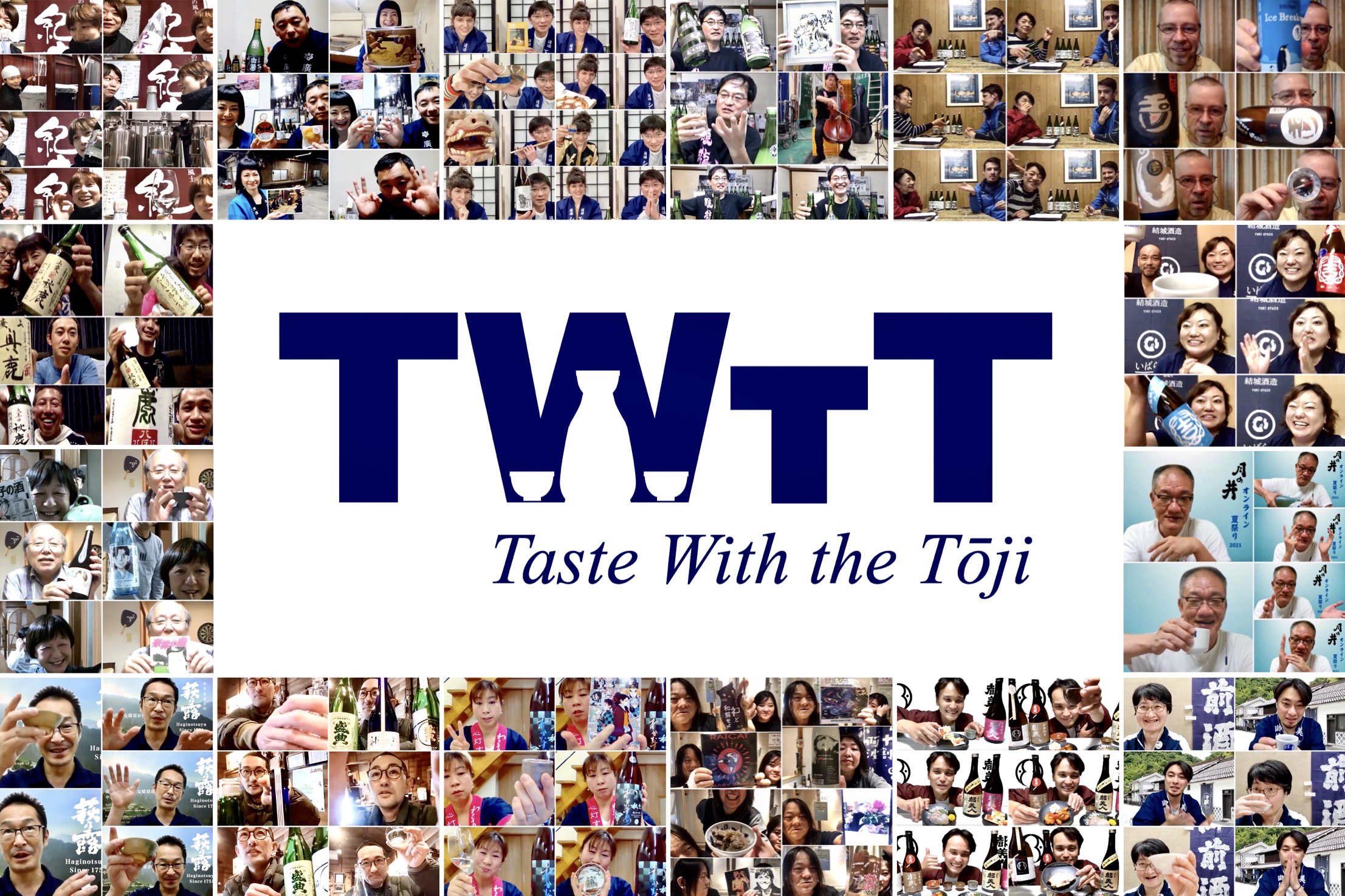Taste with the Tōji project
Next up on TWTT:
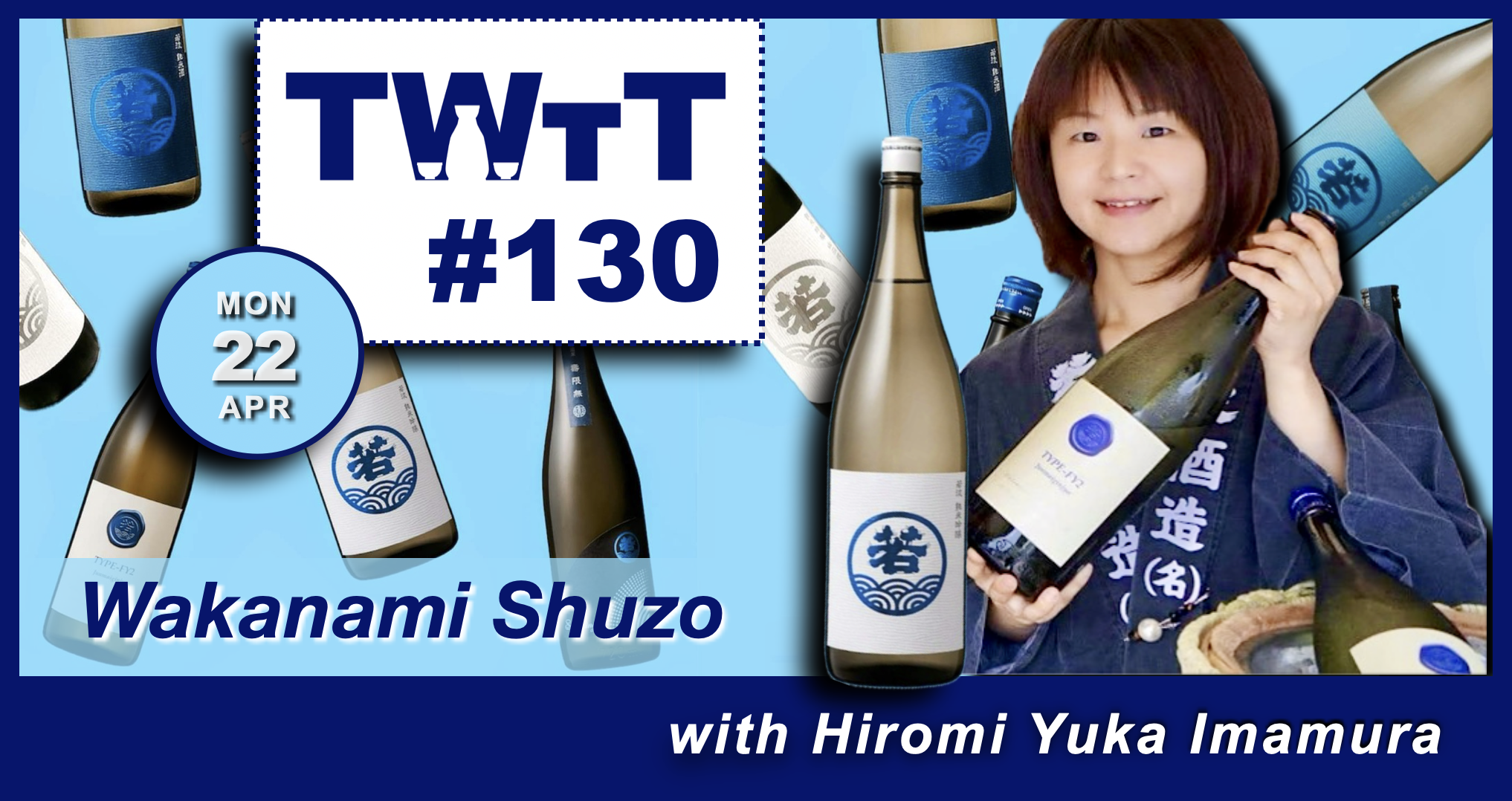
Taste with the Tōji is a series of online events; a project created during the Melbourne COVID lockdown (and will continue in some way beyond lockdown). This project was inspired by the will to continue to host Sake specific events despite having all my upcoming ‘on location’ events cancelled due to Coronavirus and the social distancing rules in place. I wanted to find a way to continue to bring people together through sake. These
Taste with the Tōji events endeavour to unite Sake drinkers and enthusiasts of all levels, whilst at the same time, connecting the brewers with their wider audience/consumers.

Taste with the Tōji events are currently free to attend as my main wish is to support the brewers and importers through this tough time, however, where possible, it is suggested attendees purchase a bottle of Sake (from the featured brewer) prior to each event they attend. In addition, (or in lieu of), a virtual tip jar has been requested by several attendees from the first event, held on 27th April, featuring Miho Imada. I have created a button here for any attendees of past or future events who might wish to leave a small contribution. I understand this is a tough time for many financially so tips are not essential, however those in a position to contribute can rest assured any funds will of course go back into the running of these events and the costs involved ~ and ultimately the breweries and brewers who are participating in the Taste with the Tōji series.
Below is a calendar of past and upcoming events, which will be updated throughout the duration of the project. Please note there may be limited availability for some of these events, however, if you would like more information on any of these events, please email me at sakemistress@gmail.com or via my contact page on this site.
Past TWTT Sessions: from most recent…
Taste with the Tōji ~ Session 129:
Shunsuke Ozaki
Tentaka Shuzo (Tochigi)
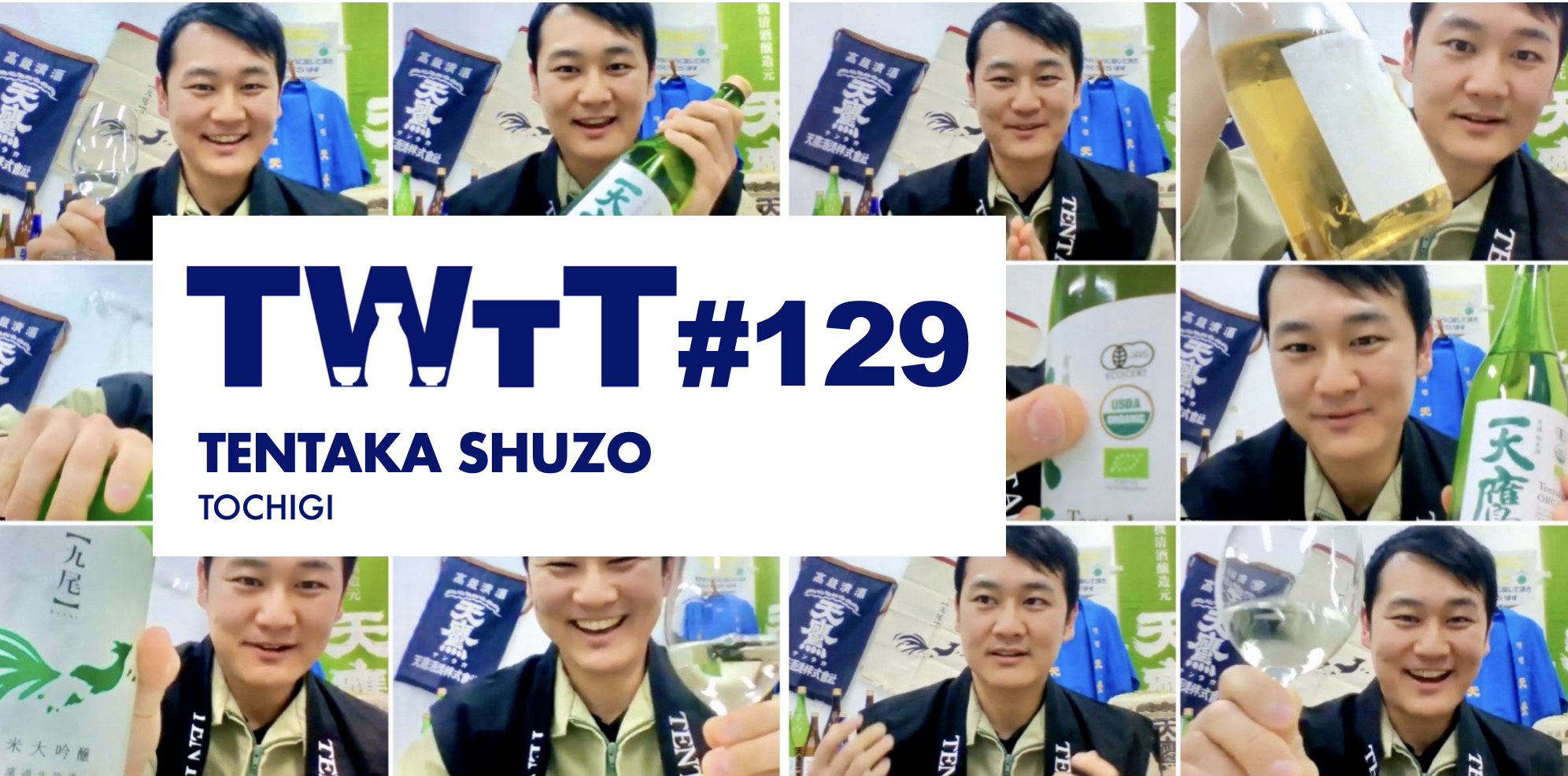
Taste with the Tōji ~ Session 128:
Hiroyuki Ichikawa
Matsubaya Honten (Nagano)
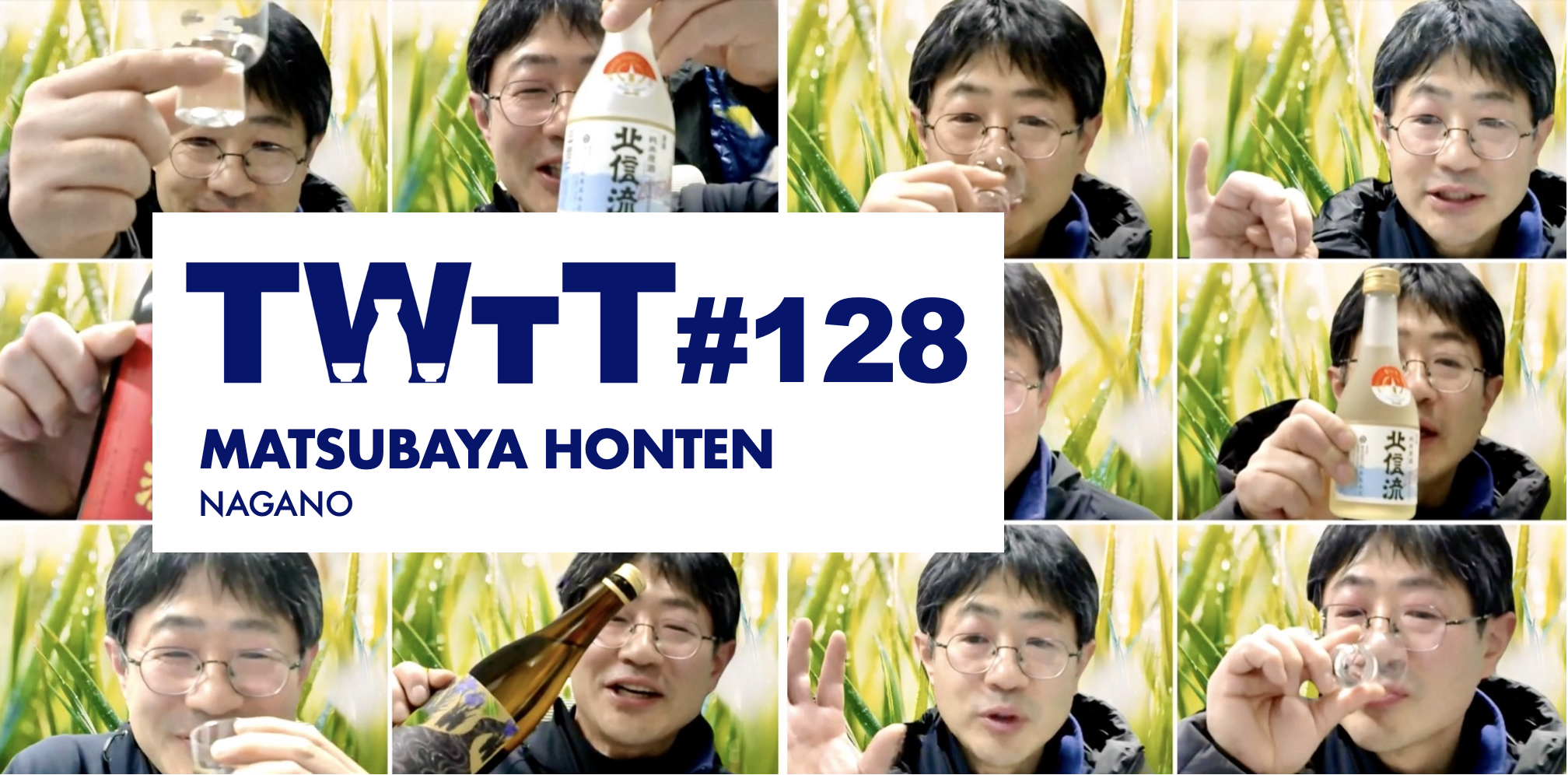
Taste with the Tōji ~ Session 127:
Shohei & Aki Imai
Utsunomiya Shuzo (Tochigi)
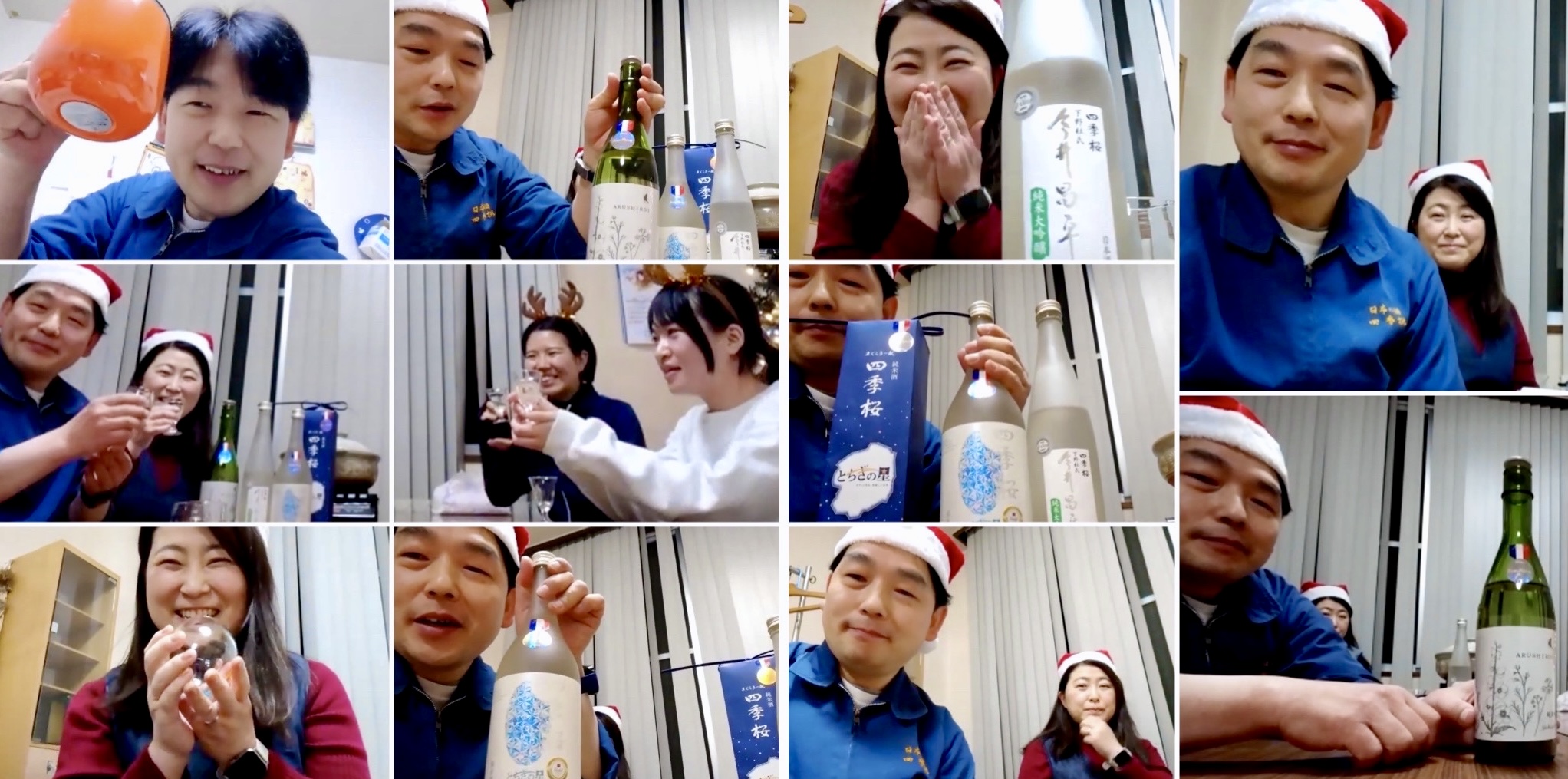
Taste with the Tōji ~ Session 126:
Yuri Kawana
Kawakei Shoten (Miyagi)
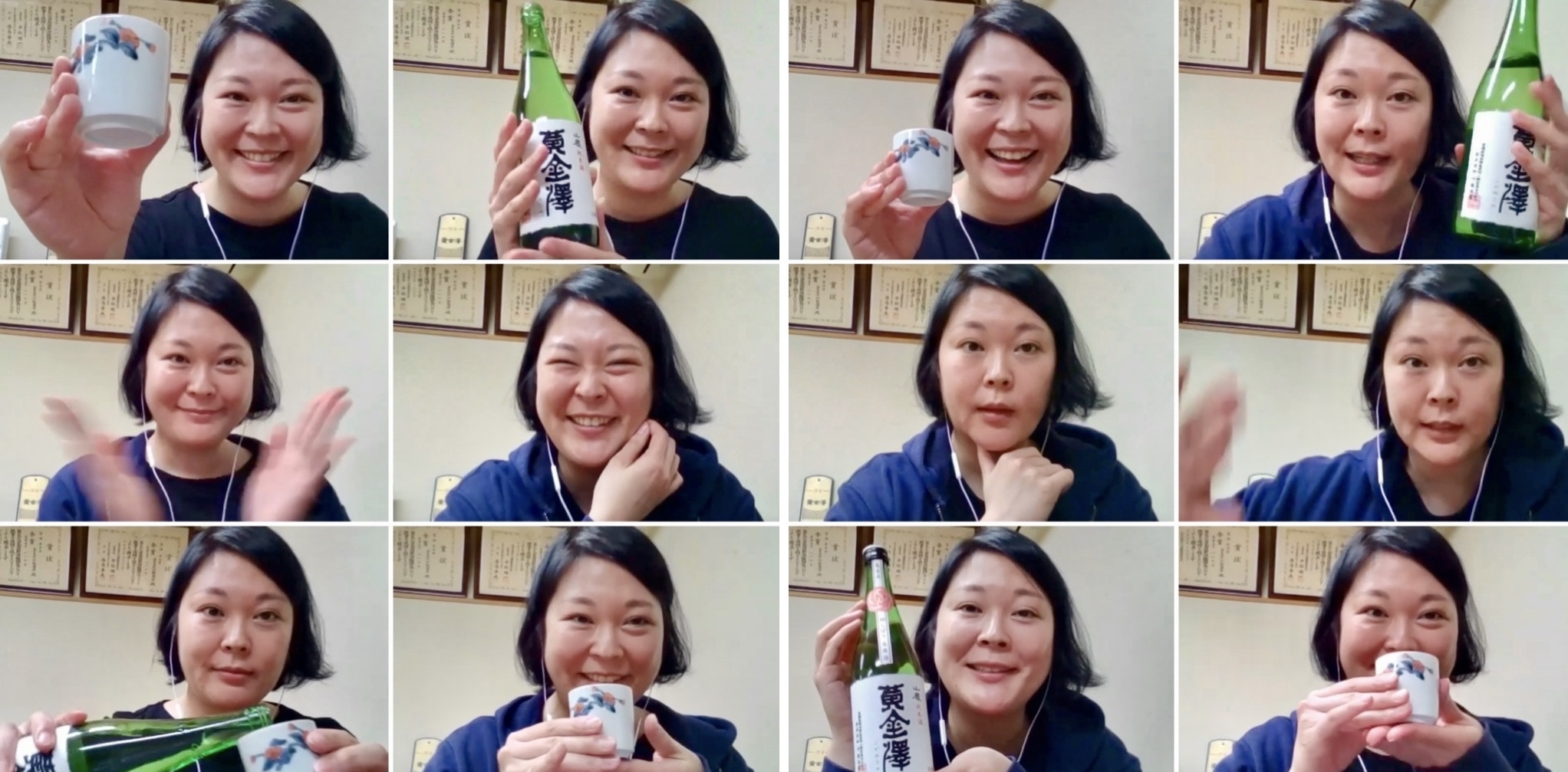
Taste with the Tōji ~ Session 125:
Nobutaka Matsui
Matsui Shuzoten (Tochigi)
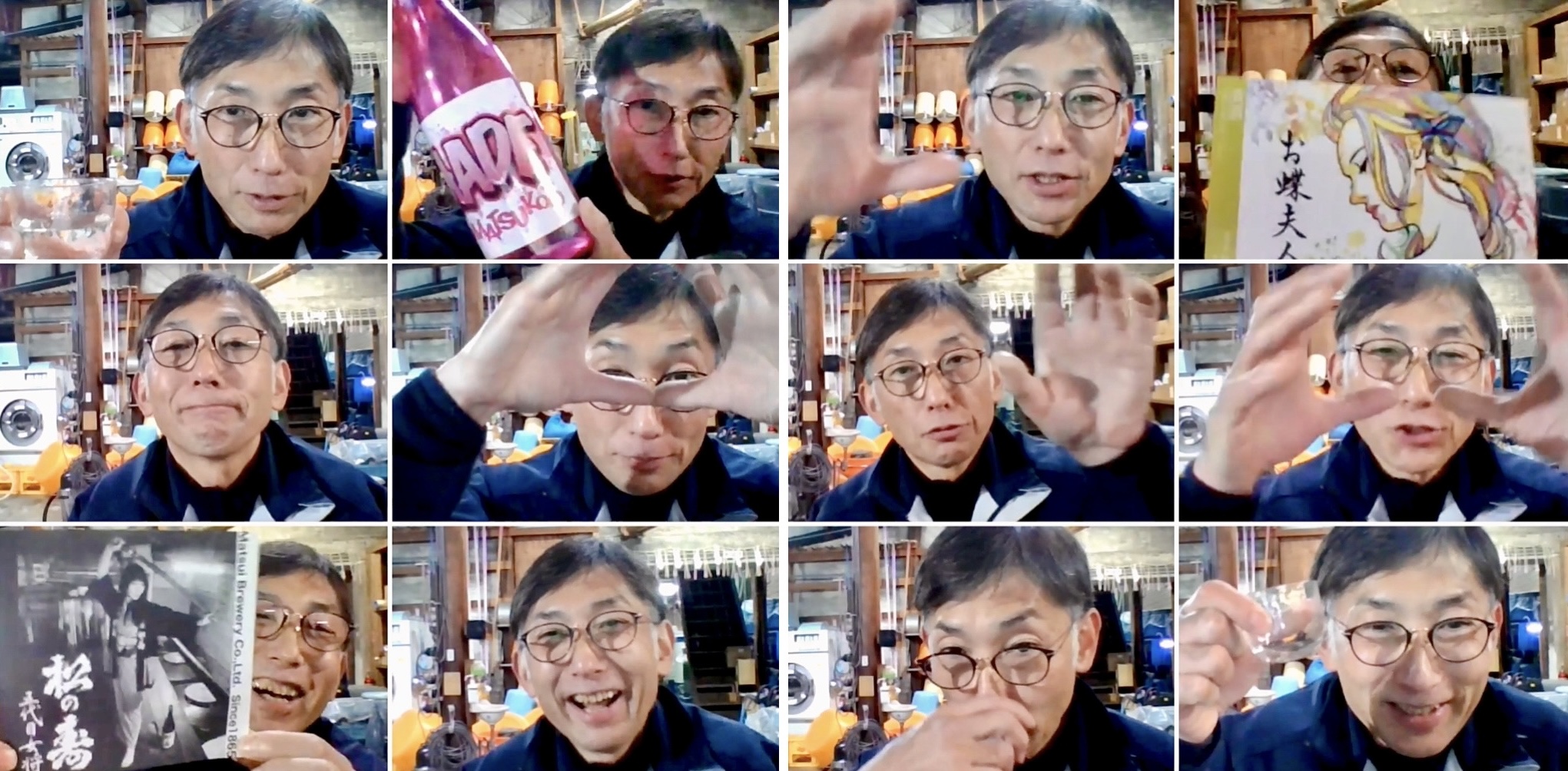
Taste with the Tōji ~ Session 124:
Yuichiro Kawahito
Kawatsuru Sake Brewery (Kagawa)
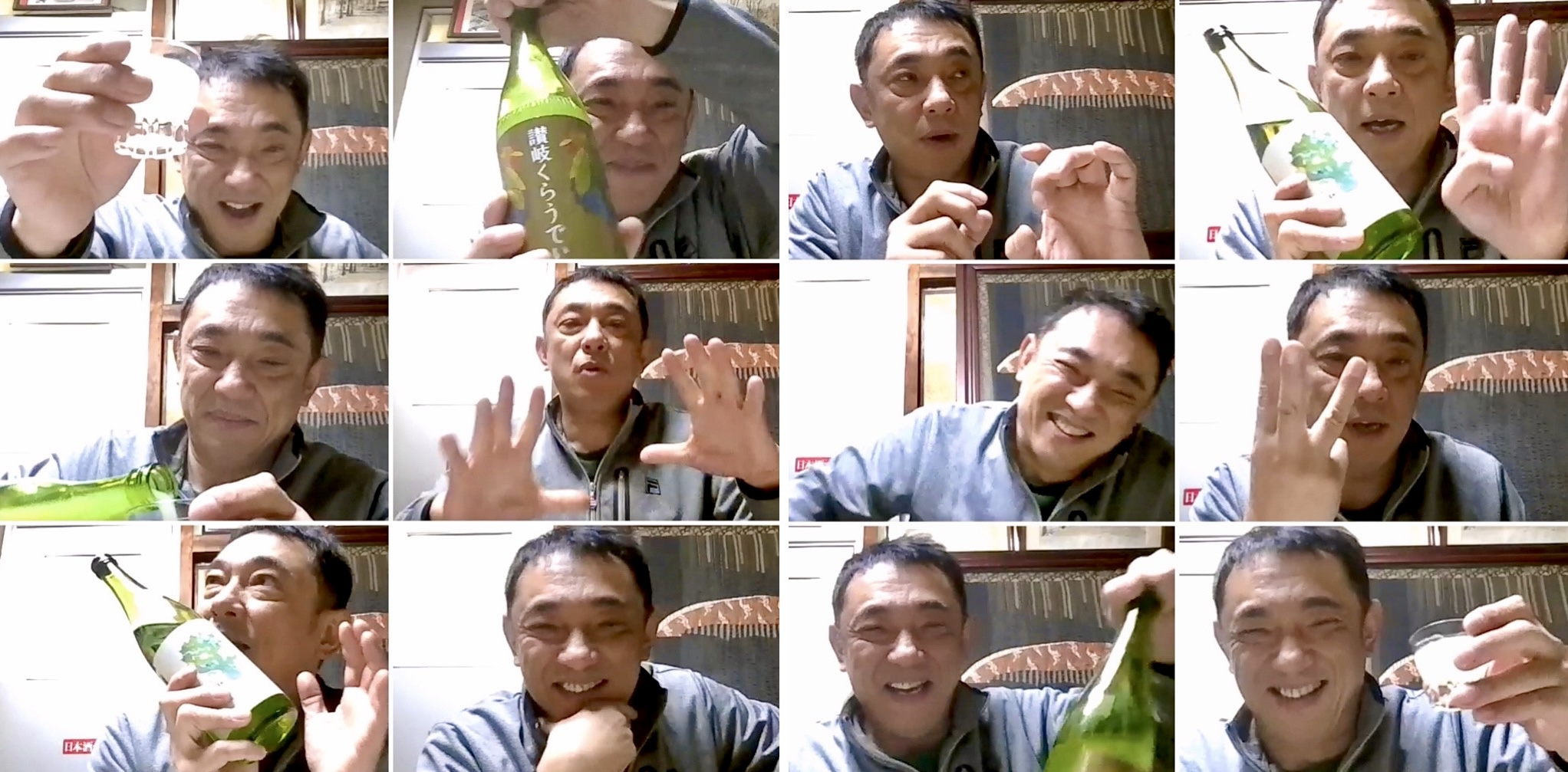
Taste with the Tōji ~ Session 123:
Masuhiro Aso
Yatsushika Brewery (Oita)
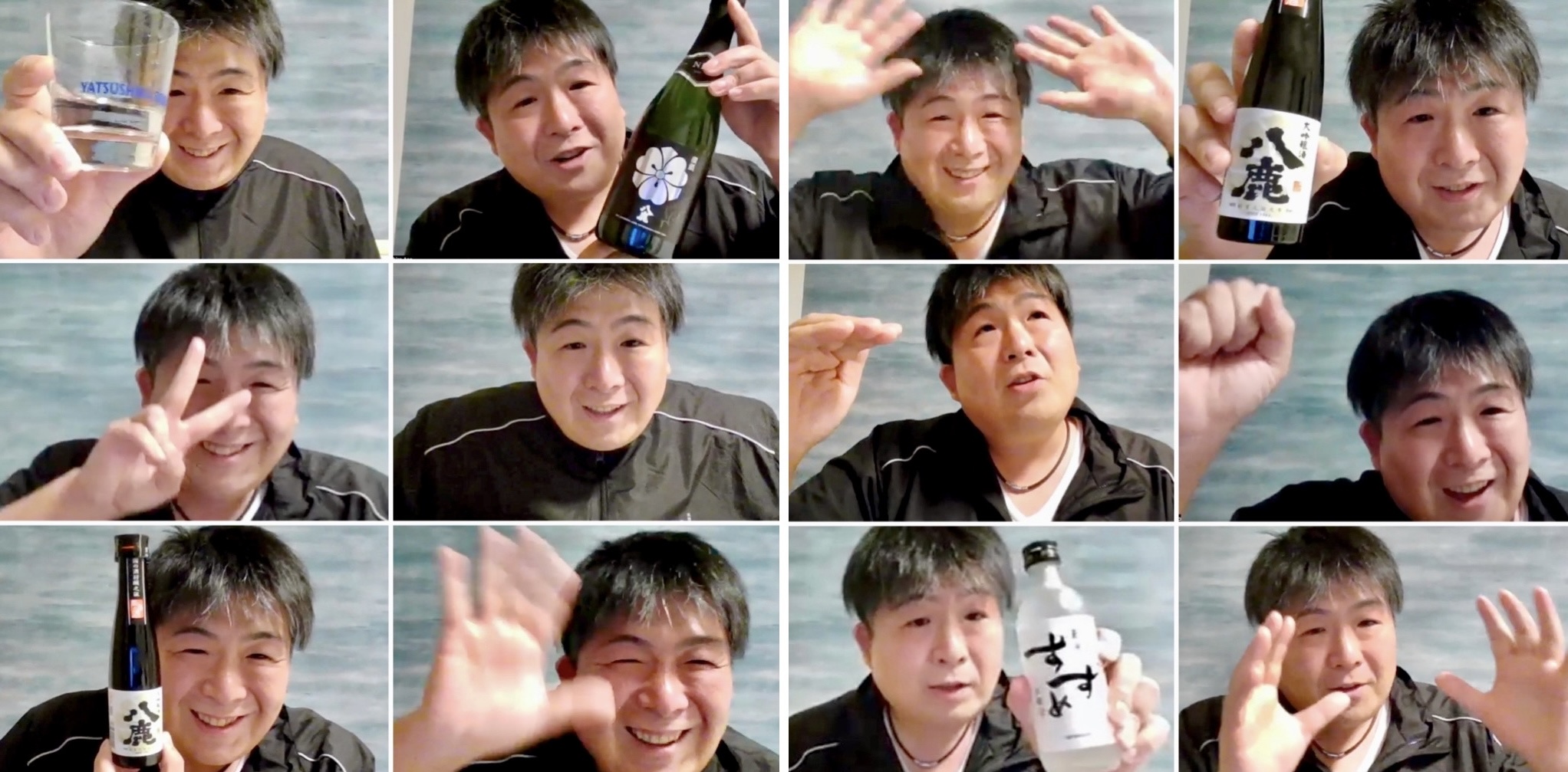
Taste with the Tōji ~ Session 122:
Genuemon Sudo
Sudo Honke (Ibaraki)
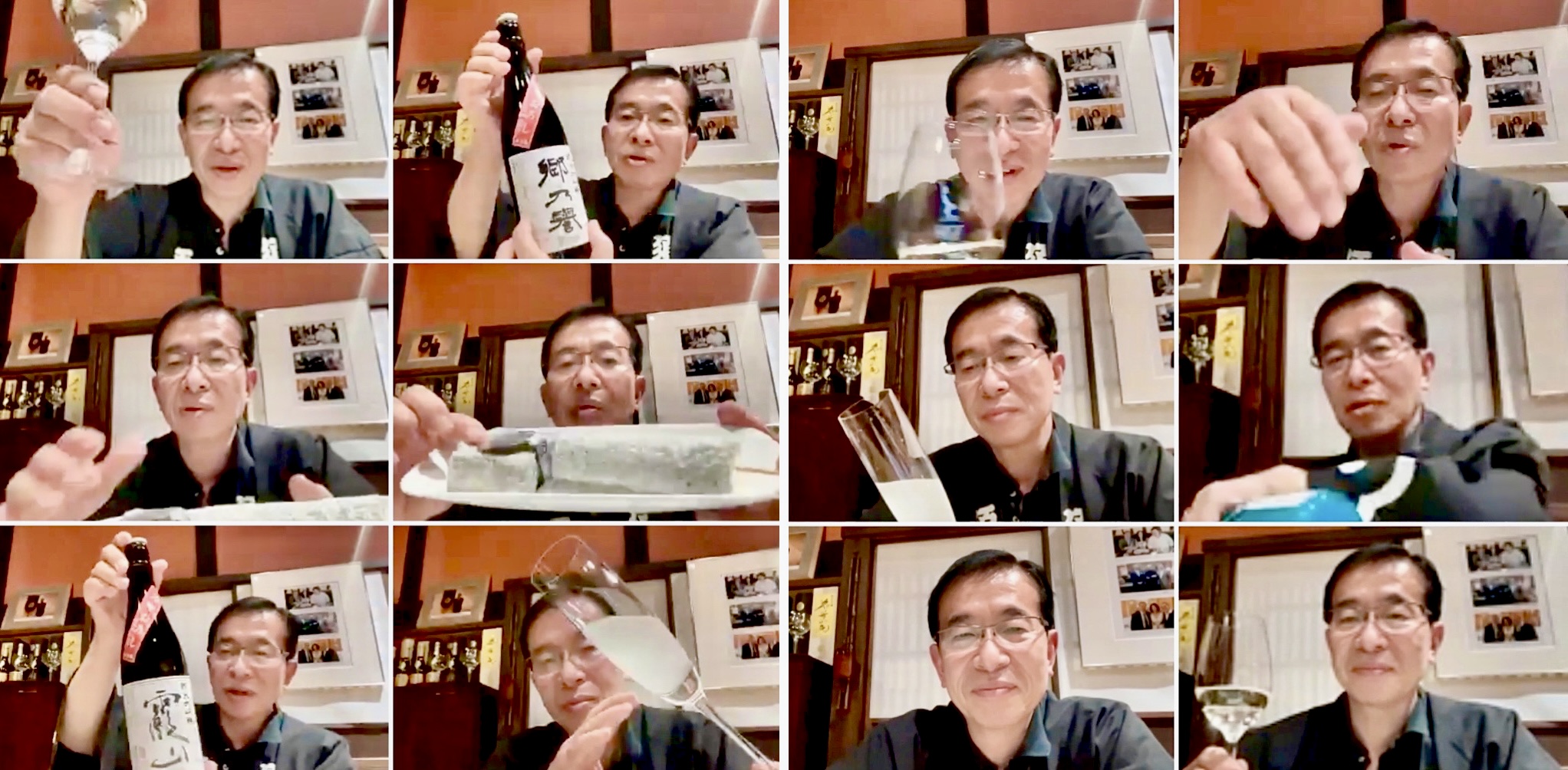
On Monday 16th October, 2023, TWTT had the pleasure of heading to Ibaraki Prefecture to feature Sudo Honke.
Founded in 1141, Sudo Honke is the oldest active brewery in Japan.
Sudo Honke is located in the city of Kasama, (previously named Hitachinokuni), in Ibaraki Prefecture.
Joining us for this session was Genuemon Sudo – who is the 55th generation Kuramoto!
Sudo-san told us that Genuemon is not his given name, but rather the name that is passed on to each generation as they take over the running of the brewery. He also told us that some generations, during the brewery’s 882 year history, have been stubborn and refused to take on the name ‘Genuemon’. Not the case with the 55th generation Kuramoto.
Sudo Honke is a very small brewery, producing around 800 koku (approx. 144 kilolitres) a year. Their small team follows the traditional brewing season which runs from late October to early April.
The brewery is heavily focused on brewing Junmai Ginjo and Junmai Daiginjo sake, and a large amount of what they produce is either unpasteurised or pasteurised only once. Sudo-san explained that the brewing philosophy is of Sudo Honke is simple, clean, and natural, with minimum human intervention during the brewing process. All their sake is muroka, avoiding the charcoal filtration process after pressing.
Sudo Honke is also very focused on ‘local’ – all the rice they use for brewing comes from within a 5km radius of the brewery.
The initial powerpoint presentation Sudo-san sent us prior to the session was 417 pages long… not surprising given the brewery’s 882 year history.
Of course, with a history that long, there was so much to talk about – and as always, not nearly enough time to cover it all – but what we did cover was both informative and enjoyable and left many of the attendees keen to visit the oldest active sake brewery in Japan.
A huge thank you to Genuemon Sudo for sharing his time, knowledge, philosophy and brewery’s history with us all. An extension of that huge thank you must go out to co-host and interpreter for this event, Harald deRopp, not just for his work during the session itself, but for reaching out to Sudo-san and helping to make this session happen for TWTT.
Thank you, as always, to everyone who attended this session.
Taste with the Tōji ~ Session 121:
Akiko Fujita
Yoshimura Hideo Shoten (Wakayama)
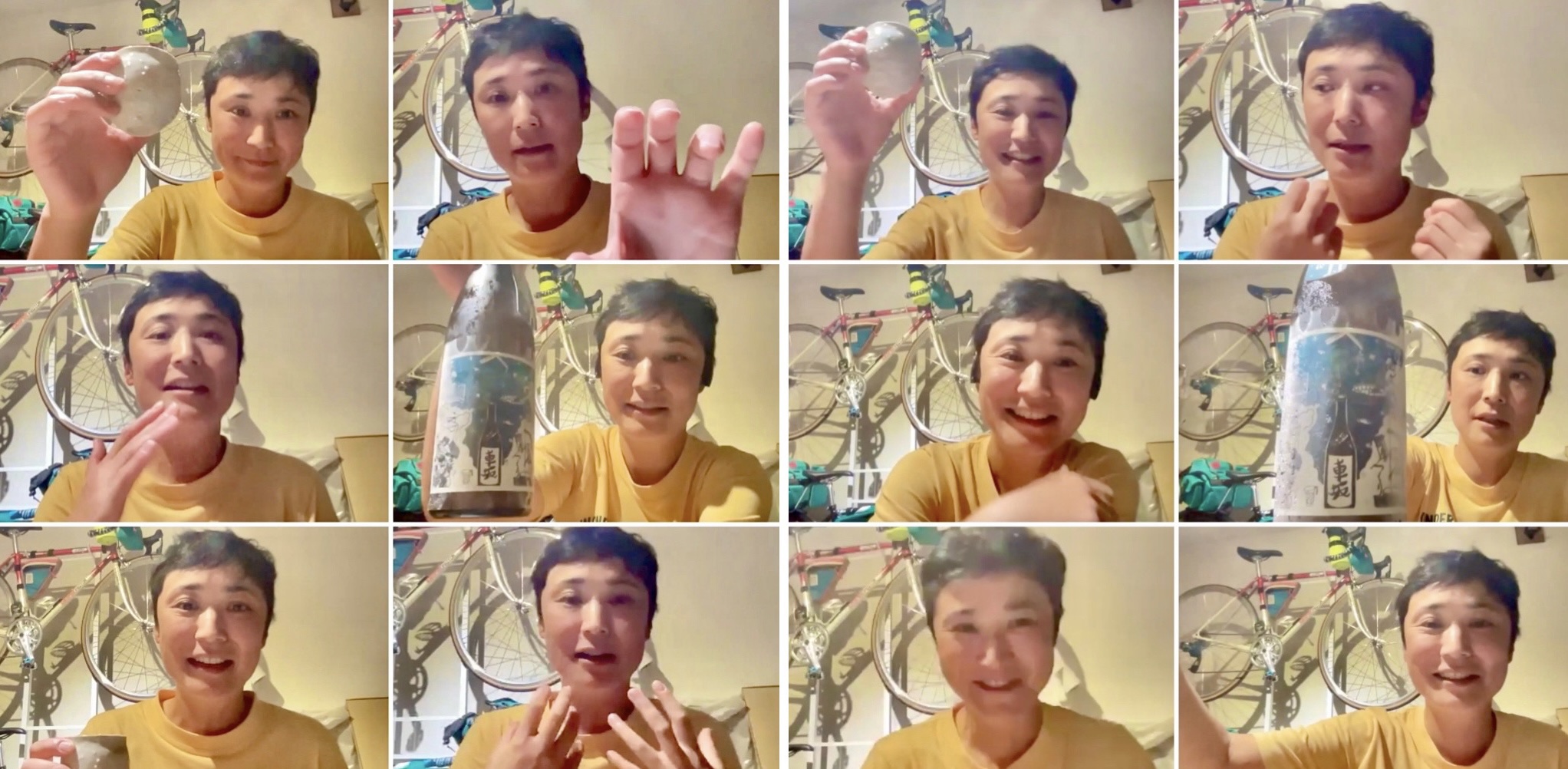
Monday 9th October, 2023, saw TWTT return, after a 3 week break, to host its 121st session.
For this session, we headed to Wakayama Prefecture to feature Yoshimura Hideo Shuzoten, but the spotlight itself was clearly on the bright, young, inspirational Toji, Akiko Fujita, who joined us as the special guest for this session.
The company itself was founded by Yoshimura Hideo, the son of a silk manufacturer, who began learning how to make sake in Nada during his teenage years. After returning to Wakayama he founded his namesake company and brewery in 1914.
Born and raised in Tokyo, Fujita-san studied brewing (and fermentation) at university (Tokyo University of Agriculture) – which was where she developed her fascination for, and interest in, sake brewing.
During her time at university, she met a number of people who came from sake brewing families and had the opportunity to visit and help out at a small family-run brewery and experience sake brewing first-hand.
It was after this experience that Fujita-san decided she wanted to pursue a career in sake brewing.
Her interest in sake continued to grow and she became most interested in ancient brewing methods, (or starter fermentations), namely Yamahai and Kimoto. She began researching breweries that were specialising in these techniques, in the search for the perfect teacher in this area of brewing.
She certainly achieved her goal, finding employment at Kano Shuzo, (brewers of Jokigen), in Ishikawa Prefecture and learning from the Godfather of Yamahai himself, Noguchi-Toji.
She worked a total of 10 years at Kano Shuzo, 8 of those under Noguchi-Toji. After a decade of brewing Jokigen in Ishikawa, she heard that a brewery in Wakayama Prefecture was looking for a Toji. That was 10 years ago, when Fujita-san, at the age of 32, became the Toji of Yoshimura Hideo Shoten.
Fujita-san is a remarkable young Toji, a woman wise beyond her years and incredibly dedicated, knowledgeable and passionate. She is also the first female Toji of Noto Toji, a brewers guild that has been around since the late Edo period.
Fujita-san specialises in brewing using Kimoto and Yamahai methods, she also has a special focus on koji making. We certainly got pretty geeky in this session! A lot of the conversation was very brewing (process) focused.
Yoshimra Hideo Shoten produces two main brands, Kurumazaka and Nihonjo. They currently produce around 500 koku.
Fujita-san says her aim is to produce sake that brings out the natural umami of rice, while maintaining a clean finish and clarity of flavour. She wants to make sake that drinks well alongside a broad spectrum of flavours (in food) from all types of cuisine around the world.
It was certainly a most interesting and enjoyable session and discussion.
A huge thank you to Akiko Fujita for sharing her time, story, passion and knowledge with us all. An extension of that huge thank you must go out to my co-host, Maki Tanaka , joining us this time from Melbourne, for yet another wonderful interpretation.
Thank you also to Shuji Furui, from the brewery, and Yoshi Honda, from Sake Honda / Bottle Shop Mino (Sydney), for helping to make this session happen, and of course to everyone who joined this session.
Taste with the Tōji ~ Session 120:
Daisuke Suzuki
Suzuki Shuzo (Yamagata / Fukushima) with guest interpreter: Philip Harper
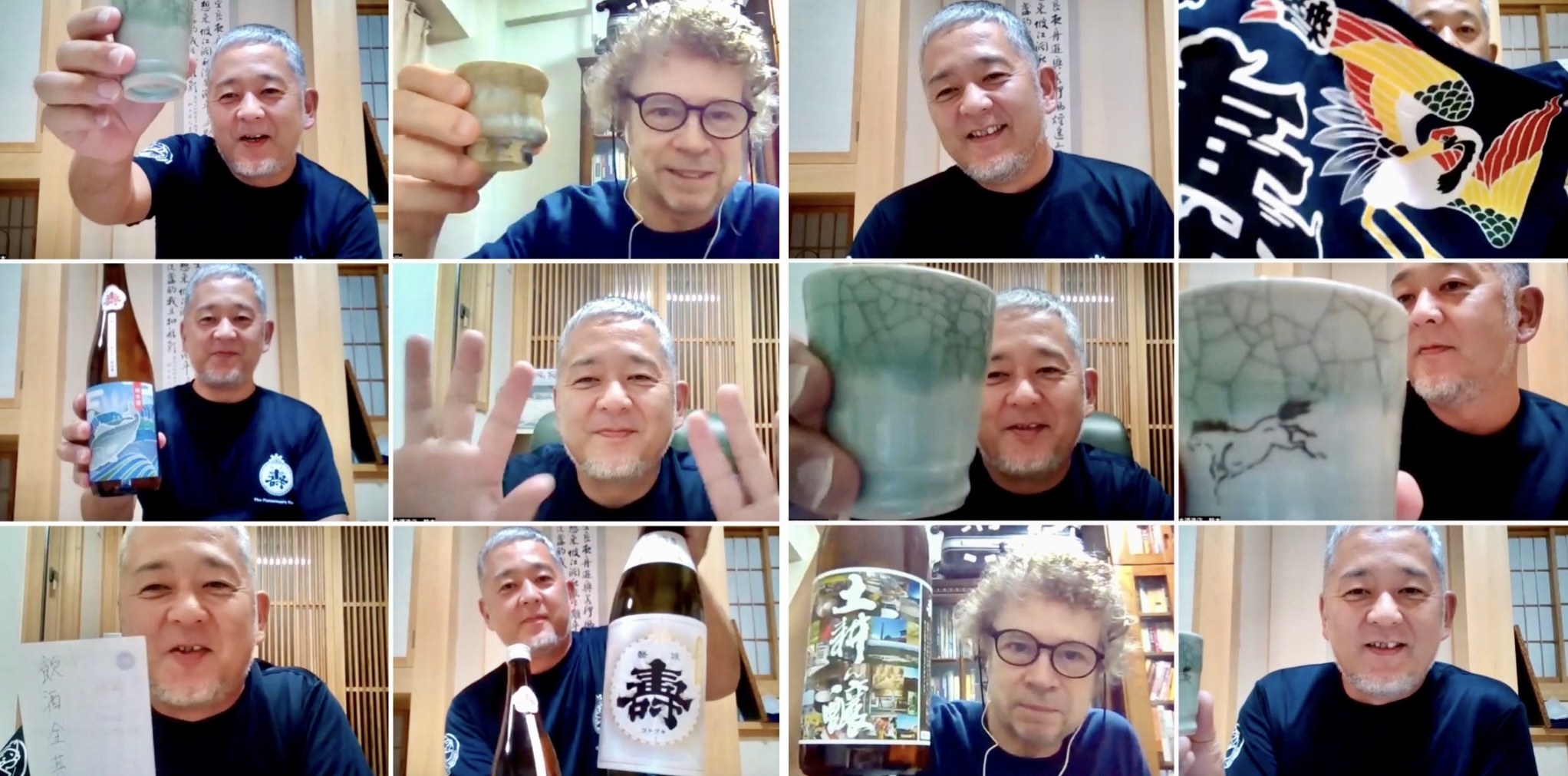
On Monday 10th September, 2023, TWTT’s 120th session took place when we visited Yamagata Prefecture to feature Suzuki Shuzo – Iwaki Kotobuki.
Our very special guest for this session was Kuramoto/Toji, Daisuke Suzuki. To add to the special guest list, Philip Harper, Toji at Kinoshita Shuzo – Tamagawa, and good friend of Suzuki-san, joined us as co-host and interpreter for this session.
Many were already quite aware of at least part of Suzuki-san’s story, especially those who have seen the movie, Kampai – For the Love of Sake.
The Suzuki family lost their home and 300-year old brewery in the tsunami of 2011, escaping with just the clothes on their backs. Fortunately no family members or brewery staff were lost, but sadly, lives were lost within their community. At least 10 percent of the local population lost their lives in this horrific disaster.
They took on big debts to take over a defunct Yamagata brewery. Suzuki-san has been working to get back to their home town of Namie in Fukushima ever since, and has managed to set up a micro-brewery in conjunction with a new service area. In the face of delays and equipment problems, he transported moromi made in the Yamagata brewery to be pressed in the new plant in the effort to bring sake back to Namie for the 10th anniversary of the disaster.
About a week after the Tsunami, Suzuki-san’s father went back to the brewery site to see if there was anything left of or from the brewery. He returned to Yamagata, where his family had escaped to after the disaster, and delivered the news that there was nothing left – everything had been demolished or washed away. Not long after, Suzuki-san decided to visit the site himself. When he was looking through the rubble, he found 3 items that, together, made up the key to the main door of the brewery. Suzuki-san was surprised and inspired by this find – he told us that it felt like his ancestors had placed it there for him to find, and upon finding it, he said he felt a strong responsibility to keep it (the brewery) going somehow. He was also surprised to find several in-tact sake bottles that had survived the damage, laid out across the ruins. They had been placed there, upright, by members of the community who had gone back to see what was left of their town – this made him realise what his sake meant to the local community.
Findings like these gave him a huge amount of motivation and inspiration to overcome the hardships and continue to brew sake and to some day, once again, make sake in his hometown of Namie.
I am sure he and his family had moments of feeling utterly defeated after the devastation, but Suzuki-san’s story is also one of hope – and his positivity is something that resonated with the TWTT audience.
Of course, we discussed many other things in addition to the disaster, and Suzuki-san was most generous with his time, giving us not only an extra hour of ‘official’ session time, he also stayed beyond that for a casual chat in the nijikai.
This was such an enjoyable and inspiring session.
A huge thank you to Daisuke Suzuki for sharing his time, story, hope, knowledge and positive light with us all. An extension of that huge thank you must go out to co-host and interpreter for this session, Philip Harper – without whom this session would not have been possible.
Thank you also to everyone who attended this session.
Taste with the Tōji ~ Session 119:
Bungo Tanaka
Dainagawa Shuzo (Akita)
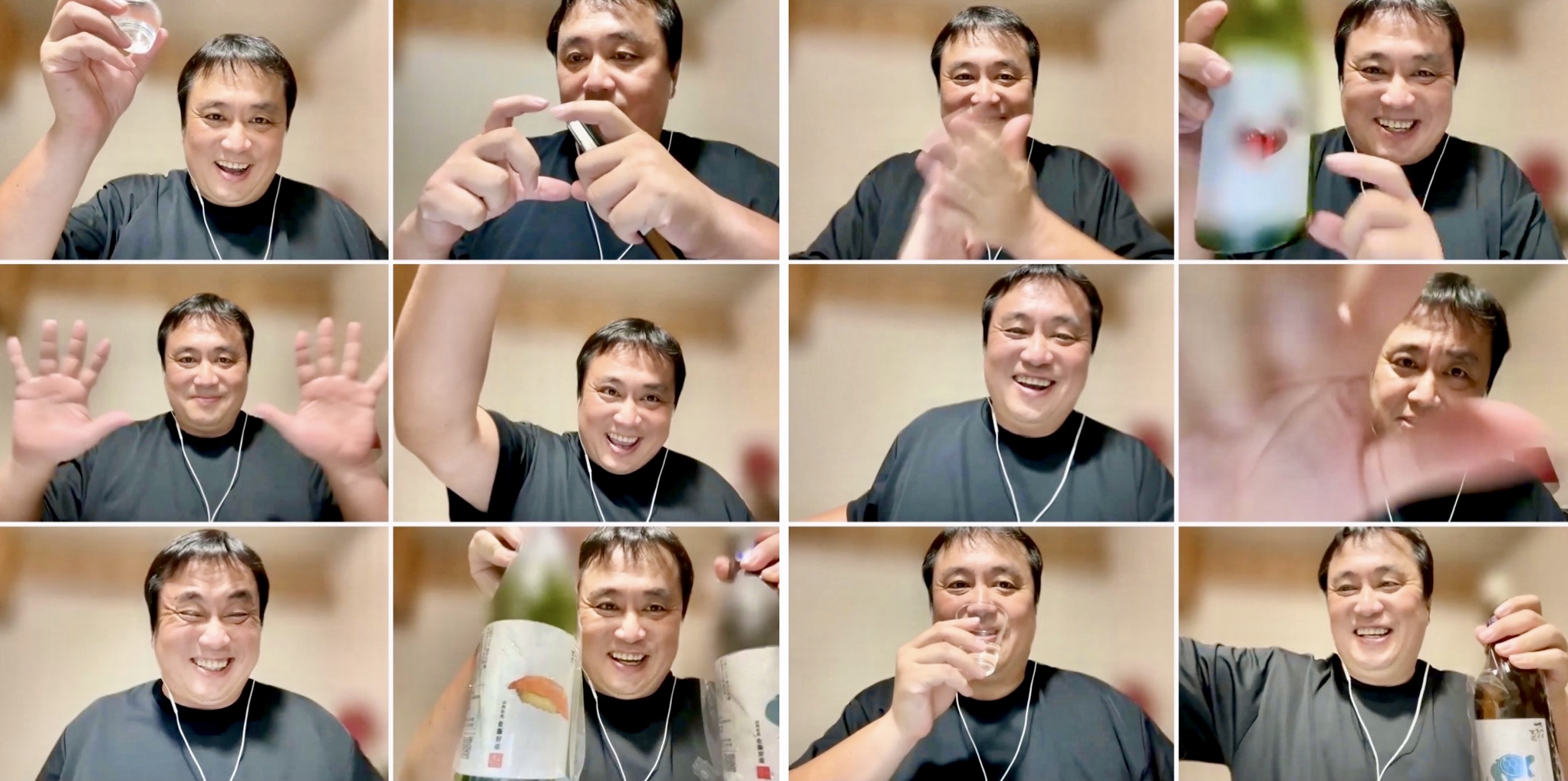
On Monday 4th September, 2023, TWTT had the pleasure of hosting its 119th session, shining the spotlight on Dainagawa Shuzo. For this session, we got to chat with the inspirational and optimistic, Bungo Tanaka – current owner/president – or as he id called in the brewery: Big Boss – of Dainagawa.
Dainagawa Shuzo was established 109 years ago (1914), in the city of Yokote, in Akita Prefecture. Yokote is famous for its Kamakura Festival, held in Winter, when igloo-like snow houses are made throughout the town. It is held in the days leading up to the Bonden Festival around mid February. Visitors traditionally sit inside the kamakura and are served amazake and mochi, or well known local dishes. Tanaka-san recommends drinking hot sake, whilst sitting inside one of these Kamakura, for the ultimate Yokote experience!
Tanaka-san does not come from a brewing family, nor did he marry into one. So how is it that he happens to own a sake brewery? (Actually he owns more than one – but more about that some other time).
Bungo Tanaka began working at Asahi Beer after graduating from university. He was working as a salesman for the company and during his 10 years at Asahi, he met several successors to sake breweries who were working there to gain an insight into the alcohol/beverage industry. It was through these connections at Asahi that he learnt of many sake breweries throughout Japan that were facing hard times, many dealing with financial woes that threatened there business with closure. To cut a long story short- it was through communication with his Asahi colleagues that he developed an interest in the sake industry, and ultimately, the desire to help revive some of these struggling breweries.
Dainagawa was one of these breweries, and in 2018, Tanaka-san took possession of the brewery and thus put his plan to help struggling breweries into action.
Shortly after taking over at Dainagawa, Tanaka-san and his team made 3 major changes for the brewery:
They reduced the abv% – to be no higher than 15%.
They moved from ageing their sake in tanks to ONLY ageing in bottles.
They switched to being an all junmai brewery.
Something Tanaka-san didn’t change was the staff. His current Toji, was the Toji when Tanaka-san took on the brewery. He has now been brewing sake for 25 years.
We didn’t get to do a live virtual brewery tour for this session, as Tanaka-san was joining us from a hotel room in Iwate, however, he did show us a pre-recorded video tour, led Dainagawa’s veteran Toji, Sato-san.
Dainagawa make currently have 3 main brands: Dainagawa, Tenka and Sannai Toji. Of course, we got to learn the stories behind each of their 3 brands and the meaning behind just some of the illustrations on the labels of their ‘Tenka’ range. Tanaka-san told us that the idea was to simplify the labels and make them recognisable through one simple illustration/motif, making it easier for people to remember them and find them again. The labels in the current Tenka line-up include a heart, a pelican, a peach, a sugidama, an apple, a tiger, sushi, eggplants and more. We were told that not all of the labels will be repeated, but that they are currently looking for new label image ideas for their new sake. The TWTT audience were keen to offer suggestions – we came up with 3 that seemed to pique Tanaka-san’s interest… a Sumo wrestler, an Akita dog, and a Namahage.
We shall wait to see if any of them make the cut!
We covered a lot in the 2.5 hours with Tanaka-san, but as always with these sessions, there is still so much to talk about, ask and learn. Good news is – we might be lucky enough to get Tanaka-san back on TWTT to chat about his other brewery, Hirota Shuzoten, in Iwate Prefecture. Tanaka-san seemed pretty keen to get back in the Zoom room – he has even proposed he might bring a tambourine to play at the next session… (his contribution to the ever-growing TWTT band… IYKYK).
A delightful session and we look forward to having the opportunity to chat with Tanaka-san again in the near future.
A huge thank you to Bungo Tanaka for sharing his time, story, vision, humour and hope with us all. An extension of that huge thank you must go out to co-host and interpreter for this session, Harald deRopp, (and also to Christopher Hughes for helping out during the ‘extra time’.
Thank you, as always, to everyone who attended this session.
Taste with the Tōji ~ Session 118:
Mariko Tomikawa
Tomikawa Shuzo (Tochigi)
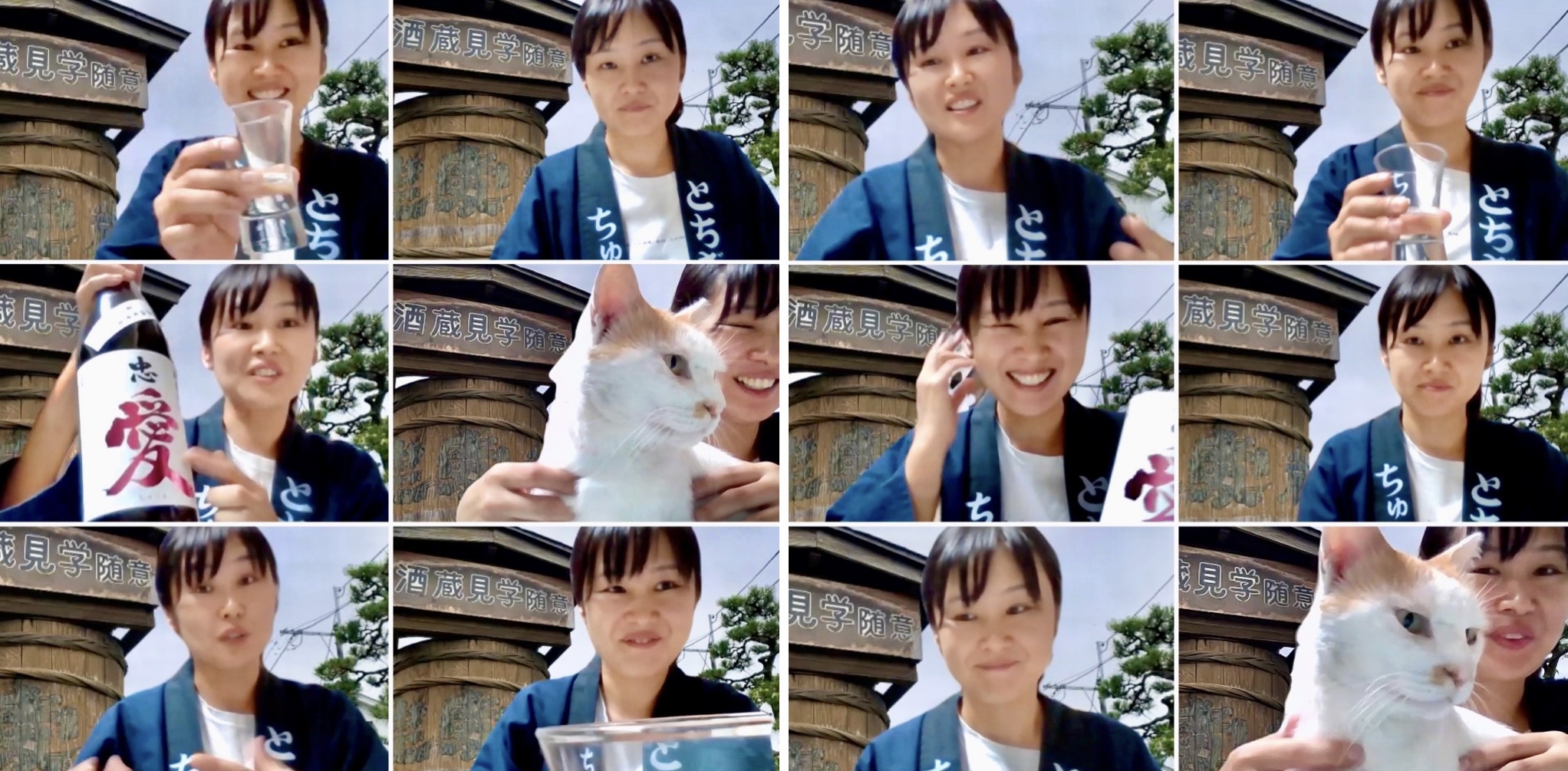
Monday 21 August, 2023, saw the 118th session of TWTT when we headed to Tochigi Prefecture to feature Tomikawa Shuzo.
Joining us for this session was 5th generation Kuramoto, Mariko Tomikawa.
The brewery was established in 1913.
Tomikawa Shuzo is located in the town of Otsuki, Yaita City in Tochigi Prefecture.
Mariko-san took over the brewery from her mother, who took over briefly after Mariko’s father passed away.
Tomikawa Shuzo produces 2 brands: The Chuai brand, (the brewery’s main and older label), is a line-up of ALL Ginjo style sake. Their second brand is Tomikawa, which includes their Futsushu – which we were surprised to hear is also muroka, nama, genshu.
Mariko-san put together a wonderful presentation especially for this TWTT event and later took us on a live virtual tour of the brewery. Inside the brewery, her co-host, Kuranosuke, introduced himself casually and proceeded to appear throughout the tour.
Kuranosuke is, of course, the Kura cat, and Mariko-san tells us he is the boss – in fact, his nickname at the brewery is Kaichō, (which translates as ‘chairman’ or ‘president’). This honor, we are told, is a testament to his exceptional talent for pest-control, an essential role in preserving the quality of the sake produced at Tomikawa Shuzo!
It was interesting to see that many of the walls within the brewery are constructed with Oya stone, a strong and fire-resistant stone from Tochigi Prefecture.
We were first introduced to Oya stone during our TWTT virtual tour of Morishima Shuzo for Session #110. Morishima Shuzo, who saw the complete destruction of their brewery building during World War II, rose from the ashes using Oya stone to rebuild and ensure resilience against future fires. However, the brewery also unveiled the stone’s vulnerability to earthquakes, as evidenced by the cracks discovered at Morishima Shuzo after the Great East Japan Earthquake in 2011.
Mariko-san is the second oldest child in her family. It was pretty evident from early on that her older sister had no intention of taking over the family business. That legacy was passed on to Mariko-san who is certainly doing her father and her family’s legacy proud.
In addition to being the Kuramoto, Mariko-san is also part of the 2-person brewing team at Tokimawa Shuzo. During busier times, they have 2-3 additional staff come in to help for a few hours a day, but for the most part, it’s a 2-person operation. They are currently producing between 200-300 koku each brewing year. Their brewing season currently runs from mid-October to late March.
Mariko-san displayed such wonderful energy, enthusiasm and passion and we thank her so much for sharing all of that, and her time, (and her brewery), with us. A huge thank you also to my co-host, and interpreter for this session, Christopher Hughes.
Thank you also to Mamoru Shiga and Yasuhiro Fujie for helping us to get this one on the TWTT map.
As always – thank you to everyone who attended this session.
Taste with the Tōji ~ Session 117:
Takamasa & Ayaka Furuhashi
Furuhashi Shuzo (Shimane)
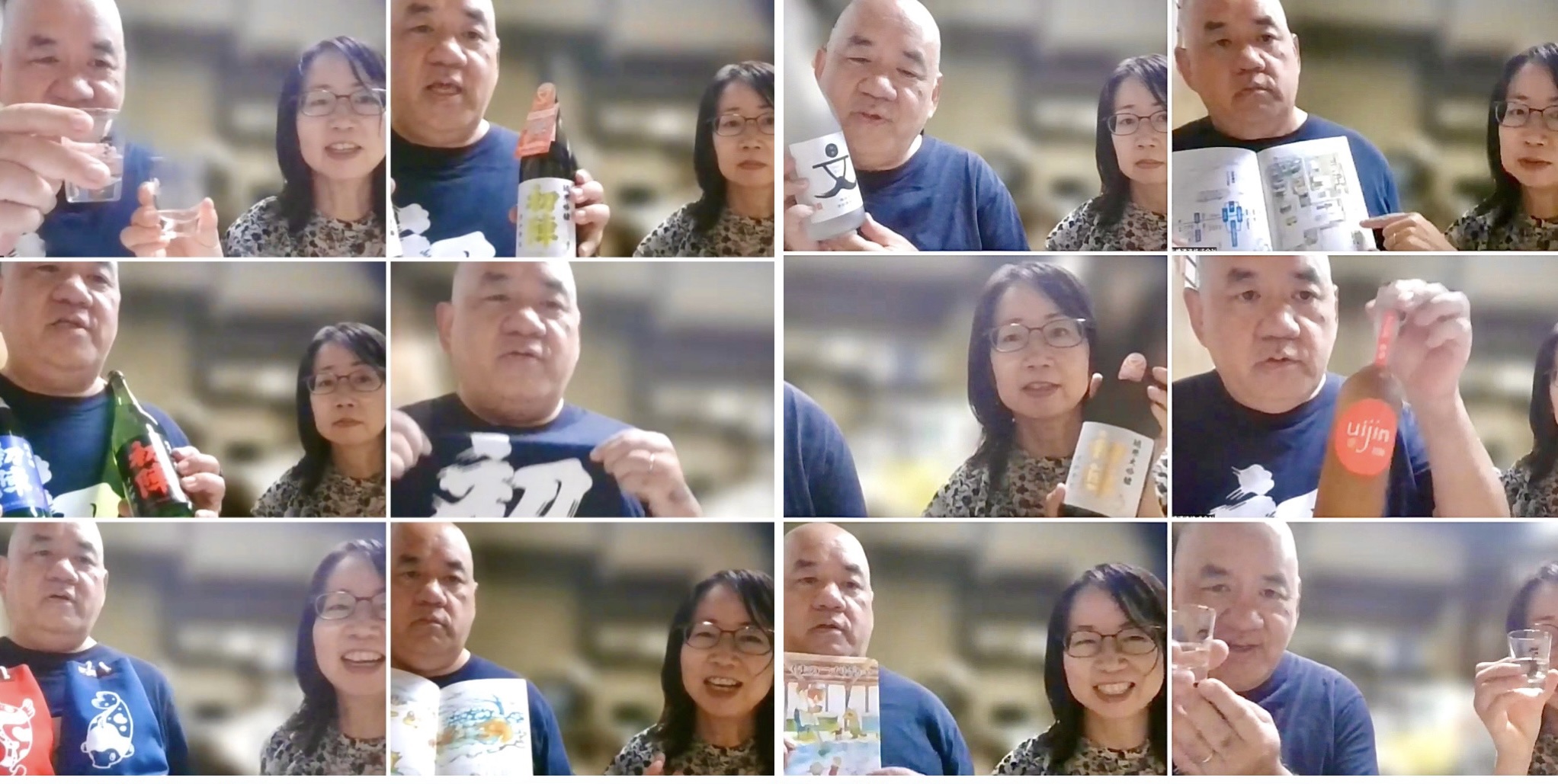
Monday 14th August, 2023, saw TWTT host its 117th session when we headed to Shimane Prefecture to feature Furuhashi Shuzo.
Joining us for this session was Kuramoto/Toji, Takamasa Furuhashi and his wife Ayaka.
This was a session I had been waiting to present to the TWTT audience for quite some time. I first reached out to Furuhashi-san back in December 2021 after seeing an article in John Gauntner’s “Sake Industry News’.. We finally managed to have an online meet-up/introduction in November 2022, so it was so great to finally see this session come to fruition and hear more from this delightful husband and wife team.
Located in the rice-producing town of Tsuwano, in Shimane, Furuhashi Shuzo was founded in 1878. We are told their founder was a Samurai!
Takamasa joined his family’s brewery in 2006 and is now the 5th generation owner. He brews alongside a small team of 3 other brewers. currently producing around 300 koku per year. He mentioned that around 5 years ago, the brewery made the switch to become an ‘all Junmai’ brewery. They are best known for their Uijin brand, which makes up the majority of their production.
In addition to chatting about the brewery and the sake, it was wonderful to hear from Ayaka-san, who just happened to be the very reason I reached out to the brewery in the first place. The aforementioned article in Sake Industry News was not about the brewery’s sake, but rather about a children’s picture book on the sake brewing process, called Kuma no Tsukurizakaya (Bear’s Brewery).
This piqued my interest and sounded like the perfect kind of story for TWTT.
The story follows a cat that has gotten lost and somehow ends up in a sake brewery. The cat then gets to work brewing sake alongside a bear and raccoon, who both work at the brewery. The book also contains cute little characters depicting the koji, yeast and lactic acid.
Ayaka told us that the character of the bear was modelled around her husband, and the character John the cat was modelled around her.
Her hope is to inspire the younger generation to become interested in the world of sake brewing, or more so, the art of fermentation.
The Furuhashis were kind enough to send me some of their Uijin sake along with a copy of the adorable children’s book and it was delightful to be able to learn more about both in this TWTT session.
A huge thank you to Takamasa Furuhashi and Ayaka-san for sharing their time, sake, stories, kindness and knowledge with us all. An extension of that huge thank you must go out to my co-host, the brilliant Maki Tanaka, for yet another fabulous and warm interpretation.
As always, thank you to everyone who attended this session.
Taste with the Tōji ~ Session 116:
Naohisa Sada
Iwanami Shuzo (Nagano)
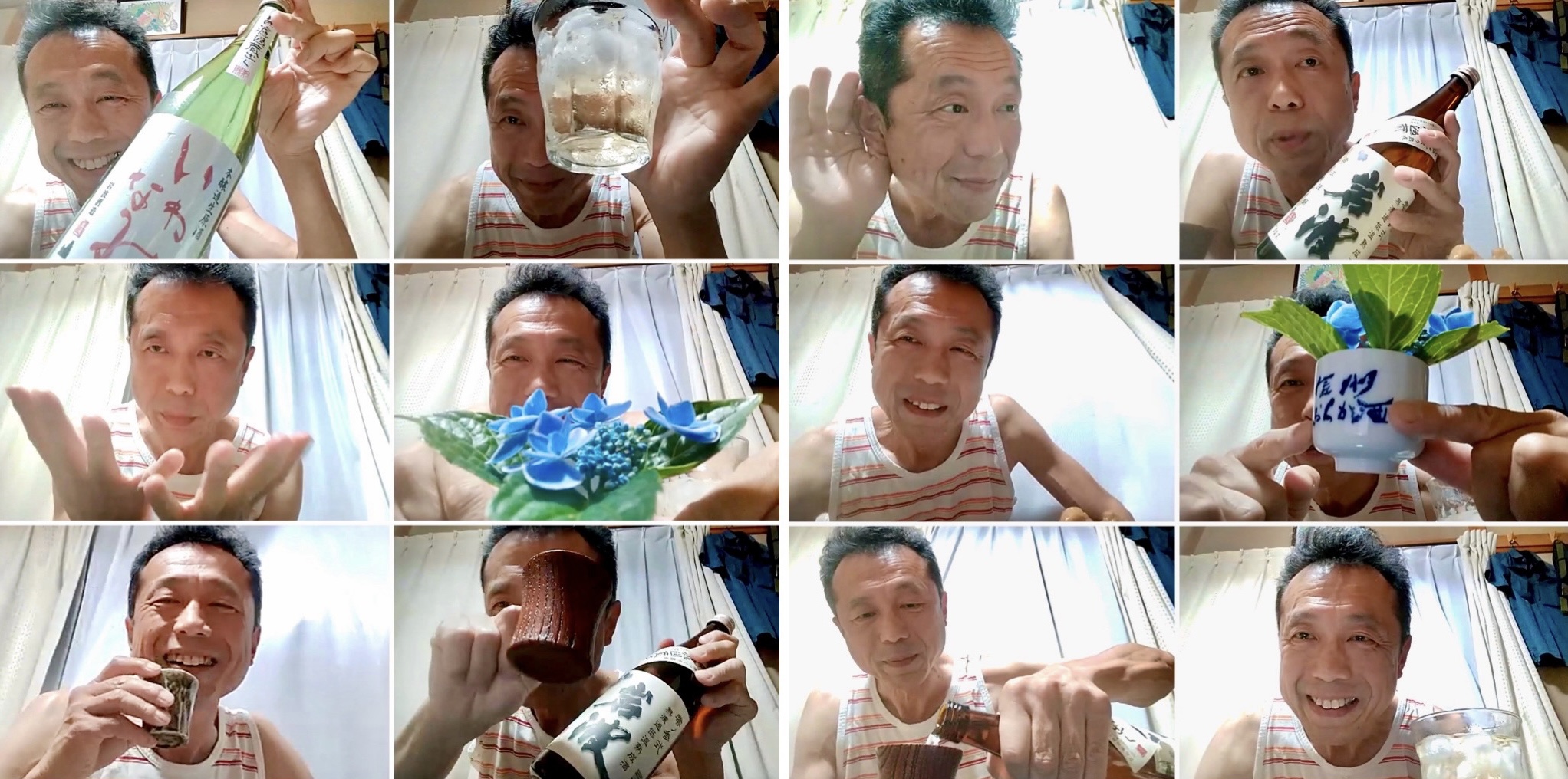
Monday 7th August, 2023, saw TWTT host its 116th session when we headed to Nagano Prefecture to feature Iwanami Shuzo.
Iwanami Shuzo has a history of a little over 150 years and is located in Matsumoto City in Nagano Prefecture. Matsumoto City is most famous for Matsumoto-jo, one of Japan’s most beautiful original castles.
Joining us for this session was Toji, Naohisa Sada.
This was a brewery I had wanted to learn more about for some time – due to the fact that I have been following Sada-san’s blog for a while now and was fascinated not only by his brewing-related posts, but also by his keen love of foraging (mushrooms in particular). I was convinced all of this would certainly make for an interesting TWTT session, and I wasn’t wrong.
This was always going to be a very different/unique session. I used the words eccentric, eclectic and analogue as I was introducing Sada-san – who was doing the session via his mobile phone. He has no laptop or iPad and was initially concerned about whether he would be able to do the session from his phone. I couldn’t have imagined him doing the session any other way!
Sada-san began the session by introducing us to a new word (for most of us), and an alternative to the word Kanpai, (which is how we usually begin each TWTT session). Sada-san suggested, for this session at least, we use the word ‘iyasaka’ instead. He told us that Kanpai was not a word that was really used in ancient Japan. The word they used back then, (iyasaka), was from the ancient Japanese language: Yamato Kotoba.
https://www.tofugu.com/japanese/yamato-kotoba-language/
Sada-san told us that the word ‘iyasaka’ represents a wish for everyone’s happiness. Nice.
Sada-san began the session with ‘iyasaka!’ and an apology for drinking a highball to kick things off, instead of sake, as it had been an extremely hot day.
The sake flowed soon thereafter as did the conversation – which was open, honest and entertaining.
He introduced a handful of his sake, spoke a little of his love for foraging mushrooms, proudly displayed a fresh cut hydrangea from his garden that he had sitting in an ochoko, and talked about his life as a salary man prior to joining the brewery. He told us he felt it wasn’t good for his soul and needed to find something more suited to him. He heard of a position available at Iwanami Shuzo and decided to apply. He has now been working at the brewery for 28 years, the past 12 of those as the Toji.
He also told us that prior to working in the brewery, he and his wife were unable to conceive. Not long after he began working at the brewery, his wife fell pregnant with their first child.
In the off-season, Sada-san helps out at local apple orchards. The area he lives in, we are told, is a big apple producing region.
Sada-san was supplied with home cooked/prepared food for the duration of the session by the kind hands of his wife. The whole session felt like we were right there with Sada-san, in his living room, sharing a meal and drinks, along with some laughs.
There was no power point presentation and no brewery tour for this session – instead, an intimate and interesting discussion and a wonderful insight into Sada-san’s life and philosophy. TWTT is about sharing stories and it was a joy to hear a little of Sada-san’s during this delightful session.
A huge thank you to Sada-san for sharing his time, humour, experience, heart, philosophy and dinner with us all. An extension of that huge thank you must go out to Maki Tanaka, my co-host for this session, for yet another wonderful interpretation. Thank you to Fujie-san for helping with communications prior to this session and of course, thank you to everyone who attended this session!
Taste with the Tōji ~ Session 115:
Koichiro Tamura
Hikami Sake Brewery (Shimane)
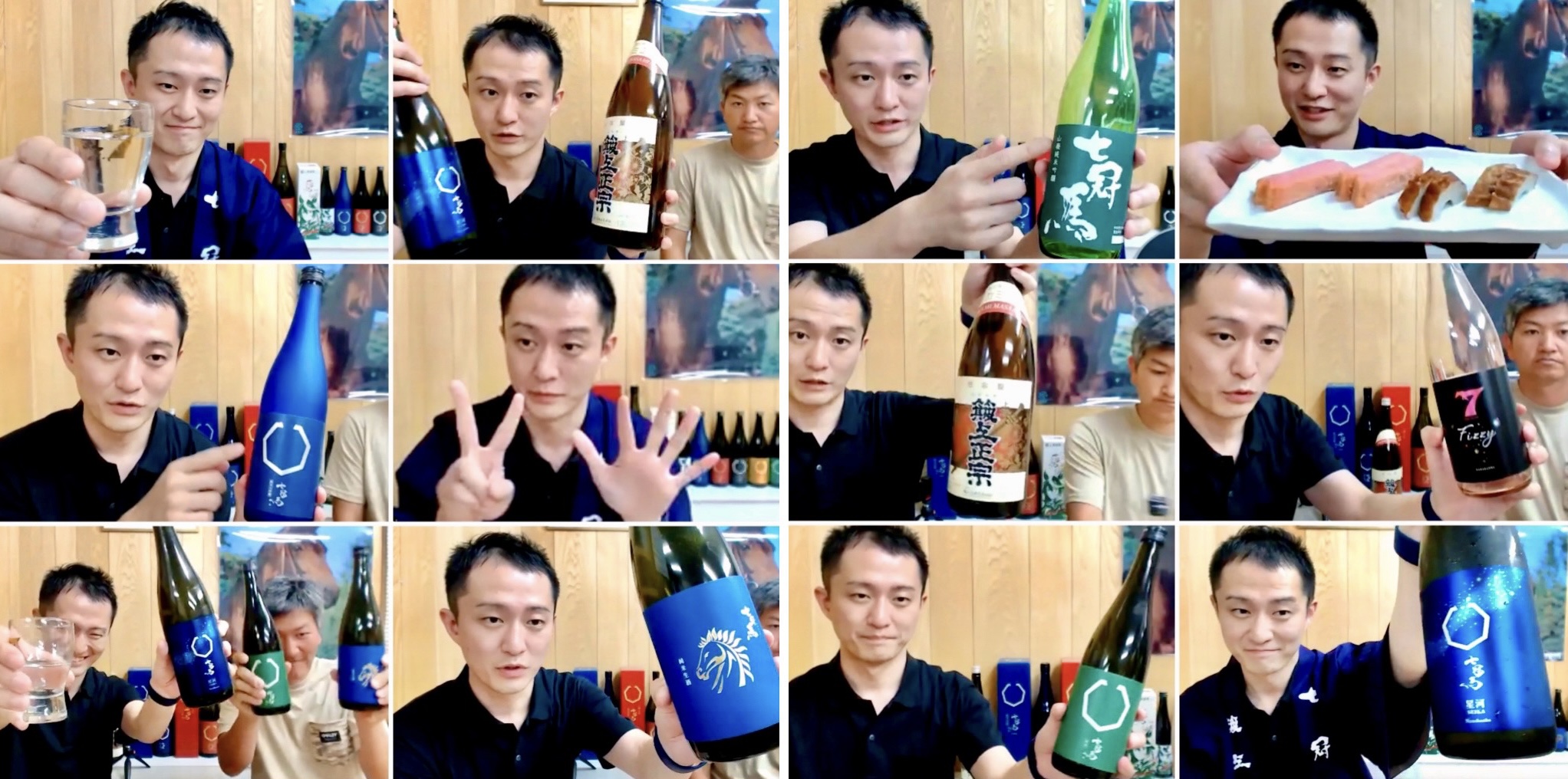
Monday 24th July, 2023, saw TWTT host its 115th session when we headed to Shimane Prefecture to feature Hikami Sake Brewery.
Hikami Sake Brewery is located in the town of Okuizumo, in Shimane Prefecture. Due to the brewery being relocated on more than one occasion, as well as damage caused by a large fire, (which included the loss of historical documents), the exact date of establishment hard to pin-point. The brewery certainly has a long history, dating back to the 1700s, and it is thought the brewery was established around 1712.
Joining us from the brewery was 16th generation, Koichi Tamura.
Prior to coming back home and joining the family’s brewery, Tamura-san studied at Hitosubashi University, Faculty of Commerce. He then went on to work for the beer company, Kirin, for around 9 years. He also studied English abroad and did a wonderful job of presenting this TWTT session in English.
After an introduction and powerpoint presentation, Tamura-san gave us a live virtual tour of their 5 tiered brewery. During the brewery tour, he bumped into fellow worker, Daisuke Takahashi, who is about to step into the role of Toji after being with the company a number of years.
Takahashi-san then joined us for the rest of the session. Also joining us from the company was Kanako Kashiwai, who has only recently joined the team, and holds a sales role at Hikami.
The brewery currently produces around 1000 koku. They began exporting 5 years ago and currently export to 10 countries including France, Switzerland and Spain.
Hikami has 3 main brands: Nanakanba, Tamahagane and Hikami-Masamune.
Last year saw the brand Nanakanba get a label revamp and we got to learn of the story behind the horseshoe on the new label. In fact, there were many interesting stories during this session, and as per many sessions, we went overtime… about an hour or so longer than scheduled… but with such a long history, there was a lot to try and get through! The fact that Hikami Sake Brewery is known as the birthplace of non-foaming was certainly the cause for a rather lengthy and interesting discussion.
A most enjoyable session and a huge thank you to Koichiro Tamura for sharing his time, stories, vision and brewery with us all, (and for his wonderful effort presenting the session in English). Thank you also to Daisuke Takahashi, Kanako Nishikawa, and of course to my co-host, (and interpreter when needed), for this session, Christopher Hughes.
Also, a special shout-out to Fujie-san and Shiga-san.
As always, thank you to everyone who attended this session.
Taste with the Tōji ~ Session 114:
Miho Imada
Re-visiting Imada Shuzo (Hiroshima)
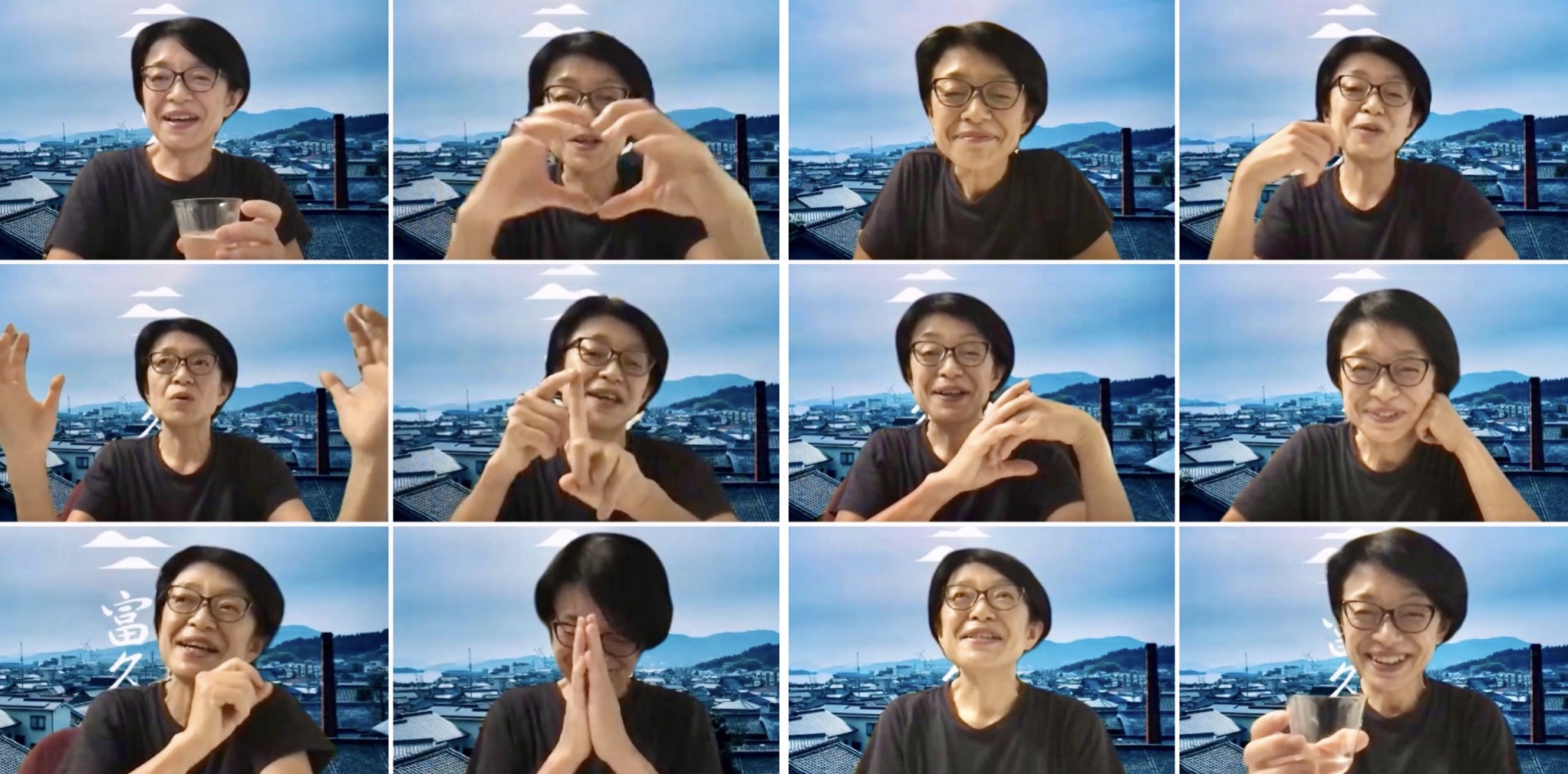
Monday 10th July, 2023, saw the 114th session of TWTT take place when we headed back to re-visit the brewery that kicked-off these TWTT Zoom sessions back in April 2020.
I speak, of course, of Imada Shuzo, producer of the brand Fukucho.
Imada Shuzo was established in 1868 in the town of Akitsu in Hiroshima Prefecture.
Joining us from the brewery for our 114th session was the one and only Miho Imada.
When I recently approached Imada-san about coming back to do another TWTT session, I was thrilled when she agreed to join us in the Zoom room once again and fill us in on what has been happening at her brewery since we last chatted with her back in 2020, (Sessions #1 & #11).
Since 2020, Imada-san and her brewery have featured heavily in numerous media spotlights. The brewery has also seen some staff changes, along with some serious re-branding and several new products, including their most recent release: a sake specifically created to pair alongside spicy food (namely Chinese cuisine), which will be exported to China initially, with hopefully more countries to follow. We were certainly all left craving spicy food and a desire to taste Imada-san’s new brew.
A huge part of Monday night’s conversation was centred around the topic of her recent ‘Hybrid Kimoto’ releases and the trial, error, development and selection process of the specific ‘lactic acid bacteria’ used for these new brews.
We were treated to a further in-depth extension of the discussion when Rumiko Moriki joined in the conversation, which was truly a joy to witness and be part of – and kind of a ‘you had to be there’ moment. It is always such a treat to see the interaction between brewers on TWTT.
There was certainly no shortage of things to talk about during this session. Remembering back to the very first session, which was scheduled for a 2 hour duration, however, Imada-san and Andy Russell ended up entertaining the enthusiasm of the attendees, chatting to the audience and answering a tonne of questions well into the midnight hour, racking up 4 hours on the TWTT clock. I was mindful of this on Monday and had promised Imada-san we wouldn’t keep her up that late this time round – however, she still gracefully gave us an extra hour of her time in what was a really informative and enjoyable 3 hour session.
A huge, huge thank you to Miho Imada for sharing her time, knowledge, news, passion and energy with us all. An extension of that thank you must go out to the incredible Maki Tanaka for a phenomenal interpretation during this in-depth, 3 hour-long session. A truly amazing job! Otsukaresama!
Thank you also, as always, to everyone who attended this session.
Taste with the Tōji ~ Session 113:
Takafumi Nakajima
Nakayu Shuzo (Miyagi)
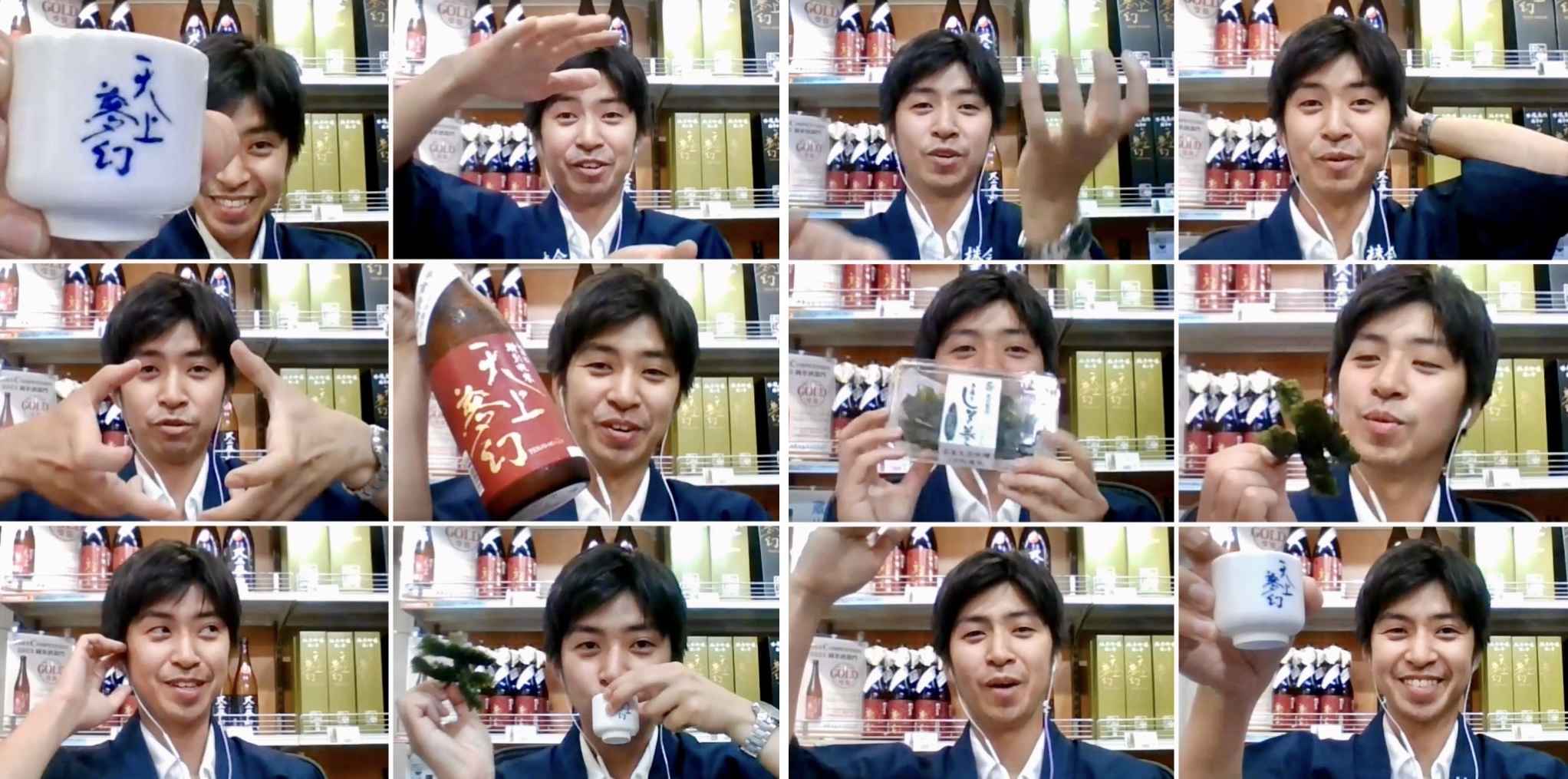
On Monday 26th June, 2023, TWTT held its 113th session when we headed to Miyagi Prefecture to feature Nakayu Shuzo.
This was TWTT’s 8th visit to Miyagi Prefecture, but the first time to feature this particular brewery.
Established in 1906, Nakayu Shuzo is a fall family-run brewery, located in the town of Kami. The brewery takes its name from its founder, Nakajima Yuji.
Joining us from the brewery for this session was 5th generation, Takafumi Nakajima.
Their main brand is Tenjo Mugen, however this was not one of their original brands. The Tenjo Mugen label was started by the 3rd generation Kuramoto.
The brewery ceased operation for around 10 years due to the war but fortunately were able to pick up production again. Their current annual production, with a team of 8 brewers, is around 400 koku, and over 90% of the sake they produce is ginjo.
They brew from November – March.
85% of the rice they use to brew their sake is grown in Miyagi Prefecture.
Kami Town, where the brewery is located, is along the Naruse River, which flows through the Osaki Plain in the northern part of Miyagi Prefecture. To the west you can view Mt. Funagata, while the entire area is blessed with a natural rural landscape.
Takafumi Nakajima told us his main roles at the brewery are koji and analysis. They use 3 different types of Koji-kin at Nakayu Shuzo.
When talking more about his analysis work, Nakajima-san’s analogy was “working in a sake brewery is kind of like working in a zoo as a caretaker – we are ultimately caring for living things.” When talking about the speed of different fermentations, we asked him what animal he associates a fast fermentation with – his reply: a small critter like a squirrel… and on the other hand, a slow fermentation is associated with a turtle.
With a background in food science, Nakajima-san undoubtedly has a lot of love and passion for what he does, but it was great to see he also has a wonderful sense of humour and imagination.
He was an absolute joy to chat to and it was wonderful to have Rumiko Moriki join the Zoom room and get involved in the discussion with Nakajima-san. Always great to see this kind of interaction on TWTT between brewers.
A huge thank you to Takafumi Nakajima for sharing his time, passion, knowledge, humour, otsumami and philosophy with us all. An extension of that huge thank you must go out to the amazing Maki Tanaka for yet another wonderful interpretation. Also, to Yasuhiro Fujie for helping to bring this session to the table.
As always, thank you to everyone who attended this session.
Taste with the Tōji ~ Session 112:
Shotaro Okada
Chiyonokame Shuzo (Ehime)
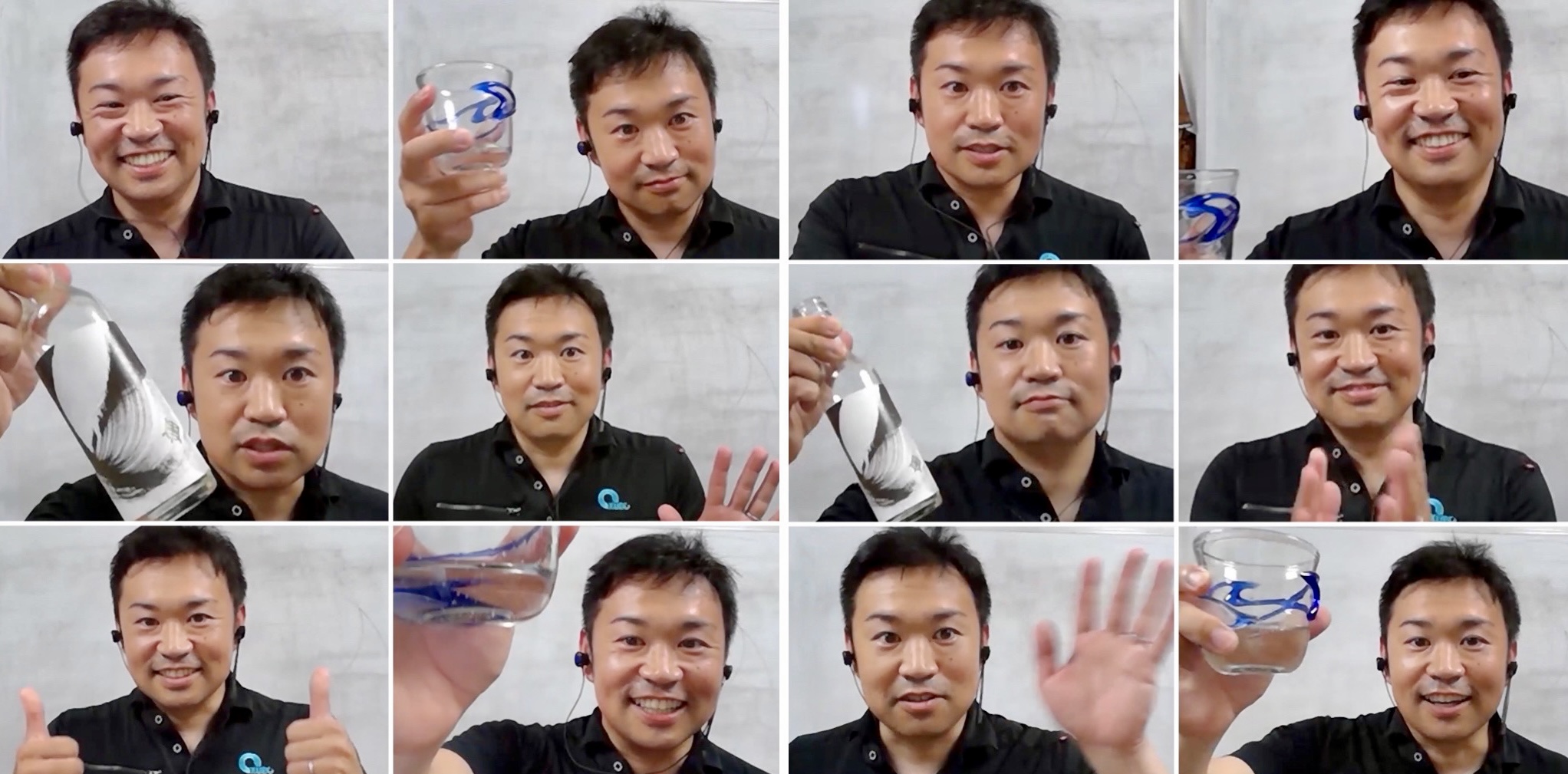
Monday 19th June, 2023 saw TWTT host its 112th session as we headed to Ehime Prefecture to shine a spotlight on Chiyonokame Shuzo.
This was only the second time for us, at TWTT, to visit Ehime Prefecture – home to approximately 22 ‘active’ sake breweries. The first time we visited Ehime was back in November, 2021, for session #66 when we paid a virtual visit to Yagi Shuzobu. This time it was Chiyonokame’s time to shine and we were joined by 11th generation Kuramoto, Shotaro Okada. (I must give a shoutout to Charles Stewart who helped set up both of these Ehime TWTT sessions)
Okada-san’s family did not have a history in the sake brewing industry, but rather the construction industry – however, they took over the brewery, in response to it facing closure, around 20 years ago. His family felt the brewery was an essential business for the local community and culture and stepped in to save it from being another statistic within the industry.
The brewery has been producing sake for the local community for around 300 years, and more recently have begun exporting to a handful of countries. Whilst the family managed to save the brewery from having to close its doors, the brewery again took a hit when the pandemic came out of nowhere and their already modest production dropped to an even lower number.
Still in somewhat of a recovery mode, post-pandemic, the brewery currently produces around 150 koku with hopes that this number may grow a little in the near future.
Okada-san mentioned that along with his family wishing to save the brewery, they also wanted to see the local rice farmers continue to thrive and to protect the local landscape that contributes to the harvest. 100% of the rice they use is farmed locally and around 20% of that is sourced from the surrounding, and most picturesque, terraced rice fields near Uchiko, the town in which the brewery is located.
Despite their humble size and small output, they are not afraid of taking some risks and trying new things.They have been producing a ‘frozen sake’ since 1988, which is still one of their most popular products to date. An interesting fact to point out is that prior to its release, this particular sake is first aged for 10 years, (at -5 degrees celsius).
This small brewery with a big heart has one of the shortest brewing seasons, which last for only around 3 months. For around 20 days during that time, they welcome visitors to the brewery to participate in brewery work, and the brewing process – something that I think sparked a little interest amongst TWTT attendees. It’s great to see more and more breweries offering these kinds of brewing experiences.
A huge thank you to Shotaro Okada for sharing his time, story, philosophy and vision with us all. An extension of that thank you must go out to Maki Tanaka for another wonderful interpretation.
Thank you also to everyone who attended this session.
Taste with the Tōji ~ Session 111:
Niichiro Marumoto
Marumoto Shuzo (Okayama)
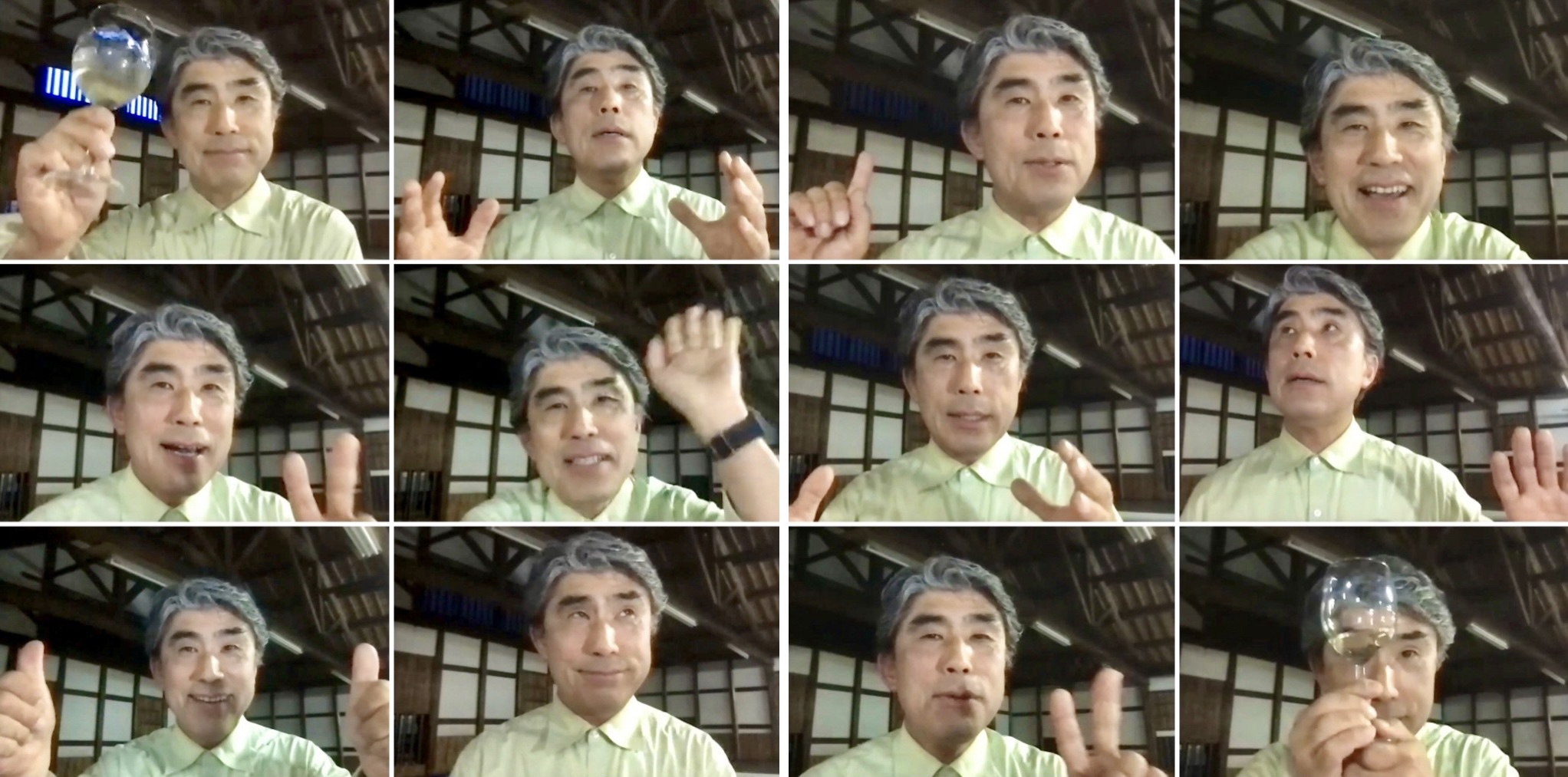
On Monday 29th June, TWTT headed to Okayama Prefecture to re-visit Marumoto Shuzo.
Marumoto Shuzo were TWTT’s feature brewery back in November, 2020, for session #25.
Joining us once again from the brewery was Niichiro Marumoto. Last time we met on TWTT, Chris Hughes joined us as interpreter and co-host – this time, we welcomed Chris back, alongside a second co-host/interpreter, Maki Tanaka.
This session certainly made a habit of going off on tangents, as we knew it would, hence the decision to have 2 co-hosts helping with interpretation, and a great decision it was – both, as always, did a remarkable job of keeping up with the, at times obscure, conversation.
Founded in 1867 by the Marumoto family, the brewery is located in the small town of Asakuchi in western Okayama. Nestled into a landscape of unspoiled nature, Marumoto Shuzo has its own rice fields – with a huge focus on organic rice farming.
Last session, back in 2020, gave us an introduction to the brewery, as well as an insight into the emphasis Marumoto put on organic rice farming and just how important that is to them at the brewery. We also looked at some of their Chikurin range, alongside their Houhoushu Sparkling.
This time round, we managed to skip some of the basic intros and went straight down a few rabbit holes, the deepest one probably being the topic of ‘power spots’. From the tombs of Egypt to the rice fields of Okayama, earth science, the Quantum mind, deep field energy and observatories… all which, in some way, led us back to the topic of their organic sake.
I had the pleasure, (along with Maki), of meeting Marumoto-san in person last year, in Tokyo, and was delighted when he told us he’d be happy to do a follow-up TWTT session.
We weren’t quite sure where this session would take us, but we knew the ride would be an interesting one – and it was. Marumoto-san is cool, calm, collected, eccentric and rather fascinating, and there’s never a dull moment in conversation with him.
A huge thank you to Marumoto-san for sharing his time, stories, travel adventures, observations, philosophies, knowledge and sense of humour with us all. An extension of that huge thank you must go out to both Chris Hughes and Maki Tanaka for working together as co-hosts/interpreters for this session, and doing a wonderful job.
Thank you as always to everyone who attended this session and a special shout out and thanks to Thomas Ng from Sakelier for getting some sake out to me in time for this session.
Taste with the Tōji ~ Session 110:
Shoichiro Morishima
Morishima Shuzo (Ibaraki)
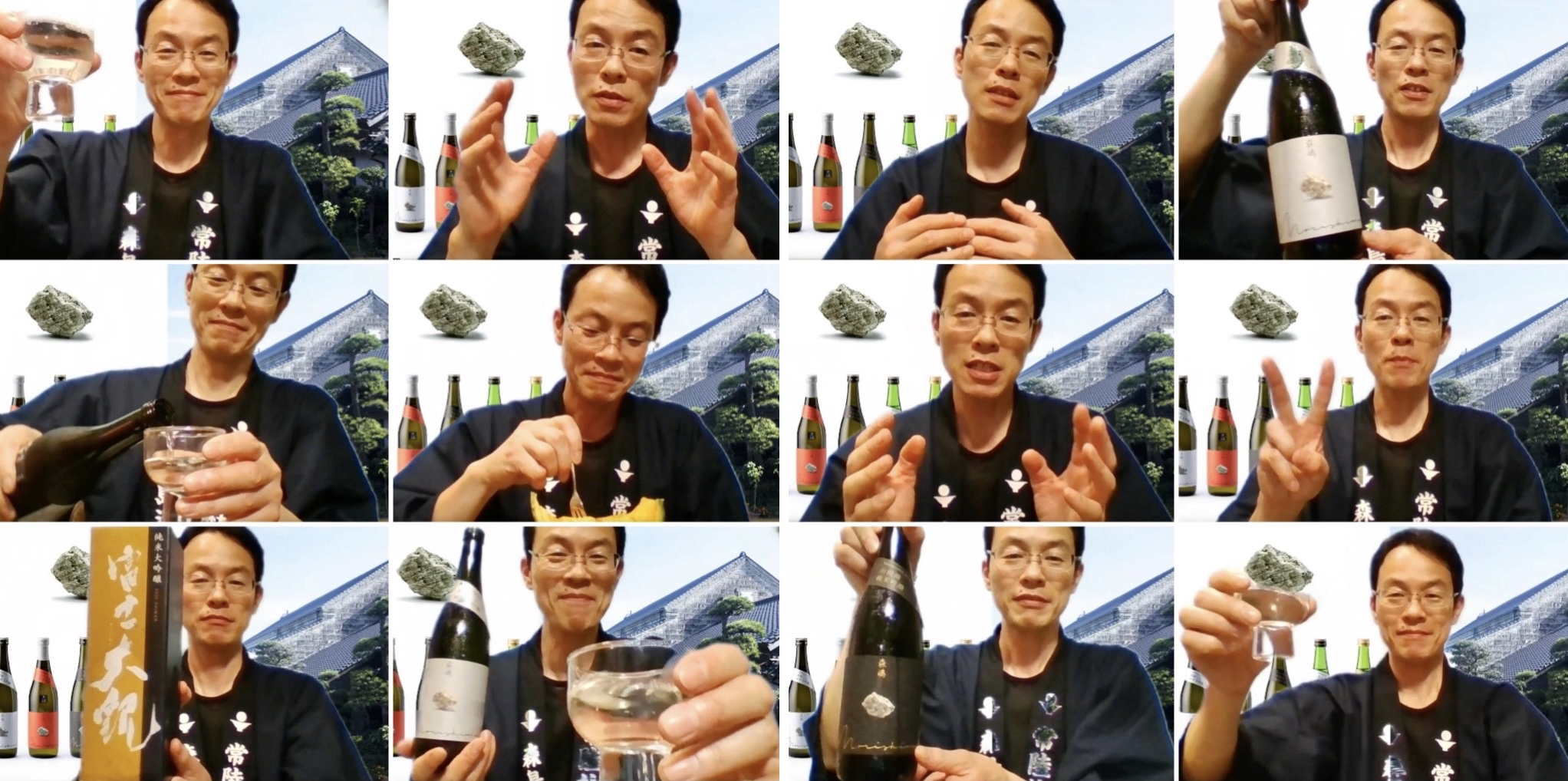
Monday 22nd May, 2023 saw TWTT host its 110th session when we headed to Ibaraki Prefecture to feature Morishima Shuzo.
This session was a long time in the pipeline and it was so great to finally have the opportunity to hear from 6th generation Kuramoto, Shoichiro Morishima, who joined us for this session, and to learn more about his brewery.
Morishima Shuzo was founded in 1869 and is located within close proximity, (around 70 steps to be more precise), to the Pacific Ocean in the town of Kawajiri, Hitachi City, in Ibaraki Prefecture.
Since its foundation, the brewery has certainly seen its fair share of hardships, including its complete destruction during the war in 1945. The brewery was rebuilt using Oya tuff stone, a strong and fire-resistant stone from Tochigi Prefecture.
Sadly, in 2011, the brewery suffered significant damage from the Great East Japan Earthquake in 2011 – so significant in fact that cracks, large enough to see the sky through, formed in their Oya stone foundation. They also lost a huge amount of their sake in the earthquake, and as a result of yet another disaster, they even considered folding the business.
Thankfully, they were able to overcome the hardships they were dealt and continue to brew delicious sake in the town of Kawajiri.
At 48 years of age, Morishima-san has already spent more than half of his life brewing sake, with 26 years under his belt – 24 of them at Morishima Shuzo. He holds both Nanbu Toji (2006) and Hitachi Toji (2019) qualifications, and in fact was the first Toji from Ibaraki Prefecture to obtain Nanbu Toji qualification.
Morishima Shuzo’s two main brands are ‘Fuji Taikan’, (originally called Gantan Masamune but changed its name in 1953), and ‘Morishima’ – their newer label, released in 2019 in conjunction with the brewery’s 150th anniversary.
Those who have seen the Morishima brand label, will have noted the unique design featuring an image of a rock/stone. The image is actually that of a fragment of an Oya stone wall, damaged in the earthquake, and symbolises, amongst other things, the ‘unbending spirit of the brewery’.
That spirit certainly shone through when speaking with Morishima-san, in addition to his unbending spirit, his humbleness and honesty also came through and his words, stories and philosophy resonated with the TWTT audience.
A huge thank you to Morishima-san for sharing his time, passion, knowledge, dinner, sake and honesty with us all, (and for giving us a look inside his brewery via a virtual tour).
I must extend that huge thank you not only to Maki Tanaka, who once again shone so bright as co-host and interpreter for this session – which actually hit the 3 hour mark, but also to Morishima-san’s sister, Shizuko Tanaka, whom without, this session would never have happened. Thank you for your passionate persistence and your assistance!
As always, thank you to everyone who joined this session. It really was a special one.
Taste with the Tōji ~ Session 109:
Kenichi Morishige
Sakai Shuzo (Yamaguchi)
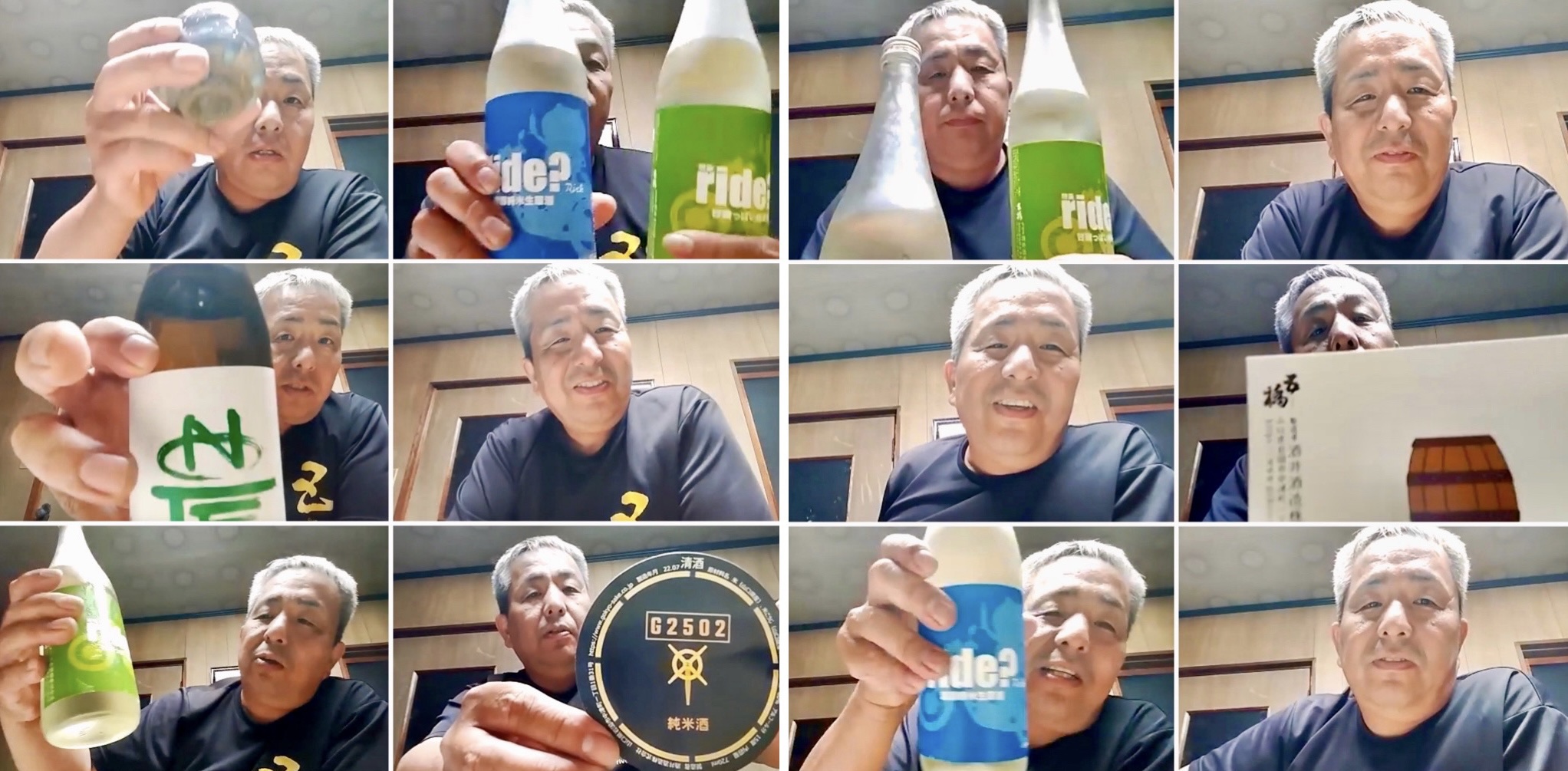
Monday 15th May, 2023 saw TWTT host its 109th session as we re-visited Sakai Shuzo in Yamaguchi Prefecture.
Established in 1871, Sakai Shuzo is located in Iwakuni, Yamaguchi Prefecture. It is one of 24 sake breweries currently brewing in Yamaguchi Prefecture. The town of Iwakuni is most well known for the Kintai Bridge which was built in 1673. This historic wooden bridge consists of five wooden arches crossing the Nishiki River and is an incredibly popular spot for tourists, especially around Spring and Autumn.
This was the second time for Sakai Shuzo to be the featured brewery on TWTT. The first session was back in April 2021 and our guest for that session was Fumihiko Nakama, who, at the time, was Toji.
This time around, we were joined by Kenichi Morishige.
Late last year, the brewery made a few changes – one of them saw Morishige-san take over the role of Toji after spending 15 years as Fuku-Toji (basically 2IC). Nakama-san is still (very much) working for Sakai Shuzo, however, his role has changed, and it was great to have him in attendance for this session.
Morishige-san comes from a rice farming family, so it seems only fitting that he should end up brewing sake… yet despite his roots, he had no desire to be involved in the family farming business when he was younger. He also told us that he had no aspirations to work in a sake brewery – it was something that happened more by chance as he was looking for a job in the area and one became available at Sakai Shuzo. 34 years later…. he is now the Toji.
He signed up at Sakai when he was 18 years of age. He told us for the first 10 years or so, he really didn’t love his work at the brewery, it was just a job. However, after a decade of doing what he saw as somewhat mundane work, he began getting more involved in the brewing side of things.
Morishige-san explained that when he took on the role of Fuku-Toji, he felt comfortable with the idea that he would see out his working years working under Nakama Toji. The changes at the brewery last year certainly took him by surprise and he felt a little apprehensive to begin with. Now, after his first season as Toji, it appears he is fitting into his role nicely, leading a team of around 8, and looking forward to putting his spin on a few new products.
One of those products is due to be released in July this year and we got a sneak peek at the label design. It’s called G2502, a junmai-shu. The label is based on a steam train that seasonally runs in Yamaguchi Prefecture, of which Morishige-san is a fan of. The name, G2502, has nothing to do with trains… the G represents ‘Gokyo’ and the 2502 is what you get when you add 1801 and 701 (the 2 yeasts used in this sake).
We are told though, that his favourite yeast to use is #9, and his favourite rice to brew with is Omachi… so perhaps there are a few more new brews on the horizon for Morishige-san.
Sakai Shuzo grow a lot of their own rice, and where they don’t – it was great to hear that they still only use rice grown in Yamaguchi Prefecture. Around 20 years ago, they also started using some of the Morishige family’s rice fields, which Morishige-san now oversees, surprising his 18 year old self that not only is he now involved in the farming of sake rice, he is also brewing sake using that rice. Funny how things turn out sometimes.
It was a joy to hear Morishige-san’s story and hear a little about what is on the horizon for Gokyo. We wish him all the best moving into his second season as Toji and look forward to seeing the release of G2502 this Summer in Japan.
A huge thank you to Kenichi Morishige for sharing his time, story and knowledge with us all. An extension of that huge thank you must go out to the Yamaguchi Sake Guy himself, Mr. Jim Rion. So great to have Jim back on TWTT alongside a Yamaguchi Brewery. We look forward to a few more in the future.
As always, thank you also to everyone who attended this session.
Taste with the Tōji ~ Session 108:
Norihiro Fuji
Fujii Shuzo (Hiroshima)
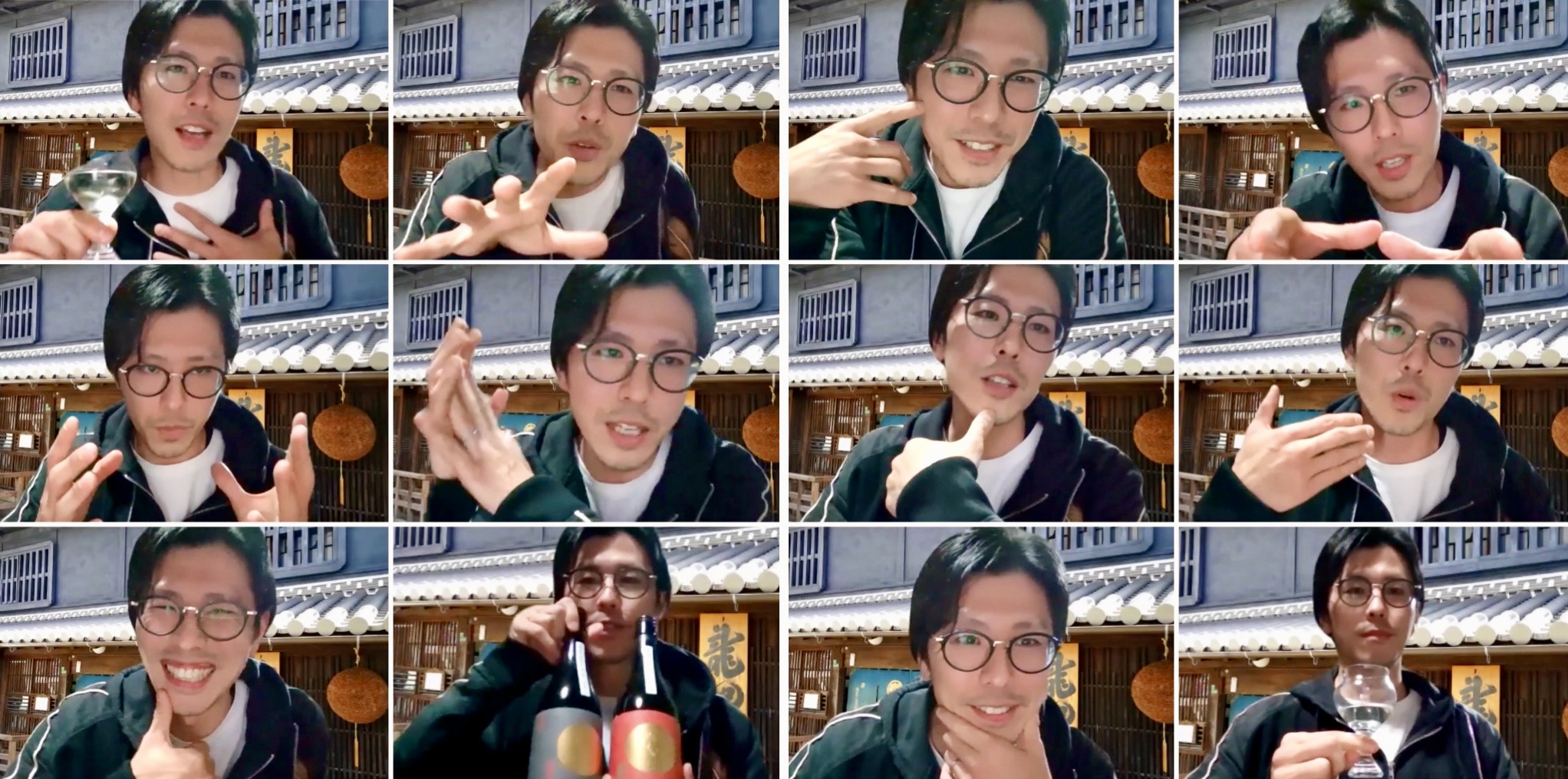
On Monday 24th April, 2023, TWTT hosted its 108th session when we headed to Hiroshima Prefecture to feature Fujii Shuzo.
Fujii Shuzo was established in 1863, in the picturesque town of Takehara, situated along the Seto Inland Sea ~ which was around the same time that Senzaburo Miura developed the ginjo style of sake in the neighbouring town of Akitsu, (home of Imada Shuzo, TWTT Sessions 1&11).
We first featured Fujii Shuzo on TWTT back in May of 2021, when we spoke to 5th generation owner, Yoshifumi Fujii. This time round, our guest was 6th generation, Norihiro Fujii.
Last time we featured Fujii Shuzo we learnt that they were an all Junmai brewery ~ using only rice, koji, water and yeast to brew their finely crafted sake. We also heard about their strong focus on brewing sake using the Kimoto method ~ a focus that has only intensified since then, with Norihiro explaining that roughly 90% of what they currently produce is Kimoto. In fact, he informed us that they are aiming to make that percentage 100% next brewing season.
Fujii Shuzo currently produces around 800 koku per year.
We learnt about their progressive process of changing their ‘ingredients’ for the sake they produce. For example, in the last 10 years, they have shifted from using 6 rice varieties to 4, and 6 yeast types now down to 2. By 2028, they plan to completely eliminate the use of Kyokai yeast as they fine-tune the aspects of ‘natural’ and ‘local’ for their sake.
Norihiro also mentioned that this brewing season just gone, was the first year they have used rice grown in Takahara and he looks forward to using more locally grown rice in the future.
Norihiro spoke very candidly to us about the brewing, philosophy successes, failures and future plans at Fujii Shuzo, including ‘Ryusei Lab’ and some recent experimental brews that, although got released, he doesn’t feel they are good enough to produce again. He will however, continue to experiment and progressively push some boundaries when it comes to new brews.
Norihiro was a joy to listen to and speak to and clearly enjoyed engaging with the TWTT audience as he ended up outstaying all but a handful of attendees in the Nijikai – which I am told went on until 1am JST, (I didn’t quite make the distance, bowing out a little after 12AM AEST).
A huge thank you to Norihiro Fujii for his time, and for candidly sharing his knowledge, story, philosophy, thoughts and hopes with us all. An extension of that huge thank you must go out to Maki Tanaka, co-host and interpreter for this session… and well into the Nijikai!
As always, thank you to everyone who attended this session.
Taste with the Tōji ~ Session 107:
So Okasora
Chiyomusubi (Tottori)
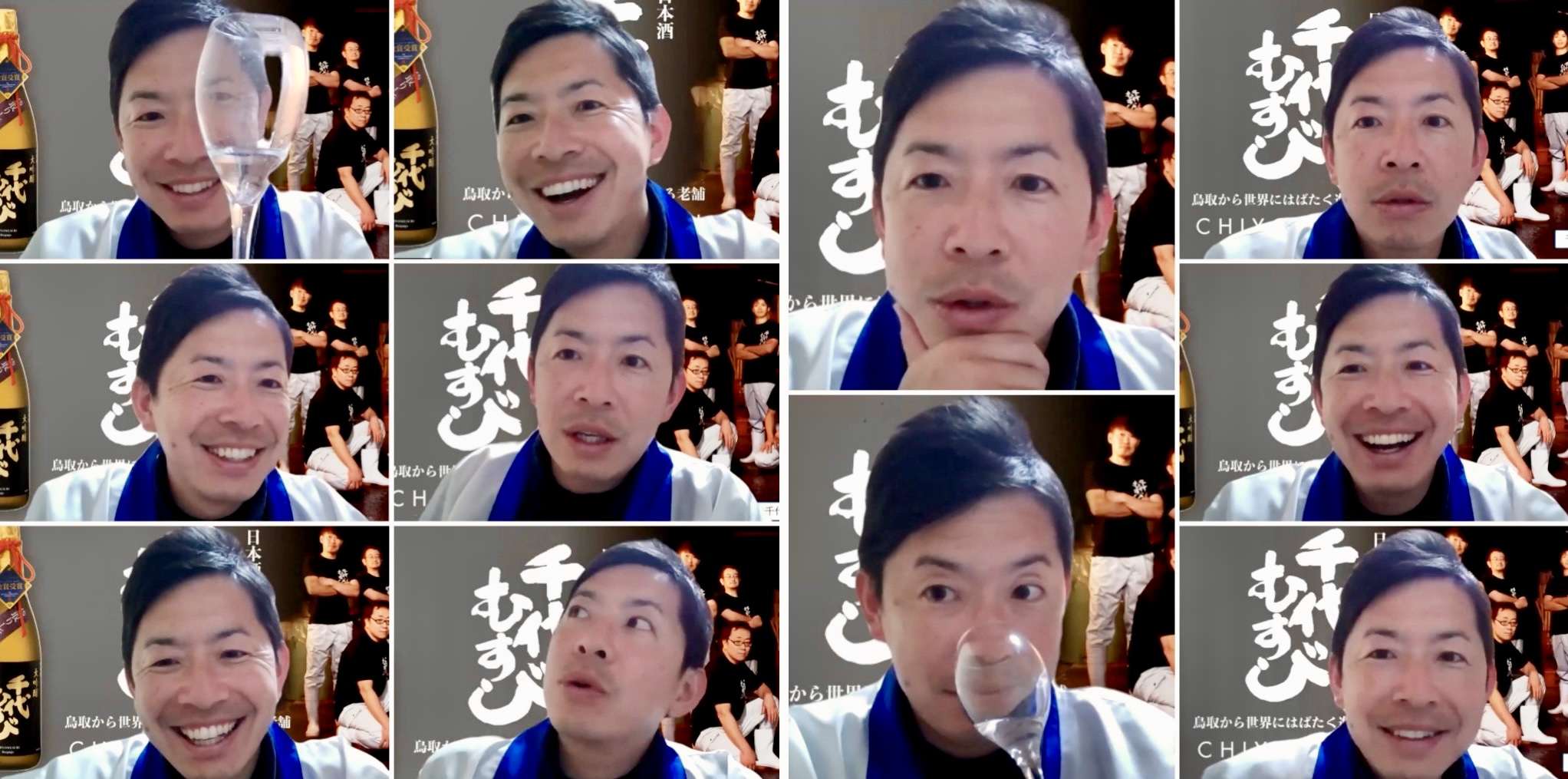
Monday 17th April, 2023 saw the 107th session in the TWTT series. For this session, we headed to Tottori Prefecture for only the second time in this series.
We first visited Tottori way back in 2020, for session #27, when we featured Ohta Shuzo (makers of Bentenmusume). This time, the TWTT spotlight was shining on Chiyomusubi, located in Sakaiminato, Tottori.
Sakaiminato is a port city, about a 15 minute drive from Yonago airport.
Founded in 1865, Chiyomusubi has a long and interesting history and one that has seen them relocate a couple of times, only to see the brewery destroyed in an explosion in 1945. Fortunately, they were able to rebuild the brewery after such a disaster and continue making sake. In 2000 they began producing shochu, and over the years that followed, they have built an impressive line-up of distilled products under the Chiyomusubi name, in addition to their shochu, including Whisky, Gin and Vodka.
Joining us for this session was So Okasora, who will be the 6th generation Kuramoto, currently working alongside 5th generation Haruo Okasora.
So-san is from Tottori, however, he was not born into this brewing family. He actually married into the brewery, thus adopting the Okasora name.
Chiyomusubi currently employs 7 brewing staff and produces around 1200 koku. They began exporting their products in 1995 and now a whopping 30% of what they produce is exported (to around 20 countries).
The brewery focuses heavily on using locally grown rice and it was great to see a lot of love for Goriki rice, which hasn’t had a lot of exposure during TWTT, at least not since session #7 with Watanabe Shuzoten (Gifu Prefecture).
The use of Goriki rice is just one way in which Chiyomusubi continue to focus on ‘local’ and it’s something they certainly take pride in.
Tottori, specifically the Sakaiminato area, as it so happens, is home to a self-professed ‘Manga Kingdom’, due to it being the birthplace of some of the most famous manga artists. From museums to monuments, it’s a manga lovers paradise. Mizuki Shigeru road, a traditional shopping street, is lined with more than 150 bronze statues of yokai (supernatural monsters) that emerged from the bizarre and brilliant imagination of artist Mizuki Shigeru. What’s the connection to Chiyomusubi? You can find some of these famous Yokai characters on the labels of a selection of Chiyomusubi bottles and one cups.
As always, there was a lot to cover in our 2 hour limit, (which, as always, we went a little over). We certainly managed to touch on many aspects of the Chiyomusubi story, their products, their brewing (and distilling), the region and more, (including a little insight into the production of their sparkling sake ‘SORAH’).
A huge thank you to SO Okasora for sharing his time, knowledge, passion and stories with us all. An extension of that huge thank you must go out to Maki Tanaka who was a most fabulous co-host and interpreter for this session.
Thank you, as always, to everyone who attended this TWTT session.
Taste with the Tōji ~ Session 106:
Shigeru Mukuda
(with Yuichiro Ishi, Yumi Shintani, Shuzo Nishimura & Hiroto Ohta)
Kamotsuru Shuzo (Hiroshima)
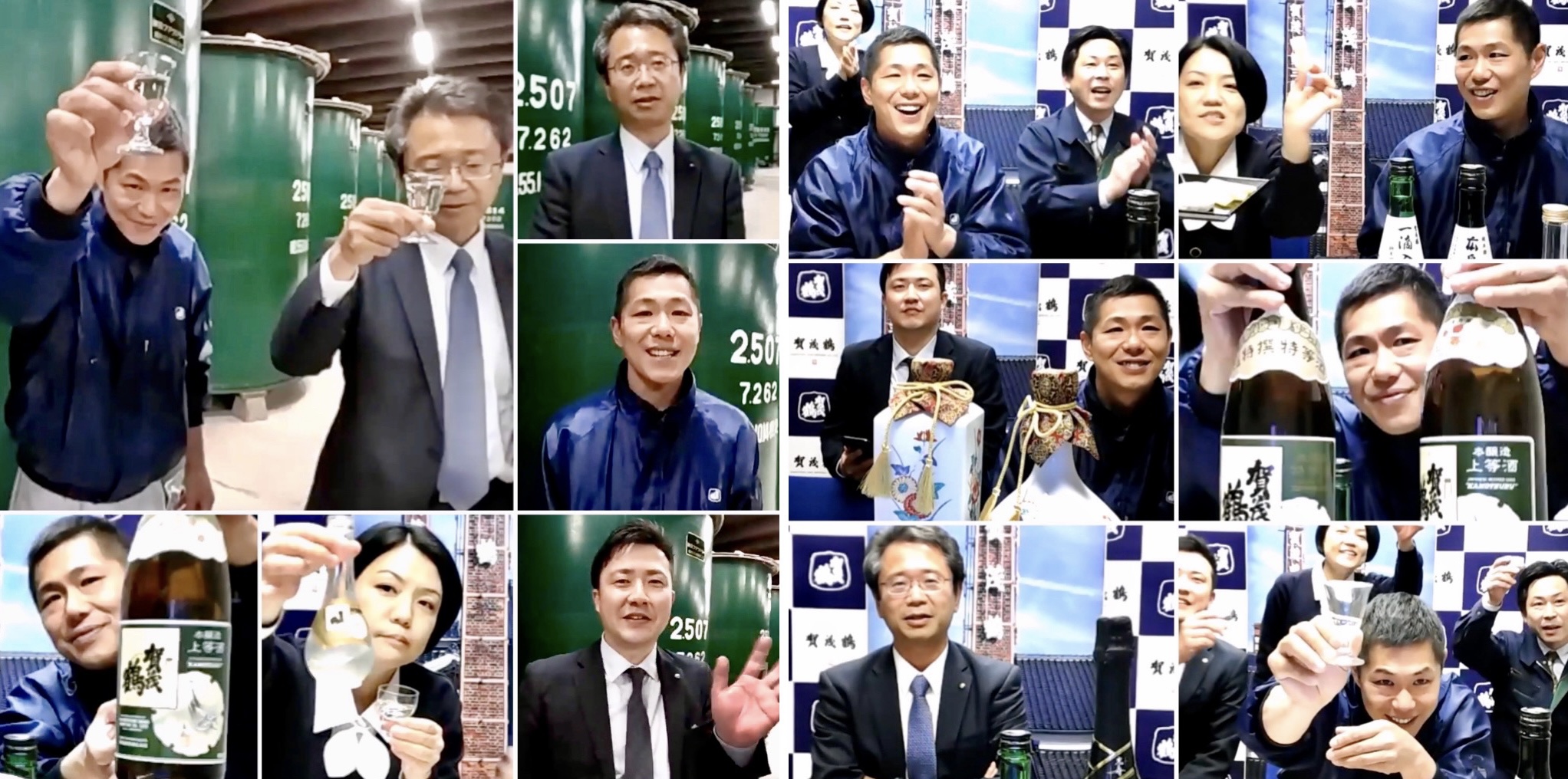
Monday 10th April 2023 saw a fine and fitting return of TWTT after an almost 2 month hiatus.
For this session, number 106 in the TWTT series, we headed to Hiroshima Prefecture to shine the spotlight on Kamotsuru Shuzo.
Located in the renowned sake area of Saijo in Hiroshima, Kamotsuru was established in 1873, and then in 1918, they became incorporated as a family-owned and managed company.
Joining us for this session were several members of the Kamotsuru team.
The session began with an introduction from Kuramoto, Yuichiro Ishi, followed shortly after by a Kanpai with flagship Junmai Daiginjo, said to be the first Daiginjo ever made available for public purchase back in 1958. Each bottle of their signature Junmai Daiginjo contains 2 tiny, elegant cherry blossoms made from gold leaf. Along with being Daiginjo pioneers, and numerous other feats, Kamotsuru is also the origin of yeast #5.
The introduction also saw us hear from Toji, Shigeru Mukuda along with Shuzo Nishimura from international sales.
We were treated to a live brewery tour of ‘brewery no. 2’ from Mukuda-san. Kamotsuru have already completed brewing for this current season, so not a lot currently happening inside the brewery other than perhaps the last bit of cleaning – even so, it’s always interesting to see inside the brewery and get a feel for the place. It’s always impressive, in or out of brewing season.
Also joining us from the brewery was Yumi Shintani, who coordinated a few brewing videos to be shown during the kura tour, giving us an idea of what things look like there during the brewing season.
Shintani-san also put together an informative power point presentation and later showed us some dishes she has arranged to pair with Kamotsuru sake. The effort that Shintani-san and everyone involved went to in organising and presenting this session was definitely noticed and appreciated by all who were in attendance.
We certainly managed to cover a lot in the 2 hours allocated for this session.
Talking with Mukuda-san in the Zoom room kind of felt like chatting with an old friend as he freely answered questions with a jovial and infectious enthusiasm. Mukuda-san is just one of the 4 Toji who work at Kamotsuru, each working and leading a team in a different brewery building, producing different sake, passing on tradition along with working on new and innovative ideas and products.
Like all TWTT sessions, we managed to cover a lot in the little time we had, and, as always, could’ve easily filled another couple of hours with more discussion, but we sure ended the session on a most wonderful note! (pun intended).
Joining us towards the end of the session was yet another Kamotsuru member, Hiroto Ohta, who introduced himself as a singer after Mukuda-san was presented with the, what now seems to be compulsory, TWTT music question. Ohta-san quickly took the spotlight and began singing a traditional Hiroshima brewing song.
It was also wonderful to have Rumiko Moriki attend this session and to listen to the wonderful interaction between brewers. Rumiko-san is of course held in high regard by all at TWTT, and all at Kamotsuru, as she spent time with them a few years ago helping them understand the art of Kimoto brewing. She is an absolute legend and it’s always great to see her in the TWTT audience, interacting with guests from other breweries and being the supportive superstar that she is.
A wonderful encore song performance by Ohta-san and Mukuda-san left us all with smiles on our faces and in our hearts.
A huge thank you to Yuichiro Ishii, Shigeru Mukuda, Yumi Shintani, Shuzo Nishimura and Hiroto Ohta for sharing their time, knowledge, passion, heart, stories and of course, song, with us all. An extension of that huge thank you must go out to my good friend, and co-host/interpreter for this event, Harald deRopp for all his efforts in making this session happen, and for his devotion to helping bring these sake stories to TWTT.
Thank you also to everyone who joined this very special session – it was so great to see you all on my screen again and to share yet another wonderful TWTT story with everyone.
Taste with the Tōji ~ Session 105:
Kentaro Yoshimura
Zuiyo (Kumamoto)
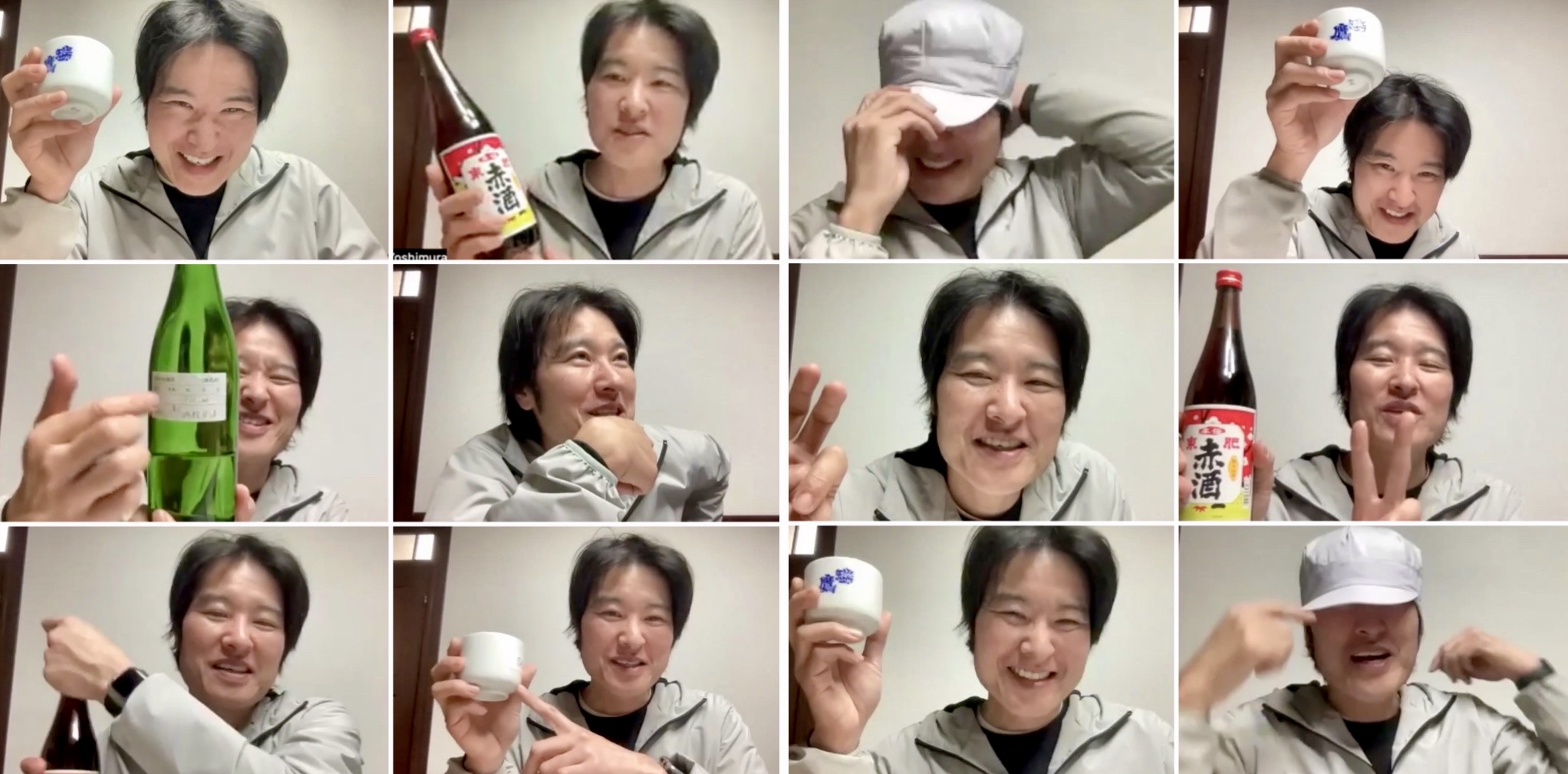
Monday 13th February, 2023, saw the second TWTT session for 2023 when we visited Kumamoto Prefecture to shine a spotlight on Zuiyo.
Zuiyo was founded in 1867 in the town of Kawashiri in Kumamoto Prefecture. Joining us for this session, the 105th in the TWTT series, was 5th generation Kumamoto, Kentaro Yoshimura.
This session began a slow journey down a rose coloured rabbit hole from rather early on thanks to the rather unique Kumamoto style of Akazake, (literally ‘red sake’).
The Akazake I speak of is a kind of alcohol that is unique to Kumamoto Prefecture. It’s a type of Akumochizake, where ash has been added in order to lower the acidity and raise the alkaline levels, which then helps to prevent spoilage.
Mostly used as a cooking sake, we were told that for many years, this Akazake was the only brew the people of Kumamoto were permitted to produce. Sake, more specifically ‘Seishu’ was not permitted to be produced in Kumamoto, nor was it allowed to be brought in from outside the prefecture. Laws changed around the second half of the 19th century, and brewers then began to experiment with making other types of ‘sake’.
As the breweries shifted their focus to making Seishu, many stopped the production of Akazake altogether as brewing methods advanced, and Kumamoto brewers fine tuned their sake making skills, swapping out the addition of ash with the more modern method of pasteurisation.
There are currently 10 active sake breweries in Kumamoto and Zuiyo, we were told, was the first to start producing Seishu, and remains one of the few that still make Kumamoto’s traditional ‘Akazake’, as a kind of homage to their history and the history of the region.
This really was a topic that piqued much interest and prompted many a question from the TWTT attendees.
Of course, there is more to Zuiyo than Akazake and Yoshimura-san presented part of his fairly in-depth powerpoint explaining many things from the brewery’s name and history, to the products they produce, (which include sake, liqueurs, shochu and of course the aforementioned ‘Akazake’). We also touched on Nojiro Kinichi and the origin of Kumamoto yeast, (Kyokai yeast #9), Kumamoto’s own Hananishiki rice, and we touched on a discussion we had late last year during another brewery’s session about Kumamoto’s relationship with the roots of Ginjo sake.
We managed to cram a lot into this session, which went for a little over 2.5 hours. Yoshimura-san was also kind enough to spend even more time answering questions and chatting with those who stayed on for the nijikai.
Zuiyo currently produces a little under 1000 koku. A small amount of their sake is exported to several countries throughout Asia, with an even smaller amount finding its way to the US and Canada.
A huge thank you Kentaro Yoshimura for sharing his time, humour, knowledge and passion with us all. An extension of that huge thank you must go out to Chris Hughes not only for co-hosting and interpreting for this session, but for helping to bring this one to the TWTT table.
As always, thank you to everyone who attended this session.
Taste with the Tōji ~ Session 104:
Hiroyuki Yoshikubo
Yoshikubo Shuzo (Ibaraki)
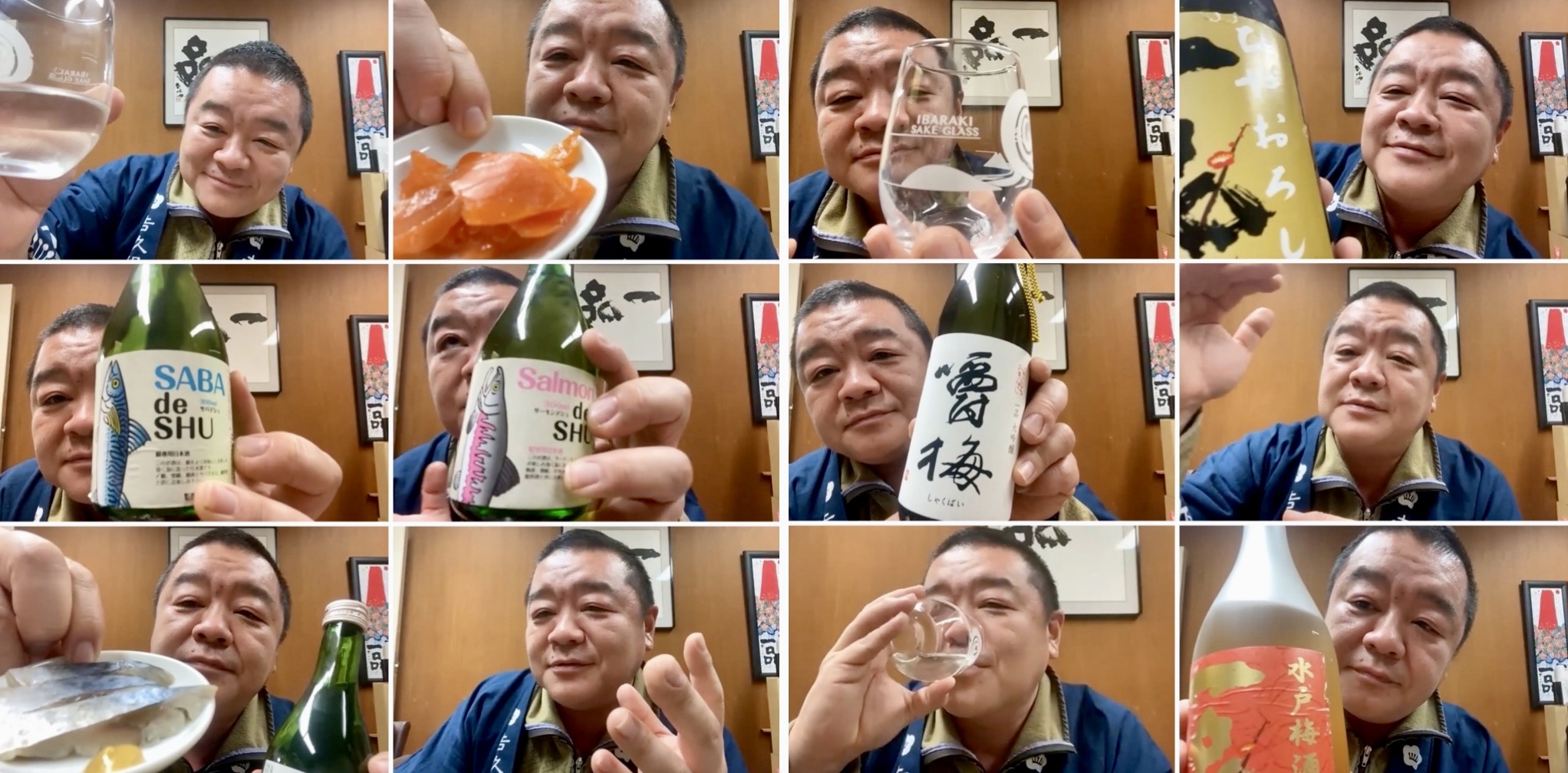
Monday 23rd January saw the return of TWTT after taking a break over the Christmas and New Year period. The first session of 2023 saw TWTT enter its 4th season (!) as we headed to Ibaraki Prefecture to feature Yoshikubo Shuzo.
Founded as a rice business in 1790, and soon after deciding to brew with some of that rice and shift the focus of the business, Yoshikubo Shuzo have been producing sake for 232 years.
Joining us for this session was 12th generation Hiroyuki Yoshikubo.
Yoshikubo-san basically grew up in the brewery and told us that his first taste of sake was when he was in kindergarten! Albeit by accident – at least that’s his story… He claims he ‘accidentally’ drank the sake that was placed on the altar as an offering. Whatever the story, sake clearly runs deep in Yoshikubo-san’s blood.
He knew from a very young age that his destiny was to take over the family’s brewery. However, his other passions are music and cooking and he has managed to fit both of these into his story/career. Not only does Yoshikubo have a restaurant where he promotes not only his sake, but a whole list of sake from Ibaraki Prefecture, he also managed to release a CD of some of his music. When asked what style of music, his response was ‘a mix of Japanese Hip-Hop and Hardcore – piquing the curiosity of many attendees, but alas, we never did get a demo.
Yoshikubo-san tells us that the brewery has a very scientific approach to the brewing side of sake. He also was very adamant in telling us that he/the brewery focuses heavily on the umami factor of their sake rather than being concerned with creating ginjo-style aromatics.
When it comes to marketing and promotion, Yoshikubo-san believes in sake as ‘entertainment’, alongside his other loves of music and food/cooking. In his mind, they all fall into that same category of ‘entertainment’.
Most widely known for their ‘Ippin’ brand, Yoshikubo-san was keen to show us, and talk about, two particular products that the brewery are making that don’t boast the Ippin name on the label. Those two products were ‘Saba de Shu’ (sake designed specifically to pair [only] with Mackerel), and ‘Salmon de Shu’ (sake specifically designed to pair [only] with Salmon). Both sake are made to a recipe of blending multiple styles of sake to create the end product.
Being the ‘entertainer’ he is, Yoshikubo-san also told us that he’d been pushing for a ‘Baka [バカ] de Shu’ … no surprises that one was rejected by the board and never saw the light of day, but an entertaining thought nonetheless.
Yoshikubo Shuzo has a small team of young brewing staff, with the average age being 32. Their Toji, Suzuki-san, is 46 years old and has been brewing with Yoshikubo since he was 18. The brewery produces around 2000 koku each year, and are currently exporting their sake to 15 countries.
A huge thank you to Hiroyuki Yoshikubo for sharing his time, knowledge, stories and humour with us for what was a very entertaining 2 hour session.
An extension of that huge thank you must go out to my co-host and interpreter for the evening, Maki Tanaka. Always a pleasure to work with Maki and we must also give a shout out to Wayne Shennen and Charles Stewart for early communications with Yoshikubo-san.
Thank you also to everyone who attended this session. It was great to see so many familiar faces light up my screen again and a wonderful way to begin this new TWTT year.
Video: Taste with the Tōji, Season 2022 – The year in review
Taste with the Tōji ~ Session 103:
Hitoshi Suzuki
Ichinokura Shuzo (Miyagi)
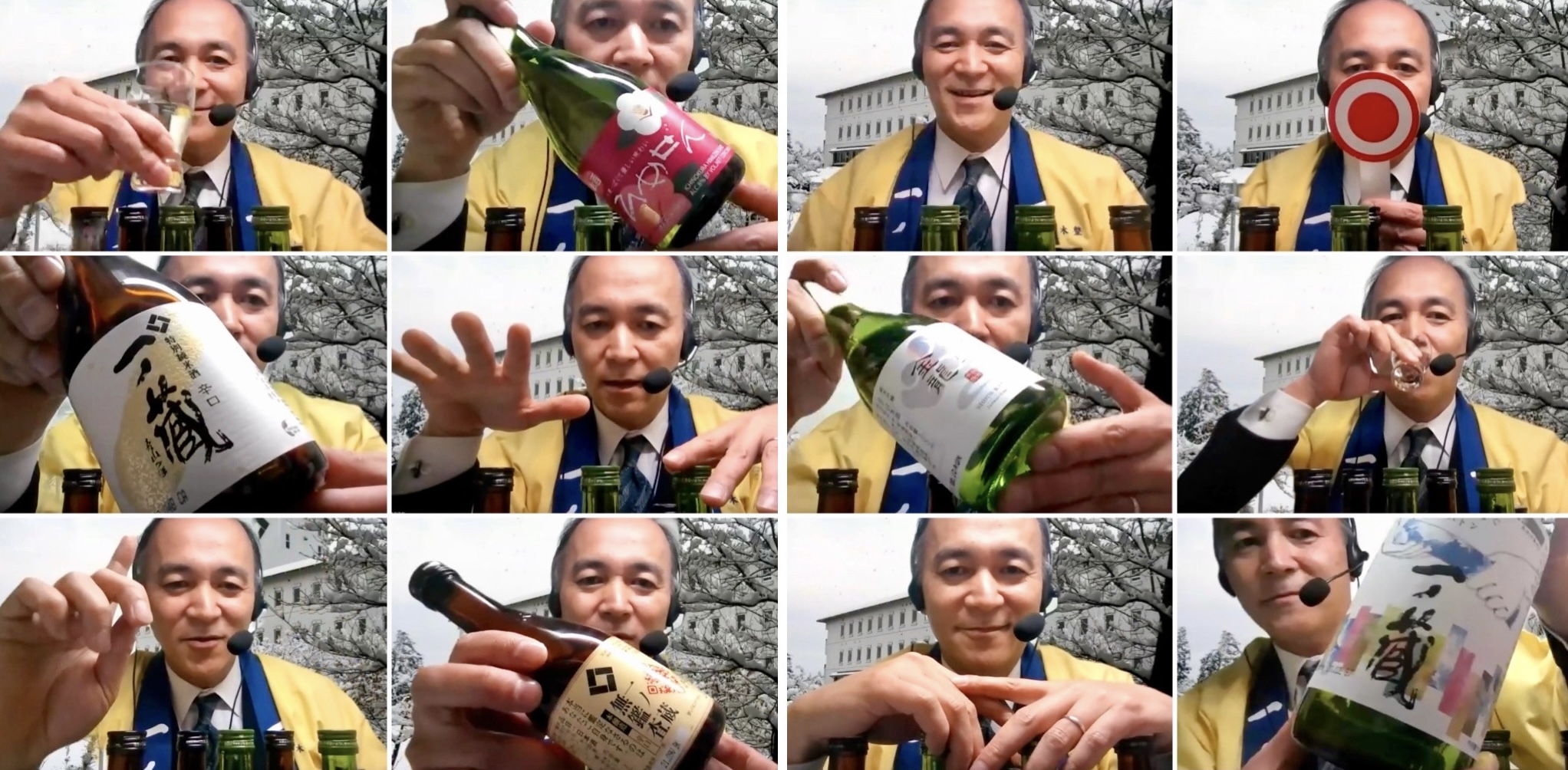
Monday 19th December, 2022 saw TWTT host its 103rd session and the final session for 2022.
We headed back to a Prefecture that is a bit of an audience favourite; Miyagi.
This was TWTT’s 6th time visiting Miyagi Prefecture, and the first time to feature Ichinokura Shuzo.
Joining us for this session was Hitoshi Suzuki.
After his self-introduction and a slideshow discussing the 8 pillars of Ichinokura’s company philosophy, Suzuki-san went on to talk about the brewery’s history.
Ichinokura was established in Matsuyama, Osaki City in 1973 – a rather young brewery it would seem, however, this brewery has an interesting story with regards to its foundation.
At the time of its establishment, big sake breweries were dominating the sake market, leaving many smaller breweries in danger of going out of business. In order to survive in that market, four smaller breweries in the area decided to join forces, merging to create Ichinokura Shuzo. The four breweries were Asami Shoten, Kachiki Shuzoten, Sakurai Shuzoten, and Matsumoto Shuzoten.
Showing no favouritism to any of the four breweries involved in the merge, it was agreed they’d build a new brewery, instead of using one of their existing breweries, in an area that allowed them to prioritise good rice growing and a natural water source – thus Ichinokura was built and born in Matsuyama.
Interestingly, all 4 families of the original 4 breweries are still involved, and equally invested, in the brewery and we’re told they take turns, (with no determined length of time), in officially running the business. Suzuki-san tells us the Asami family are next in line to take the brewery ‘throne’.
They are now one of, if not the largest brewery in Miyagi Prefecture, employing 170 workers, including their 40-person-strong brewing team who brew under (Nanbu) Toji, Terui Kadowaki.
Their annual brewing season runs from September until June. Their annual production sits between 10,000 and 13,000 koku, (depending on the impacts of a global pandemic).
We’re told around 99% of the rice they use is grown locally, in Miyagi Prefecture, (the remaining [approx] 1% is Hyogo-grown Yamada Nishiki). 10% of the rice they use is grown by the brewery.
They produce a range of brands/labels including Mukansa, Suzune, Himezen and Kinryu, the latter being a sake they produce at their second brewery. Yes, there’s more! Hence why we almost started to head down a long rabbit hole similar to last week’s session… but we tightened the reins just a little this week and wrapped up the ‘official’ part of the session just after the 3 hour mark.
It was a touching way to finish the session in learning about the sake they produce to help children who lost their parents during the Great East Japan Earthquake. The charity project is named, “3.11 Baton Pass to the Future” and proceeds from the sale of said sake continues to go towards this important cause.
With still so many more questions that could’ve been asked and topics discussed, we may just have to get Suzuki-san back in the TWTT hot seat again sometime.
A huge thank you to Hitoshi Suzuki for sharing so much of his time, his passion, knowledge and stories with us all. An extension of that huge thank you goes out once again to Christopher Hughes, my co-host and interpreter for this session – and as this was the last session for the year, may I extend that thank you to all the amazing people who have co-hosted and interpreted for this season of TWTT, and, of course, to everyone who joined us for the journey in 2022!
Kansha and Kanpai to you all!
Taste with the Tōji ~ Session 102:
Kazuhiro Maegaki
Kamoizumi Shuzo (Hiroshima)
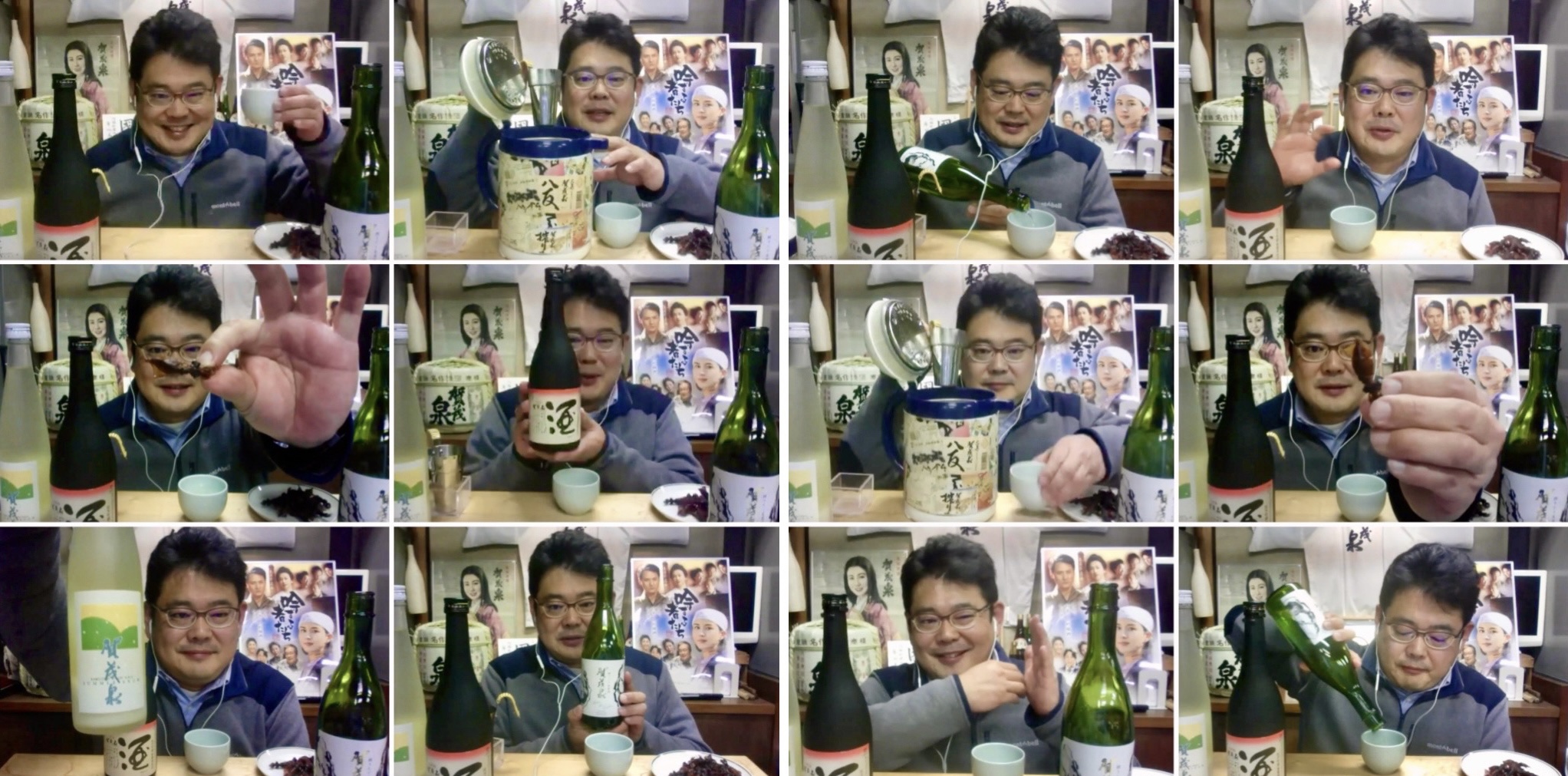
Monday 12th December, 2022 saw TWTT host session number 102 in the series.
For this session, we headed to Hiroshima Prefecture to feature Kamoizumi Shuzo.
Joining us for this session was 4th generation president, Kazuhiro Maegaki, whom I actually had the pleasure of meeting in person in September of this year for the Sake Samurai ceremony. Many of you probably know that Maegaki-san wears many hats in addition to brewery president, including that of the chairman of the Sake Samurai Association.
Kamoizumi Shuzo was established in 1912, making this their 110th year in operation. They produce around 1500 koku each year.
The brewery is based in the town of Saijo, which is a rather famous sake town, the home to 8 sake breweries and the host of the annual sake focused festival: Saijo Sake Matsuri – which usually (outside of COVID times) draws crowds of between 100,000–200,000 people over two days, from revellers to sake connoisseurs, each October ~ just before brewing season begins. A hot tip from some who have attended in the past: get there early!
This session started with a virtual brewery tour – which is something that never gets old as no two breweries are the same. It’s always a treat to get a peek inside the feature brewery.
Once the tour concluded, Maegaki-san made his way back to the office to lead and join a TWTT Kanpai and showed us his kanzake set-up and sake snacks. In front of him stood 3 bottles of sake, their signature ‘3 Dots’ label, their Shinshu – with a fabulous oyster illustration on the label, and their Nigorizake. Interestingly, the Nigori is for export only. It proved so popular overseas that their production of Nigori stretched only as far as to fill international orders, with no stock left for the local market.
Maegaki-san presented a brief powerpoint to introduce the history of the brewery, and a second presentation that highlighted the Saijo area and the sake breweries located within the town.
What started as a fairly generic session, i.e with a brewery tour and powerpoint soon morphed into something that took us down not one rabbit hole, but two, and stretched out to a marathon 4 hour session! Some in-depth discussions ensued, namely about rice polishing and then about the origin of ginjo sake.
Even after four hours, the burrowing could certainly have continued, (and possibly did in the nijikai), however, we called the end to the ‘official’ part of the session at the four hour mark… but not before Maegaki-san gave us a fine demonstration of his singing voice.
When asked the standard TWTT ‘musical’ question, he confessed that he can’t play any musical instruments but could sing…. only one song. He had us all clapping along as he gave a joyous rendition of that one song, (a song they sing when they wash the rice). A lovely way to wrap up an epic session and the second last for 2022.
A huge thank you to Kazuhiro Maegaki for sharing his time, ( a lot of his time), passion, stories, knowledge, humour and singing voice with us all. An extension of that huge thank you must go out to my co-host and interpreter for this session, Chris Hughes – a real feat to do so for a huge 4 hour session! Otsukaresama!
Thank you also to everyone who attended this session.
Taste with the Tōji ~ Session 101:
Yataro Yamamura
Yamamura Shuzo (Kumamoto)
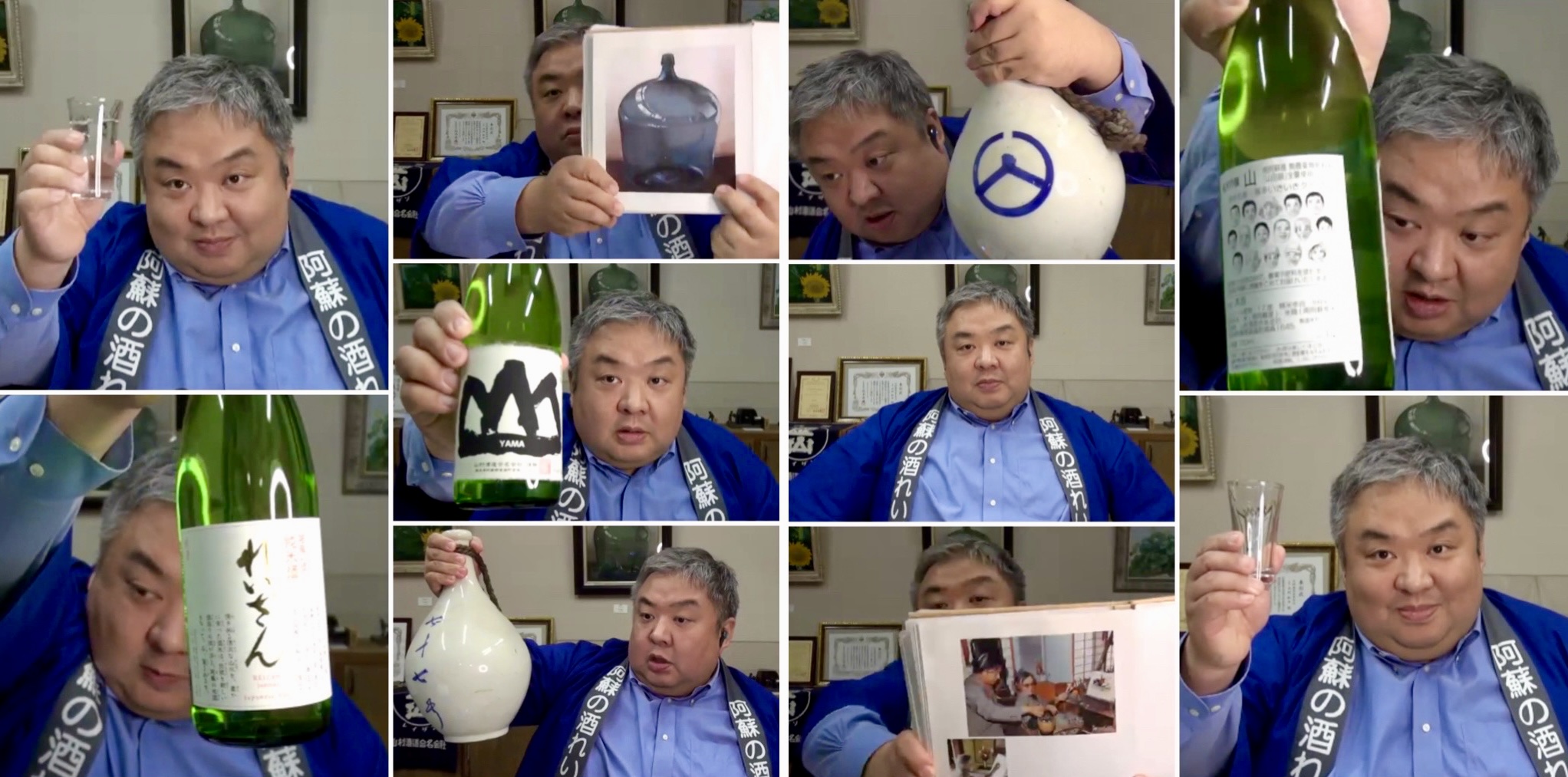
Monday 5th December, 2022 saw TWTT host session number 101 in the series.
For this session we headed to a part of Japan the TWTT had not yet visited… We were finally able to put Kumamoto Prefecture on the TWTT map with our feature brewery for this session being Yamamura Shuzo.
Joining us for this session, representing the brewery’s 13th generation, was Yataro Yamamura.
I was fortunate enough to meet and spend a little time with Yamamura-san in Kyoto earlier this year during the Sake Samurai ceremony and dinner. I was very happy when he agreed to come on TWTT and tell us about his brewery.
Yamamura Shuzo was founded in 1762. They are located in the mountainous region of Aso in Kumamoto Prefecture on the island of Kyushu. Southern Japan is known for its hotter climate, however, Yamamura-san tells us that where they are located, it is somewhat cooler all year round compared to other areas in Kyushu, making it ideal for sake brewing.
Of course, Kyushu is often labelled as being more about Shochu distillation than Sake brewing, however, Yamamura Shuzo have always been all about sake. The company has never been involved in Shochu production and they are now the oldest existing sake brewery in Kumamoto Prefecture. There are currently 9 active sake breweries in Kumamoto.
Yamamura Shuzo have two brands: Reizan, (their main brand), and their lesser known / harder to find Yama label. The Yama brand is their limited release sake – produced in collaboration with a local farming group who grow rice without the use of chemicals or commercial fertilizers. In a lovely homage, on the back label of the bottles of Yama sake, there is a delightful illustration of the faces of all the farmers in the group.
Between the two labels, the brewery produces around 1300 koku each year. Despite this production volume, their sake is mostly sold and consumed in Kumamoto Prefecture – (around 80% is bought/sold/drank locally). The brewery is yet to begin exporting their sake but are hoping to do so in the future. Here’s hoping Australia is on that list some day.
Prior to working at the brewery, Yamamura-san had moved to Tokyo and was pursuing a career in music management. He’d often take sake from Yamamura Shuzo to give to musicians. He was surprised to see how people responded to the sake and how interested they were in the fact that he came from a sake brewing family ~ this interest from the musicians he’d been managing gave him a greater appreciation for where he had come from and for sake and at the age of 30, Yamamura-san decided to head back to Kumamoto and join the family brewery.
This was Yamamura-san’s first time partaking in this style of online event and he admitted to being a little nervous – he need not have been as he was the most gracious guest and a wonderful storyteller, making for a very interesting and entertaining session.
It was also delightful to hear stories of his grandmother who had painted the 3 works of art that hung on the wall behind Yamamura-san as he spoke with us. Amongst the works was a painting of a Tōbin, which certainly caught my eye and prompted the delightful discussion. His grandmother, who enjoyed a little sake every night, sure sounded like a wonderfully colourful character and Yamamura-san tells us she did not start painting until she was in her 60s and continued making art well into her 90s! She lived to the ripe age of 102! Impressive.
A huge thank you to Yataro Yamamura for sharing his time, knowledge, passion and stories with us all. An extension of that huge thank you goes out, yet again, to my co-host and interpreter for the evening, Maki Tanaka.
Thank you also to everyone who attended this session.
Taste with the Tōji ~ Session 100:
Maiko & Soichiro Tsuji
Tsuji Honten – Gozenshu (Okayama)
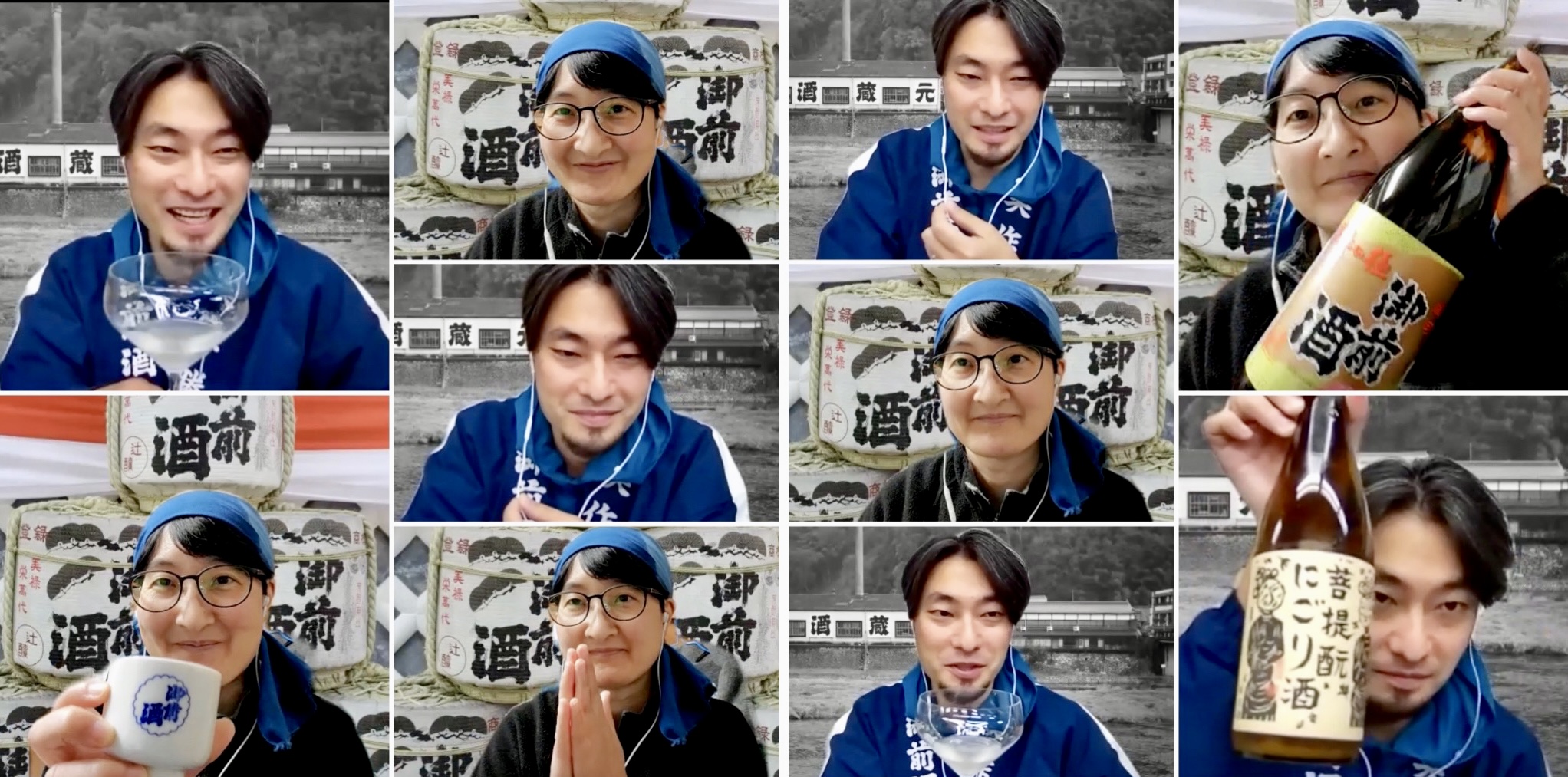
Monday 28th November, 2022, saw TWTT celebrate its 100th session – and to help us do that, we were lucky enough to be joined by the fabulous Tsuji siblings and feature a brewery that holds a special place in many hearts, (including mine): Tsuji Honten, producers of the much loved Gozenshu sake.
We got to welcome back 7th generation President: Soichiro Tsuji and talented Toji: Maiko Tsuji as our special guests for the 3rd time on TWTT.
In recent times, Gozenshu have produced a couple of limited release ‘trilogy’ sets, with more planned ~ so this seemed very fitting to complete a ‘TWTT trilogy’ with Gozenshu for the project’s 100th session.
Tsuji Honten first joined us as the feature brewery back in May 2020 for session #4. They joined us again in May 2021 for session #42, and this year, it was an honour to have them back to celebrate a century of TWTT sessions.
When we last caught up with Soichiro-san and Maiko-san they were not only in the process of rebranding, but also transitioning to an all Omachi brewery… in other words, they had planned to move to using ONLY Omachi rice to brew their sake. Some thought this was a brave move that may present limitations, however, the folks at Gozenshu, determined to not let this move be seen as a limitation, continue to be impressively innovative and are forever coming up with different ways to showcase their exclusive use of Omachi. One of these ways, of course, is through their progressive series of ‘trilogy’ releases.
They are now exactly that – a brewery that uses ONLY Omachi rice, 95% of which is harvested in Okayama. They are currently using rice farmed from 7 different locations.
Further to the shift to only brewing with Omachi rice, Gozenshu are planning to move towards becoming a brewery that uses the Bodaimoto starter method for all their sake in the future. In the process, they are currently working on a new trilogy which will be centred around the Bodaimoto method ~ seeing a slightly different Bodaimoto method used for each of the 3 brews. One method is perhaps one that has not been attempted before – and that is to not only use soyashi mizu in the starter but also in the main fermentation.
In addition to an informative presentation and discussion revolving mostly around Omachi, Bodaimoto and soyashi mizu, we were lucky enough to get a peek inside the brewery, more specifically – inside the soyashi mizu tank.
I love that Gozenshu honour both tradition and time ~ whilst they are passionate about tradition, they are also progressive in their thinking and their sake brewing. I also love that each time we do a session with Gozenshu, not only do we learn so much, but we are left wanting to learn more and delve even deeper into the world/s of Omachi, Boadimoto and soyashi mizu… which continues to keep the TWTT door wide open for another Gozenshu session.
A huge thank you to both Soichiro Tsuji and Maiko Tsuji for once again sharing their time, knowledge, passion, projection and philosophy with us all. It’s always a joy to speak with these remarkable sake siblings and we look forward to having more opportunities to do so in the future.
An extension of that huge thank you must go out to my co-host and interpreter for this session: Maki Tanaka. It’s always a pleasure to work alongside Maki and the other co-hosts/interpreters for these TWTT sessions ~ not only does it put the brewery guests at ease, it also helps to make this project accessible to a wider audience. I am forever grateful to everyone who has helped, and continues to help, in making TWTT sessions possible.
Thank you also to everyone who attended this session – and, of course, to anyone and everyone who has attended, or been a guest for, one or more TWTT sessions since its iteration. Without all of whom, we would not have made it to 100!
Deepest Kansha and 100 Kanpais to all involved!
Taste with the Tōji ~ Session 99:
Kenji Miwa
Miwa Shuzo (Gifu)
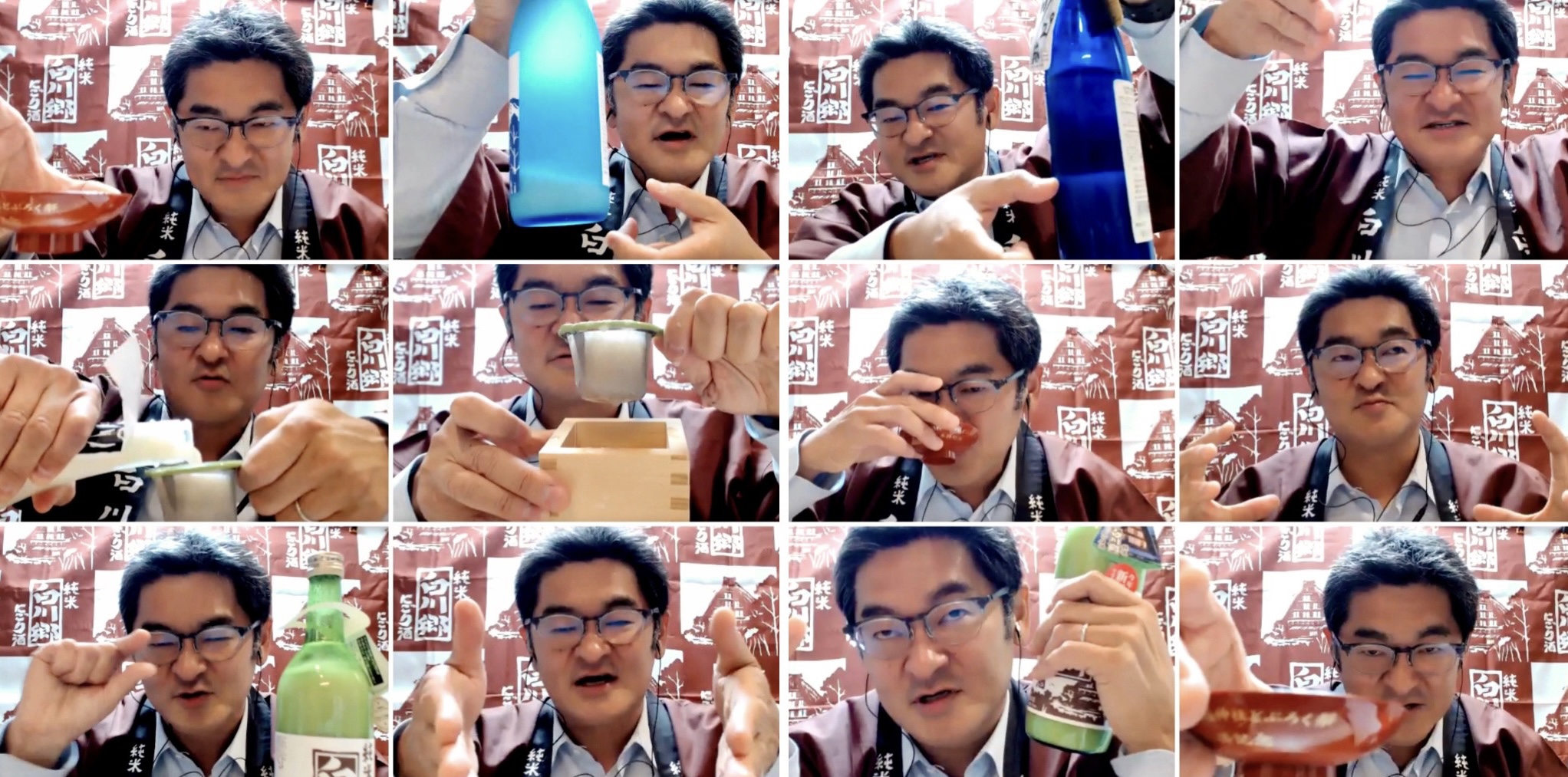
Monday 21 November, 2022 saw TWTT host its 99th session when we headed to Gifu Prefecture to feature Miwa Shuzo.
Joining us for this session was the ever-charismatic Kenji Miwa, aka the ‘Nigori King’.
Miwa Shuzo was established in 1837.
The brewery is located in Funamachi, Ogaki City, in Gifu Prefecture and they are known mostly for their Nigorizake label, Shirakawago. Despite also producing ‘clear’ sake, Miwa Shuzo are very much a Nigori-focused brewery. 90% of what the brewery produces falls into the Nigorizake category – so it seemed fitting for Miwa Shuzo to be the feature brewery for TWTT’s first ‘Nigori-focused’ session.
Miwa-san started by introducing 3 sake from the Shirakawago range; their Junmai Nigori (a very think/cloudy nigori), their Sasanigori (which is usu-nigori, or ‘slightly’ cloudy), and their Asanigori (which is a ‘moderately’ cloudy sparklnig nigori). He explained that these were the main 3 sake that the brewery export, but also went on to explain that the brewery produces around 15 types, or variations, of Nigori (the others being mostly available in Japan only).
Miwa-san wanted to explain the process, (or more specifically, the different processes), used to make Nigorizake – a sake, and process, that is more often than not misunderstood.
What felt a little like part science lesson, part algebra lesson, Miwa-san wanted to convey the complexity behind Nigorizake and explain the difference between ‘pressing’ and ‘straining’ when applied to their 4 methods of making Nigorizake at Miwa Shuzo. In his presentation, Miwa-san also wanted to touch on the difference between the two cloudy brews, Doburoku and Nigorizake.
Miwa Shuzo’s focus on Nigorizake certainly seems to have been a bold move, and a most unique one – as Miwa-san mentioned, most other breweries have maybe one or two Nigori in their range, but at Miwa Shuzo, it’s around 15 – however, it is a move that seems to have paid off for them.
One thing that was transparent was Miwa-san’s passion for this cloudy brew. So passionate is he that it is hard to believe he was not born into the brewery, but rather married into the brewery through the Miwa family’s eldest daughter.
Prior to joining the brewery, Miwa-san explained that he had no real interest in sake – that was until he was living in Germany and noticed how proud people were of their local culture, including food and drink… When asked about sake, he said he felt somewhat embarrassed and apologetic that he did not know as much about his own country’s national beverage as was perhaps expected. He felt a strong desire to change this upon his return to Japan. Sometime after that was when he was introduced to the daughter of Miwa Shuzo and the rest is history… (there is a little more to that story but Miwa-san certainly tells it better than I can). The family definitely chose the right man for the job as it seems Miwa-san now lives and breathes Nigorizake.
The beauty of TWTT is that every session is so different and that we get to hear some wonderful stories on such a personal level.
A huge thank you to Kenji Miwa for sharing his time, passion, charisma and stories with us. An extension of that huge thank you must go out to Maki Tanaka for being my co-host and helping out with interpretation for this session.
Thank you, as always, to everyone who attended this session.
Taste with the Tōji ~ Session 98:
Sho Matsuoka
Matsuoka Jozo (Saitama)
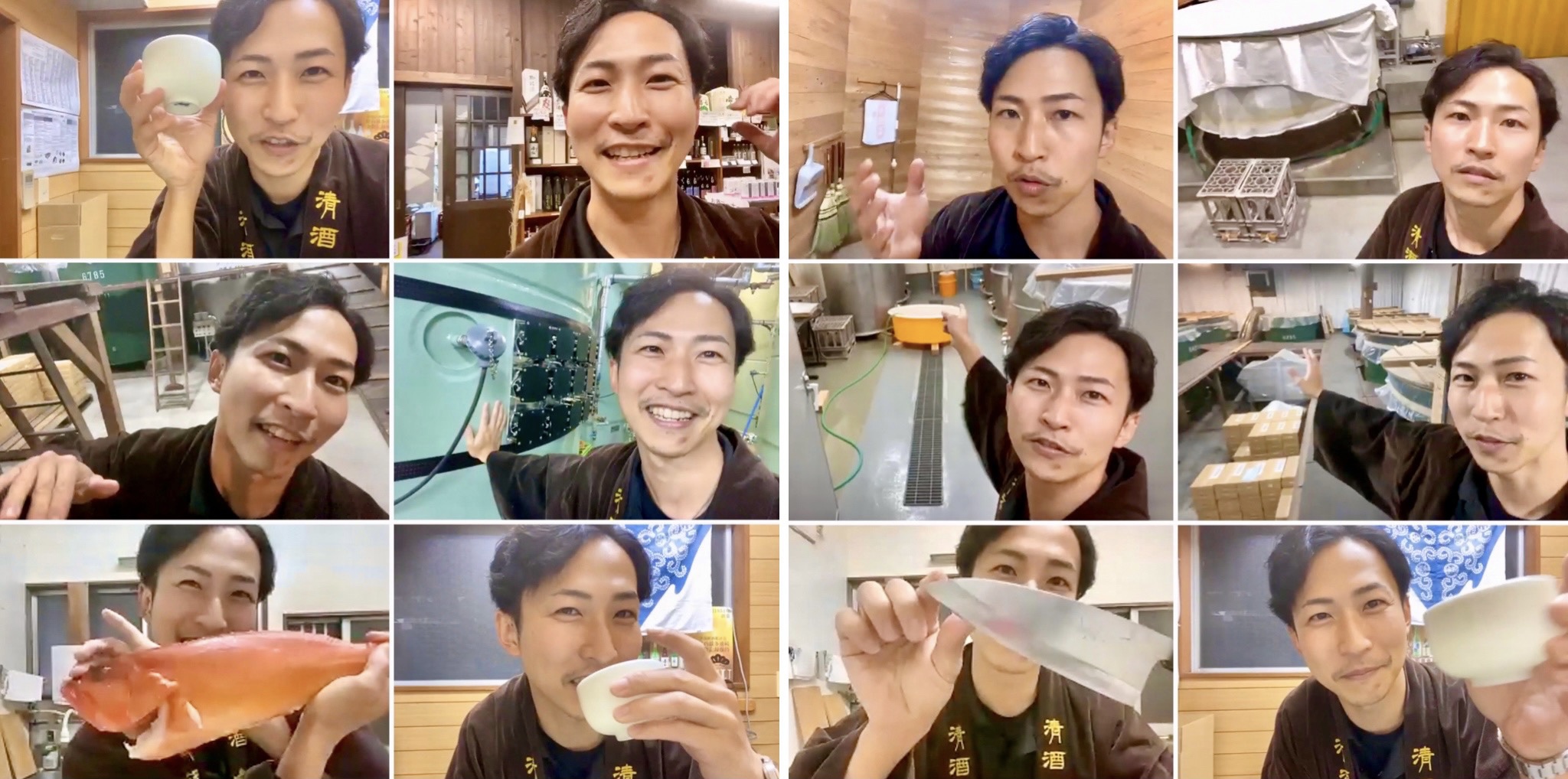
On Monday 14th November, 2022, TWTT hosted its 98th session.
Following on from session 97, we headed back to Saitama Prefecture, to a different brewery, but one with a family connection to the previously featured one. This time round it was Matsuoka Jozo in the spotlight and joining us was 7th generation Kuramoto-to-be, Sho Matsuoka.
Matsuoka Jozo was established in 1851. They are the producers of the brand ‘Mikadomatsu’.
As mentioned in the previous session, Saitama Prefecture is home to around 32 active sake breweries and is currently the 4th largest, (in terms of sake production), prefecture in Japan. (Apparently the 4th in sake consumption too! )
Matsuoka-san gave a short presentation before showing us inside the brewery – both the new part and the old part, as well as the brewery shop. It was a joy to have the wifi Gods on our side this time!
The brewery currently produces around 1000 koku. He explained that Matsuoka Jozo brews with some of the hardest water in Japan. The brewery uses spring water, sourced from the Chichibu mountains. We’re told this particular ‘hard’ water contains zero iron and possesses a unique ‘soft’ feel/taste despite its ‘hardness’, or high mineral content, thus they don’t require any filtration of their water. Of course, brewing with hard water promotes a faster fermentation and requires an intense level of temperature control.
During the live brewery tour, Matsuoka-san pointed out the brewery’s high-tech computerised equipment that allows them to precisely monitor and control the tank/ferment temperature. He also pointed out a tank wearing a belt of speakers that plays music to the fermentation. Matsuoka-san is curious to experiment with various types of music to see whether the different vibrations change the outcome of the brew. Currently playing: heavy metal music.
We also got a look inside their uniquely designed (or ‘shaped’) Koji room, designed as such to make cleaning easier.
We wrapped up the virtual tour with a peek inside the brewery’s restaurant which is run by Matsuoka-san’s younger brother, followed by a look inside the brewery shop and at some of the products on offer, including sake in a can. Matsuoka-san tells us that the brewery actually have their own canning equipment and are currently providing a canning service for a number of other breweries.
The brewery produces quite a range – around 50 different sake, including their Ke to Hare ‘wine yeast’ Junmai Ginjo, their organic Shimozato Junmai Ginjo made from Koshihikari rice grown by the brewery, and their 10 year aged Ginjo made using Miyako koji.
After graciously answering some questions from the attendees, Matsuoka-san provided a TWTT first in the form of a live, Iron Chef style, sashimi demo. Apparently filleting whole fish and preparing sashimi is a fond hobby of his.
A huge thank you to Sho Matsuoka for sharing his time, passion, energy and bōchō skills with us all. An extension of that huge thank you goes out to my co-host and interpreter for this session, Harald deRopp.
Thank you, as always, to everyone who attended this session.
Taste with the Tōji ~ Session 97:
Hideyuki Takizawa
Takizawa Shuzo (Saitama)
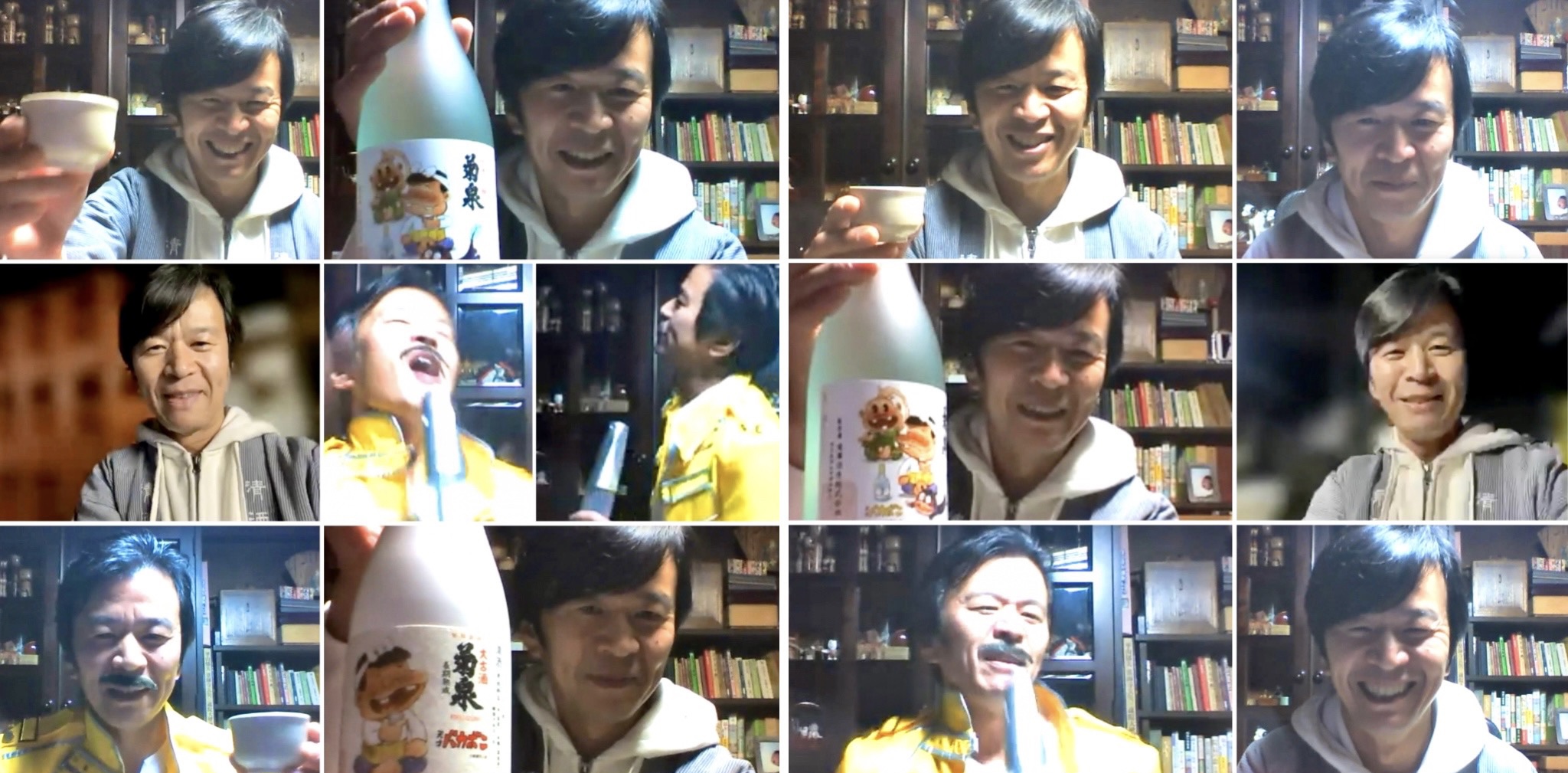
On Monday night, TWTT returned after a 5 week absence, which I think is the longest break in TWTT history. This was the 97th session in the series and for it, we headed to Saitama Prefecture for only the second time. We first visited Saitama Prefecture back in December of TWTT’s debut year, 2020, when we featured Shinkame Shuzo. It was great to be back in Saitama Prefecture, via the Zoom room, this time to feature Takizawa Shuzo – makers of Kikuizumi sake.
Joining us from the brewery for this session was Kuramoto/Toji, Hideyuki Takizawa, who is the 6th generation head of Takizawa Shuzo.
Takizawa Shuzo was founded in 1863. The brewery is located in Fukaya City, Saitama Prefecture. Saitama is home to around 32 active sake breweries and is currently the 4th largest, (in terms of sake production), prefecture in Japan.
Takizawa-san began the session with a slide show, presenting a little about the history of the brewery and the area, which included some wonderful old photos of the brewery, the Takizawa family and the local Yasaka Matsuri, held every year in July. He also stepped outside to show us the brewery’s photogenic chimney, all lit up, (which was actually in use up until 60 years ago). He also gave us a sneak peek inside the kura – however, as often happens in some of these buildings, the wifi connection was not entirely on our side. What we couldn’t quite make out here, we got a better look at in some of the photos in the presentation.
There was a heavy focus on the brewery’s production of sparkling sake for this session. Awazake, or Sparkling Sake, is one of the more recent additions to the brewery’s line-up, however, it is currently what Takizawa Shuzo are currently best known for – this includes their very unique Hitosuji Rose, which Takizawa-san spoke more in-depth about, including the method he uses to achieve the colour. We are also told that this is currently the only ‘red’ sparkling sake on the market.
We also spoke a little about the Japan Awazake Kyokai/Association, established in 2016, which Takizawa Shuzo is a member of. (There are currently around 28 breweries who are members of this association) – you can read more about it here:
https://awasake.or.jp/en/When speaking about his road to working in the brewery, Takizawa-san explained that at first, he had no real intention of, or interest in, working for his family’s business. Interestingly, he mentioned that one of the influential moments that changed his mind and pointed him towards continuing the family legacy was when he read Akira Oze’s ‘Natsuko no Sake’ – which is a Manga/book series, about a sake brewery, with a female protagonist, and has been the feature of a number of TWTT conversations – most notably, with Rumiko Moriki way back in session #2, in May 2020. TWTT even dedicated a session to ‘
Natsuko no Sake‘, with
Akira Oze and
Rumiko Moriki as our guests, in October 2020 (session #18).
Since then, it has been mentioned in a number of sessions, by brewers who have explained how they were impacted and influenced by reading it. When asked if Oze-Sensei was aware of the positive impact it had on Takizawa-san, he said he’d never had the chance to meet Oze-Sensei, therefore, had never told him. So, we plan to let Oze-Sensei know just how important ‘Natsuko no Sake’ was to yet another brewer in Takizawa-san.
Takizawa-san ended up joining the family’s brewery, working under the previous Toji. He also spent 3 years working at Ishikawa Shuzo in Tokyo, before returning to Takizawa Shuzo.
To wrap up this enjoyable and informative session, Takizawa-san made a costume change and channeling the spirit of Freddie Mercury and gave us a closing performance to ‘Don’t Stop Me Now’.
May nothing ever stop you Takizawa-san!
A huge thank you to Takizawa-san for sharing his time, knowledge, story, passion and Freddie with us all. An extension of that huge thank you must go out to my co-host and interpreter for this session, Harald deRopp, for a great job and for helping to make this session possible.
Thank you also to everyone who attended this session.
Taste with the Tōji ~ Session 96:
Kenichi Shimazaki
Shimazaki Shuzo (Tochigi)
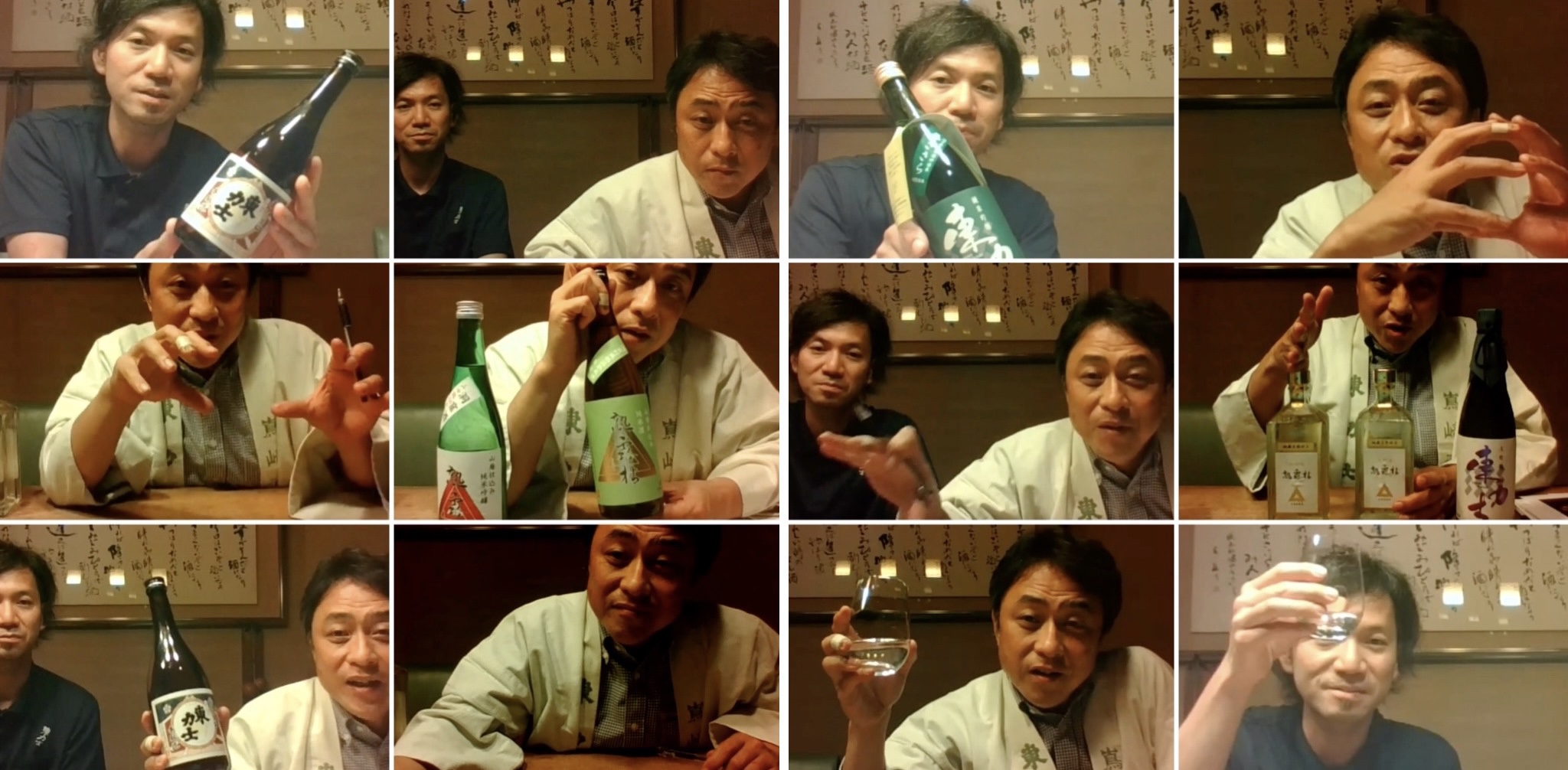
On Monday 26th September, TWTT hosted its 96th session when we headed to Tochigi Prefecture to feature Shimazaki Shuzo.
This was actually the very first session I managed to host from Japan! Ultimately, it would’ve been great if I could’ve made it to Tochigi in person for this session, but due to the Sake Samurai inauguration ceremony happening in Kyoto the following day, I hosted session 96 from my hotel room in Kyoto. Still, just being in Japan was enough and I am so grateful I finally got the opportunity to head back to my home away from home after a long time apart.
Shimazaki Shuzo was established in 1849 by its founder Hikobe Shimazaki. Initially established in a neighbouring town, Shimazaki moved to its current location in Nasukarasuyama around 150 years ago. Nasukarasuyama is situated close to the Naka River which begins at Mount Nasu in the northeastern part of Tochigi Prefecture.
Joining us for this session was 6th generation Kuramoto, Kenichi Shimazaki, who presented a powerpoint presentation which included discussion about the history and location of the brewery, the brands they’re producing – Azumarikishi, Uroko and Kiwamishizuku, a little about the local culture, the brewery’s water source (from the Naka River), and their brewing method/s.
Also joining us from the brewery was Toji, Tatsuro Sekine, who holds around 12 years brewing experience and certification from Tochigi’s Shimotsuke Toji guild and now leads a young and ethusiastic team of brewers at Shimazaki Shuzo.
Shimazaki Shuzo are well known for a particular ‘asset’ which often sees them called ‘the cave brewery’. The cave was originally built to host production of tanks towards the end of World War II. As its creation was so near the end of the war, the tanks were never actually built in the cave and it remained abandoned for decades after the war.
In 1970, prior to accessing the cave, the brewery began experimenting with ageing sake. In the 1980s they created a storage cellar to age some of their sake. The cellar maintained a temperature of around 15 degrees celsius, however, this storeroom gradually filled up, so Kenichi’s father came up with the idea of using a nearby abandoned cave.
In 2007, the aforementioned cave was reborn as a sake storehouse for Shimazaki Shuzo. Currently, it is designated as a modern cultural heritage site of Nasukarasuyama City. The inside of the cave sees no sunlight, and the temperature is an average of 10 degrees celsius throughout the year and is the perfect environment for storing and ageing their sake. The cave is currently housing, (and ageing), sake that dates back as far as 1970.
The cave is certainly a talking point and an attraction to potential visitors and is open to the public via appointment – providing a pretty unique tasting experience!
A huge thank you to Kenichi Shimazaki and Tatsuro Sekine for sharing their time, knowledge and stories with us. An extension of that huge thank you goes out to my co-host Maki Tanaka for yet another great interpretation and also to Cindy Bissig for helping with connections and communication in the lead up to this session.
As always, thank you to everyone who joined this session and to the staff at Nikko Princess Hotel in Kyoto for finding the right adaptor for me when I realised I had the wrong one!
Taste with the Tōji ~ Session 95:
Takashi Kurogouchi
& Masato Yanagidaira
Senjo Brewery (Nagano)
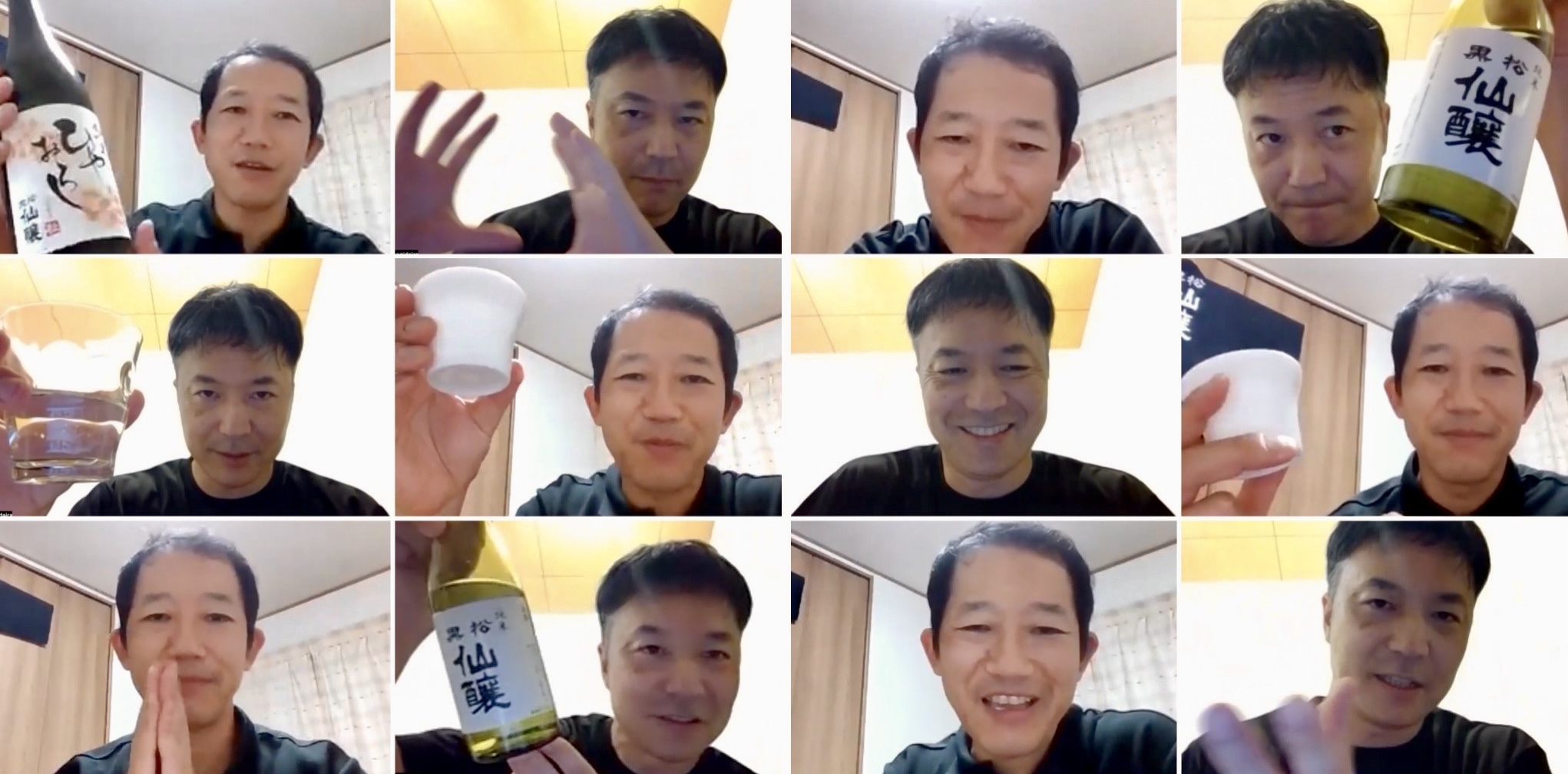
Monday 12th September 2022 saw yet another enjoyable and educational session of TWTT. This was the 95th session in the TWTT series and the brewery featured was Senjo Brewery, in Nagano Prefecture.
This is only the third time we have featured a brewery from Nagano, one of Japan’s 8 landlocked prefectures, on TWTT – It probably seems a bit strange, considering Nagano is home to the second largest number of breweries (per prefecture), after Niigata. There are around 80 breweries in Nagano. Let’s say we are taking the long way around and trying to cover as many prefectures as possible. The ultimate aim, of course, is to feature them all.
Senjo Brewery, named after nearby Mt. Senjo, was founded in 1866. The brewery is located in Ina City, Nagano Prefecture.
Joining us for this session were 6th generation Kuramoto, Takashi Kurogouchi, and the Toji, Masato Yanagidaira.
Takashi-san put together a wonderful visual presentation, giving us insight not only into Senjo Brewery, but also Ina City and Nagano Prefecture. In lieu of a live brewery tour, thanks to dodgy wi-fi, Takashi-san presented 2 short videos shot inside the brewery.
Interesting to see that they make koji both by machine and by hand.
Before arriving at Senjo Brewery, Takashi-san studied international history in Tokyo, and later, war studies in London. Despite not starting at Senjo Brewery until 2001, he told us he had an epiphany at the age of 3 when he realised that one day he would run Senjo Brewery. His studies set him on a different path for a while and he claims he had no great passion for sake initially, but in 2001, his path led him to merge his interest in history and his family’s historical business. After learning the ropes and discovering a passion for sake, he became the brewery’s 6th President in 2009.
When he joined the brewery, sales were low and the brewery was unsure of what the future would hold for them and the sake industry. When he took over as Kuramoto, Takashi-san began his mission to expand and improve their product line up, introducing new products under Senjo such as Amazake and Doburoku.
Recently, they have also started making gin, using local cherry blossom leaves as one of the key botanicals. Previously, they had been using their distillation facilities to produce Shochu. Their Sakura Gin is now part of their export line-up.
In addition to their now more extensive product range, they are planning to begin a Summer Brewing and Sake Management experience. Whilst the details are not yet set in stone, it certainly sounds like it will be a wonderfully unique learning opportunity for those interested in sake brewing and the sake industry as a whole.
Toji Masato-san has been at Senjo Brewery for 19 years. His first 5 years at the brewery saw him in charge of rice steaming, after this he was put in charge of rice polishing, (Senjo polish their own rice), for around 3 years, he then moved on to being in charge of making koji before moving on to manage the moromi/main fermentation. He finally took over as Toji 3 years ago when their previous Toji left the company.
It’s always a treat to have two guests from the brewery – it makes for a doubly interesting and fun session. This session was no exception and it was an honour to spend over 2 and a half hours with our guests.
A huge thank you to Takashi-san and Masato-san for sharing their time, stories, knowledge and vision with us all. An extension of that huge thank you must go out to
Maki Tanaka for not only being my trusty co-host, interpreter extraordinaire, but also my brain for this session as mine was kind of fuzzy for this one.

Thank you also to
Greg OKeefe and
Kyoko Nagano for helping to put this one on the TWTT map.
Finally, thank you, as always, to everyone who attended this session!
Taste with the Tōji ~ Session 94:
Kunihiko Nagai
and Yasuhiro Morikawa
Tanaka Shuzoten (Miyagi)
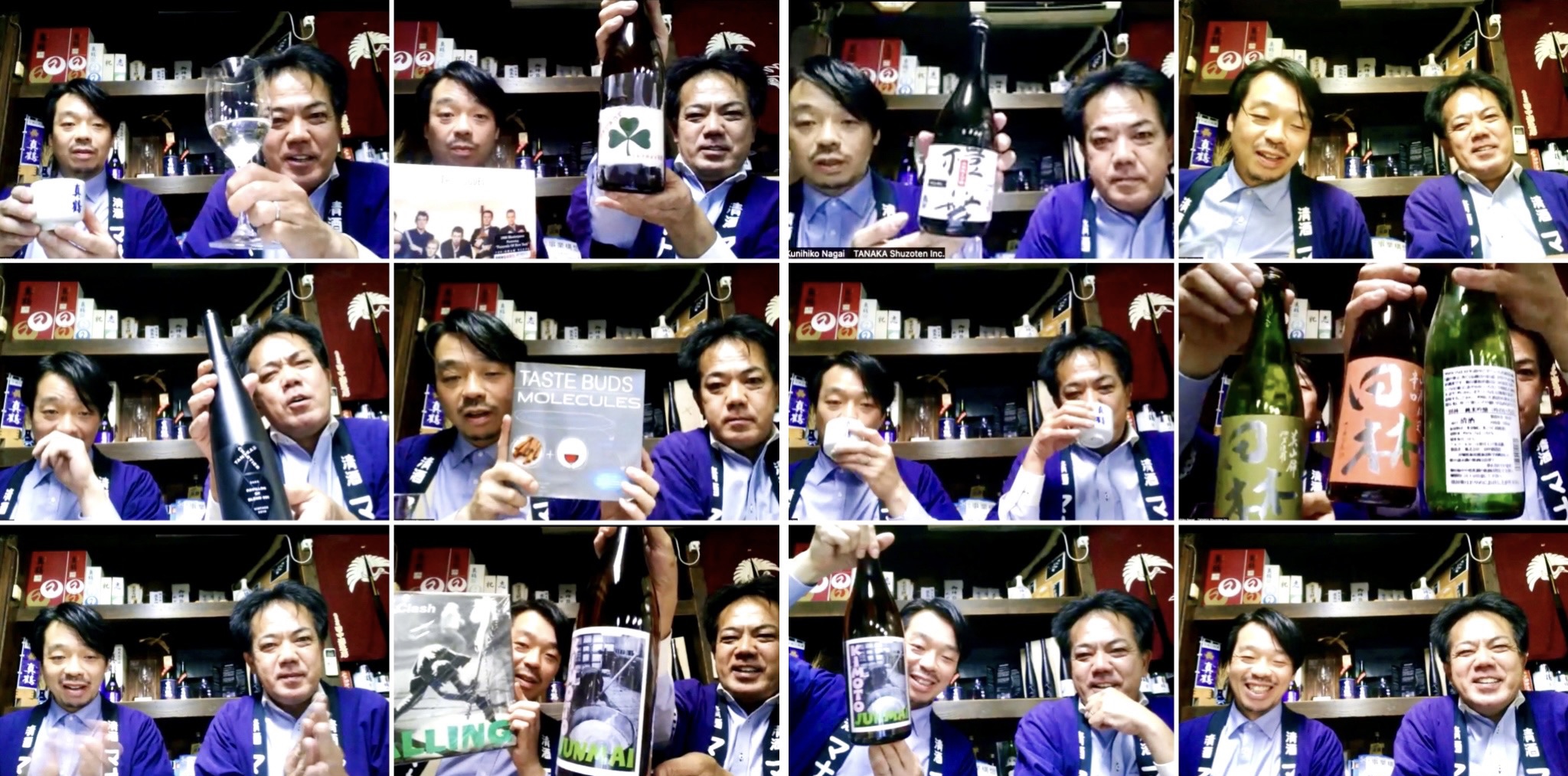
Monday 5th September, 2022 saw TWTT celebrate its 94th session when we got to head to Miyagi prefecture to feature Tanaka Shuzoten.
Joining us for this session were our guests Kunihiko Nagai and Yasuhiro Morikawa. Nagai-san is the 14th generation (although he is not related to the founding family) President and Morikawa-san is the brewery’s current Toji.
Whilst Morikawa-san very much comes from a sake background, having basically decided from the age of 14 that this was his calling, and has worked for 14 different breweries throughout Japan. Nagai-san, however, comes from a very corporate background and was working for the car dealership company who stepped in to help give new life to Tanaka Shuzoten. Without said intervention, this could have been yet another brewery facing extinction ~ which would’ve been incredibly sad as their history dates all the way back to 1789.
This was a most enjoyable session, super informative and a lot of fun, with two guests from very different backgrounds who are now on the same page, working together towards a common goal and driving Tanaka Shuzoten into the future.
Tanaka Shuzoten’s two main labels are Manatsuru and Denrin. Whilst some of their sake is produced using the sokujo method, they have a strong focus on using more traditional methods: Kimoto and Yamahai. They are also dedicated to the laborious art of koji making, using futa koji, (small batches in shallow wooden trays), for all their sake. They recently attained Vegan certification and are working towards gaining an organic certification in the near future.
The brewery’s current annual production is around 800 koku, and it is only in the last 2 years they began exporting their sake. They currently export to around 10 countries including Australia, Israel and Kenya. They are hoping to soon add another 7 countries by the end of 2022 with a view to add more countries to their list over the coming years.
This session saw only a small visual presentation, leaving us a lot more time for discussion and Q&A with our two enthusiastic guests. Morikawa-san, who throughout the session, proved to be quite the Renaissance man, prepared several dishes to pair along with the sake he and Nagai-san were drinking. We also got to hear a little about how his musical taste has influenced some of his sake. He impressed many of us, of a certain demographic, by showing us a bottle with a label inspired by The Clash’s ‘London Calling’ album. Another sake he held up had a connection to fellow UK band, The Pogues. Of course, the topic of music and sake always resonates with a large number of attendees and creative suggestions begin to appear in the chat. We look forward to seeing what other musical influences may get a look in with Morikawa-san’s future brews.
This really was such a fun session. A huge thank you to Nagai-san and Morikawa-san for sharing their time, energy, passion and knowledge with us. An extension of that huge thank you must go out to Maki Tanaka for being my trusty co-host and interpreter for this session. Also – big thank you to Greg OKeefe for helping to put Tanaka Shuzoten on the TWTT map.
As always, thank you to everyone who attended this session. If you’re ever in Miyagi Prefecture, be sure to look these guys up and if you can, pay them a visit.
Taste with the Tōji ~ Session 93:
Shinji Hinoshita
and Wataru Hosokawa
Amabuki Shuzo (Saga)
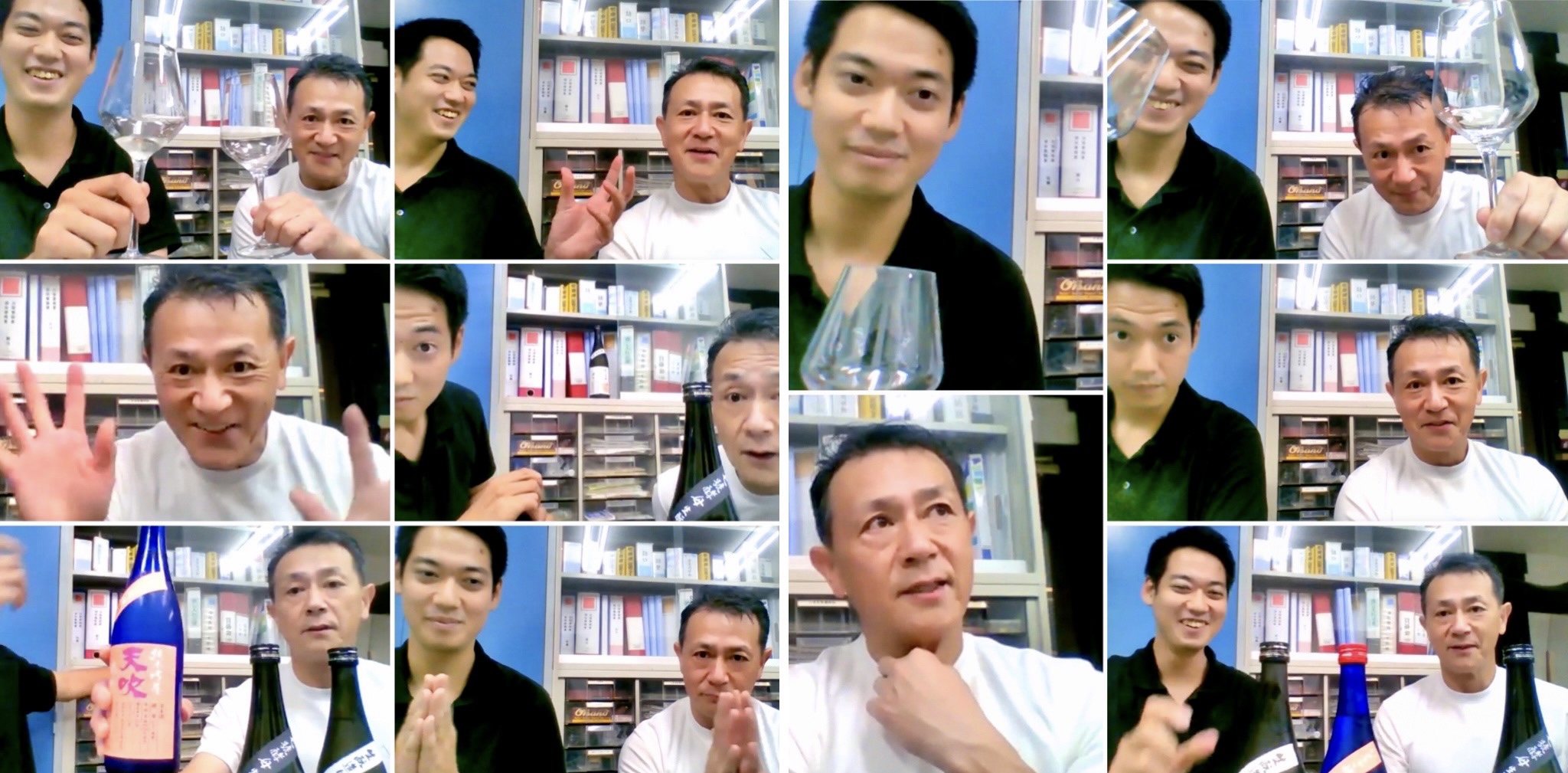
Monday 22nd August 2022 saw TWTT’s 93rd session take place as we headed to the island of Kyushu for the very first time in this series of online events. The prefecture we got to visit was Saga and the brewery was none other than Amabuki Shuzo.
Now that TWTT has finally put Kyushu on its map, hopefully we will see more sessions from Saga and other prefectures within this region in the not too distant future.
Joining us for this session was Toji, Shinji Hinoshita and Wataru Hosokawa. My co-host and interpreter for the evening was the wonderful Maki Tanaka.
This was a very poignant, yet special, session for me personally and it meant a lot to me to be able to say a few words at the beginning of this session about my father, who sadly passed away on Friday 19th August.
I thank all of you who joined the beginning of this session to raise a glass to my dear father, and to everyone who has offered kind words of love and support during this emotional time.
My father wished for ‘the show to go on’ and being able to honour his wish and his memory in the company of such a caring, kind and delightful sake community meant so much to me. Thank you to all of you and to Hinoshita-san and Hosokawa-san for allowing me to have that moment during their session.
No surprise that this session was very ‘yeast driven’. Amabuki Shuzo, of course, are famous for their use of flower yeasts. Amongst those are yeasts derived from Sunflower, Strawberry Blossom, Begonia and Rhododendron. For their Amabuki brand, their use of flower yeasts is exclusive, however, we learned that for Hinoshita-san’s own brand, Hinoshita Musou, (which he actually brought with him from where he was previously brewing), he uses other/regular yeasts.
One thing we didn’t touch on during the session was the meaning behind the name of Hinoshita-san’s ‘Musou’ brand. Maki tells me that ‘Musou’ means ‘incomparable’, or ‘one and only,’ which expresses Hinoshita-san’s desire to produce something unique, and to ensure that he doesn’t mimic anyone else’s style, and no one else can mimic his.
Bringing one’s own brand from one brewery to the next is surely not a common thing in the sake world, which I guess is another thing that makes Hinoshita Musou so unique.
Despite being the Toji, Hinoshita-san doesn’t have a lot of control over the end product for the Amabuki label, which is overseen by the brewery’s production and design team. Again, another thing that is not quite the norm and another reason why his own brand, Hinoshita Musou, is so important to him.
Amabuki Shuzo was founded in 1688 ~ giving them a whopping history spanning over 330 years!
The flower yeast thing is a little more recent and something they have developed and fine tuned over the past couple of decades.
Despite the topic of yeast dominating the conversation, a few other topics did get a look in, including rice, water and our guests’ personal journeys into the sake world.
Hosokawa’s passion for Japanese culture led him to be working for Amabuki Shuzo, allowing him to spread the joy of sake with people inside and outside of Japan.
Originally from Hiroshima, Hinoshita-san, despite only having been with Amabuki for 3 years, has a pretty extensive brewing history, having worked at several other breweries, and when he was 27, became the youngest Toji in Japan.
In addition to sake, Amabuki Shuzo are also producing shochu and various liqueurs.
They are currently exporting their sake to over 20 countries, including Australia. In fact, 40% of their sake is produced for the export market.
As always, so much more we could’ve learnt, asked and explored but we certainly managed to fit a good amount of information into the 2 hour session.
A huge thank you to Shinji Hinoshita and Wataru Hosokawa for sharing their time, passion, knowledge and stories with us all. An extension of that huge thank you must go out to Maki Tanaka for co-hosting and interpreting for this session and for being a massive support to me, specifically during this past week.
A sincere thank you to everyone who attended this session and for your support for sake and helping to build this wonderful community.
Taste with the Tōji ~ Session 92:
Tetsuro Igarashi
Kumazawa Shuzo (Kanagawa)
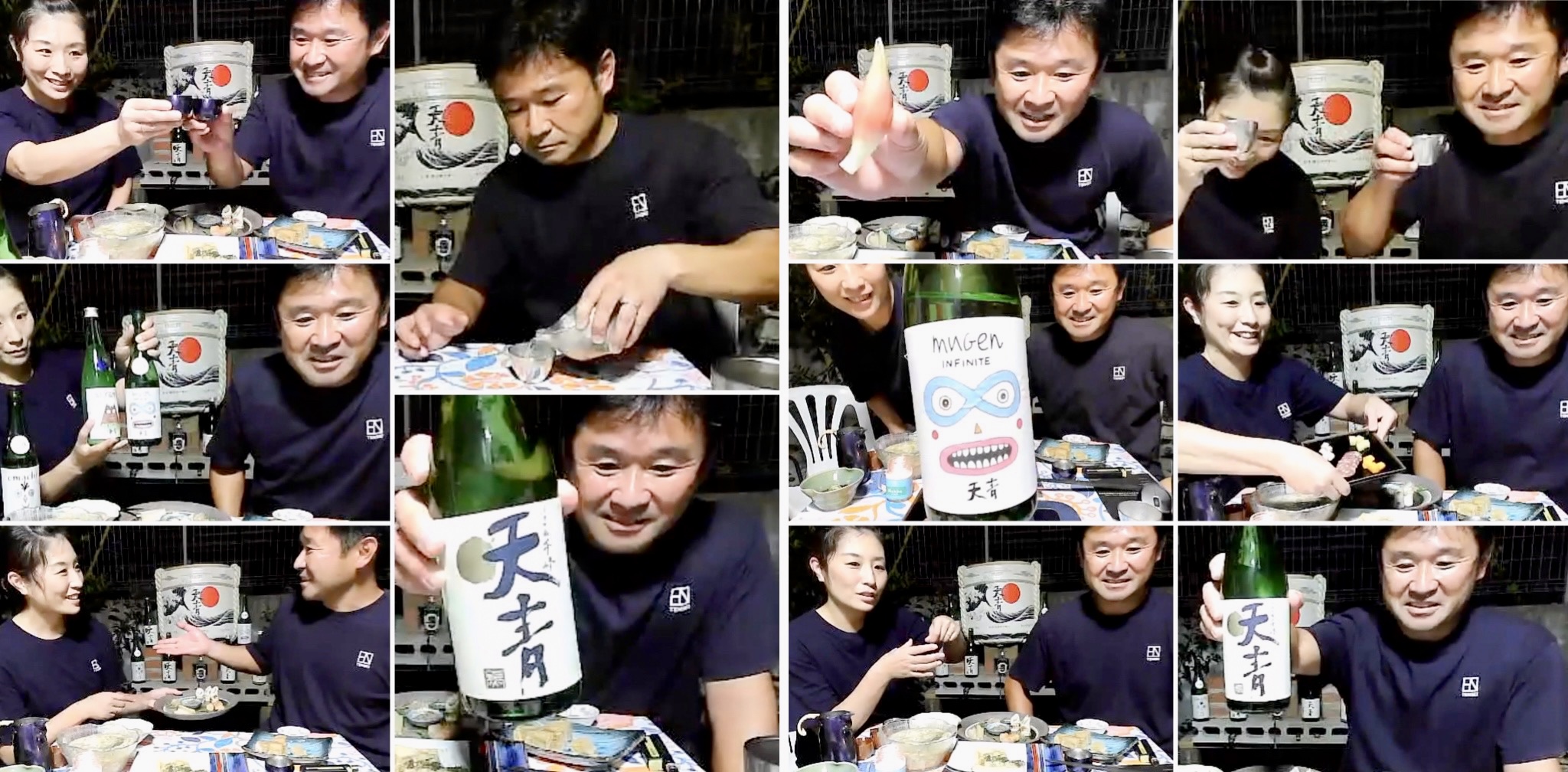
Monday 8th August, 2022, saw TWTT’s 92nd session and saw us head to Kanagawa Prefecture to shine the TWTT torch on Kumazawa Shuzo ~ producers of Tensei sake.
Joining us for this session, set up in their courtyard with a selection of delicious looking edible accompaniments, was Toji, Tetsuro Igarashi and his charming wife, Asako.
Established in 1872 and located in Kagawa, Chigasaki, Kumazawa Shuzo is the only sake brewery in the Shonan region. Their mission since their beginning has been to act as the heart of the local community and culture.
Igarashi-san presented a series of slides which gave us some insight into their style of brewing and style of venue. I had the pleasure of visiting Kumazawa Shuzo, back in early 2019, and this session brought back many fond memories.
This place pretty much has it all… well, it certainly has a lot… They not only produce sake, they also brew beer under their Shonan label and distill their own gin (from sake lees/kasu), and there are plans to add whisky to that list in the near future.
Within the brewery compound, there’s also a cafe, bakery, trattoria, gallery and fine dining restaurant. Oh, and they also have a cave. We decided the one thing missing from this multi-faceted venue was a ryokan/hotel so that guests could enjoy an overnight stay there.
Igarashi-san joined the brewery in 1996. That same year, the company started brewing their Shonan beer. He took over the role of Toji in 2000, steering the brewery forward whilst staying true to their philosophy and focus on ‘local’.
As always, and particularly with a brewery doing as much as these guys are, there was so much to learn, discuss and ask about but the time we spent with Igarashi-san and Asako-san was truly delightful.
A huge thank you to Testuro and Asako Igarashi for sharing their time, humour, passion, knowledge and their dinner table with us all. An extension of that huge thank you goes out to my good friend, co-host and interpreter for this session, Harald deRopp. This brewery holds a special place in Harald’s heart and played a very important role in his wedding celebrations and it is clear to see just how fond of Kumazawa Shuzo he is.
Thank you also to everyone who attended this session.
Taste with the Tōji ~ Session 91:
Keisuke Kawana and Ryuya Abe
Tatenokawa + Oujiman (Yamagata)
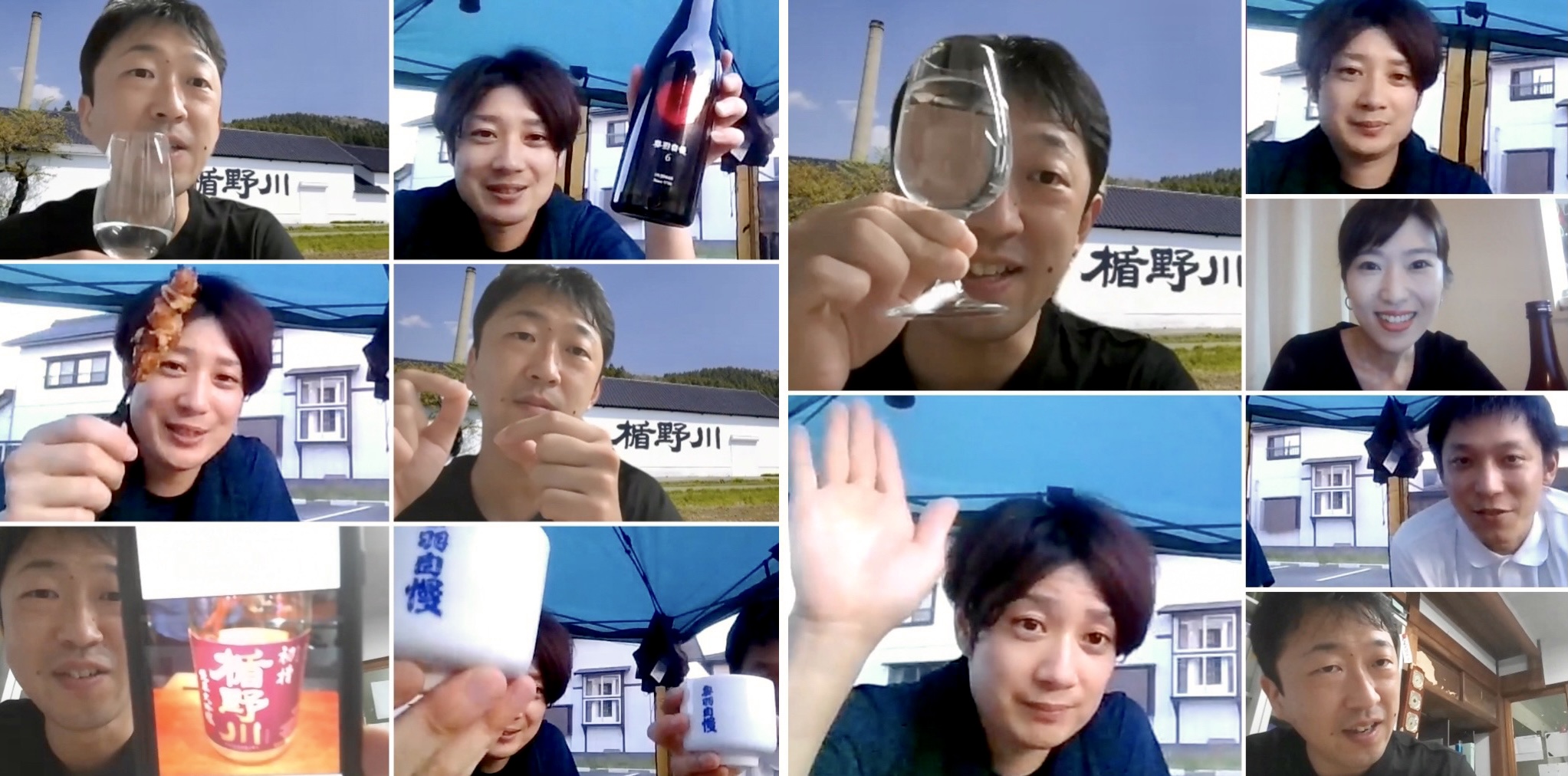
Monday 1st August, 2022, saw the 91st session of TWTT when we headed to Yamagata Prefecture for the unique opportunity to feature 2 sister breweries: Tatenokawa and Ouijman.
Although TWTT has featured guests from multiple breweries previously, this was the first time featuring 2 breweries who are linked in such a way.
Joining us from Tatenokawa was Keisuke Kawana, along with Mari Nakai, and from Oijiman we were joined by Ryuya Abe and Masayuki Doi (who were sat outside enjoying a little yakitori and making us all incredibly hungry).
Both Kawana-san and Abe-san shared informative presentations, giving us an insight into the connection between the 2 breweries and also how they do things differently at each brewery.
Both young, enthusiastic and not afraid of taking a few risks and pushing the boundaries a little here and there.
Kawana-san is part of a brewery that decided to change to an all Junmai Daiginjo brewery back in 2010, he works mostly with locally grown Yamagata rice with high polishing ratios. Many are aware of this brewery producing sake with rice polished right down to 1%. Kawana-san showed attendees just how small these polished grains were as one sat on his finger tip, alongside a grain polished to 50%.
Abe-san, now 31, on the other hand, (who began his sake journey at Tatenokawa at the age of 20), is now working with rice that is far less polished, producing a very different style of sake over at their sister brewery. Not only is he involved in overseeing the sake brewing at Oujiman, he is also involved in wine production next door at the company’s winery. They produce three varietals under the HOCCA label: Chardonnay, Pinot Noir and Syrah.
Between the two breweries they certainly have a lot of bases covered when it comes to sake and also other alcoholic beverages, including wine, cider and fruit liqueur… and there are plans for Whisky in the future. Tatenokawa also previously released a makkoli (makgeolli).
This was a wonderful opportunity to speak with brewers from both Tatenokawa and Oujiman and learn a little about why they do what they do, how they do things differently, and how they both began their sake journey. We were also fortunate enough to get a little live virtual brewery tour of Tatenokawa’s koji room and parts of their ‘space age style’ fermentation room. A most impressive space and a fun and informative session.
A huge thank you to Keisuke Kawana and Ryuya Abe for agreeing to schedule this as a 3 hour session, instead of the regular 2, in order to be able to cover as much as we did. We thank them so much for sharing their time, enthusiasm and stories with us all. An extension of that huge thanks must go out to my champion pair of co-hosts, Harald deRopp and Christopher Hughes, for a brilliant job in juggling interpretation for this 3 hour session, sharing their own knowledge of these two breweries, and for helping to bring such a session to this TWTT series. Thank you also to Mari Nakai and Masayuki Doi for their time and input during this session.
Thank you also to everyone who attended this session.
Taste with the Tōji ~ Session 90:
An evening with Rumiko Moriki and friends
re-visiting Moriki Shuzo (Mie)
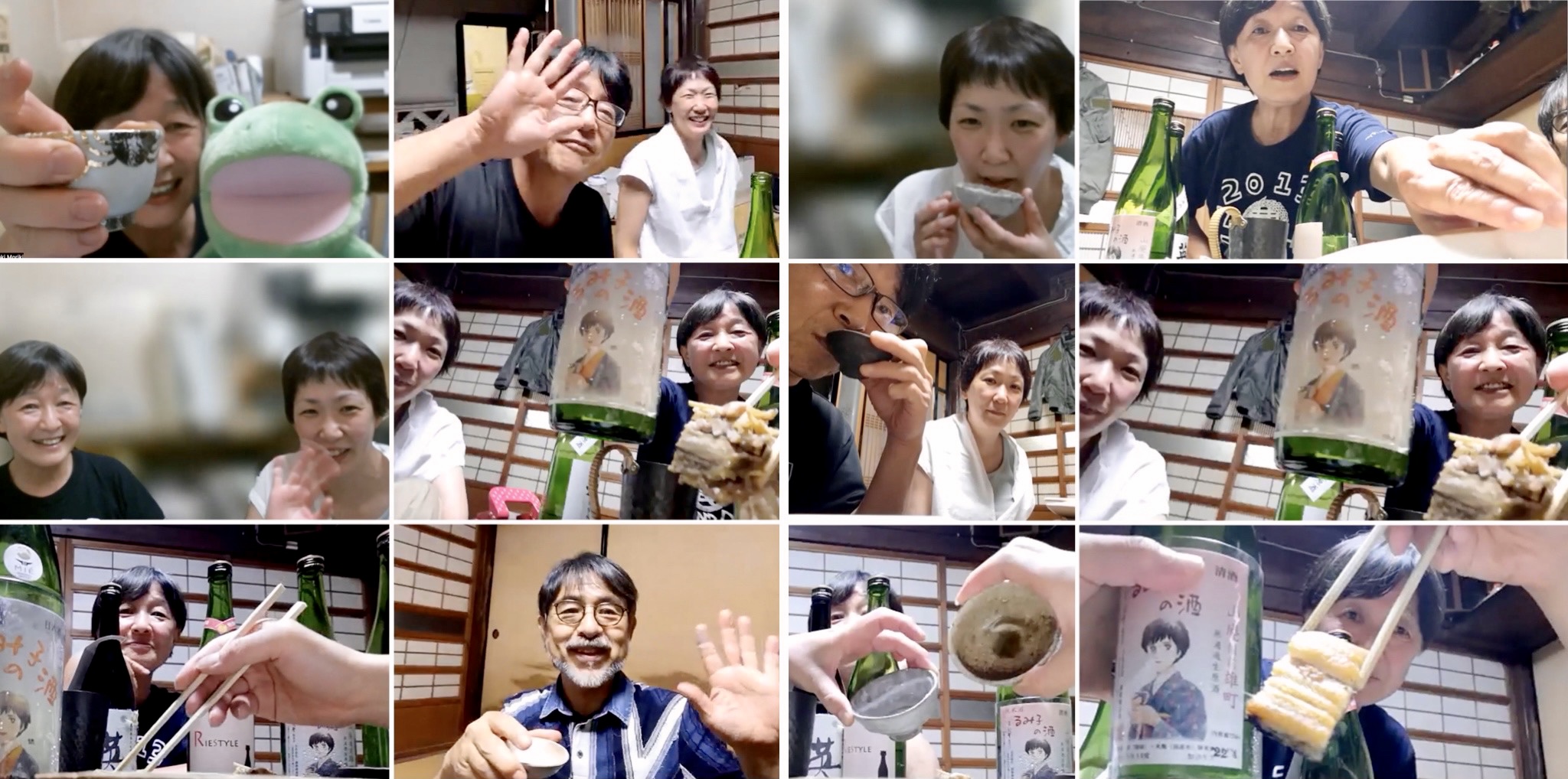
On Monday night, TWTT saw its 90th session when we headed back to Mie prefecture to re-visit Moriki Shuzo and spend an evening with Rumiko Moriki and friends.
This session, like other sessions with Rumko-san, exemplifies the TWTT philosophy and epitomises what this project hoped to achieve ~ and I believe does achieve ~ true human connection. Raw and real… and inspired by the thing that unites us: sake.
Rumiko-san is one of the main reasons that this TWTT community feels like a family, which was something else TWTT had hoped to achieve back when it began.
On Monday night night Rukimo-san, who has welcomed the TWTT community into her heart, welcomed the TWTT attendees into her home, as we got to enjoy an evening with Rumiko Moriki and friends.
Rumiko-san was the most gracious host both in the Zoom room, and in her living room, as she entertained the virtual attendees, as well the guests who were actually present in her house – who included Moriki Shuzo’s Toji, Rie Toyomoto, and potter/artist, Yoh Tanimoto, who was our guest during session #7 of Meet the Artisan… and of course, her husband Hideki-san, and another TWTT favourite Kobo-kun. IYKYK.

It was wonderful to have a chance to speak a little with Rie-san, who has been with the brewery now for 22 years. It is clear just how much love and respect Rumiko-san and Rie-san have for one another. Speaking to them together was a real TWTT treat.
It was also beautiful to see the brewery collaborating with their good friend Yoh Tanimoto for their Hanabusa labels ~ each one (1000 in total) individually crafted, along with an additional crafted paper wrap over the cap, by Tanimoto-san. Having Tanimoto-san there to model his creations was an added bonus for us!
As always with Rumiko-san, there was never a dull moment and there is always something more to learn or delve further into. All that Rumiko-san does and has achieved is nothing short of remarkable and the way in which she shows and offers support to so many is truly commendable.
How she manages to fit everything in and still make time for us….. I’m not sure how she does it, but I do know I am incredibly grateful. (and I don’t think I am alone there)
A huge thank you to Rumiko Moriki for sharing her time, yet again, with us, and also to Hideki Moriki, Rie Toyomoto and Yoh Tanimoto for making this session extra special. An extension of that thank you goes out to the lovely Maki Tanaka for helping with interpretation for this wonderfully enjoyable session.
Taste with the Tōji ~ Session 89:
Kosuke Kuji
Nanbu Bijin (Iwate)
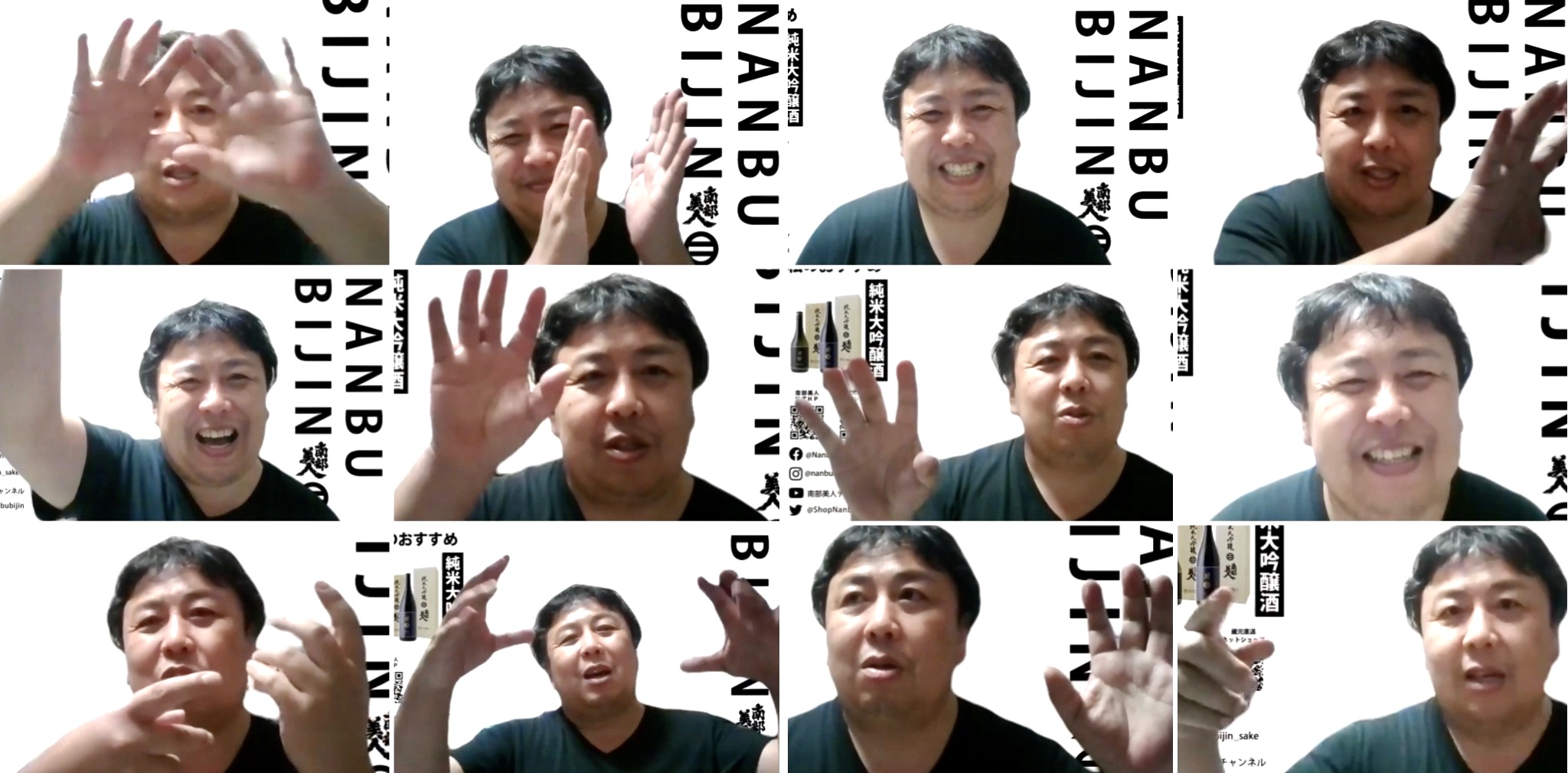
On Monday 11th July, 2022, TWTT had the absolute pleasure of spending not just 2, but close to 5 hours with the one and only Kosuke Kuji from Nanbu Bijin in Iwate prefecture.
In what was an epic marathon of a session, Kuji-san delved deep into every topic covered, yet even after 5 hours – there was still so much left uncovered…. There is already talk of a second session.
Lighting up the Zoom room from the word go, Kuji-san needed very little introduction to the TWTT audience, and those who were not so familiar with him prior to this session definitely picked up on his tireless and admirable energy and spirit.
Many sake fans outside of Japan, if not familiar with Nanbu Bijin’s sake, would perhaps be familiar with Nanbu Bijin’s 5th generation kuramoto Kosuke Kuji through the movie ‘Kanpai – For the Love of Sake’.
Founded in 1902, Nanbu Bijin is located in Ninohe city, Iwate Prefecture. This year marks their 120th anniversary. The area, we are told, is famous for urushi ~ traditional lacquerware.
Nanbu Bijin are currently exporting their sake to a whopping 55 countries! They currently brew their sake in 2 separate brewery buildings, using traditional methods. They do not use any charcoal fining/filtering for their sake. Their main brand is Nanbu Bijin, they also have a second brand; Houbai – which is very different to the cleaner, elegant style of their Nanbu Bijin brand, as Kuji-san explained; Houbai is created with food pairing in mind and perhaps a little more robust than their main, and more well known brand.
In addition to sake, Nanbu Bijin also produces fruit liqueur, vodka, gin and are in the process of adding whisky to their extensive line-up.
Of course, their innovative Super Frozen – Frozen Beauty sake also came up in conversation, prompting further curiosity and discussion allowing Kuji-san to elaborate on the brewery’s focus on ‘freshness’ in their sake.
Kuji-san explained that whilst he basically grew up in a brewery, he never really had any early desires to fill the family’s brewing shoes, rather, he had aspirations of being a school teacher. However, in his late teens, he had the opportunity to travel to, and study in the US. Kuji-san took a bottle of sake from his family’s brewery as a gift to his homestay family. Upon tasting it, Kuji-san remembers the delight expressed by his homestay father who assumed Kuji-san would also one day become a brewer and produce the style of delicious sake that he was sampling and enjoying. When Kuji-san explained to his homestay father that he had no intention of joining the brewery and was interested in becoming a school teacher, the father’s response was a pivotal moment for Kuji-san and made him reconsider his future ambitions. Kuji-san was told that anyone could be a school teacher, but what his family was doing was something very special, and something that not many people get the opportunity to do. After hearing this, and also after spending time with his homestay family, and new friends, in the US, he further realised the importance of his own culture, his family and the legacy of their business.
On his return to Japan, he was inspired to study fermentation and began paving his sake path in life. Kuji-san studied the art of making sake and shochu and other fermented goods at the Tokyo University of Agriculture. His teacher was professor Takeo Koizumi, a well regarded authority on fermented foods.
Today, there are surely many thousands of people all over the world who are so grateful that Kuji-san decided to pave and pursue the path of sake and take over the family business. And, his childhood dream, in many ways, has also been realised as he did become a teacher – perhaps not in the classroom environment that he had once envisioned – but he has become one of sake’s most well known advocates and is continually teaching people, everywhere, about the culture, importance and appeal of Japanese sake.
This session was so jam-packed with information and inspiration that writing a session overview seems almost futile.
A huge thank you to Kosuke Kuji for sharing his time, energy, knowledge, passion, stories, and more time with us. An extension of that huge thank you must go out to the wonderful Christopher Hughes – who was first drawn into the magical and mystical realm of sake via Nanbu Bijin a number of years ago. Chris has a great connection with Nanbu Bijin and a great rapport with Kuji-san and having him as co-host and interpreter for this session was an honour.
Thank you also to everyone who attended this session. Keep an eye out for part 2 somewhere in the future!
Taste with the Tōji ~ Session 88:
Takeshi Fukui
Fukui Yahei Shoten (Shiga)
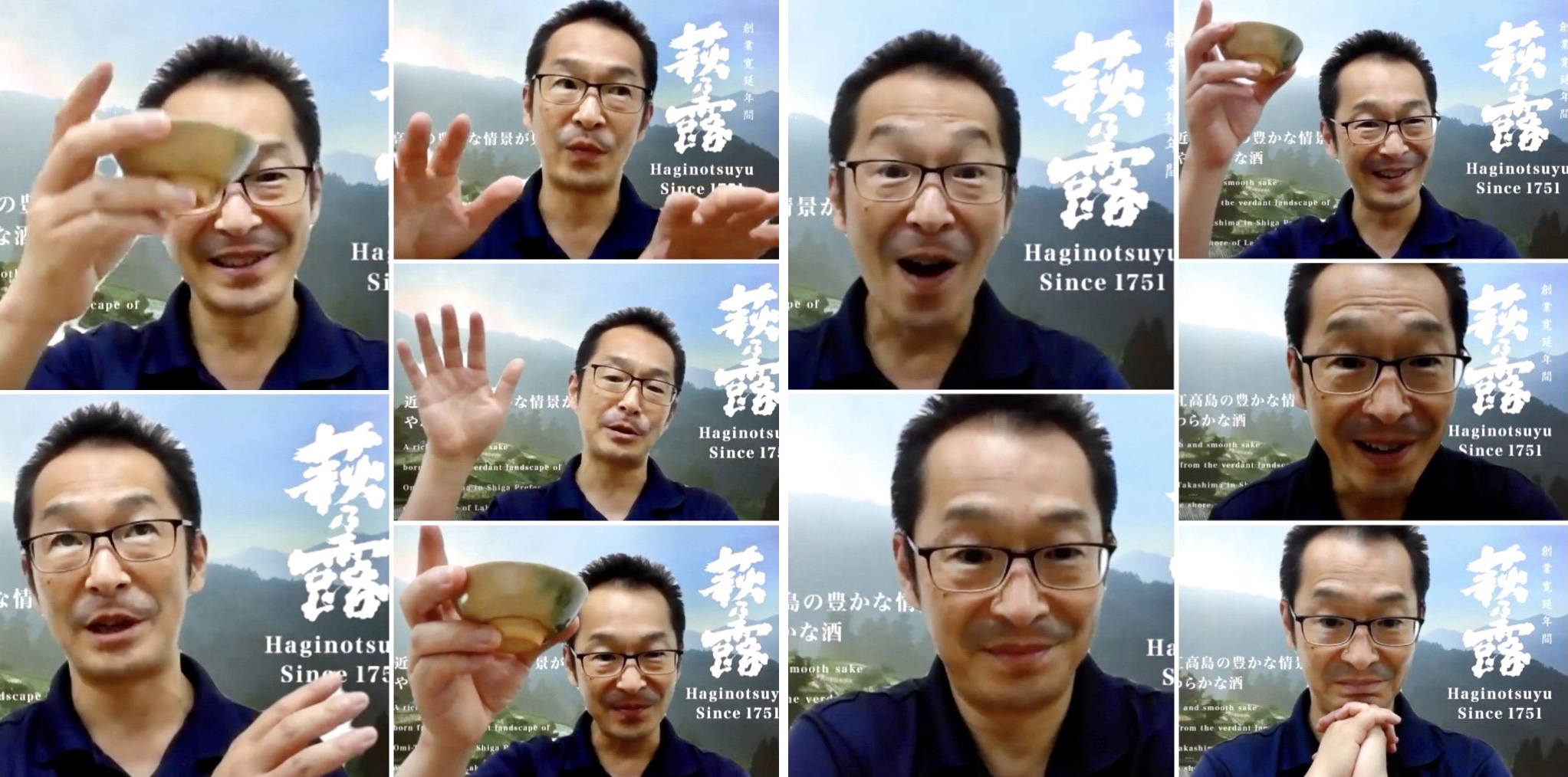
Monday 27th June, 2022, saw a truly in-depth and enjoyable session of TWTT when we headed to the beautiful Shiga prefecture to shine a spotlight on Fukui Yahei Shoten – producers of Hagi no Tsuyu, the label they have been brewing under since they began.
Despite being landlocked, Shiga prefecture is home to Japan’s largest lake. Fukui Yahei Shoten was founded in 1751, near the shores of the picturesque Lake Biwa, in Takashima City, Shiga prefecture. An area blessed by an abundance of nature and pure water.
Joining us for this session was 9th generation Kuramoto, Takeshi Fukui. It was hard to believe that he actually did not come from a sake brewing background, he in fact married into the Fukui family and has now been with the brewery for 22 years. Listening to Fukui-san talk passionately about brewing and his philosophies, you’d think he was born and bred in a sake brewery – this was clearly what he was meant to do. In addition to his passion, knowledge and respect for the craft, culture and the land, he is incredibly humble and an absolute joy to listen to.
This session was one that certainly appealed to the sake geek that lives inside many of the TWTT attendees.
Fukui-san works closely with and is strongly influenced by the elements of nature. He has a strong respect for the land and a true sense of community. He also does not fear change and embraces progress, which is something he believes is important for sake brewing today.
Omi-Takashima is home to some of the most beautiful terraced rice fields. The brewery actually started their Satoyama project 20 years ago, in order to help preserve some of these beautiful rice terraces, which had been facing problems due to an ageing population, arduous labour and damage from wildlife.
80% of the rice used by the brewery, (they use both sake rice and table rice), is grown in Shiga prefecture. The other 20% is grown in Hyogo prefecture.
It was interesting, and encouraging, to hear that COVID did not impact the brewery in such a way that they were forced to produce less, rather, they saw it as an opportunity to try new brews and projects and get a little creative.
In preparation for their 300 year anniversary, which will be in 2051, the brewery have begun ‘The 300 Project’, adding a new sake to their Amadare Ishi wo Ugatsu line-up. The new product is actually a kijoshu, made using Amadare Ishi wo Ugatsu sake. Next year’s brew will see it made using this year’s kijoshu… and so on, each new year adding the previous year’s kijoshu, until 2051. It’s a 30 year project in celebration of 300 years of establishment.
All of this is just a mere snippet of what was covered during this in-depth session, which exceeded the scheduled 2 hours, stretching over 3 hours – with still so much more to ask and absorb. Fukui-san was even kind enough to stay on for the nijikai with those who were keen to continue the conversation into the wee hours…
A huge thank you to Fukui-san for sharing his time, passion, knowledge and philosophies with us all. An extension of that huge thank you goes out to my co-host for this session, the wonderful John Townsend, for a truly heartfelt and remarkable interpretation that allowed non-Japanese speakers to really get a true sense of Fukui-san’s philosophies ~ leaving nothing lost in translation.
Thank you also to everyone who attended this session
Taste with the Tōji ~ Session 87:
Shinji Kawabata
Kamikawa Taisetsu Sake Brewery (Hokkaido)
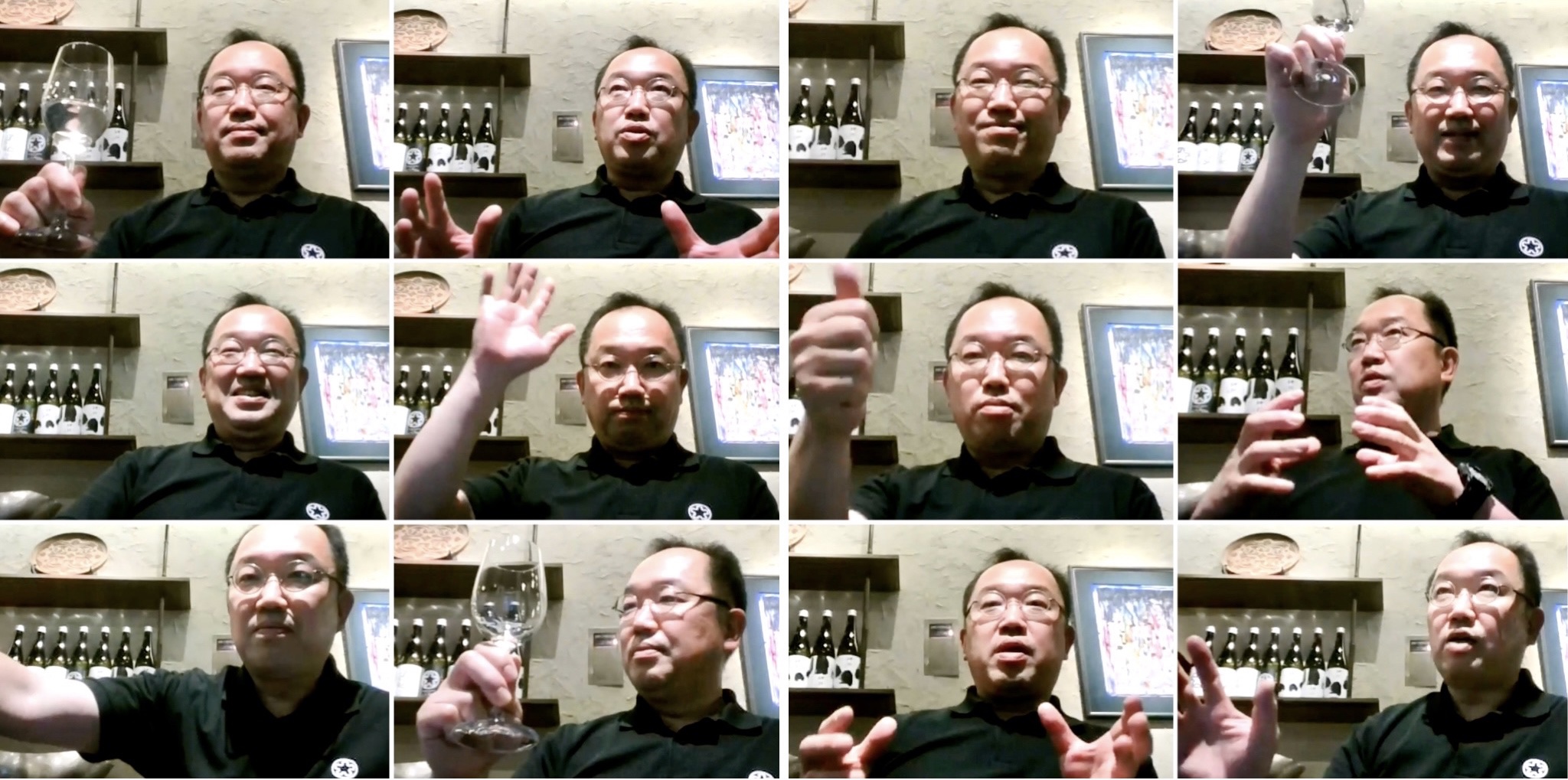
Monday 20th June, 2022, saw TWTT travel to Hokkaido prefecture for the first time. It only took us 87 sessions to reach Japan’s northernmost island! For this session, the feature brewery was Kamikawa Taisetsu Sake Brewery.
This brewery, with its very interesting story, first opened for business in 2017. One of the main aims of the brewery’s founder, Toshio Tsukahara, was to revitalise the local economy and tourism. Prior to opening the brewery, Tsukahara-san was working in the restaurant business, where he witnessed a long-winded struggle with patronage and a decline in tourism to Hokkaido – especially in Winter.
Tsukahara-san found a business 1,119 kilometres away that held a brewing licence but planned to stop brewing. He then moved the sake brewing license from Yokkaichi-shi, Mie to Kamikawa-cho and opened Kamikawa Taisetsu Sake Brewery.
Joining us for this session from the brewery was Toji, Shinji Kawabata.
Kawabata-san joined Kamikawa Taisetsu Sake Brewery as one of the founding members and has been involved in the management as vice-president in addition to leading his team of brew masters.
Kawabata-san made the decision to leave university in his early 20’s and pursue a career in sake brewing after being deeply moved by sake brewed by renowned Master Brewer, Noguchi-san. So moved that he joined Kikuhime Brewery in Ishikawa prefecture and began training under Noguchi-san.
Between starting his career at Kikuhime and joining Kamikawa Taisestu, Kawabata-san worked at another 5 breweries throughout Japan – (in Fukuoka, Iwate, Yamagata, Gunma and Hokkaido). His first sensei remains his greatest influence – of course, I speak of Noguchi-san.
Kawabata-san now teaches a young team of brewers, mostly Hokkaido born and bred, and oversees the brewing at Kamikawa Taisestu, who now have 3 breweries operating in Hokkaido prefecture.
The first: Ryokkyu-gura, was founded in 2017, the second: Hekiun-gura opened in 2020, and the most recent: Hakodate Goryo-no-kura opened in 2021. A planned expansion of the business is also on the cards.
The brewery’s striking logo represents both a snowflake as well as the 5 flavours, whilst also incorporating ‘大’ (dai) – the first character of ‘Daisetsuzan’. Daisetsuzan (大雪山) is Hokkaido’s largest national park, a picturesque and mountainous area of virtually unspoiled wilderness.
A huge thank you to Shinji Kawabata for sharing his time and story with us and also to Kazuhiro Takeuchi, who joined us from the brewery for this session and put together all the visual material as well as interpreted for Kawabata-san.
Thank you also to everyone who attended this session.
Taste with the Tōji ~ Session 86:
Takashi Nakai & Mitsuya Nagai
Nami no Oto Shuzo (Shiga)
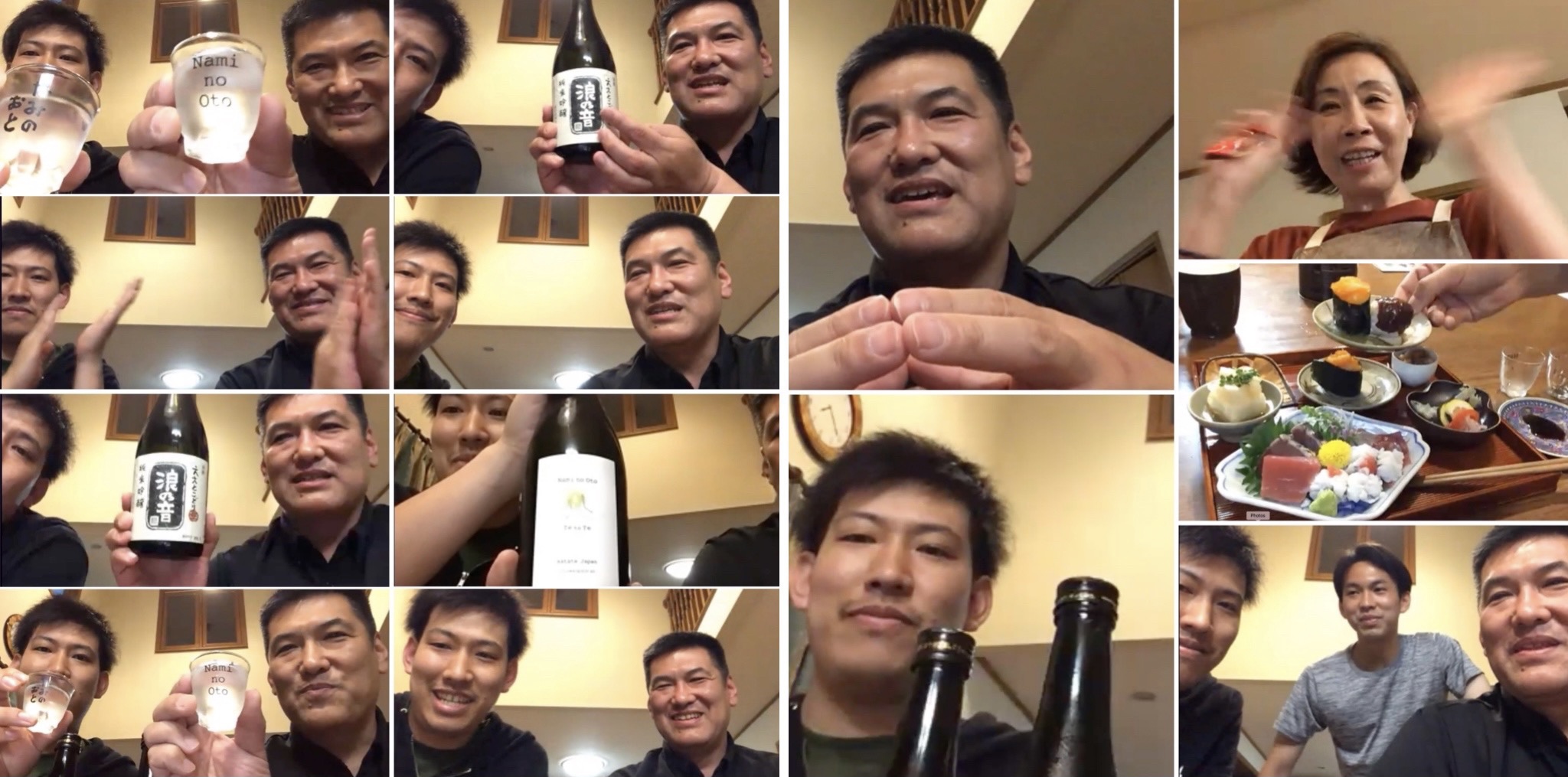
Monday 6th June, 2022, saw a truly enjoyable session of TWTT when we headed to Shiga prefecture to learn about Nami no Oto Shuzo.
This was the 86th session in the TWTT series and a brewery I had been wanting to feature for some time.
Joining us for this session was Kuramoto, Takashi Nakai, along with his son, Mitsuya. During the session, we were also introduced to Nakai-san’s lovely wife, Mie, and another of their sons, Akito. A real family affair, which has been the theme for several TWTT sessions, and was kind of fitting for this one as I was fortunate enough to be able to introduce my dear father to the Zoom room attendees before we started the session – which was a real honour to be able to do.
This session was delightfully laid back, with a wonderful intimacy that made us all feel like we were having a drink and wonderful conversation together in Nakai-san’s living room. The absence of a powerpoint presentation or virtual brewery tour allowed for more time to converse with our delightful guests and get to know them and their story a little better.
Nami no Oto was established in 1805. They are located in Otsu city, close to the shores of Lake Biwa. Nakai-san is the 10th generation owner of the business, with 11th generation Mitsuya set to follow in his footsteps. Some were curious as to how a brewery established in 1805 can already up to the 11th generation… Nakai-san explained that the brewery existed under a different name prior to its incarnation as Nami no Oto.
Just a quick link back to the theme of family, not only is Nakai-san’s son set to follow in his footsteps, he also has 2 brothers working at the brewery, one is the Toji and the other is in charge of koji production.
Nakai-san tells us when he joined the brewery, the sake that was being produced was not held in high regard. He knew they needed to find an exceptional Toji and set out to find someone from the Noto Toji Guild. This wish proved to be a somewhat complicated one due to the brewery’s mediocre reputation, however, with conditions in place and agreement made, the brewery were able to acquire a Noto Toji who, at the age of 70, agreed to work for the brewery for 5 years and the Nakai brothers would then take over upon his retirement. Thus starting the mission to lift the quality of their sake and the brewery’s reputation. Those who know Nami no Oto’s sake nowadays would agree that their mission was accomplished!
Nakai-san’s son Mitsuya studied/learned the brewing process for 4 years at Akebono Shuzo, producers of Tenmei sake, in Fukushima. He came back to Shiga, to Nami no Oto, last October to begin his first brewing season at his family’s brewery. He has been working on a new brand for the brewery called ‘Te to Te’ and also designed the label for this sake.
Te to Te translates to ‘hand in hand’ which is inspired by the hand crafted nature of their sake, as well as family connection and human connection – and humans connecting with/to sake… ( I would also add ‘connecting humans through sake’ which is kind of also TWTT’s mission ).
It was wonderful to connect with this father and son duo. There were many more topics covered and stories told, including Nakai-san’s love of Haiku – one attendee alerted us to the fact that Nakai-san actually runs a Haiku club! When asked if Haiku influences his sake, Nakai-san answered that it is more the sake that influences the Haiku. Club meetings were more regular prior to the pandemic. Currently, I believe the members meet on a Sunday, once every couple of months. The Haiku club now incorporates the ‘Nami no Oto Sake Club’ which is a great way to introduce poetry lovers to their sake. After composing their Haiku, the group then enjoy Nami no Oto sake together. This sounds like a club many of us would love to join and Nakai-san tells us that everyone is welcome.
The brewery also have a 20 seater restaurant that runs from June to September. Nakai-san’s wife, Mie, walked us through some of the delicious items on the menu.
This really was such an enjoyable session and I would like to thank Takashi and Mitsuya Nakai for sharing their time, (and extended time), passion, stories and charm with us all. Also, a big thank you to the truly wonderful John Townsend for an incredible interpretation, co-hosting with the most, and for helping to bring Nami no Oto to the TWTT table!
Thank you also to Mie Nakai, Akito Nakai and to everyone who attended this session!
Taste with the Tōji ~ Session 85:
Yuko Hasegawa & Hiroaki Suzuki
Hasegawa Shuzo (Niigata)
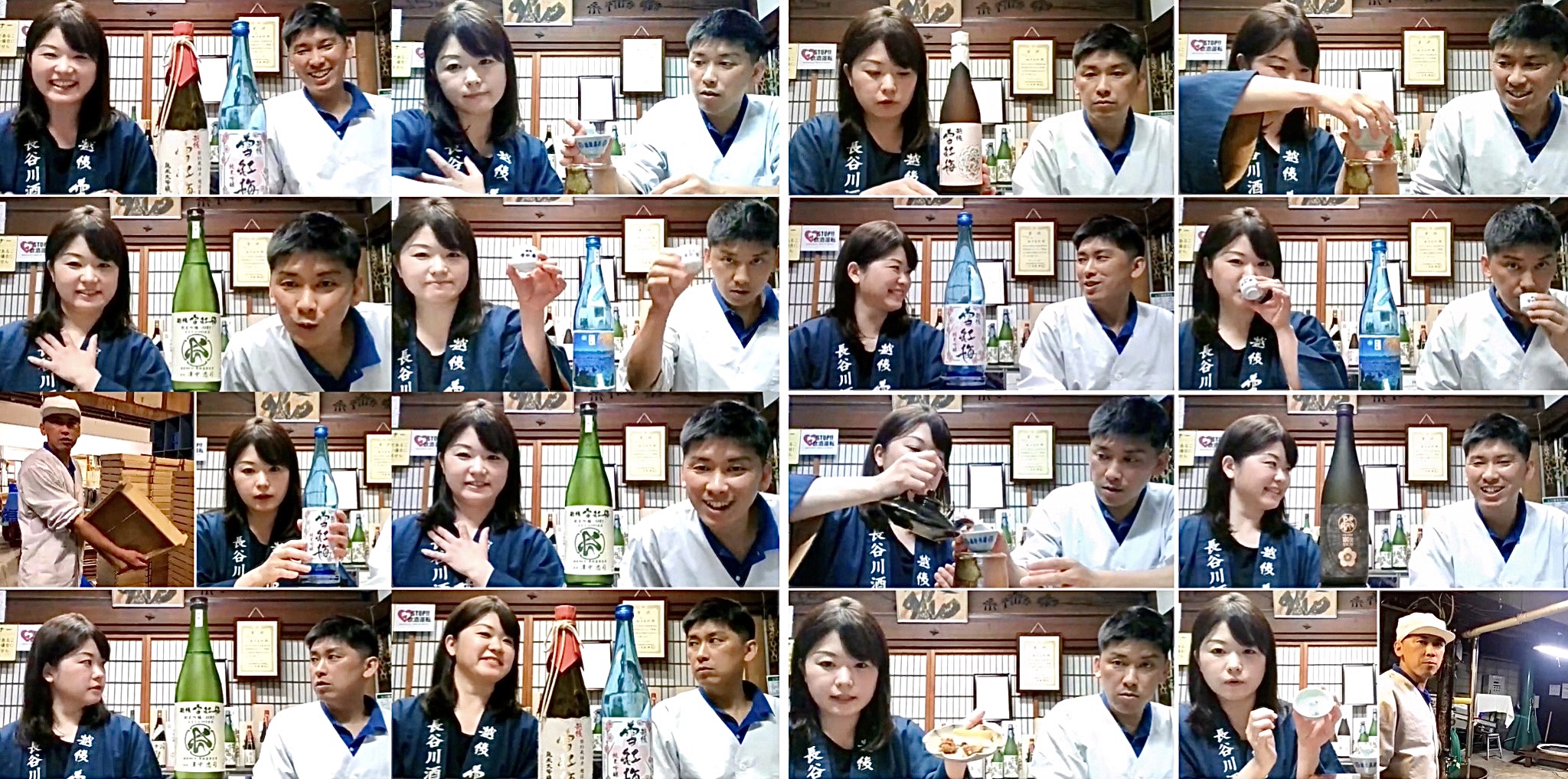
On Monday 30th May, 2022, TWTT travelled to Niigata prefecture to shine a spotlight on Hasegawa Shuzo. Established in 1842, the brewery is celebrating its 180th anniversary this year.
We were joined for this session by Toji; Hiroaki Suzuki and Yuko Hasegawa, who is the daughter of the Kuramoto; Yoko Hasegawa. Yoko-san was scheduled to join us but unfortunately was unable to attend the session.
The brewery is located in Settaya, Nagaoka city in Niigata prefecture ~ a prefecture well known for sake brewing, and one with the highest number of active breweries in Japan, currently 88.
Their current brewery building is around 130 years old and is a Registered Tangible Cultural Property.
We were taken on a live virtual tour of this beautiful kura during this session, which, despite the choppy wi-fi, was great to get a look inside. Stepping inside some of these old breweries, even if only virtually, is like stepping back in time.
Hasegawa-san also put together a slide presentation taking us through the local history and culture and the brewery’s 3 labels: Hatsuhi Masamune, Nagaokajo and their main brand: Sekkobai, under which they are set to release a special sake to celebrate their 180th anniversary.
Hasegawa Shuzo’s brewing season runs from September to April and they are currently brewing around 700 koku per season. When it comes to rice, around 60% of the rice they use is grown in Niigata prefecture.
Yuko Hasegawa was born into a sake family and has many fond memories of the brewery, and the people, from her childhood. She is set to follow in her mother’s footsteps – Yoko Hasegawa, as mentioned earlier, is the current Kuramoto. Yuko’s younger sister is also involved with the brewery, making it quite the family affair.
Suzuki-san, on the other hand, did not grow up in a sake family. He started his brewery career in Kanagawa prefecture when he was 33. He now has 10 years experience and 7 of those have been at Hasegawa Shuzo. He was promoted to Toji last year.
It was an honour to spend a little over 2 hours with these two delightful guests. As always, there was so much more we could have learnt about and questions we could have asked.
A huge thank you to Yuko Hasegawa and Hiroaki Suzuki for sharing their time, knowledge, experience and stories with us.
An extension of that huge thank you must go out to Harald deRopp for another wonderful interpretation and for helping to put this family-run brewery on the TWTT map.
Thank you also to everyone who attended this session.
Taste with the Tōji ~ Session 84:
Tatsuya Kojima with Giulia Maglio
Itakura Shuzo (Shimane)
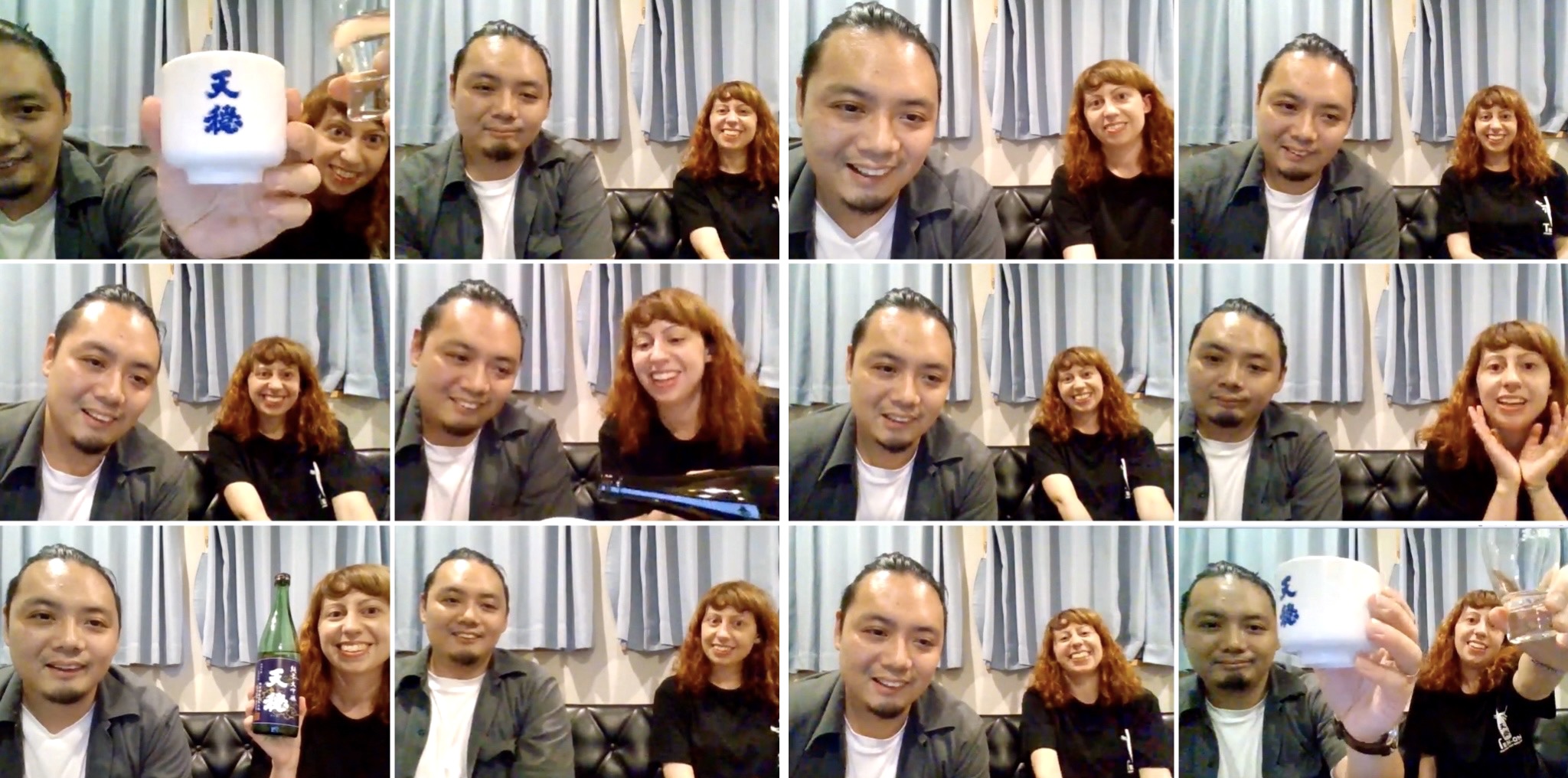
Monday 23rd May, 2022, saw TWTT head to Shimane prefecture to shine a spotlight on Itakura Shuzo. For this session, the 84th in the series, we were joined by Toji, Tatsuya Kojima and Giulia Maglio.
Itakura Shuzo was established 1871 in Izumo, Shimane. Their main brand, Tenon, takes its name from ‘Mukyu-Tenon’ – which represents ‘eternal peace’.
This session was a wonderful meld of information and conversation from the perspective of both the Toji and someone who has just started learning the ropes of sake brewing through hands-on experience inside Itakura Shuzo. It was also really lovely to see the mutual respect between these two people, from two different cultures, at two completely different stages of their sake journey.
We got to take a look inside the kura, thanks to a pre-recorded video, with real time narration by Kojima-san and Giulia. This was followed by a wonderfully informative slide presentation leading to some great points of discussion on topics such as Izumo Toji, slower ferments, San-In Ginjo brewing mastery, Tsuki-haze koji, and a whole lot more.
Interesting also to note that Itakura Shuzo have their own rice polishing machine – a luxury afforded and accommodated by only a small number of breweries.
Kojima-san, who has been Toji now for 7 years, surprisingly, (despite his evident passion and soulful nature), was not born into the business. He actually studied architecture before entering the sake industry.
Kojima-san is both generous in sharing his knowledge and information as well as humble in his delivery ~ his deep respect for those who taught him is clearly evident and his homage to them is reflected through the sake he brews.
His brewing motto is ‘philosophy and feeling above social expectations’ ~ which may be a loose translation but nothing is lost in the meaning when you’re in the presence of Kojima-san (even if only virtually).
Hearing from Giulia, who first connected with this brewery through her friend – leading to a short stage at the brewery last year, it was evident that Kojima-san and his philosophy and above mentioned qualities contributed greatly to her wanting to come back to the brewery this year – to work with a wonderful mentor and continue to learn from him and his small team. Kojima-san also saw something in Giulia and was impressed that she did not come into the kura with rose-coloured glasses – rather, she was prepared for the back-breaking work and far from glamorous jobs that far out number the ‘fun’ ones.
A truly enjoyable and informative session and we look forward to maybe chatting with these two fine humans again next year.
A huge thank you to Kojima-san and Giulia Maglio for sharing their time, knowledge and experiences with us. An extension of that thank you must go out to the delightful Maki Tanaka for being my trusty co-host and interpreting for this session.
Thank you also to everyone who attended this session.
Taste with the Tōji ~ Session 83:
Shinichiro & Masae Shimizu
Shimizu Seizaburo Shoten (Mie)
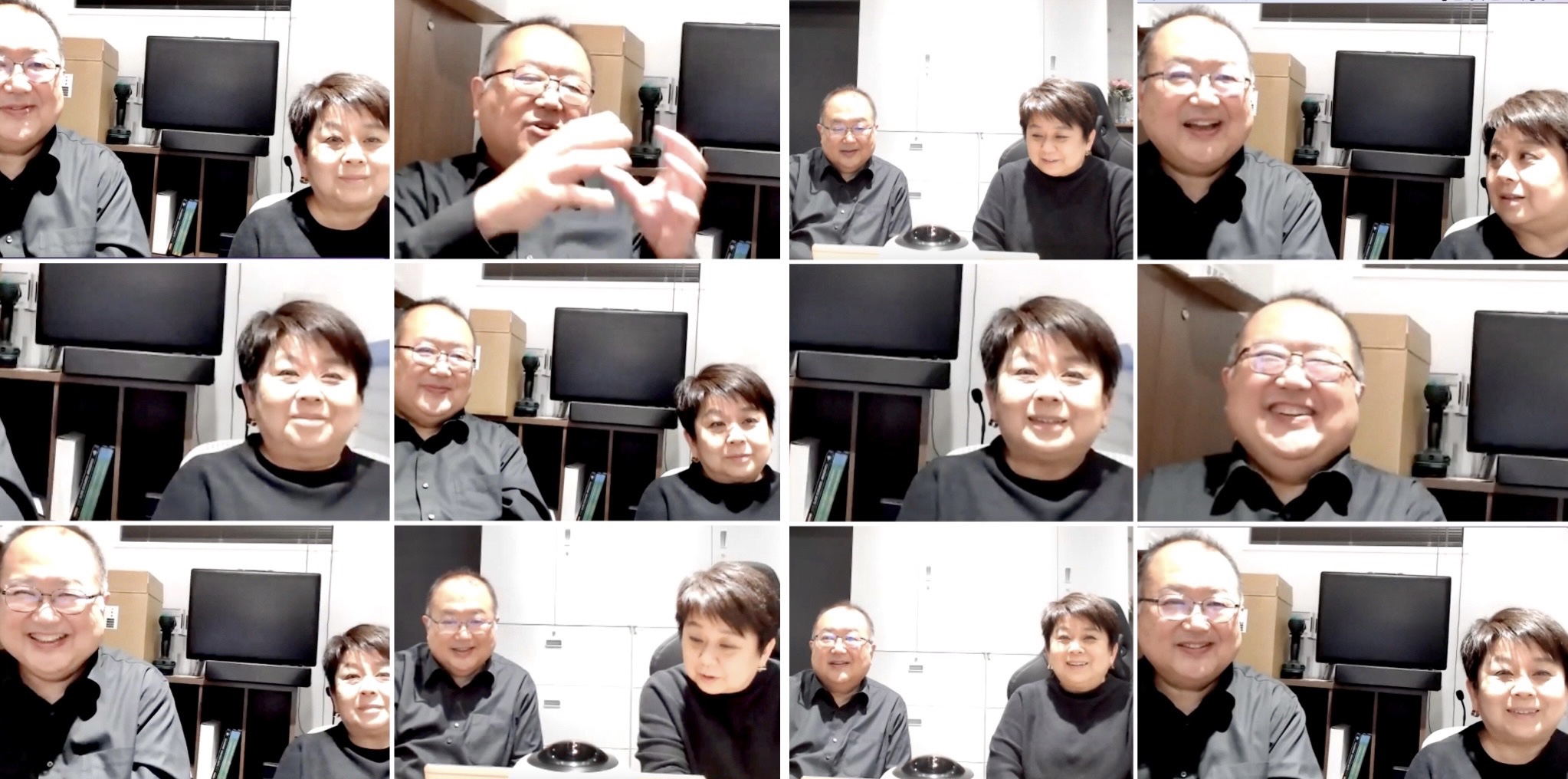
Monday 16th May, 2022, saw session #83 of TWTT take place as we headed to Mie prefecture to spend a couple of hours (and a bit) with Shinichiro and Masae Shimizu from Shimizu Seizaburo Shoten.
It was an honour to have Kuramoto, Shinichiro Shimizu, and his wife Masae join us last night. Their Toji, Uchiyama-san had planned to join us, but sadly was unable to make it last night.
The Shimizus put together a wonderful presentation, packed with a wealth of information about the brewery as well as local arts and culture.
The brewery is located in Suzuka, Mie prefecture and was established in 1869. In 2019, the company celebrated 150 years. To coincide with this milestone, the brewery decided to re-work their product design. Their new labels were introduced in October 2021.
Shimizu-san explained the inspiration behind their logo is water. And the concept of the 3 waves relates to 3 groups of people in the sake world: the people who make the sake, the people who sell the sake and the people who drink the sake.
The city of Suzuka is actually famous for Ise katagami: the Japanese craft of hand-cutting paper stencils used mostly for dyeing textiles, namely for kimono. It has been designated one of the Important Intangible Cultural Properties of Japan. 90% of the katagami currently in circulation has been produced in Suzuka city. Sadly, however, there are now only a handful of artisans still practicing this traditional craft.
The brewery has been working with one of these Katagami artists, who has been creating beautiful intricate designs to work into the brewery’s ‘3 Wave Diamond’ logo on the labels of their Suzukagawa range.
It turns out the city of Suzuka city has been a hub for sumi-ink production since the Heian era (794-1185) thanks to an abundance of natural resources in the area. The pine trees in the area produce excellent quality soot when burned, and the water quality is especially suitable for creating good glue viscosity. Suzuka-zumi ink is created by the soot being molded together with nikawa glue (made from animal bones and hides), and natural fragrances, into a stick shape. This process is long and laborious, with most of it being done completely by hand. The completed inkstick is then rubbed on an inkstone (known as a suzuri) with a little water to create the right consistency for painting or writing. The labels on the brewery’s Zaku range highlight the art of using Suzuka-zumi ink. Once again, the brewery has worked with a local artisan to create their label design.
This session was as much about the brewery as it was about the fascinatingly rich history and culture of Mie prefecture… including the Shinto mecca that is Ise Jingu: a Shinto shrine dedicated to the sun goddess Amaterasu.
The intertwining of ancient crafts and culture is beautiful to see and was evident again when we spoke about the Mie GI (Geographical Indication) as their logo encompasses another cultural element that is indicative to the area – and attendees were given a crash lesson about Noshi Awabi (a kind of origami featuring dried abalone flesh) and its ceremonial and celebratory use.
With so much to cover and so little time, the 2 hours flew by, extending into 2.5 hours with still so much more to learn, see and ask. We got to hear a little about the Toji’s story, who joined the brewery when he was 25 and is still there 25 years later at the age of 50. Sadly, time ran short before we were able to hear a little more about the personal journeys of our humble guests but we thank them very much for an insightful and enjoyable session which no doubt has put Mie high up on the travel wishlist for many who attended this session.
Shimizu Seizaburo Shoten currently produces around 3000 koku per year and are exporting their sake to around 20 countries.
A huge thank you to Shinichiro and Masae Shimizu for sharing their time, knowledge, experience and passion with us all. An extension of that huge thank you goes out to Harald deRopp for passionately co-hosting and interpreting for this session ~ and for helping to put another Mie brewery on the TWTT map!
Thank you of course, as always, to everyone who attended this session!
Taste with the Tōji ~ Session 82:
Tsutomu Abe & Muneyoshi Higuchi
Aoki Shuzo (Niigata)
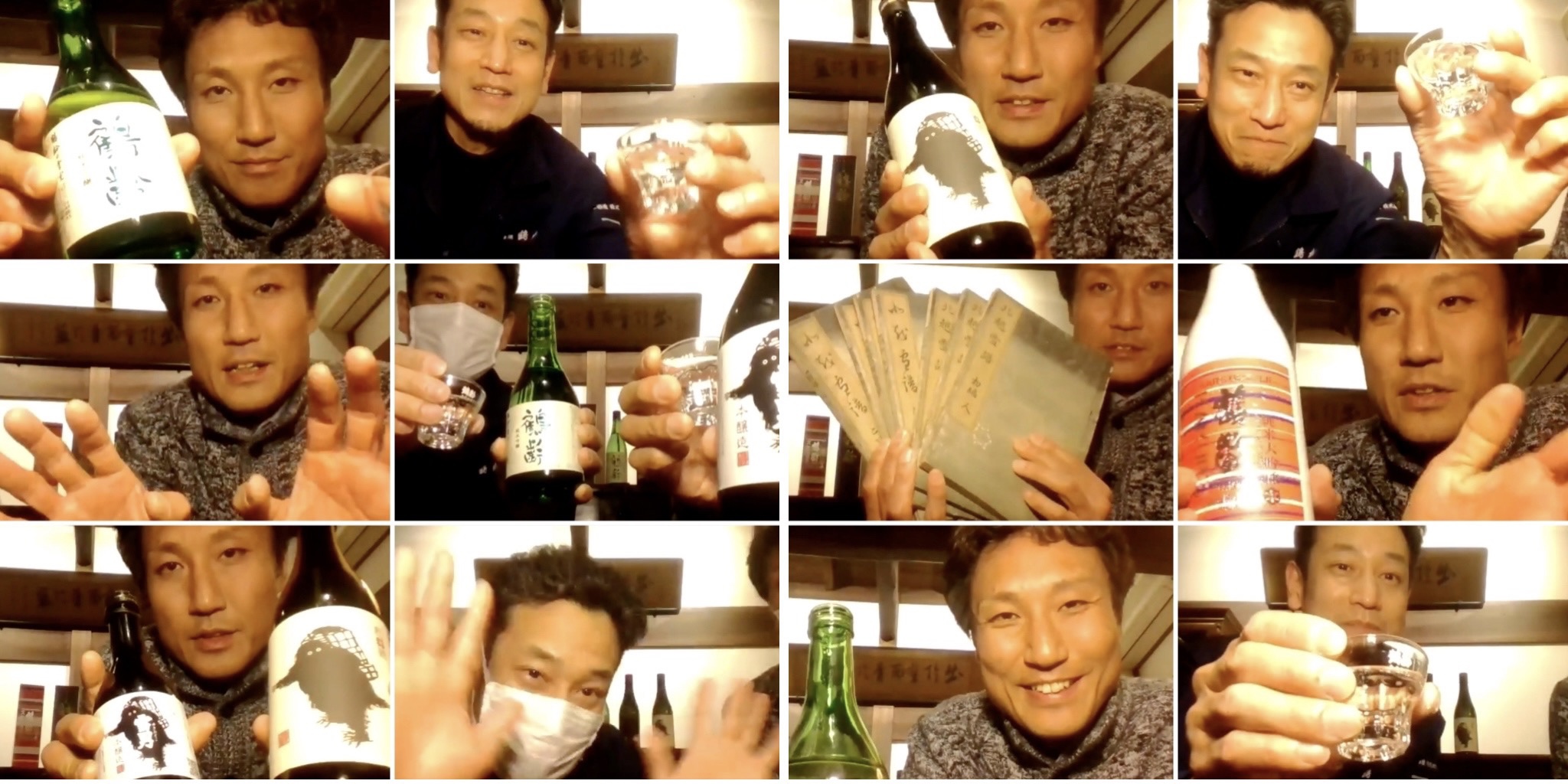
Monday 9th May, 2022, saw another wonderfully enjoyable session of TWTT when we headed to Niigata prefecture to feature Aoki Shuzo.
Aoki Shuzo is located in Uonuma city in Niigata prefecture. Established in 1717, they have been brewing sake for over 300 years.
Joining us from the brewery for session #82 of TWTT was Tsutomu Abe. We were also fortunate enough to be joined by their Toji, Higuchi-san, for the first hour of the session.
Abe-san and Higuchi-san presented a wonderful virtual brewery tour through a video shot inside the kura earlier this year – showcasing their impressive set-up and demonstrating some aspects of the brewing process. It was also great to see inside their Yukimuro, or ‘snow room’ where they store and age their sake.
Later in the session, Abe-san showed us some impressively shot footage, (featuring some beautiful aerial views of the landscape), of the snow being collected and transported to the Yukimuro. Very cool stuff! (pun intended)
Originally from Nagasaki, Higuchi-san, at the tender age of 49, already has an impressive 29 years of brewing experience – all within the Niigata prefecture. When asked how he came to be interested in sake, as he was not born into a brewery – we learnt that he had his ‘wow’ sake moment, or ‘sake epiphany’ when he was drinking Niigata sake for the first time. This was the beginning of a life-long relationship and a dedication to brewing sake in Niigata. Prior to joining Aoki Shuzo 4 years ago, he worked at two other Niigata breweries for a period of 6 years and 19 years respectively.
As they are currently still brewing at Aoki Shuzo, Higuchi-san departed half way through the session to get back to work. Their brewing season begins at the start of September and runs until around the end of May.
Aoki Shuzo’s main brand is Kakurei. Abe-san explained: while Niigata prefecture is famous for Tanrei-Karakuchi, the light, elegant and dry Sake style, at Aoki Shuzo, through their Kakurei label, they are aiming to create Tanrei-Umakuchi ~ sake that remains crisp and easy to drink but has a little more umami, and pairs well with a wider variety of foods.
They also produce a small amount of sake under their Bokushi label, and the third label in their line-up is Yukiotoko: featuring a Yeti on the design of the label. Abe-san explained that this label is leaning more towards the Niigata-esque Tanrei Karakuchi.
Kuramoto, Aoki-san, had planned to join us but sadly was unable to – however, he released a very precious item for the night, under the care of Abe-san, to show us what had been the inspiration for the Yukiotoko label. Abe-san held in his hand a collection of 7 books, with stories transcribed from the Edo period. The series is titled Hoketsu Seppu, written by Suzuki Bokushi, and was published in 1837. One of those volumes contained the story of a Merchant and the Yeti.
Hoketsu Seppu was an immediate bestseller that eventually encompassed seven chapters when a second volume was published in 1841. It covers a wide range of local topics from the varieties of snow to the customs, lifestyles, local dialects, industries, and folklore of Japan’s snow country. The text covers 123 themes from multiple angles and is also illustrated with some wonderful drawings, one being the Yeti that now appears on the Yukiotoko labels.
Another wonderful thing we learnt about Yukiotoko sake, also inspired by the story in Kokuetsu Seppu, was that a percentage of the sales are donated to snow rescue operations in Niigata.
All of this and so much more was packed into a 2.5 hour session that was most enjoyable and educational and as always, there was still so much more we could have learnt, asked and discussed.
A huge thank you to Abe-san and Higuchi-san for sharing their valuable time, invaluable knowledge and wonderful stories with us all. An extension of that huge thank you goes out to my good friend, and co-host for this session, Harald deRopp for helping to put Aoki Shuzo on the TWTT map and for a wonderful interpretation. Harald’s passion for sake is infectious and wonderful to witness.
Thank you also, as always, to everyone who joined this session.
Taste with the Tōji ~ Session 81:
Takuya Chida
Chida Shuzo
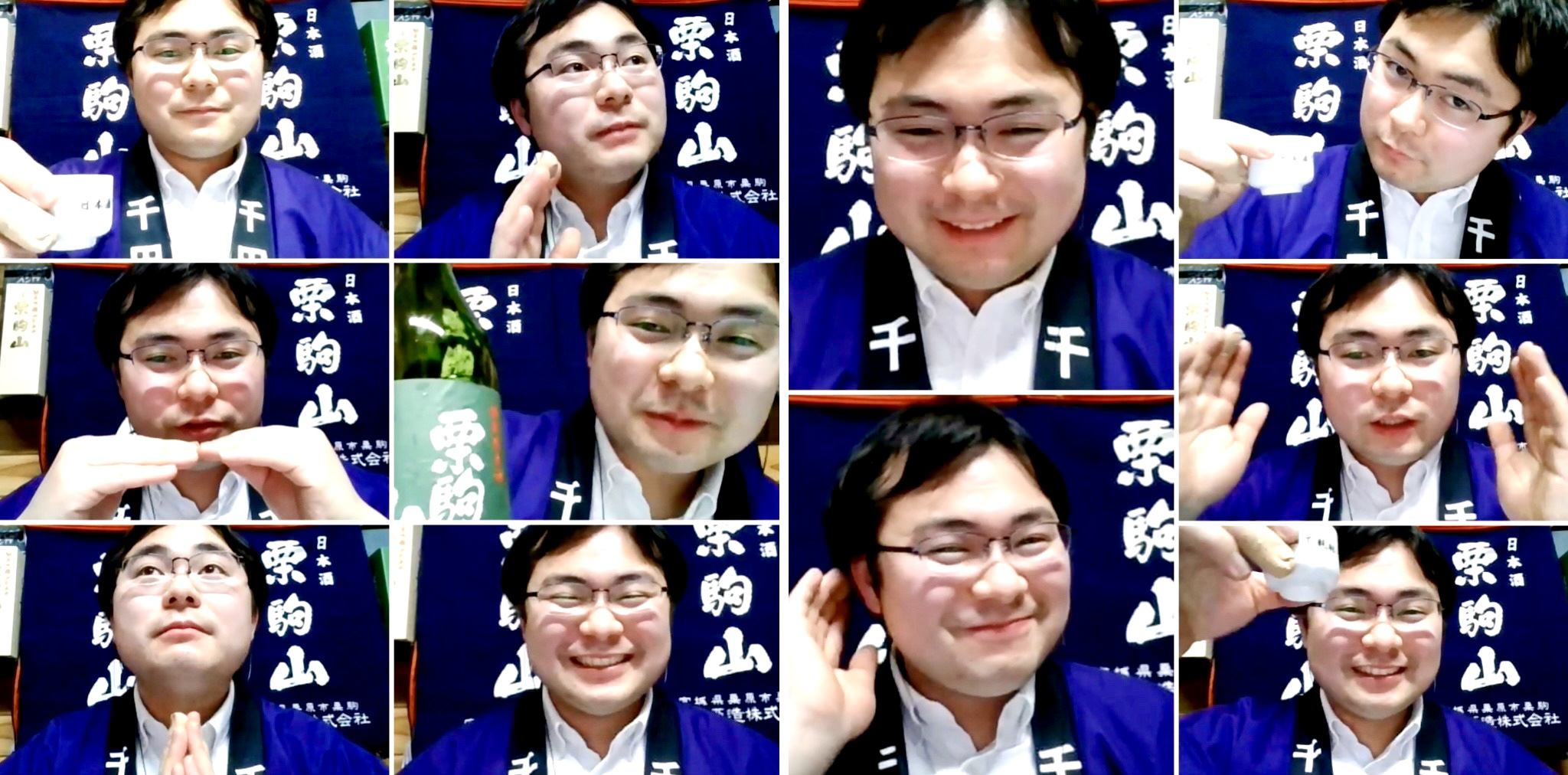
Monday 25th April, 2022 saw TWTT host its 81st session as we headed to Kurihara City in Miyagi prefecture to feature Chida Shuzo.
It was great to shine the spotlight on another Miyagi prefecture brewery – a prefecture very close to the hearts of many TWTT members.
Joining us for this session was 5th generation, Takuya Chida who, at the age of 28, is currently working under his fathers guidance in preparation for one day taking over the role as Kuramoto.
From the word go in this session, Chida-san placed a huge emphasis on water, and just how important the brewery’s water source is. This is a brewery that is so dedicated to water that they relocated the brewery, established in 1920, to a new location in 1937 so they could be closer to a water source that would provide higher quality water to enable them to brew better sake.
Chida Shuzo produce two labels: Kurikomayama, named in honour of Mt. Kurikoma, and Okutsuru – which is purely for the local area. They export a very small amount of their Kurikomayama sake, mostly to Singapore and Hong Kong.
Chida-san put together a great presentation, covering the brewery’s brewing and pressing process, their Kurikomayama line-up and some wonderful slides of the Kurihara area and its local attractions.
A wonderful advocate for Chida Shuzo and Kurihara City, it was a pleasure to spend a couple of hours with Chida-san and learn more about another wonderful part of Miyagi prefecture.
A huge thank you to Takuya Chida for sharing his time, energy, passion and stories with us. An extension of that huge thank you must go out to my good friend, and co-host for this session, Harald deRopp for interpreting for this session and helping to get another Miyagi brewery on the TWTT map.
As always, thank you to everyone who attended this session.
Taste with the Tōji ~ Session 80:
Shizuka Ito & Yuki Shibata Mizuno
Shibata Shuzo
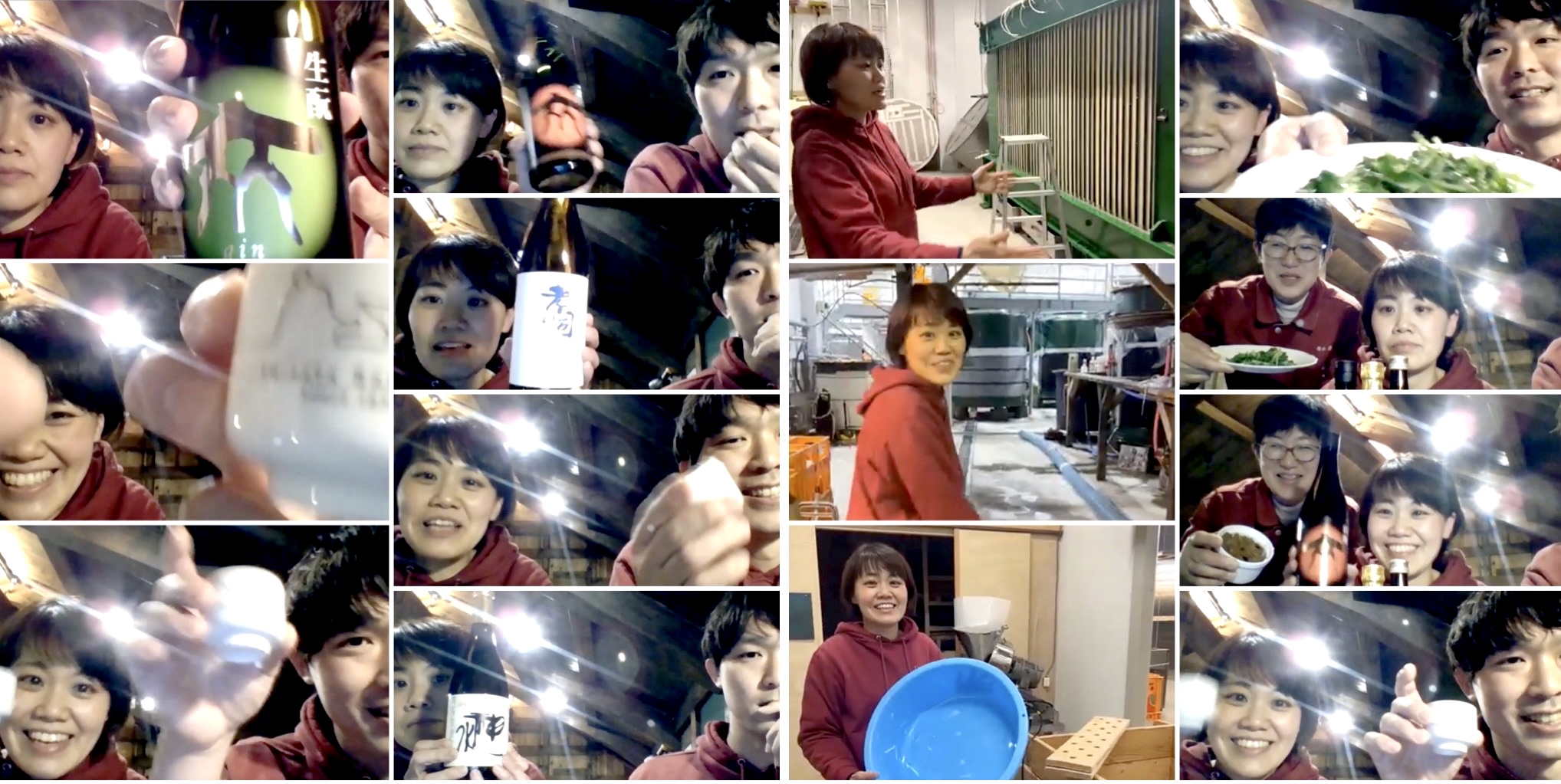
Monday 18th April, 2022 saw the 80th session of TWTT when we headed to Aichi prefecture for the first time in this series and spent a most enjoyable 2.5 hours with Yuki Shibata Mizuno and Shizuka Ito from Shibata Shuzo.
Shibata Shuzo was established in 1830. They are located in Okazaki city, Aichi prefecture – an area rich in nature, with an abundance of wildlife and home to some of the softest water in Japan. The area is also well known for its miso, tea and konjac (yam).
The brewery’s wi-fi connection was on our side for this session and we were lucky enough to get a virtual tour of the kura. The brewery was actually rebuilt only 8 years ago, in 2016, which explained why much of their modern interior looked rather shiny and new.
However, it was a piece of equipment with no shiny bits that actually shone the brightest in terms of piquing the interest of the attendees. We were privy to being introduced to their unique, custom-made koji-drying device, known in the brewery as ‘Suzukaze Alpha‘, designed by one of the brewery’s kurabito, Suzuki-san. After giving us a little explanation of Suzukaze Aplha, Toji Shuzuka Ito went on to explain that since using this device, she has seen a dramatic improvement in the sake they produce.
Ito-san is incredibly humble when talking about her life as a Toji. She started working at the brewery 20 years ago, which is hard to believe when you see her as she barely looks much older than the number of years she has been at the brewery! She became interested in sake in her early twenties and decided she wanted to work in a brewery. After approaching a long list of breweries in Aichi prefecture, she finally got a positive response and began working for Shibata Shuzo at the age of 22. She has been Toji now for around 6 years.
Yuki-san’s journey was a little different but led him to the same destination. He married his childhood sweetheart, who just happened to be the ‘daughter of a brewery’, thus he married into sake and has never looked back!
Despite the effects of recent times hitting the brewery pretty hard, you get the sense that their youthful energy, passion, dedication and determination will see them succeed and steadily grow over the coming years. They are certainly producing some excellent sake – now it just needs to get out there to more places in the world to be discovered and enjoyed.
A huge thank you to Yuki Shibata Mizuno and Shizuka Ito for sharing their time, passion, stories and knowledge with us all. An extension of that huge thank you must of course go out to my trusty co-host for this session, Maki Tanaka, for yet another fantastic interpretation. TWTT has made it to 80 sessions thanks to all the incredible people who help out behind the scenes and with interpretation and I am forever grateful.
As always, a big thank you to everyone who attended this session!
Taste with the Tōji ~ Session 79:
Atsunori Takeshima
Emishiki Shuzo
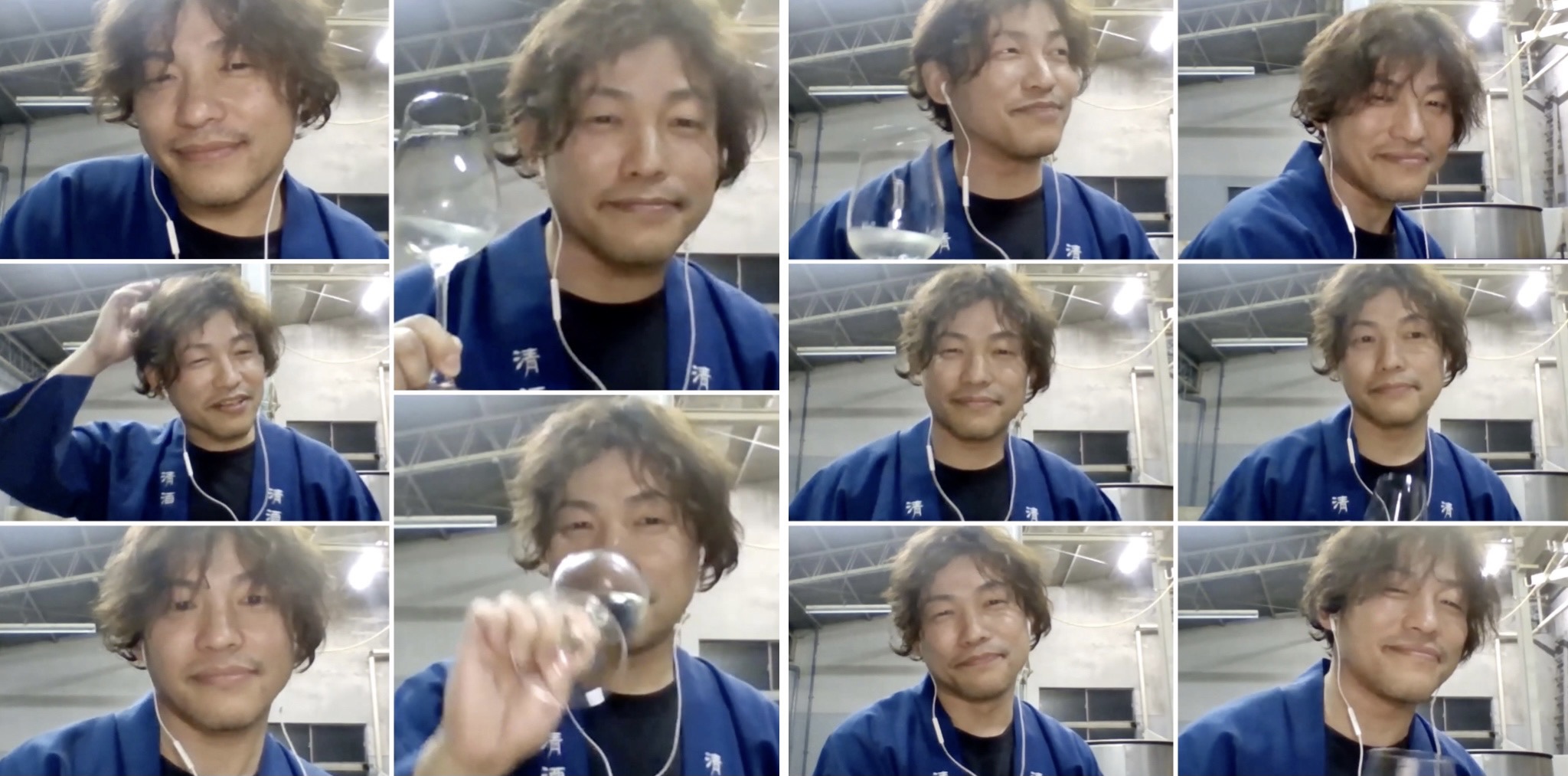
Monday 11th April, 2022 saw another fun, informative and engaging session of TWTT as we got to shine the spotlight on Emishiki Shuzo. This was the first time TWTT has visited Shiga prefecture, (it only took us 79 sessions!!) and joining us for this session was 5th generation Kuramoto (he’s also the Tōji), Atsunori Takeshima.
Atsunori-san was not born into the brewery family; he married the daughter of 4th generation Kuramoto and went on to make sake his life – (in addition to his family of course, which included 4 children… one of whom he hopes will take over the brewery some day).
Emishiki Shuzo was established in Kōka city, Shiga prefecture in 1892. However, their brewery building was actually rebuilt around 30 years ago.
Along with Iga city, in Mie prefecture, Kōka city is considered the homeland of ‘ninja’. In addition to ninjas, Kōka city has another famous mascot ~ the Tanuki. The area is well known for it’s production and display of chubby, ceramic Tanuki statues. The city is also the home to one of the Six Ancient Kilns in Japan and is famous for Shigaraki ware.
There was a lot to cover in Takeshima-san’s presentation, and even more in the follow-on Q&A time… which saw the session go 1 hour over the scheduled 2 hours.
Emishiki Shuzo has 2 water sources: well water and spring water. They do grow a small percentage of their own rice, and the rest is grown by contract farmers who the brewery are working closely with. They are also involved in reviving Shiga’s Tankan Wataribune sake rice.
On the topic of rice, interestingly, everything they currently brew is made using rice polished to 50%. This opened up the floor for a discussion on ‘sake classification’, or the tokutei meishō-shu, as the brewery does not use this classification system for any of their sake.
Up until around 30 years ago, the brewery was producing approx 5000 koku; around 10 times the amount of sake they are making today. This was in part due to the fact they were producing sake for another brewery. Today, their annual production is around 500 koku and they are only producing sake for their own labels. They are driven towards producing a sweeter, richer style of sake and everything they brew is Junmai Muroka and uses the Kimoto method.
Of course, all this is only a fraction of what was touched on during the session and the discussion continued beyond the 3 hours, with Takeshima-san staying on for the nijikai, happily answering more questions from those who stayed on.
A huge thank you to Atsunori Takeshima for sharing his time, knowledge, philosophy and humour with us all. An extension of that huge thank you goes out to the wonderful Maki Tanaka for yet another mammoth interpretation and for helping to make this session possible and finally getting Shiga prefecture on the TWTT map!
Thank you also to everyone who attended this session.
Taste with the Tōji ~ Session 78:
Hiroki Sugawara
Otokoyama Honten
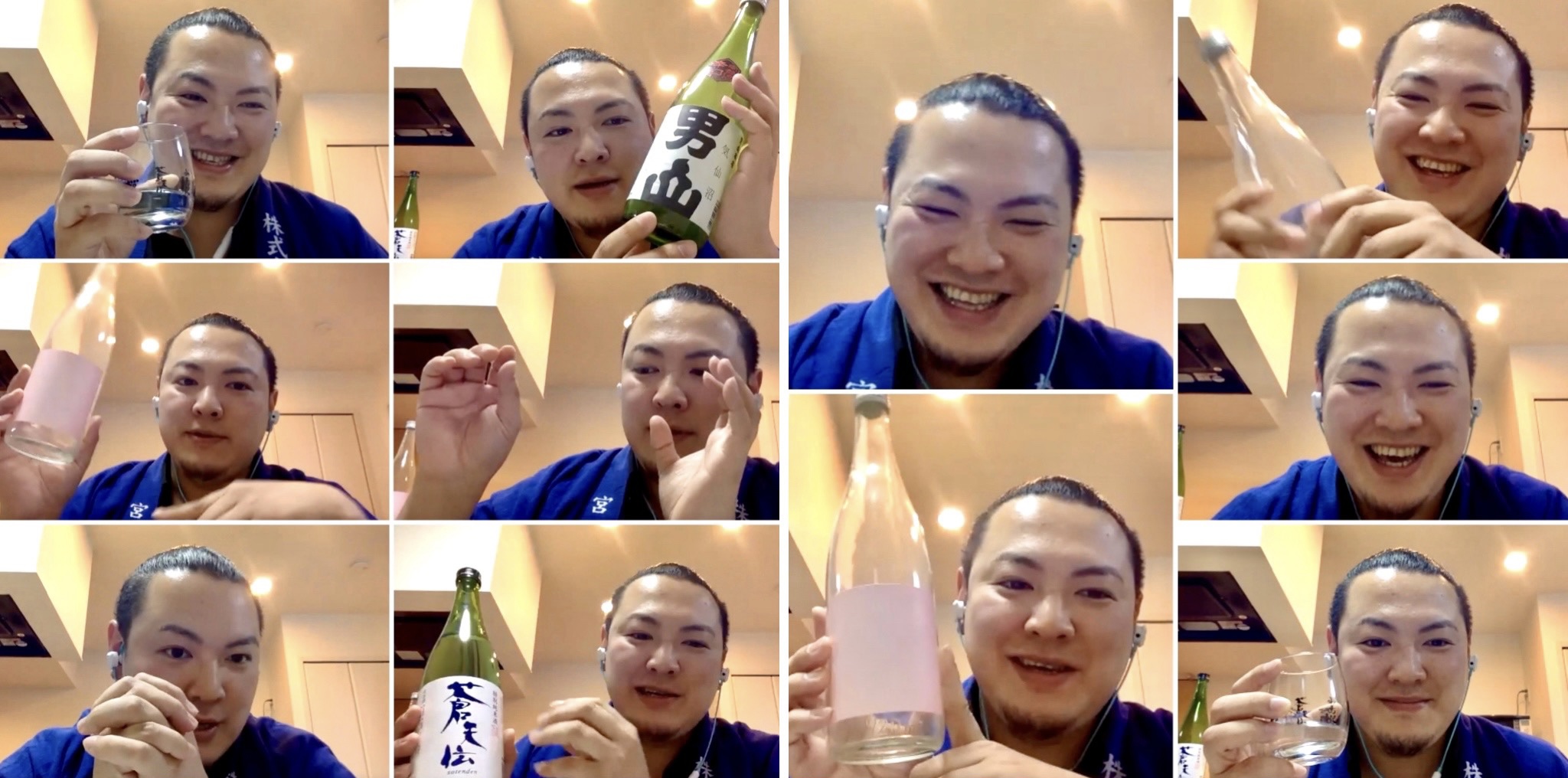
Monday 4th April, 2022, saw another fun, informative and engaging session of TWTT.
This was the 78th session in the TWTT series and it was great to be back in Miyagi prefecture to shine the spotlight, for the first time, on Otokoyama Honten.
Joining us for the session was 5th generation Kuramoto, Hiroki Sugawara.
Otokoyama Honten was established in the port town of Kesennuma, in Miyagi prefecture, in 1912. We learnt last night that his family started brewing sake due to local demand from the Kesennuma fishermen – who liked to start drinking sake around noon.
Otokoyama Honten currently produces 3 brands in their impressive line-up: Kesennuma Otokoyama, Sotenden and Biroku.
Hiroki Sugawara, son of the 4th generation Kuramoto, had no real intentions to join the family brewery. In fact, prior to coming back to his hometown to work for the brewery, he had been studying law. He attended university in Hokkaido. He also studied English in New York. He officially joined the brewery in 2017.
Sugawara-san put together a wonderful presentation that highlighted not only Otokoyama Honten but also the town of Kesennuma – a town blessed with such beautiful diversity of nature, from its pristine coastline to the lush mountain ranges.
Sadly, in 2011, the post town of Kesennuma was badly affected by the Great Eastern Earthquake and Tsunami. Like so many other areas, Kesennuma suffered great tragedies, with many lives lost, and large parts of the town’s infrastructure completely destroyed. Seeing how the community rallied after such tragic events was the main reason Sugawara-san decided to once again call Kesennuma home and start working at the brewery. He wanted to give something back to the community that had been so supportive of his and many other families despite their own heavy losses.
The brewery itself, due to its elevation, managed to survive the events of 2011 ~ however, their HQ building, built in 1932, within close proximity to the brewery, was destroyed. The restoration took 9 years and was completed in 2020. The original second floor was somehow able to be fully restored and is now part of their new HQ building ~ quite an amazing restoration!
For someone who was once pursuing a career far removed from anything to do with sake, Sugawara-san seems at home in his role and his enthusiasm and passion, (not only for his family’s brewery, but also for his hometown), certainly shine through brightly. The brewery, traditional in many ways, are also experimenting with progressive collaborations and interesting projects, such as their recent collaboration with craft beer brewery ‘Black Tide Brewing’, as well as their ‘Ocean Memory’ sake, which is bottle-stored in the ocean for a minimum of one year.
A truly interesting and enjoyable session and an amazing effort from Sugawara-san to present this session in English.
A huge thank you to Hiroki Sugawara for sharing his time, passion, vision and story with us. An extension of that thank you must go out to TWTT regular attendee and sake advocate, Yasuhiro Fujie, for introducing Otokoyama Honten to this project.
Of course, as always, thank you to everyone who attended.
Taste with the Tōji ~ Session 77:
Rumiko Obata
Obata Shuzo
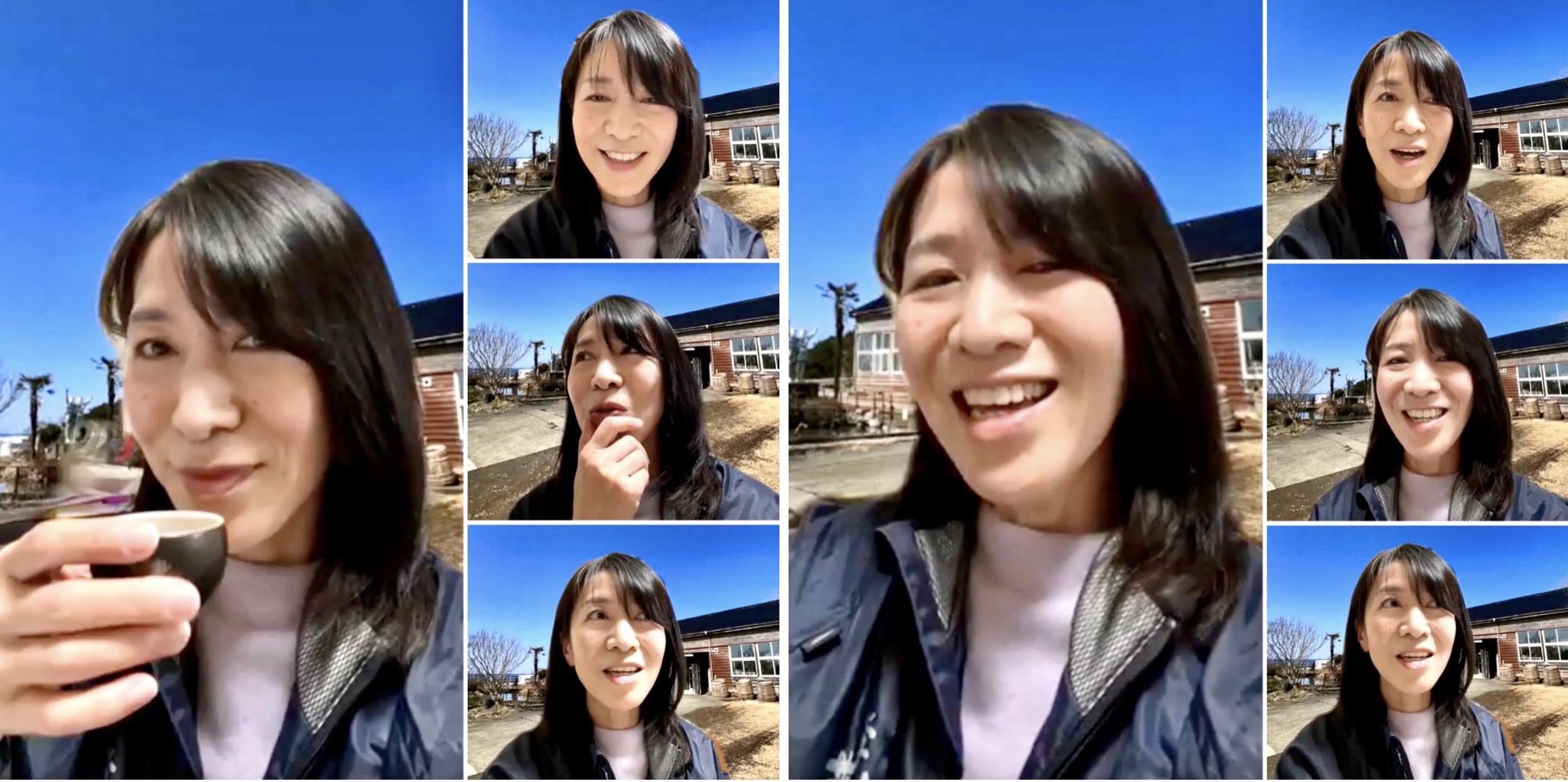
Monday 28th March, 2022, saw the 77th session of TWTT as we visited Niigata prefecture for the very first time in this series – hard to believe, I know!
Joining us for the first half of this session was the delightful Rumiko Obata. It was wonderful to not only have her talk about Obata Shuzo and Gakkogura but also a little about her personal journey and how it led her back to run the family brewery.
Rumiko Obata is the 5th generation owner of Obata Shuzo, producers of the popular Manotsuru brand of sake.
Due to time constraints, sadly Obata-san could only spend the first hour with us, however, her presentation covered a lot in such a short amount of time. It was great to hear about the local culture and happenings on Sado Island – from the picturesque landscape and natural beauty, to the local farming and agricultural communities, and of course Obata Shuzo and their second brewery, Gakkogura, which was once an old school. The school closed in 2010 due to a decline in local population.
Obata Shuzo decided to renovate and renew this old school building and turn it into a brewery, which doubles as a ‘brewery school’ – hence the name ‘Gakko’ (school) + ‘Kura’ (brewery), put together it’s ‘Gakkogura’ (brewery school). Brewing first started at Gakkogura in 2014. The brewery school came a little later and has developed progressively over recent years.
In contrast to Obata Shuzo, the sake at Gakkogura is brewed during the Summer months.
It was great to have an impressive number of Gakkogura alumni in the audience and we got to hear from some of them during the second half of this session, which kicked off with a wonderfully in-depth presentation from Harald deRopp based on his experience at Gakkogura, and some of his adventures with his fellow ‘schoolmates’ and some of the locals of Sado Island, back in 2018. It was also great to have Makarim Salman join this session and discussion. Mak has recently released a series of videos documenting his recent experience at Gakkogura which you can view
here.
A really enjoyable session that has no doubt inspired several future Gakkogura intakes and Sado Island explorers.
A huge thank you to Rumiko Obata for sharing her time, knowledge, experience and vision with us all. An extension of that thank you must go out to Harald deRopp for putting together such a wonderful Gakkogura/Sado Island presentation and for helping to finally get Niigata prefecture and Obata Shuzo on the TWTT map.
A big thank you also to Nozomi Aida from Obata Shuzo, who joined us later in the session – and of course to Michael Robinson, Cindy Bissig and Makarim Salman for sharing a little about their Gakkogura experiences.
Thank you to all alumni and attendees who joined this fun and unique session.
Taste with the Tōji ~ Session 76:
Nobuo Shoji
Yumegokoro Shuzo
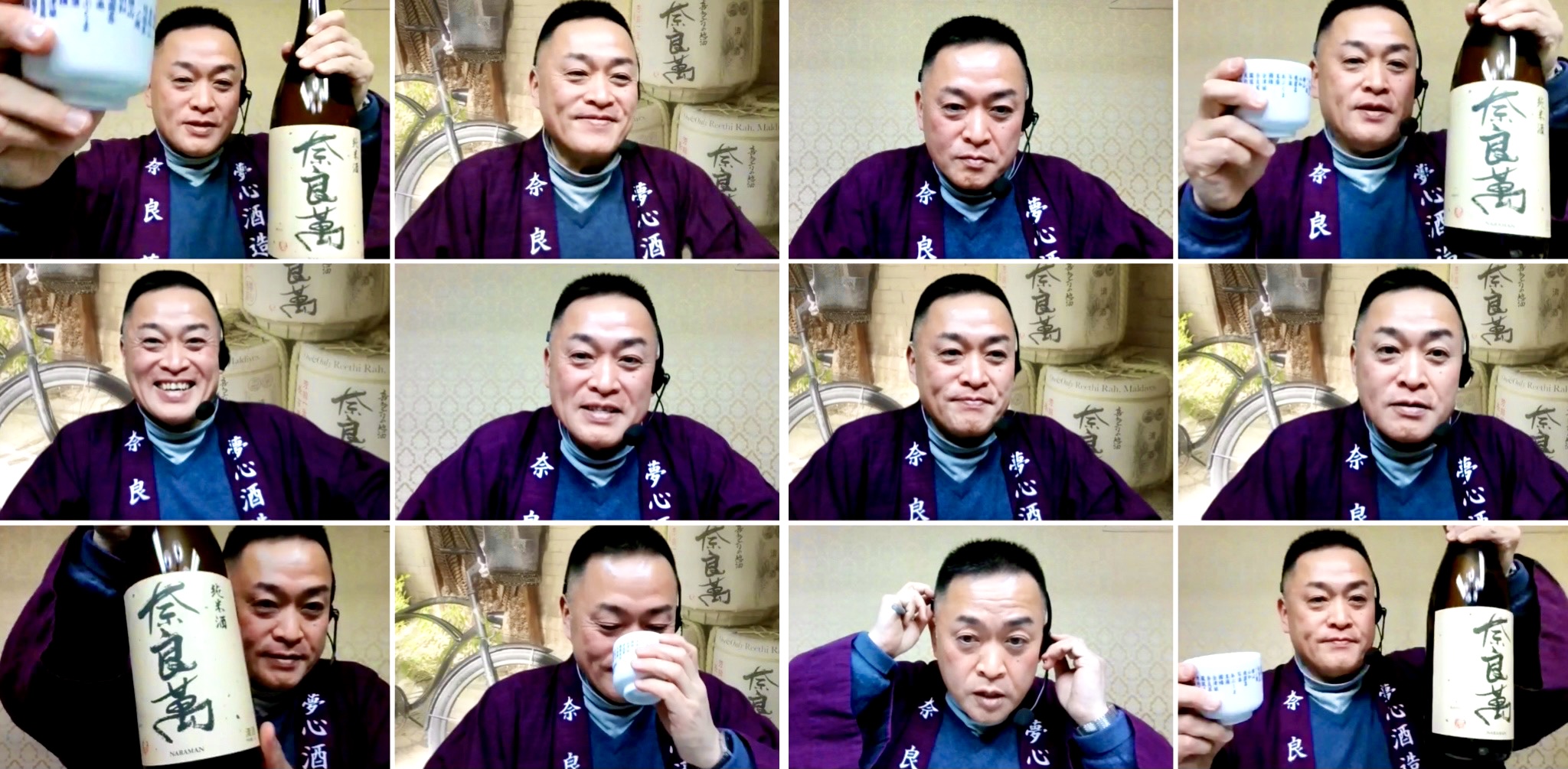
Monday 21st March, 2022, saw a wonderful TWTT session with Nobuo Shoji from Yumegokoro Shuzo in Fukushima prefecture.Looking very regal in his purple Happi coat, Shoji-san was an absolute joy to spend over 2 hours with for session #76 of TWTT.Yumegokoro Shuzo was established in Kitakata, Fukushima prefecture in 1877. Nobuo Shoji is the 6th generation of this family brewery who are the producers of the much loved ‘Naraman’ brand.Shoji-san came ready to answer lots of questions ~ encouraging them early on in the session, which opened up discussions about yeast (including space yeast!), rice, personal history and the story of Yumegokoro.Since 1996, the brewery has been focused on using rice grown in the Aizu region as well as Utsukushima Yume Kobo (yeast) developed by Fukushima prefecture, in order to create a truly local sake.Shoji-san also talked a lot about evolution, with regards to their sake. His aim is to ensure that their sake is constantly evolving – as he explains it: “We evolve precisely so we can stay the same”… IYKYK

We also discovered that Kitakata is famous for ramen – like we didn’t already have enough incentive to visit with sake!! Looks like Shoji-san will be drinking sake and eating ramen with any TWTT members who get the chance to visit him in Kitakata.Shoji-san also presented a short visual presentation to show us the inside of the brewery with its most impressive, highly automated set up and uniquely shaped tanks that looked like they might launch into space at any given moment.It was also interesting to hear that only 30 years ago, the brewery was producing 10 times what they produce today. Currently, they are producing around 1000 koku each brewing year.This session was a lot of fun, incredibly informative and wonderfully interactive – it was so great to have
Rumiko Moriki join this session and listen to her and Shoji-san get super geeky towards the end of the session. It was also great to see a few others joining from breweries that have been featured, and a couple that are due to be featured, on TWTT.This session was of course made even more enjoyable by the wonderful interpretation, passion and energy from John Townsend. It was John’s first time interpreting for TWTT and he did an incredible job and it was clear to see how big a place this brewery has in John’s heart.A huge thank you to
Nobuo Shoji for sharing his time, knowledge, philosophy and passion with us all. An extension of that thank you goes out to
John Townsend.Thank you also to everyone who attended this session.
Taste with the Tōji ~ Session 75:
Koichi Saura & Kunio Onodera
with Jess Hallams
Urakasumi Sake Brewery
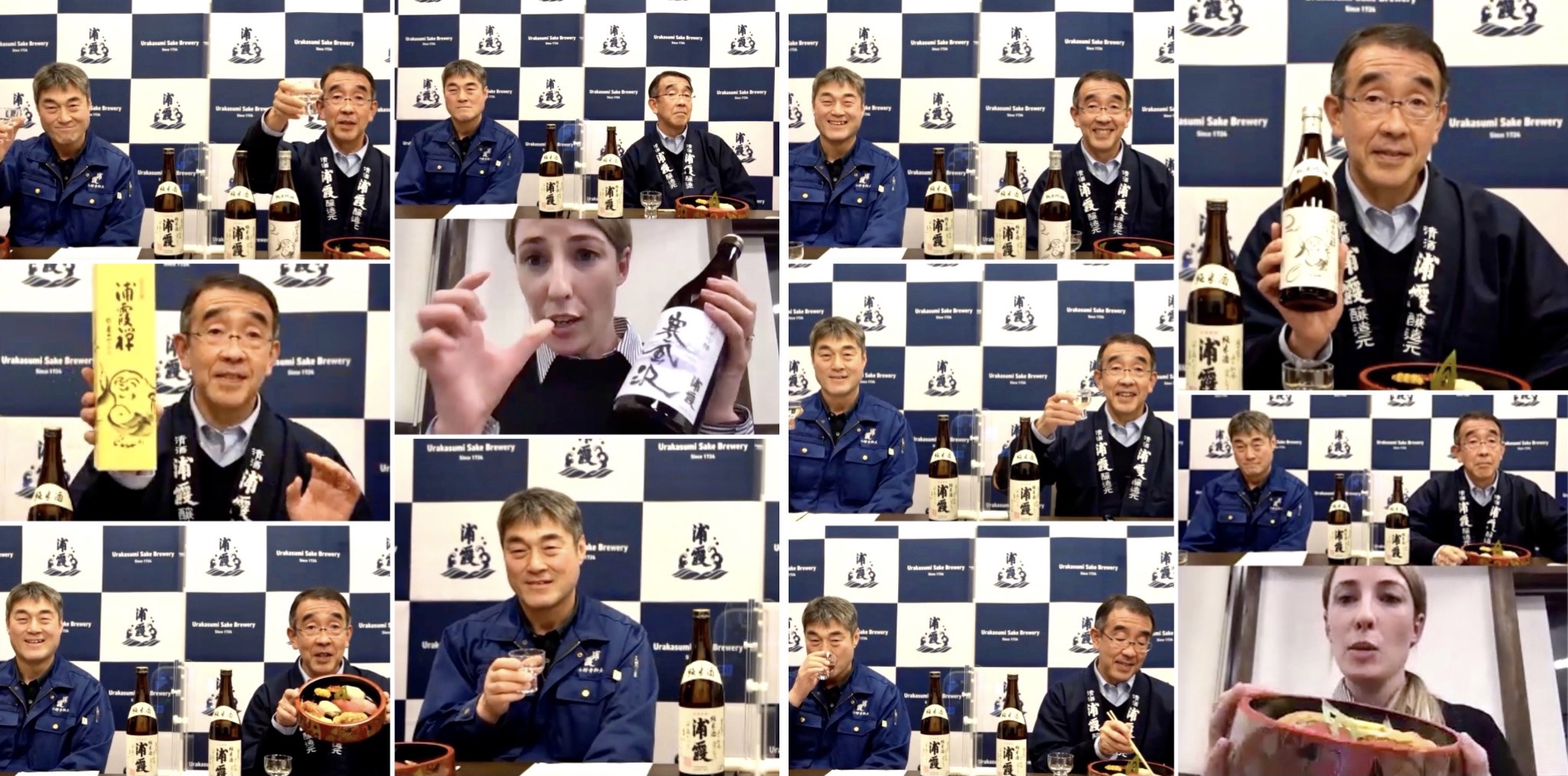
Monday 14th March 2022 saw a wonderful TWTT session as we headed to the beautiful Miyagi prefecture for the 75th session in this series.
It was an honour to have both Koichi Saura, the 13th president of Urakasumi, as well as Toji, Kunio Onodera. In addition, it was an absolute delight to have Jessica Hallams from In-Outbound Sendai | Matsushima on board for this session. Jess not only did a fabulous job interpreting for this session, she also facilitated a wonderful presentation on not only Urakasumi, but on the local sights, cuisine and experiences on offer in and around the Shiogama region – putting this divine part of Japan on the wish list/itinerary of many who were watching. Many keen to get involved with some of the enticing Sake Tourism experiences offered in Miyagi, including the Urato Islands rice project. More info here and here.
This brewery and the region have such a wonderfully rich culture and history. It was surprising to hear the 2019 tourism stats (based on around 32 million visitors) – showing that under 3% of travellers to Japan visited the Tohoku region – even more inspiration and incentive for those watching to get over there as soon as it is possible to do so. Only 90 minutes by train from Tokyo, not only is this area surrounded by exquisite nature and scenic beauty, including the beautiful Matsushima Bay, the area is also famous for its salt, along with its oysters, tuna and their kamaboko fish cakes.
A famous fishing port town, Shiogama is well known for its rich culinary culture – with an abundance of seafood. Attendees were left drooling as our guests at the brewery were presented with a delicious looking selection of local sushi.
Urakasumi Sake Brewery was founded in 1724 – they are just a couple of years shy of celebrating their 300th year! When asked if they have anything special planned for this upcoming and impressive achievement, we were told not as yet but they are putting their thinking caps on now. We look forward to seeing how they will celebrate this momentous occasion. Urakasumi is actually made up of 2 breweries – whilst the original brewery was established in 1724, their second brewery, ‘Yamoto Brewery’, was established in 1994.
The name Urakasumi comes from an ancient Japanese poem referencing the pleasure of Spring’s arrival to the bay. ‘Ura’ – meaning ‘Bay’, and ‘Kasumi’ – meaning ‘Mist’. The name suits the characteristics of their sake, which Urakasumi describe as ‘classic and elegant’.
This session was full of fun facts, stories and information – from the brewery’s own original cultivated yeast (#12) to the tale behind the happy Buddha pointing at the moon on their Zen label. As always, so much to cover in so little time. The 2 hours flew by but were incredibly interesting and enjoyable.
A huge thank you to Saura-san, Onodera-san and of course the fabulous Jess Hallams for a truly wonderful TWTT session. Thank you also to the inspirational Toshie Hiraide and to Atsuko Radcliffe ( Small Forest Wines ) for speaking with us during this session. As always, much love and thanks to everyone who attended this session… and a special thank you to the ‘behind the scenes’ crew at Urakasumi – making sure everything ran smoothly!
Taste with the Tōji ~ Session 74:
Shigeki Tonoike
Tonoike Shuzoten
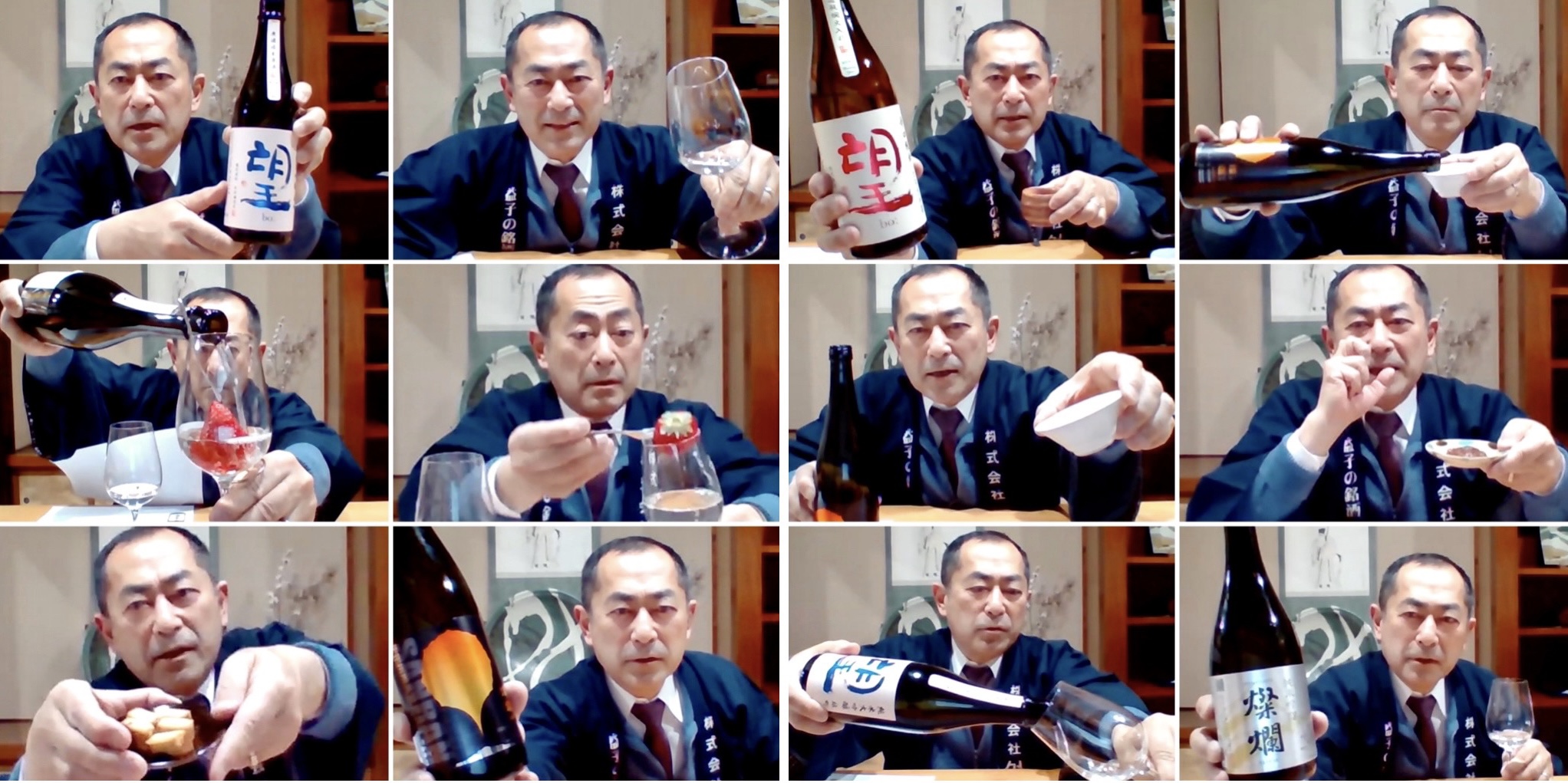
Monday 7th March, 2022, saw a delightful session of TWTT. After a 2 week break, it was wonderful to be back in the Zoom room, for session #74 of TWTT, with a bunch of awesome people and the delightful Shigeki Tonoike from Tonoike Shuzoten.
It was great to be able to shine the spotlight on another Tochigi brewery and I have no doubt, if Tochigi wasn’t already on most attendee’s itineraries, it will be now.
Tonoike Shuzoten, despite being a ‘fairly young’ brewery, has a most interesting history. The current brewery was founded in Mashiko in 1937, by Itsuroro Tonoike, however, the family has been making sake in Tochigi since 1829.
Also joining us for this session to help behind the scenes was Satoshi Miyata.
Tonoike-san put together a wonderful presentation and did an amazing job of presenting the entire session in English.
As always, 2 hours is just not enough time to cover everything but we managed to cover a lot in the limited time we had – including brewery/family history, the brewery’s Sanran and Bo brands, a little about the local pottery (Mashiko town is famous for pottery), the incredible looking local strawberries, as always, lots of rice talk, and much more.
The video component gave us a look inside the brewery during brewing season with some great commentary from staff, answering questions about what brewing sake means to them.
Shigeki Tonoike is the 3rd generation of this family brewery. With each generation, has come a new label addition to the brewery’s line-up. As third generation, the most recent is their label ‘Bo:’, which symbolises ‘hope’, or, in this case, more specifically ‘hope for the future’. With people like Tonoike-san at the helm, I think we all have a lot of hope for the future of Sake!
Despite presenting the session in his non-native tongue, Tonoike’s hope, passion and philosophies certainly came through clearly and most definitely resonated with everyone in attendance ~ including his touching final words when he welcomed everyone to come and visit him (when they can) and more importantly, that he wishes for everyone to be able to drink sake in PEACE – (World Peace that is).
Tonoike-san, we all hope for that too.

A truly fun, informative and heartfelt session. A huge thank you to Tonoike-san for sharing his time, generous spirit, humour, passion, knowledge and hope with us all. An extension of that thank you goes out to Charles Stewart for helping to get Tonoike Shuzoten on the TWTT map and the itinerary of many in the TWTT community! Thank you also to Harald DeRopp for his help and of course to everyone who attended this session.
Taste with the Tōji ~ Session 73:
Youichi Okada
Okada Honke
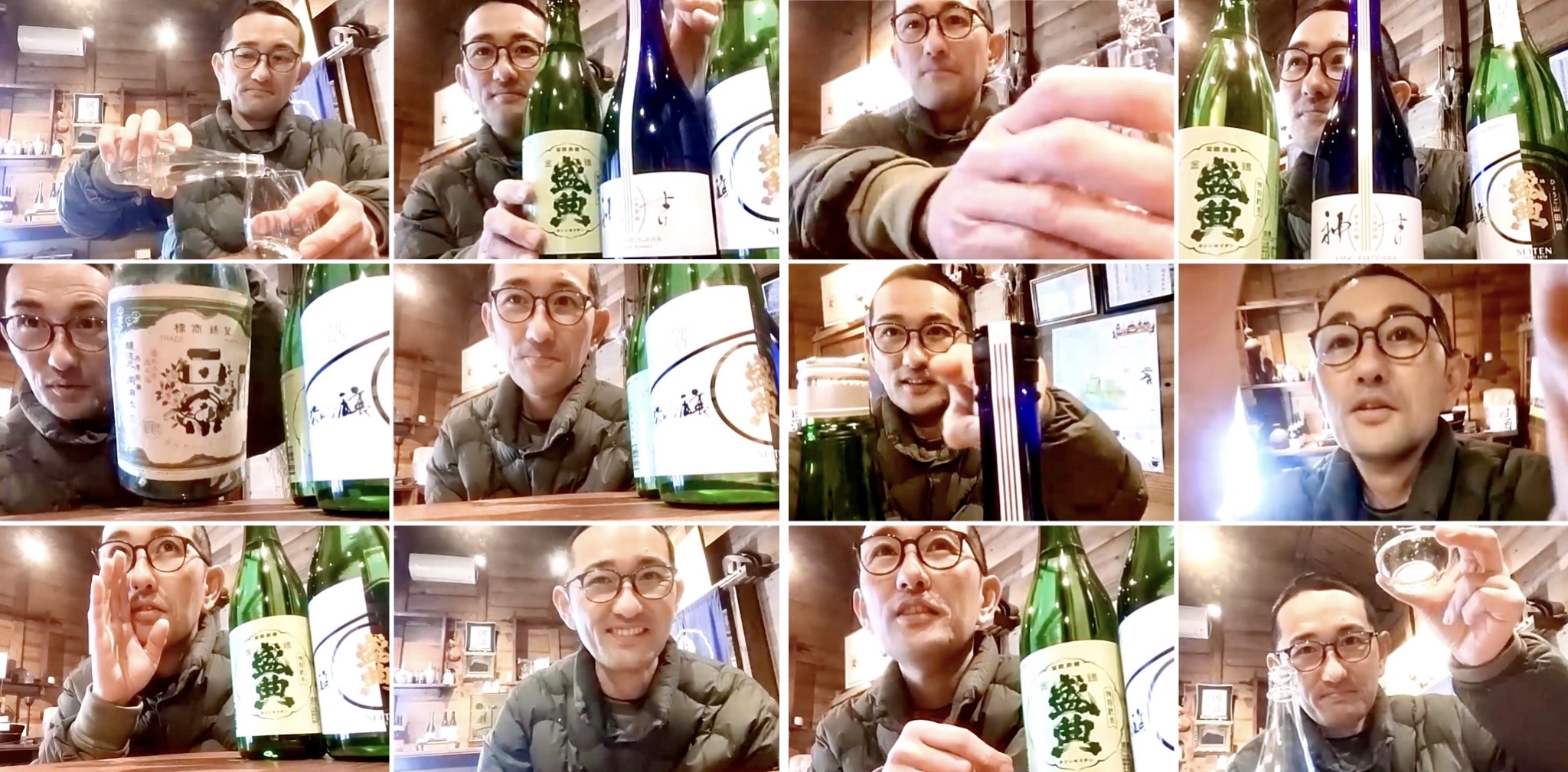
Monday 14 February, 2022, saw the 73rd session in the TWTT series take place. For this session, we traveled to Hyogo prefecture, to the town of Kakogawa, to feature Okada Honke ~ producers of ‘Seiten’.
We were joined by Kuramoto, Youichi Okada.
Okada-san led us on a wonderful virtual tour of his small kura. We even got a look inside what may possibly be the smallest shubo room – or shall we say, shubo closet.
Okada-san’s ancestors actually began the family business as farmers. Their farmed land included around 120 hectares of rice fields. After farming these fields for a period of time, the idea of brewing was ignited when an opportunity to obtain a brewing license arose. That was around 148 years ago, and Okada Honke have been brewing sake ever since – however, they were not always brewing under their own brand. When the industry was thriving, there were around 15 or so breweries in Kakogawa. Over time, as the industry faced many hardships, the local breweries began to close, one by one. Okada Honke were looking like they might be following in the footsteps of those who had no choice but to permanently close their doors. Instead, they managed to keep their business alive through brewing sake for a larger brewery (Hakutsuru Shuzo). This meant that Okada’s own brand was no longer produced, but this meant, in a roundabout way, that the family business was still functioning. Around 11 years ago, Okada Honke did a 360 on that roundabout and restarted their own brand when they finally resumed production under their own label after many years of producing sake under Hakutsuru’s. This saw the brewery go from producing around 7000 koku per year to a humble 100 koku, but they got their identity back and a little later, got themselves an experienced Toji, who Okada-san had worked under during the time of producing sake for Hakutsuru.
To this day, it’s still just the 2 of them (the Toji and the ex-Toji-now-Kuramoto) brewing at Okada Honke, which now just happens to be the only sake brewery in Kakogawa.
The brewery produces sake for a mostly local customer base, however ,after last night’s session, Okada Honke certainly now has a keen and curious global fan base who will hopefully, someday soon, have the opportunity to taste this sake for themselves. The brewery currently exports a very small amount of their sake to South Korea and Hong Kong. In time, we hope to see a few other countries on that export list. For now, many of us will just wait for travel to Japan to open up again so we can head straight to the source!
A huge thank you to Youichi Okada for sharing his time, knowledge and stories with us. An extension of that thank you must go out to Maki Tanaka for another wonderful interpretation and also to my dear friend Hanna Takemoto for helping to make this session happen.
Thank you also to everyone who attended this session.
Taste with the Tōji ~ Session 72:
Yasuhiro Watanabe
Watanabe Sahei Shoten
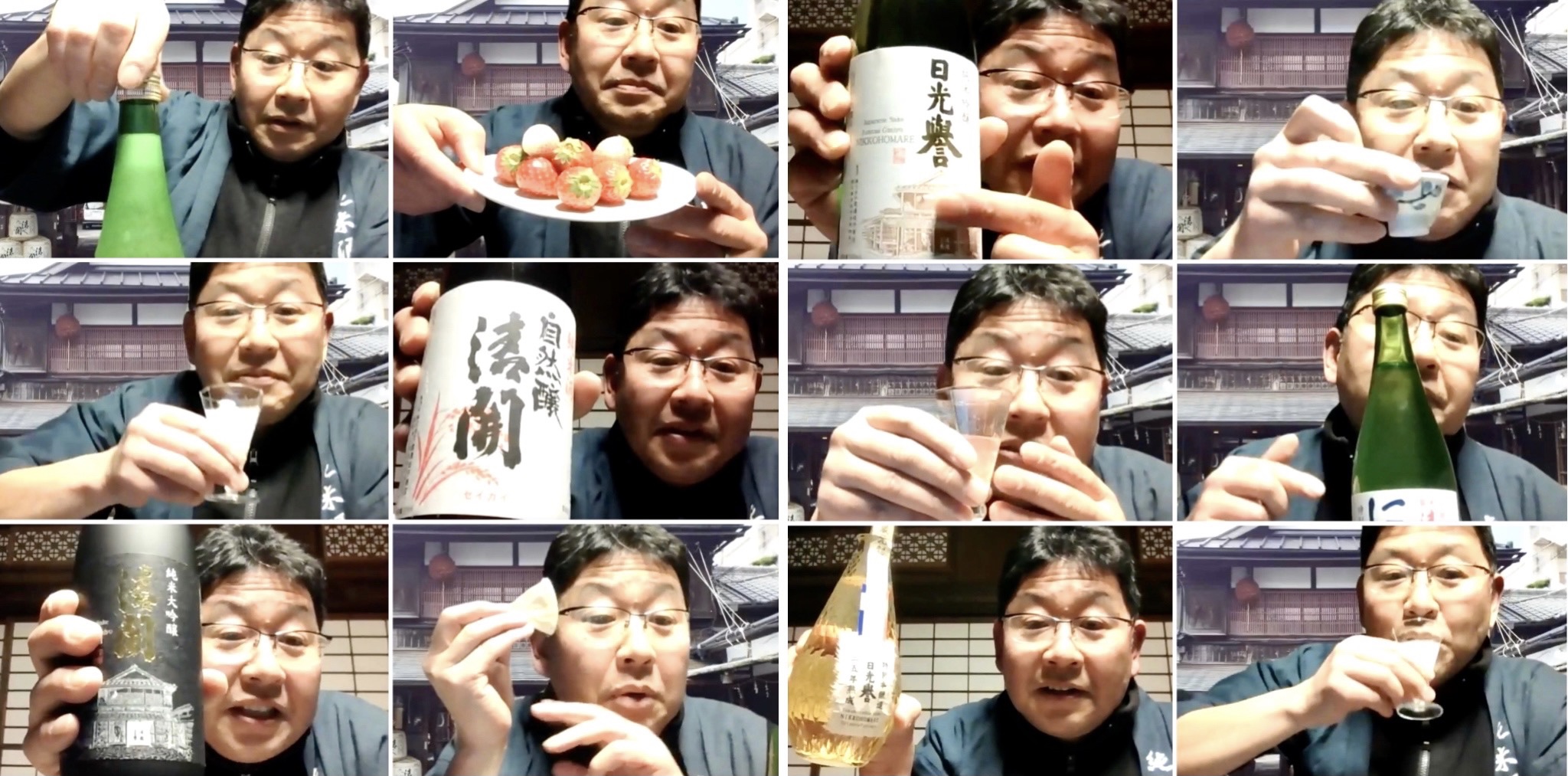
Monday 31st January saw the second TWTT for 2022, and the 72nd session in the series, as we headed to Tochigi prefecture to feature Watanabe Sahei Shoten.
We were joined by the 7th generation Kuramoto, Yasuhiro Watanabe, along with his joyous spirit and infectious humour.
Watanabe Sahei Shoten is located in Nikko City. It is a traditional, small, family-run brewery and they have been brewing sake since 1842.
They also produce a small range of Shochu, including one that’s a sake base and one that uses sake kasu.
About 90% of the sake they brew is Junmai and they are strongly focused on using rice grown within Tochigi prefecture. In addition to their use of local Tochigi rice, we were told they are even using Tochigi-grown Omachi, which, of course, is native to and commonly sourced from Okayama prefecture. They also produce a red/blush-coloured sake made from black rice.
Watanabe-san had a chance to show off his wonderful English skills, doing the whole session in his non-native tongue. He was once an exchange student here in Australia – in the city of Adelaide (South Australia). He attributes his language skills greatly to that experience and clearly loves an opportunity to practice his already savvy English skills.
We were treated to a great live virtual brewery tour by Watanabe-san where we got to see (and hear) a variety of active ferments happening in the shubo tanks and the moromi tanks. The inside of the building itself was also a joy to view.
After the tour, Watanabe-san presented a range of sake to us, alongside a selection of sake snacks, including Tochigi’s famous strawberries and Kombini cheese!
This was truly a fun session, filled with laughter, learning and the kind of joyous energy that we all so very much need right now.
A huge thank you to Yasuhiro Watanabe for sharing his time, English skills, humour, knowledge and wonderfully tenacious spirit with us all. An extension of gratitude must go out to Cindy Bissig for connecting me with Watanabe-san and helping to put Watanabe Sahei Shoten on the 2022 TWTT calendar.
Thank you also to everyone who attended this session.
Taste with the Tōji ~ Session 71:
Hideyuki & Nobuyuki Komai
with Yumi Takahashi
Hachinohe Shuzo
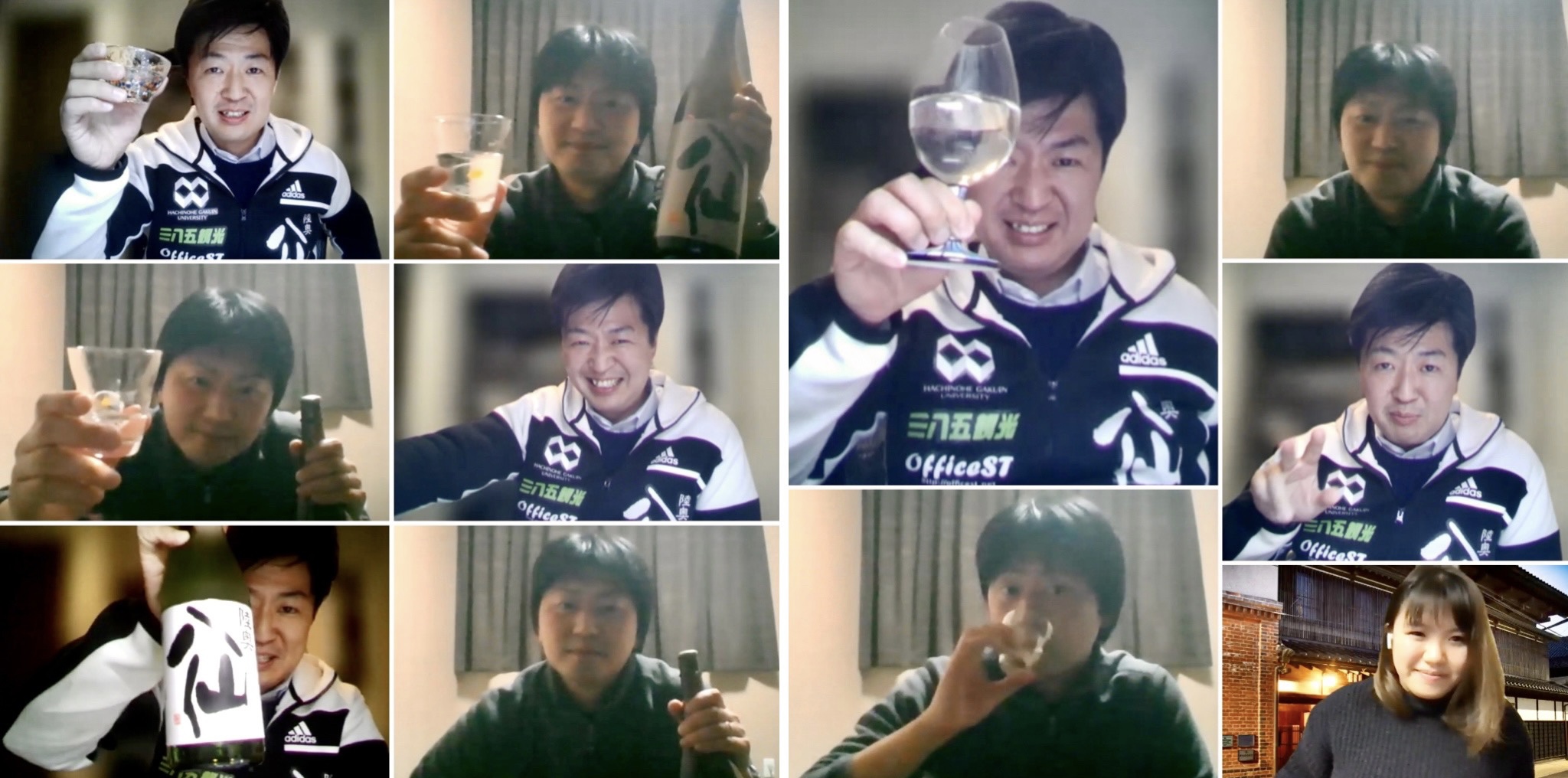
Monday 17th January saw the return of TWTT with the first session for 2022 and the 71st in the TWTT series of online events – a project that began back in April of 2020.
Not only was this the first event on the TWTT 2022 calendar, it was also the first time for TWTT to visit Aomori prefecture.
The featured brewery for this session was Hachinohe Shuzo – producers of the much loved Mutsu Hassen sake, and their more local brand, Mutsu Otokoyama.
We were joined for this session by brewery brothers, Hideyuki Komai and Nobuyuki Komai, who along with Yumi Hassen Takahashi, gave a wonderful presentation to kick things off for this 3rd TWTT season.
Hideyuki is the 9th generation President at the brewery and his younger brother, Nobuyuki, is the Toji.
The brewery has an interesting history, in the fact that the business was first established in Shiga prefecture, in the Omi area, back in 1740. They began brewing sake at this location in 1775, where they continued to brew for around 100 years until relocating to Hachinohe City in Aomori prefecture in 1888.
Hachinohe is a port city/town, and the brewery backs onto the river that flows through the city. Their presentation gave us a little insight to the history, culture and cuisine of the area, adding it to the wish-list on many TWTT attendee’s ever-growing itineraries for when travel opens up again.
In 2002, they shifted their focus to using local, organically grown rice and local yeast. Around 10% of the rice they use is grown in their own fields, the rest is grown by local contract farmers. As always with these sessions, there is so much to learn and further explore – and 2-3 hours only begins to scratch the surface.
Like most sessions, the topics of rice and koji were of great interest, prompting questions and deeper discussion on the topics. Something of great interest was their Ganja Natural Sake Club. The word ‘Ganja’, in the local dialect, relates to an area of land close to a populated area that remains intact or undeveloped. Through this club, people come together not only to plant and harvest organic rice, but to help preserve the local, natural environment. It’s a great concept/project and one that certainly piqued the interest of many TWTT community members. They could be inundated with membership applications this year. Registration opens in April and details can be found here:
https://mutsu8000.com/en/ganja-shizenshu-club/Another strong point of discussion was white koji, which the brewery started using in 2015. The idea behind introducing white koji was to eliminate the use of or need for the addition of lactic acid in their starter fermentations. The result of using white koji incorporates a higher level of citric acid. This method adopted by Hachinohe Shuzo sees a higher temperature and faster ferment for their shubo (starter ferment) than most breweries, with the shubo done in around only 2 days! Although not confirmed, Nobuyuki believes they are the only brewery using a white koji shubo for all of their sake! Again, a rabbit hole we could have gone far deeper into… perhaps another session down the track!
A truly great session to kick-off TWTT for 2022.
A huge thank you to Hideyuki Komai and Nobuyuki Komai for sharing their time, (far more than the scheduled 2 hours), knowledge, passion and vision with us all. An extension of that huge thank you must go out to Yumi Takahashi for her time, contribution and effort put into the session’s presentation, and of course to Christopher Hughes, for bringing this session to the table and bringing his A game with another wonderful interpretation!
A big thank you to everyone who attended this session and to
Sake Boutique for bringing Mutsu Hassen sake to Australian shores and into the homes of the Australian TWTT members.
Taste with the Tōji ~ Season 2021
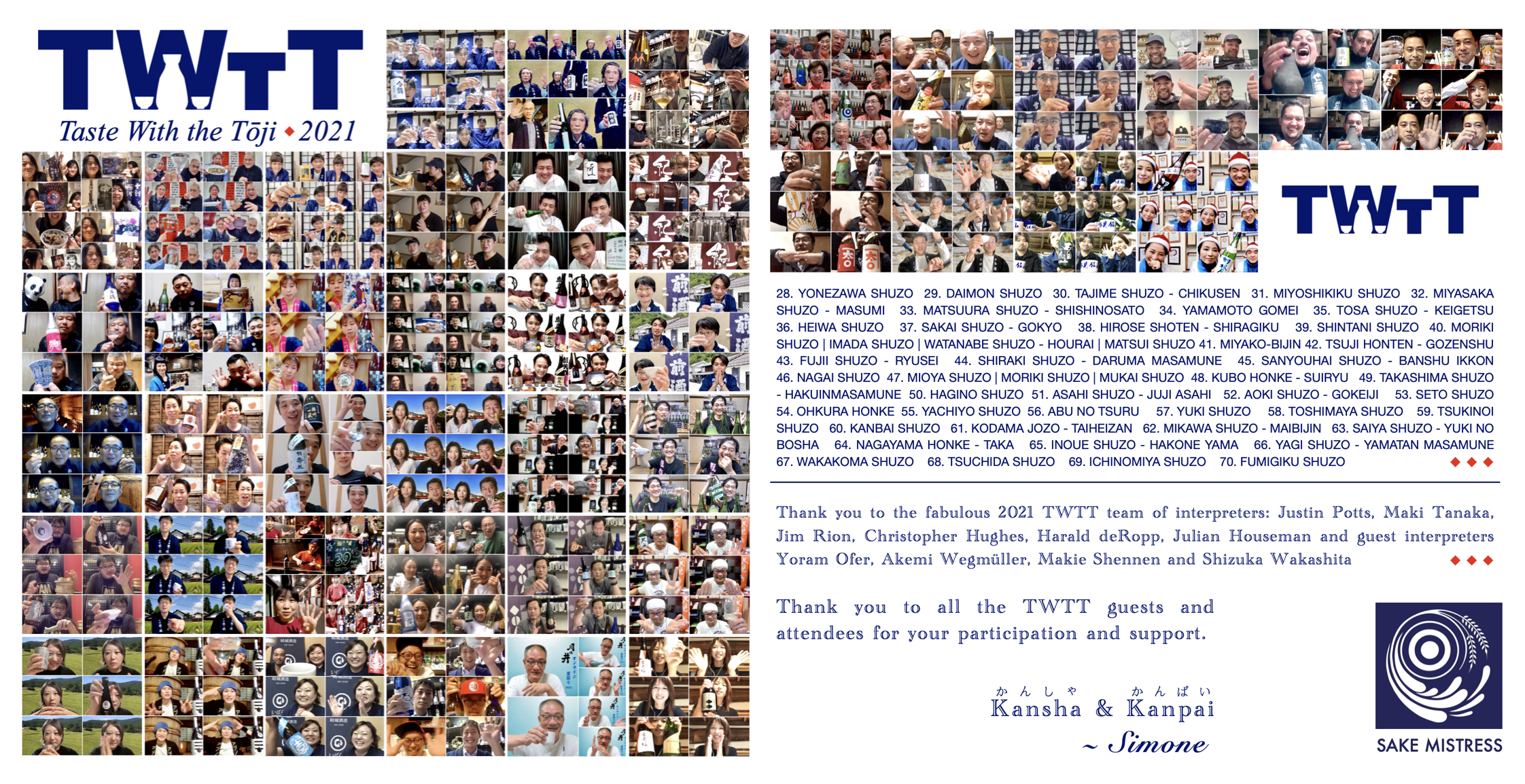
Taste with the Tōji ~ Session 70:
Chizuko and Keiki Hane
Fumigiku Shuzo
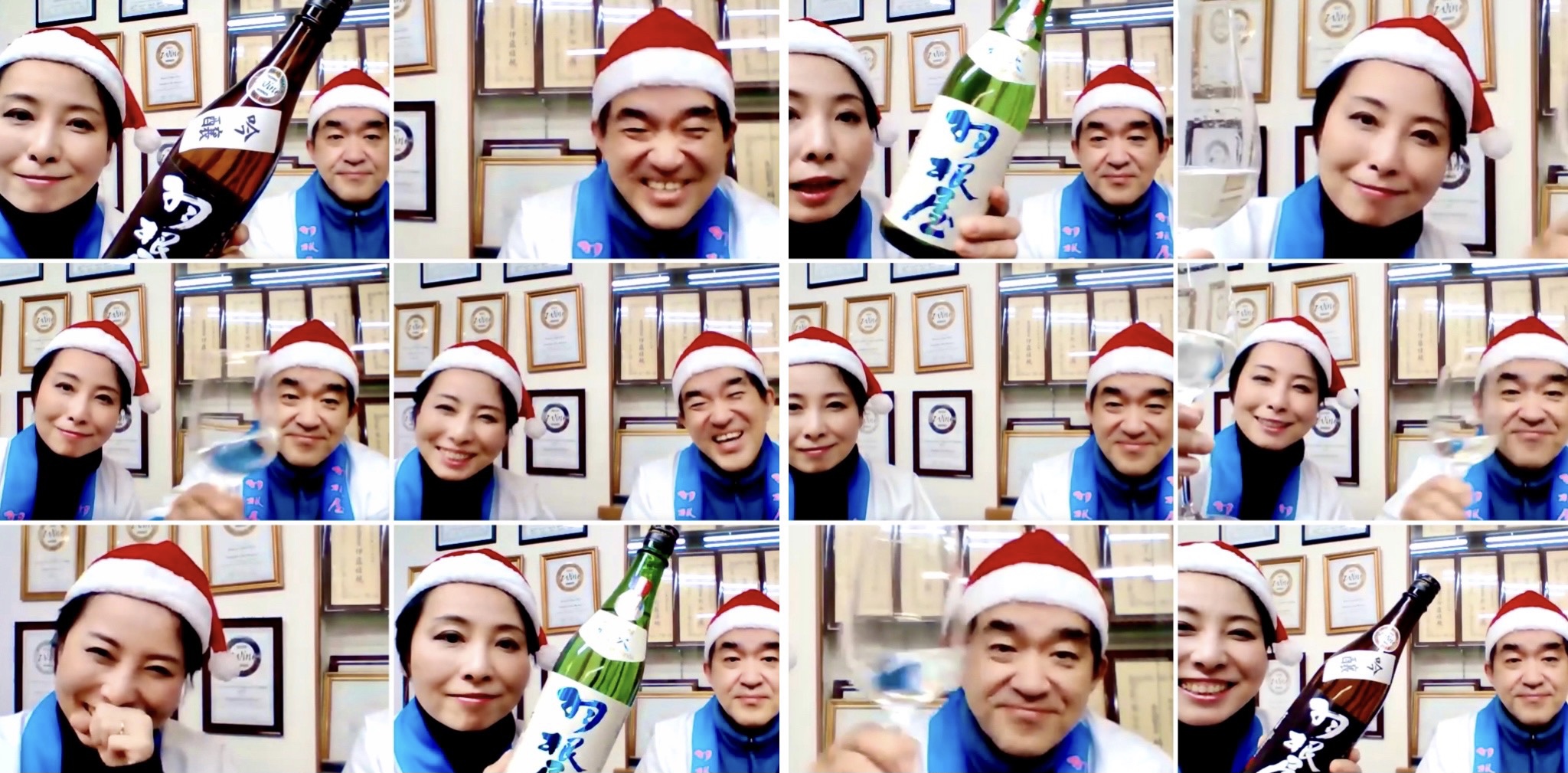
Monday 20th December, 2021, saw session #70, and the final TWTT session for 2021, take place as we Zoomed into Toyama prefecture to feature Fumigiku Shuzo, producers of Haneya sake.
Joining us from the brewery, dressed in their festive best, were husband and wife team, Keiki and Chizuko Hane.
Fumigiku Shuzo was established in Toyama City in 1916. Keiki Hane is the 4th generation owner of this small family brewery.
Keiki had not intended to take over the family brewery. He was pursuing a career in teaching, (elementary), however, when his older brother sadly passed away, he decided to return to the brewery to continue his family’s legacy.
Despite their small size, Fumigiku Shuzo currently produces around 1000 koku each year. They are amongst the smaller percentage of breweries who actually brew sake all year round, as opposed to only brewing in the Winter and colder months. The bulk of their sake is produced during the colder months and they spoke a little about some of the challenges they incur brewing outside of those times – like having to make adjustments for the faster fermentation in the warmer months – but none big enough to deter. Since taking over as Toji, Keiki Hane has made distinctive changes to the style of sake they produce, he explained he had a strong desire to produce a fresh style of sake all year round for their customers to enjoy. They have been brewing all year round since 2012.
A lot of the rice they use is grown in Toyama prefecture, namely Gohyakumangoku. The brewery does not grow any of their own rice – too busy brewing sake all year round – opting instead to support local farmers growing high quality sake rice.
The sake they produce all year round is labour intensive, but also a labour of love ~ a love the Hanes hope the consumers feel when they drink Haneya sake. They had us all salivating when they spoke about pairing their sake alongside some of Toyama’s seafood, including small white shrimp, firefly squid and other local delicacies. Toyama City is a coastal city, located on the coast of the Sea of Japan, and the local cuisine is another thing that inspires Fumigiku to produce their fresh nama style sake all year round.
This was the first time TWTT has visited Toyama prefecture, a place I have only seen bits of from a train, however, I feel this place will be on the itineraries of many who attended this session, especially once travel opens up again.
A huge thank you to Chizuko Hane and Keiki Hane for sharing their time, passion, humbleness and philosophy with us all. An extension of that huge thank you must go out to Harald deRopp, AKA the TWTT Santa, for another great interpretation and for sharing his sake passion and love for this brewery with us all.
Thank you also to everyone who attended this final session for 2021. It’s been a huge TWTT year that saw a whopping 43 TWTT sessions, (as well as 5 ‘MTA’ sessions and 4 ‘In Conversation and Q&A’ sessions).
A big heartfelt Kansha and Kanpai to all of the TWTT guests and attendees for their support for this project and for helping to grow such a wonderful sake community.
Taste with the Tōji ~ Session 69:
Rika and Satoki Asano
Ichinomiya Shuzo
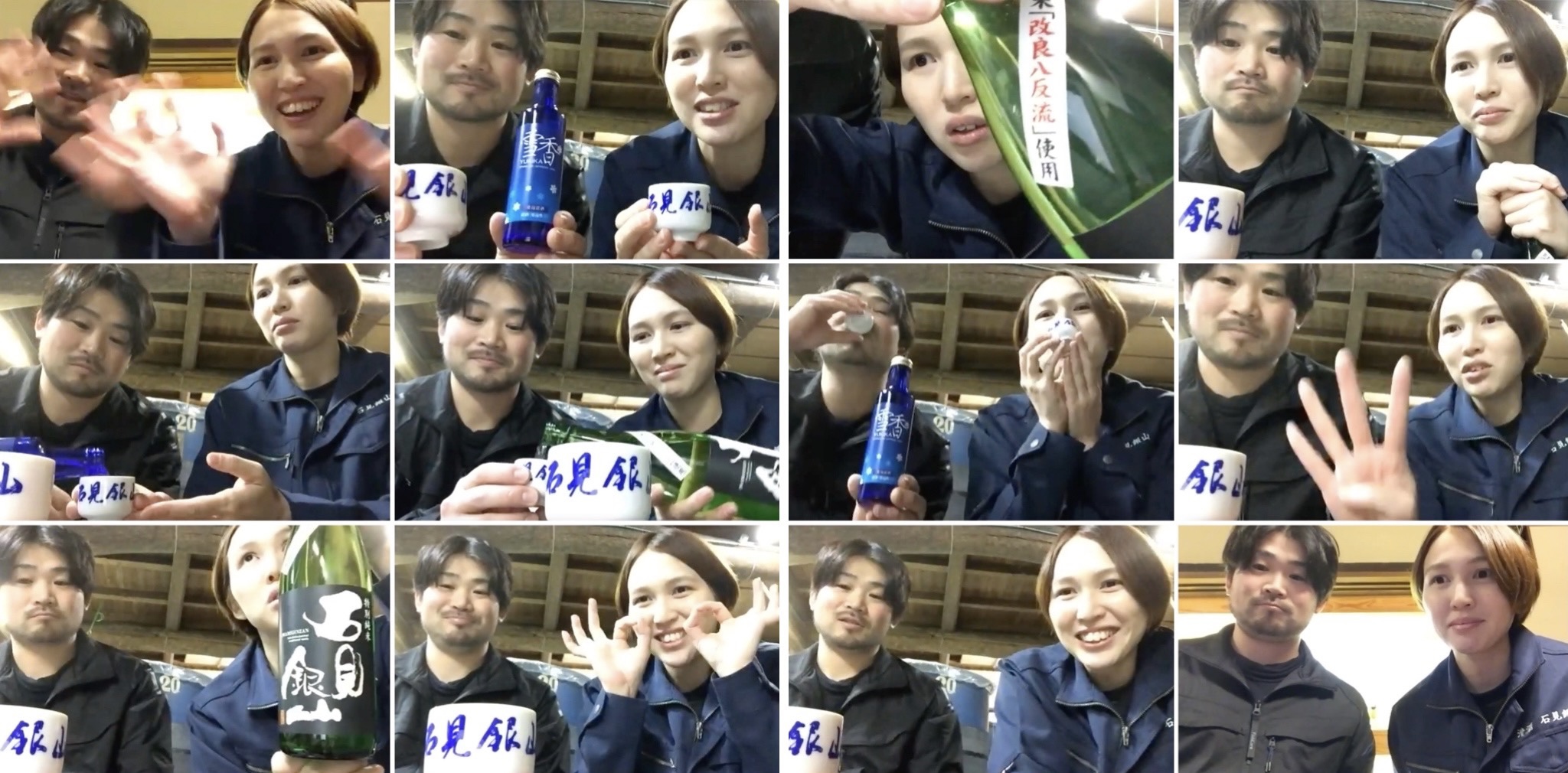
Monday 13th December, 2021, saw the 69th session in the TWTT series take place as we Zoomed into Shimane prefecture to shine a spotlight on Ichinomiya Shuzo.
Joining us for this session were the delightful sake duo, Rika and Satoki Asano.
Ichinomiya Shuzo was founded in 1896, in Oda City, Shimane, (on the coast of the Sea of Japan).
Rika is the second of three ‘brewery family’ sisters. The only sibling to take an interest in taking over the family business, Rika went to Tokyo to study brewing and fermentation. She worked at the brewery under the previous Toji before taking over that role in 2017. Her father is currently Kuramoto. Rika will go on to be the 5th generation successor.
Satoki, who prior to joining the brewery was actually working as a nurse. He met Rika at an Izakaya. The two were introduced by mutual friends and to Rika’s delight, she made a friend that night who loved sake. They later married and Satoki left nursing and began working for the Asano family’s brewery. The two of them have now been brewing together at Ichinomiya for 5 years.
It was truly a joy chatting to this delightful couple and hearing their stories and how their differences complement each other both in life and in brewing. They have also recently welcomed a new addition to the Asano family. At the kura, they have just one other part time team member who helps out during brewing season, which for them starts in December and concludes late Feb/early March. Needless to say, this young couple certainly have their hands full. Fortunately, they also have tremendous help from family and friends that allows them to keep doing what they do.
Duringthis session we got a look at a few areas in the brewery during a ‘mini-tour’ which included a close look at a fresh batch of koji they had just finished. We also got a look inside one of the tanks, which is always a joy – to see a ferment bubbling away happily, on its way to becoming sake.
Once again we heard a brewery tell us of the importance of local rice, with much of the discussion this time revolving around Shimane’s own Kairyo Hattan Nagare – a rice that growers had started to abandon over time as it was top heavy, with long stems, and susceptible to falling over, making it hard to grow. However, it has seen a revival in recent years and Ichinomiya Shuzo are among the handful of breweries embracing that revival.
We spoke a little about their label Iwami Ginzan, named after the local Silver mine, which was active for almost 400 years! The mine was discovered in 1526 and closed in 1923. A rich part of the city’s history, the site is now a huge drawcard for tourists to the area.
The other label Ichinomiya Shuzo are known for is Rika, named of course after the woman herself! A much more recent addition but a label they hope to expand on and introduce to sake drinkers all over the world.
As always, there was still so much more we could have talked about, asked and learnt but we had to keep our eye on the time for this one due to their brewery and family commitments.
A huge thank you to Rika Asano and Satoki Asano for sharing their precious time, stories, insight and vision with us all. An extension of that thank you must go out to Christopher Hughes for yet another tremendous interpretation. I’m forever grateful to all who help to make these sessions accessible to a wider audience through interpretation.
Thank you also to everyone who attended this second last session for 2021.
Taste with the Tōji ~ Session 68:
Yuji Tsuchida
Tsuchida Shuzo
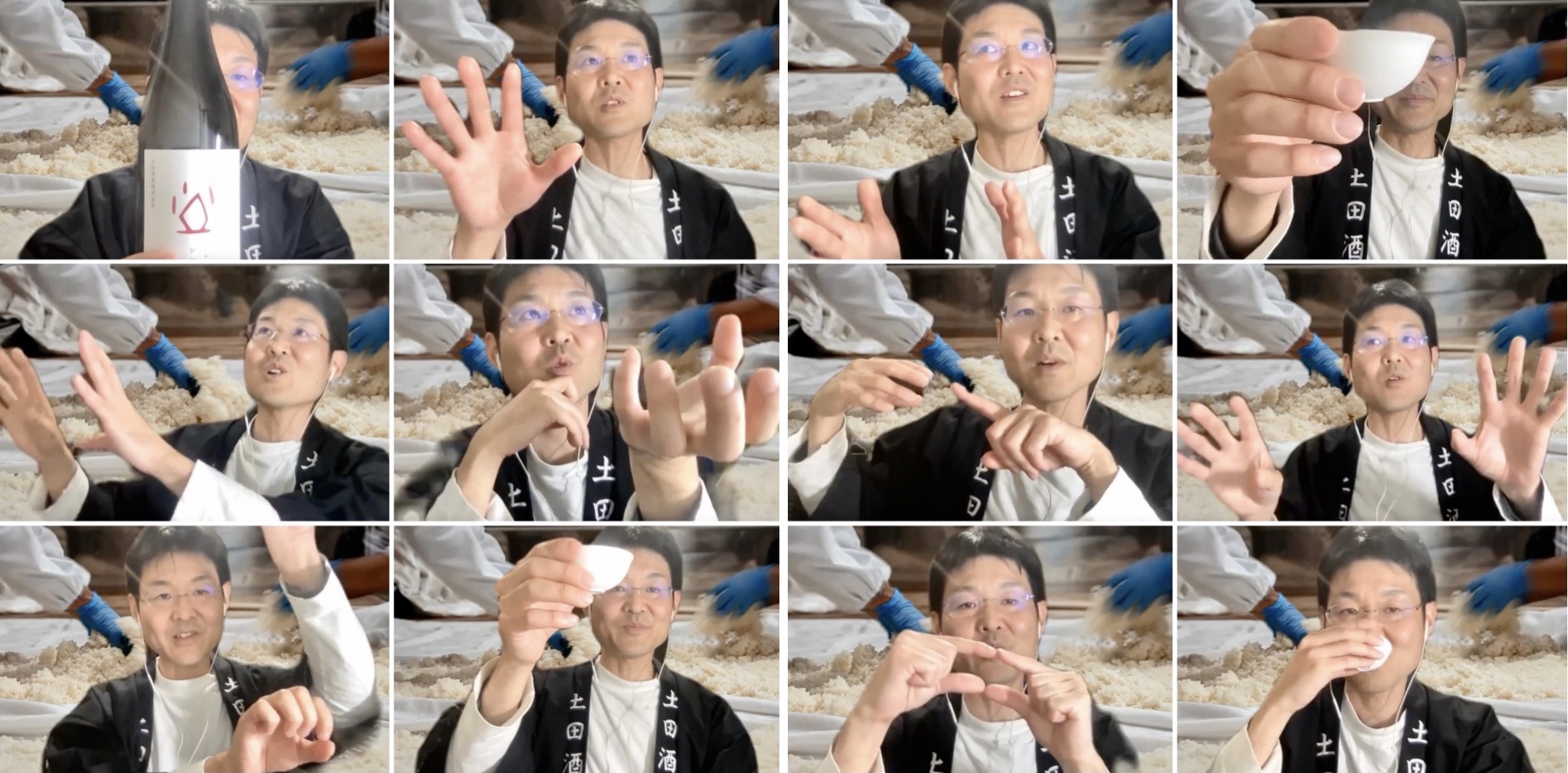
Monday 6th December, 2021, saw the 68th session in the TWTT series take place on screens across the globe. For this session, we headed to Gunma prefecture to feature Tsuchida Shuzo.
We were joined last night by 6th generation president, Yuji Tsuchida.
Tsuchida Shuzo was established in 1907. The brewery is located in Kawaba, a small farming village of approximately 3,600 people, in Gunma Prefecture, a mountainous region northwest of Tokyo.
Tsuchida-san is no stranger to online appearances and came to this session well armed with informative slides, videos, charts and a wealth of knowledge and information. It was obvious from the start that the ‘official’ session would end up going a little overtime. Not only did the session run 40 minutes overtime, it seemed by the 2 hour 40 minute mark that Tsuchida-san was just settling in! Needless to say, the session kind of flowed on to become the nijikai and those that stuck around got to hear a whole lot more from Tsuchida-san.
With the little information I knew about this brewery prior to this session, I was already convinced we were in for a good geeky time with no shortage of things to discuss and questions to ask.
Once the Toji himself, Tsuchida-san handed over that role to Hoshino-san in 2012. As the last born of 4 siblings in his family, Tsuchida-san never imagined he would be the one to work at, let alone take over, the brewery. He joined the brewery in 2003, became Toji in 2007 and went on to become president the following year. Since coming on board, Tsuchida-san has made some big changes to the way the brewery produces sake.
Tsuchida Shuzo are committed to Kimoto, with around 90% of their production being brewed using this ancient starter method. Prior to this, the bulk of the brewery’s production was made exclusively with the Yamahai method.
80% of the sake they produce is made using table rice, mostly Gunma’s own Asahi no Yume. Most of the rice they use is only polished to around 80 or 90%, around 70% of their sake is made using ambient yeast, and they do not use any chemical additives. They are committed to using pesticide free rice and becoming more sustainable in every aspect of the business.
Talking about his brewing philosophy, it’s clear that Tsuchida-san and his young team like to push the boundaries. They are not afraid to take risks and certainly don’t conform to please the masses. They are open to experimentation and also love a challenge.
Tsuchida-san placed a big emphasis on koji during this session. Stating that koji is the most important ingredient in sake brewing, Tsuchida-san spoke a little about not only their unique application of koji spores to the rice, but also the type of koji kin they are using. Tsuchida-san explained that they sought out an ‘older style’ of koji kin that produces stronger enzymes, (and apparently makes their kasu turn a blackish-grey).
Of course, the subject of microorganisms came up numerous times during this session. Tsuchida-san believes in working in harmony with the ever changing microorganisms within the brewery. Just as the bacteria in the brewery is constantly changing, the flavour of their sake changes from year to year and that is something Tsuchida-san embraces with open arms!
A super interesting session and still so much more we could have talked about.
A huge thank you to Yuji Tsuchida for sharing his time, passion, knowledge, philosophy and more time with us all. An extension of that huge thank you must go out to Maki Tanaka for yet another fabulous interpretation.
Thank you also to everyone who attended this session.
Taste with the Tōji ~ Session 67:
Yukihiro Kashiwase
Wakakoma Shuzo
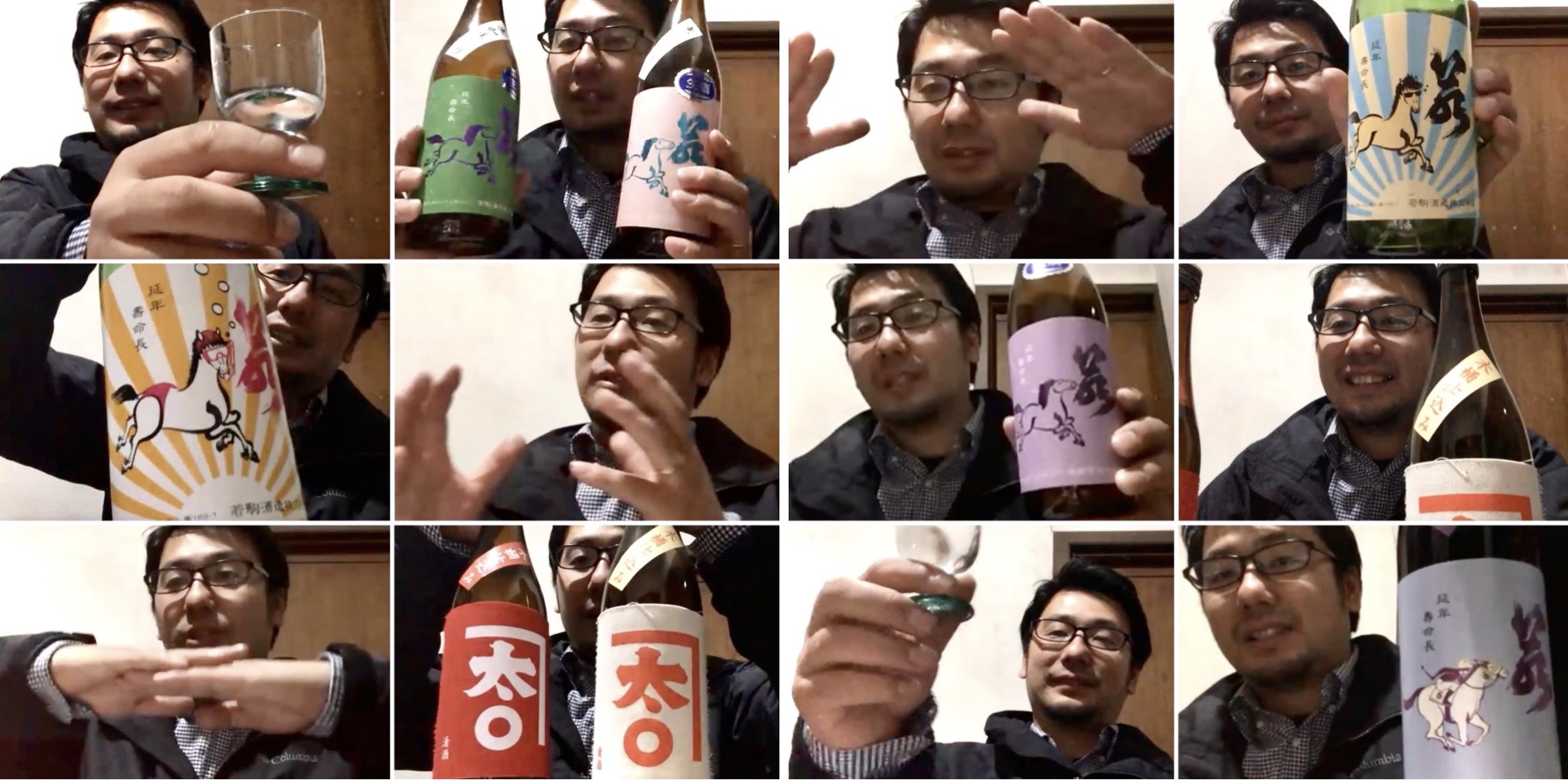
Monday 29th November, 2021, saw TWTT host session #67 as we headed to Tochigi prefecture for the first time during this series of online events.
The featured brewery was Wakakoma Shuzo and we were joined by 6th generation, Yukihiro Kashiwase.
This family brewery was established in 1860, in Oyama City, Tochigi, and was once producing around 2000 koku. These days, they are producing around 250 koku and a very different style of sake to what they were making before Yukihiro Kashiwase took over the brewing 13 years ago.
Yukihiro is the second son and because of this, never thought he would be the one to take over the family brewery. Instead, he had been pursuing his main interest at that time, which was Soccer. This is something I wish we had been able to touch on a little more during this session, but as always, it’s impossible to fit everything into a 2, or in this case 2.5 hour, session. It turns out, back then, his mother somehow arranged for Yukihiro to start working at an izakaya. Whist working at that izakaya, he discovered that sake was actually something quite special and began to think that perhaps brewing sake was not such a bad idea after all. Seems his mother had it all planned out and with this seed now planted, he set off to learn how to brew sake. Already with a rough idea of the style of sake he hoped to create, Yukihiro spent 3 years training at Yucho Shuzo, producers of the much loved Kaze no Mori sake.
On his return to the family business, he decided to renew the Wakakoma brand, changing not only the branding/labels but also the style of the sake.
Talking about the Wakakoma and Kanetamaru labels with Yukihiro, it was clear that one of their brewing philosophies centres around using low polished rice – (rice that has had very little of the grain polished away). Yukihiro explained that he believes this allows the sake to express the energy of the rice, and of the soil/earth it grows in. Of course, there are two sides to most stories, and Yukihiro explained that the other reason for this was that they were not in a position to spend the money on higher polishing – the higher polished the rice, the more expensive the sake is to make as you need more rice. That said, their decision certainly seems to be working in their favour, (as far as the outcome is concerned), as they are making some cracking sake!
He mentioned that a lot of people associate low polished sake with something that is quite heavy, in weight and in flavour. Most of what they produce seems to be Muroka Nama Genshu and all their sake is pressed using a Fune. Their sake is far from heavy on the palate but it is complex. A delightful mix of nama-freshness/zing, with subtle sweetness, pleasant sourness and bright acidity, along with some true ‘rice’ flavour.
Sadly, this year saw some terrible damage to the brewery building, caused by ferocious weather. Parts of the brewery were already previously damaged and the family were not in a position to afford repairs. In recent months, heavy rain and wind saw part of the brewery’s roof completely collapse. Yukihiro showed us photos of some of the damage, leaving the audience with a desire to help in any way they can.
Despite these challenges, it is remarkable that Yukihiro is still able to, or should I say determined to, keep brewing. He has temporary tarp roofing over some of the tanks, which sadly, if there is a big storm, will hold little protection. Even so, both the battle and the brewing continue.
Whilst the TWTT community ponder over ways we may be able to help and show support for the brewery, Yukihiro continues to brew his delicious sake and retain a positive outlook for the future of his family’s brewery. If you have not already done so, please seek his sake out and show your support.
Knowing how busy Yukihiro is at this time, and that the brewery team is basically him, plus one employee, and the family on hand to help out, I am incredibly grateful that he was able to spend some time with us.
A huge thank you to Yukihiro Kashiwase for sharing his time, passion, knowledge and hope with us all. An extension of that huge thank you must go out to Maki Tanaka for stepping up at rather short notice to interpret for this session, and of course to Julian Houseman and Rumiko Moriki for helping with initial communication in getting this session on the TWTT map.
This was a session I was determined to see happen this year and I thank everyone involved for helping to bring it to the table.
Finally a big thank you to everyone who attended this session to show support for Wakakoma Shuzo.
Taste with the Tōji ~ Session 66:
Nobuki Yagi
Yagi Shuzobu
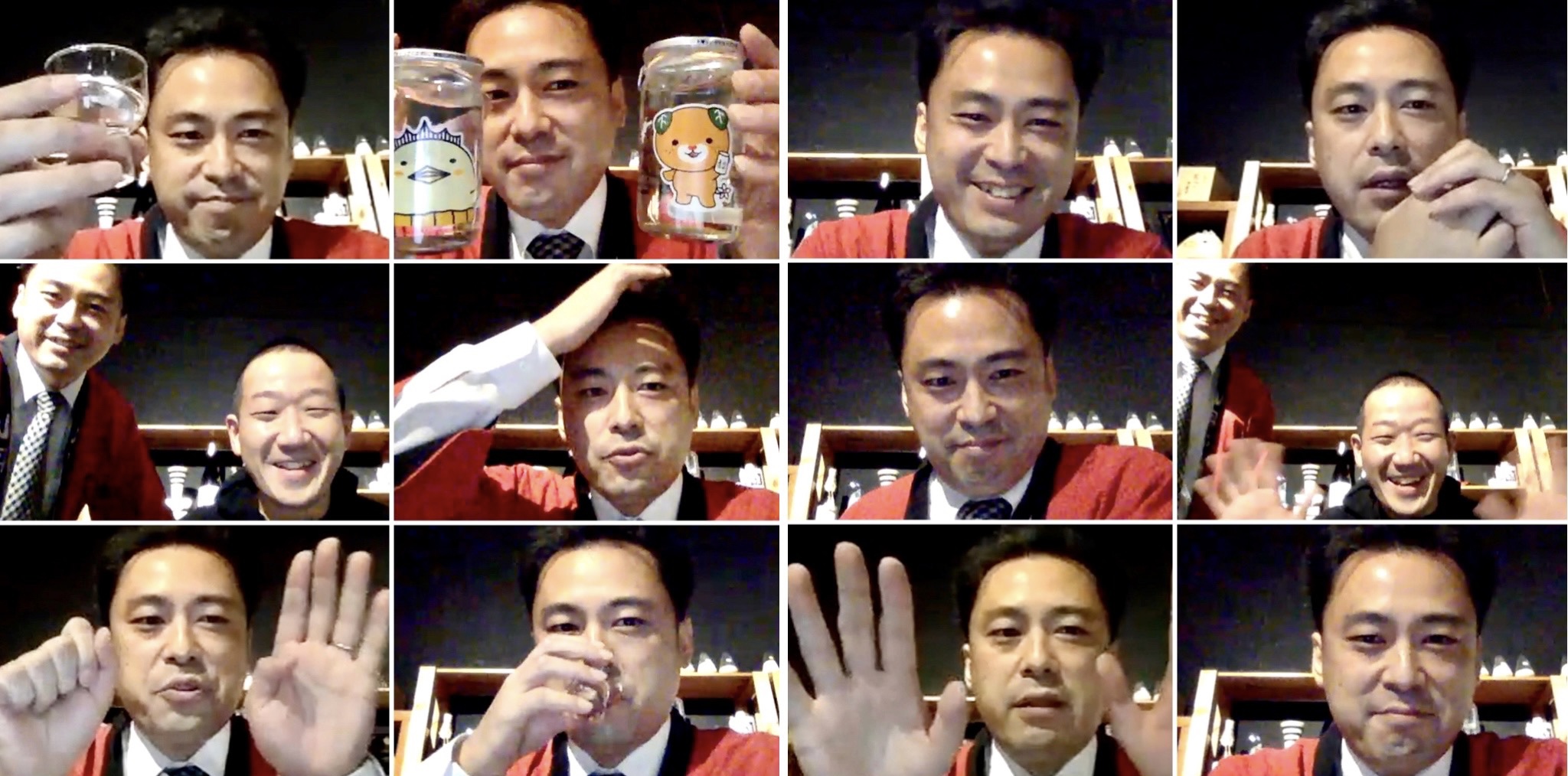
Monday 22nd November, 2021, saw TWTT host its 66th session as we headed to Ehime prefecture for the first time in this series.
The featured brewery was Yagi Shuzobu, producers of Yamatan Masamune sake. We were joined by 8th generation Kuramoto, Nobuki Yagi.
During the session we were also fortunate enough to briefly meet their Toji, Ishida-san, who only just became head brewer this year.
This year, Yagi Shuzobu celebrates their 190th year. It’s impossible to cover 190 years of history in a 2 hour session, however, Yagi-san put together a presentation that not only touched on some of that history, but also shared a little with us about local cuisine and culture. Yagi Shuzobu originally began trading under the name ‘Tambaya’ in 1831, starting with the production of soy sauce and cotton. Sake production began the following year.
The brewery is located in the city of Imabari, on the northernmost side of Ehime prefecture, which connects to Onomichi City in Hiroshima prefecture by the Shimanami Kaido. Imabari City faces the Seto Inland Sea, is famous for the production of towels and it’s ship building industry, and apparently boasts an amazingly large number of Yakitori eateries, serving up Imabari’s own unique style of Yakitori.
Sadly, being a place famous for ship building, Imabari City was targeted in the war and saw the brewery destroyed by fire in the 1940s. Their resilience was strong and Yagi Shuzobu resumed brewing within a year of being of the brewery being destroyed, as they continued to rebuild the brewery buildings and family business.
Yagi Shuzobu, now the only sake brewery in the city of Imabari, no longer produces soy sauce or cotton. The brewery currently produces around 800 koku per year. Most of the sake they produce is brewed using rice grown in Ehime prefecture, including Matsuyama Mii and Shizuku Hime, with just a small amount of Yamada-Nishiki coming from outside the prefecture. Their water is sourced underground, from the Soja River, originating from Mt. Takanawa.
Yagi Shuzobu are also part of the collaborative project, Kura Cats, with Craft Instinct Japan, which was introduced to the TWTT audience during the World Sake Day online event. They are the brewery behind the GIN Junmai Ginjo as part of the first ever Kura Cats range.
A huge thank you to Nobuki Yagi for sharing his time, passion and vision with us all. An extension of that huge thank you, and a gloriously warm welcome to the ‘TWTT Translation Team’, must go out to the lovely Makie Shennen for interpreting for this session. Also, thank you to Charles Stewart from Craft Instinct Japan for helping to make this session happen.
Thank you to everyone who attended this session.
Taste with the Tōji ~ Session 65:
George Briant Parsons
Inoue Shuzo
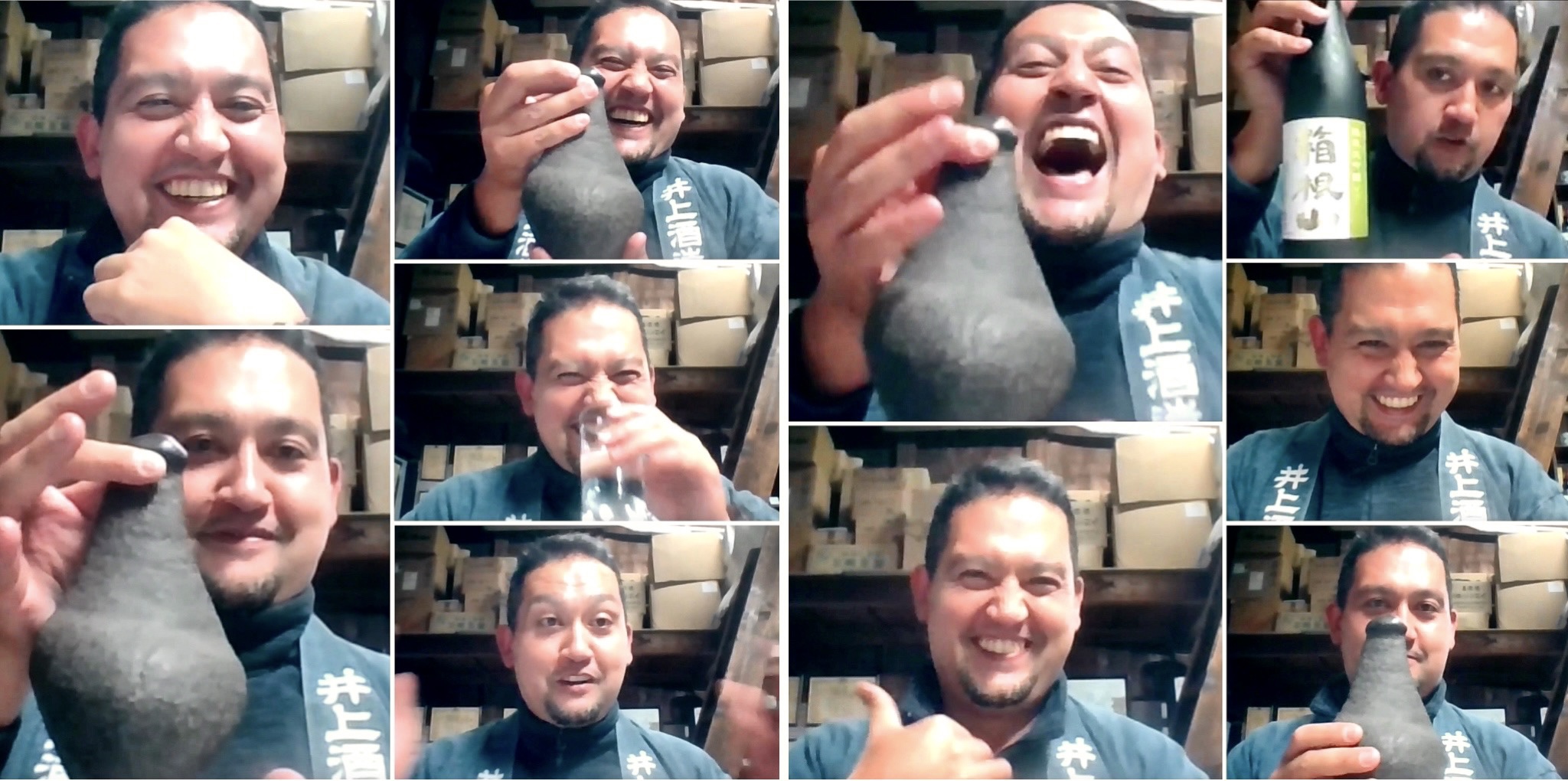
Monday 8th November, 2021, saw TWTT’s 65th session as we headed to Kanagawa prefecture to chat with
George Briant Parsons from Inoue Shuzo – producers of Hakoneyama sake.
Inoue Shuzo is a small brewery located in the small town of Oi, (Oi Machi), in West Kanagawa, and despite an incredibly long history, was little known to many TWTT members prior to last night – including myself. That said, they certainly already had themselves a few incredibly loyal and supportive advocates within the group. My, or should I say TWTT’s good friend Harald deRopp, ever-passionate about sake, is one of those advocates, instigating this session to help shine a spotlight on a small kura that, like many others, has certainly seen some hardships of late. Another friend of TWTT,
Charles Stewart, through his Kura Cats project with
Craft Instinct Japan, introduced some of the TWTT audience to Inoue Shuzo during the special online event on October 1st, World Sake Day. The Kura Cats project is also helping to shine a spotlight on this, and other breweries, with Inoue Shuzo producing the Junmai Sake for the first ever Kura Cats range. You can find out more about this product and the project
here.
Despite the brewery being in George’s family, (his uncle is the current owner and President), he never saw himself working for the company, let alone being Vice President with a view to succeeding his uncle and becoming President. With no prior knowledge of sake, George was asked to come and work at the Kura and, despite being apprehensive due to his lack of knowledge and experience in the field, he graciously accepted and agreed to help his family’s brewery. If he had not, the brewery was most certainly looking at extinction upon his uncle’s retirement.
George has been working for the brewery now for 18 years, however, most of that time has seen him working in sales. This year will see him spread his sake wings a little further as he gets more involved in the brewing side of things, learning from the Kura’s new Toji, who hails from the Noto guild, and the current brewing team.
As mentioned earlier, this brewery has a long history, and a most interesting story of how the brewery came to be. Inoue Shuzo was founded in 1789.
As told last night, the story goes …
“The brewery was founded by the sixth generation Kanamechi of the Inoue family in the first year of Kansei (1789) which is the same time as the French Revolution. Kanamechi, who was engaged in agriculture at that time, was hurrying on his way to the castle town of Odawara, ‘in search of new business’, when he stumbled upon a stone. The stone was in the shape of a sake bottle. He firmly believed that this was a divine revelation to make sake, and so he established the Inoue Shuzou. The stone is still carefully preserved as a most treasured heirloom of the Inoue family.”
George was kind enough to show us this curious Tokkuri-shaped stone last night, which certainly sparked a lot of interest amongst the group and conjured up some interesting marketing suggestions for future Inoue products. Certainly a great story and many possibilities there!
A small brewery with a long history and a big heart, Inoue Shuzo have seen some hardships and are indeed in a transitional stage and embracing some big changes. They are now known to more of this TWTT mob and it seems a few members are already planning a road trip to go and visit George, and perhaps even help out at the brewery. We certainly wish George and Inoue Shuzo the very best for the future and look forward to following with interest as the next phase of their story evolves.
Thank you to George for sharing his time and stories with us all . Thank you also to Harald and Charles and to everyone who attended this session.
Taste with the Tōji ~ Session 64:
Takahiro Nagayama
revisiting Nagayama Honke
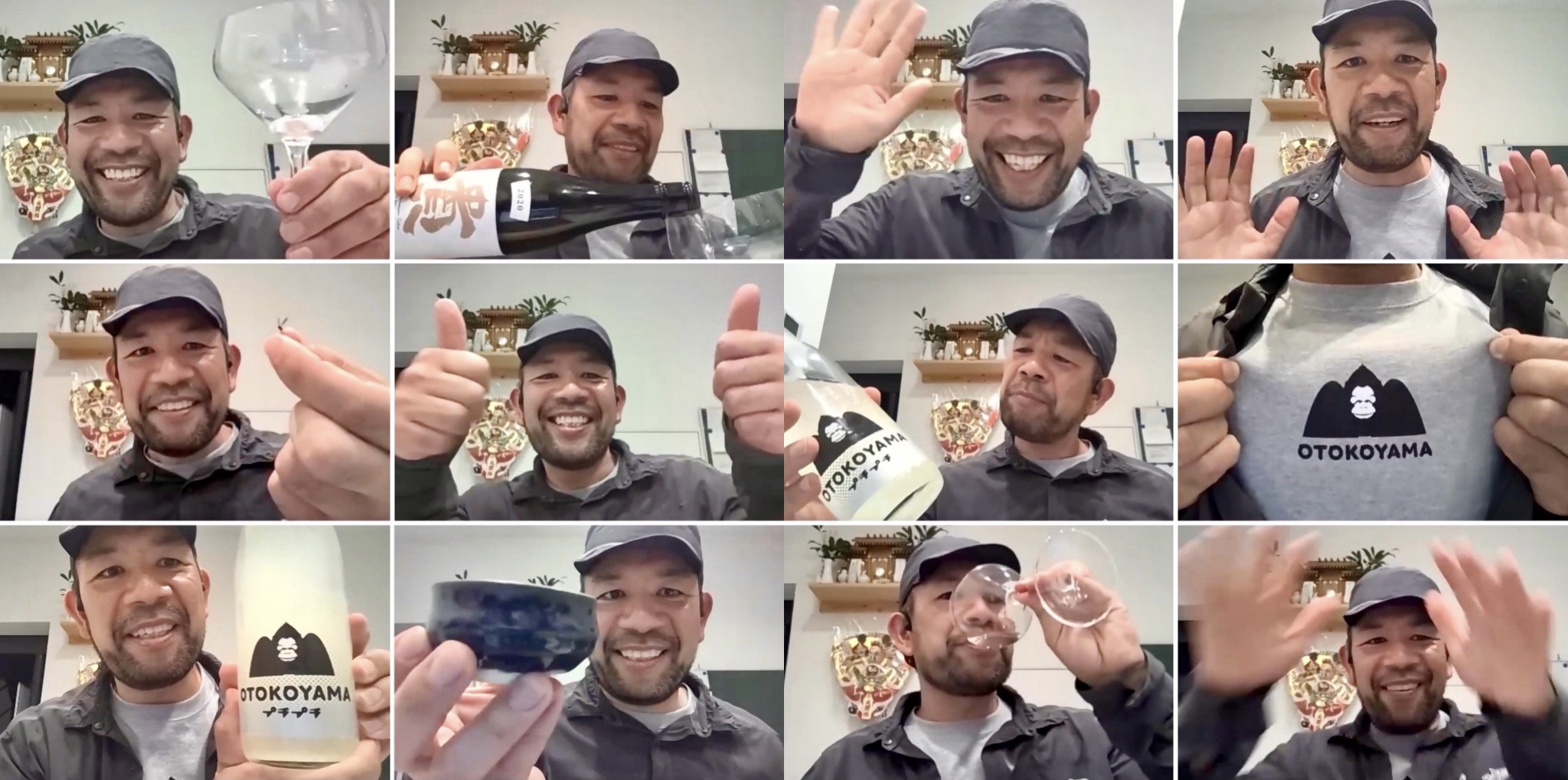
Monday 1st November, 2021, saw TWTT’s 64th session as we headed to Yamaguchi prefecture to re-visit Taka-san at Nagayama Honke.
It’s always a delight to chat with Taka. His warmth and passion is as infectious as his great big smile.
Nagayama Honke was established in Ube City, Yamaguchi and has been in operation since 1888. Takahiro Nagayama is now the 4th generation owner. He took over as Tōji in 2001. The brewery is well known for their Taka label derived from his own name, Takahiro. Since 2004, the Taka brand has been dedicated to producing only Junmai sake.
This TWTT session started with Taka introducing his re-branding for their lesser-known Otokoyama label, complete with T-shirt modelling, along with his Otokoyama プチプチ (slightly sparkling) sake, and explanation of the link between the Gorilla in the logo and his nickname, which many know is Gori-san.
This led into a short powerpoint presentation to introduce the brewery and its philosophy: Think Globally, Act Locally. This, of course, led into a discussion about rice, which was the ‘loose’ outline/focus for this session.
We heard last year that the brewery had been growing, and brewing with, their own Yamada-Nishiki rice. 12 months ago, we also heard of Taka’s hopes for the brewery to successfully grow Omachi rice. Last night, we heard that they had achieved this. This is not the first time Nagayama Honke has grown Omachi, Taka informed us last night that his grandfather grew it back in the day. This is, however, the first time Taka-san, 4th generation, has grown it. An Omachi resurrection of sorts. The rice discussion also included talk around harvesting, which is all done by machine – their rice is also machine-dried. We touched a little on rice sorting and grading, something Taka himself is certifiably involved in through his own agricultural company, Domaine Taka.
Something I had not realised prior to last night is that 50% of the sake produced by Nagayama Honke is Kimoto. When we touched on this in the nijikai chat, a huge can of worms was opened which led into a rather passionate discussion about savoury, or the definition thereof, and the use and definition of the word umami…. you had to be there! (and I am glad Taka stuck around for that!)
It was also great to hear that Taka has a little side project going on in the brewery where he is using sake kasu to make pickles, (following his mother’s recipe). Thinking globally, acting locally AND minimising wastage. Thumbs up to that!
As always, and even after a second TWTT session, there is still so much more to ask, discuss and learn and those that stuck around for the nijikai after the 2 hour ‘official’ session ended were most grateful to have Taka stay on and answer a few more questions.
I’m sure we won’t be short of things to discuss if TWTT holds a 3rd session with Taka in the future.
Once again, it was a joy to spend time with Taka. A huge thank you to Takahiro Nagayama for sharing his time, knowledge, passion and humour with us all. An extension of that huge thank you goes out to my good friend, the awesome Yamaguchi sake guy, Jimmy Rion for yet another wonderful interpretation with an incredible understanding of this brewery and Taka’s philosophy. Thank you also to the ever-lovely, ever-reliable and always fabulous, Maki Tanaka for her help during this session and with the nijikai. I’m incredibly grateful for the amazing community that TWTT has evolved into.
Of course, as always, thank you to everyone who attended.
Taste with the Tōji ~ Session 63:
Kotaro Saito
Saiya Shuzo
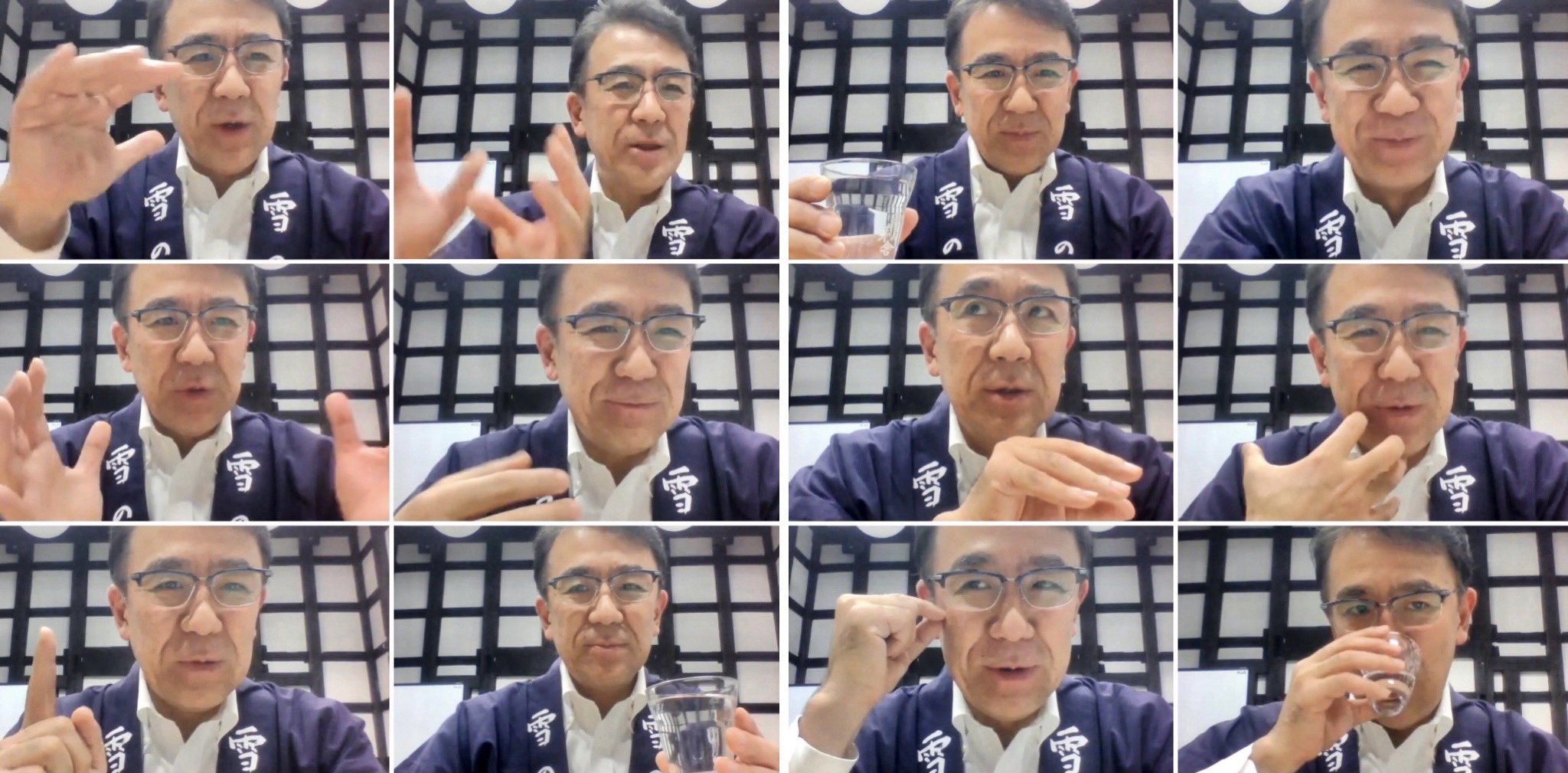
Monday 25th October, 2021, saw TWTT’s 63rd session. Who would have thought that when this project started, it’d still be going 17 months later, let alone, reach 63 sessions. Amazing what the longest lockdown can inspire… Seriously though, sake is the inspiration for the TWTT project and continues to inspire with each session.
It was an absolute honour to spend 2 and a half hours with Kotaro Saito, and his interpreter, Shizuka Wakashita from Saiya Shuzo last night.
Saiya Shuzo was founded in 1902. The brewery is located in the city of Yurihonjo in Akita prefecture. They are the producers of the much loved Yuki no Bosha.
Akita prefecture boasts a rich history and culture that connects it to sake ~ it has long been associated with rice growing, sake brewing… and sake consumption!
The brewery itself is a Registered Tangible Cultural Property.
Known as a Nobori Kura, (climbing brewery), the brewery is built on a slope. This intentional design feature is not only practical, supporting their brewing process from sourcing water to bottling sake, it also allows the kura to maintain their high standards when it comes to hygiene.
Saiya Shuzo has quite a large team working in the kura, one who is certainly no stranger to fans of Yuki no Bosha. Takahashi Toji sadly couldn’t join us last night due to work commitments. A stalwart at Saiya Shuzo, he is of course well known and respected amongst many in the sake world, from producers to consumers ~ known also for his unique brewing methods.
Saito-san spoke a little last night about Saiya Shuzo’s brewing philosophy: ‘San Nai Jikomi’ – (what he calls ‘three-no-brewing’).
* NO stirring (the mash)
* NO dilution
* NO charcoal filtration
He also mentioned that they only use in-house yeast at the brewery. Currently, they have around 11 in-house yeasts that have been cultivated for use at Saiya Shuzo. They also mill all their own rice in-house.
The brewery currently produces around 3700 koku per year. 60% of their production is Sokujo, whilst the remaining 40% is made using the Yamahai starter method.
The scheduled 2 hour session rolled on for an extra half an hour – which still, as always, is never enough time…. still so much more to listen to, to ask and to learn.
Saito-san was certainly well prepared with an extensive powerpoint presentation and videos to cover everything from the local area, the history of the brewery, the unique design aspects of the kura to the climate, quality control, brewing methods and more. Sadly, a few things had to be eliminated from the initial presentation for last night’s session due to time limitations and in order to incorporate our interactive Q&A component. So – already, there are talks of a follow-up session to cover some of the things we couldn’t cover last night.
A huge thank you to the delightful Kotaro Saito for sharing his time, knowledge, kindness and vision with us all last night. A huge thank you also to Shizuka Wakashita for interpreting for this session.
A special mention and thank you to the wonderful Eiko Kodama and Shinichiro Kodama from Kodama Jozo (TWTT #12 and #61) for their help in making this session possible.
Thank you also to everyone who attended this session.
Taste with the Tōji ~ Session 62:
Kinnya Mikawa
Mikawa Shuzo
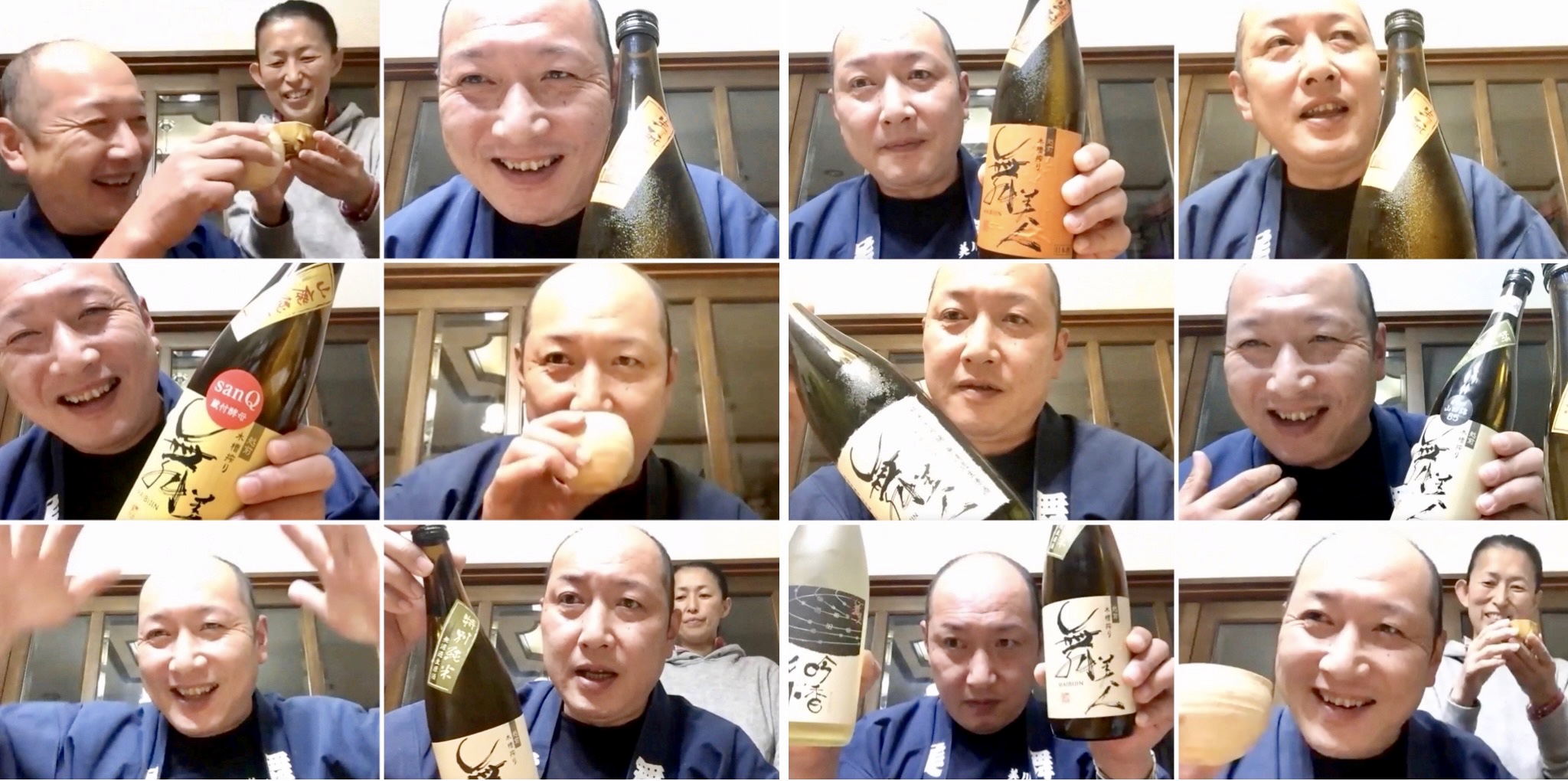 Monday 18th October, 2021, saw another enjoyable and informative session of TWTT as we headed to Fukui Prefecture for the first time in this series and spent some quality time with Kinnya Mikawa from Mikawa Shuzo.
Monday 18th October, 2021, saw another enjoyable and informative session of TWTT as we headed to Fukui Prefecture for the first time in this series and spent some quality time with Kinnya Mikawa from Mikawa Shuzo.
This was Mikawa-san’s first ever online event and it was an honour to have TWTT host his debut!
Mikawa Shuzo was founded in 1887, in the east of Fukui City. Kinnya Mikawa is the 6th generation to run this family operated brewery. The brewery itself was almost entirely destroyed in the Fukui earthquake of 1948. Kinya Mikawa and his wife, Kumiko, took over the brewery after some major reconstruction work to their family’s humble kura.
The brewery’s signature brand is “Maibijin ” ~ taking its name from the Edo era, referring to the name a feudal figure said to the most ‘beautiful dancer’ of the village.
Since the brewery began, the Mikawa family has been involved in rice farming. They began growing table rice and over the years, slowly switched to growing only sake rice. The brewery currently grow around 30% of the rice they use for brewing each year. They grow both Yamada-Nishiki and Gohyakumangoku. All other rice varieties used within the brewery are purchased through JA and are actually table rice varieties sourced within Fukui prefecture.
Sadly, as for many breweries, the current situation has seen a decline in their annual average production, which currently sits at around 180 koku. A small brewery with a small team of 4 people, meticulously crafting Maibijin sake. The brewery use the now less common ‘Japanese kettle’ method for steaming their rice:
https://www.maibijin.com/page/4, they also laboriously press their sake using a kibune, (made up of bamboo and cedar):
https://www.maibijin.com/page/3Since taking over his family’s brewery, Mikawa-san admits that the flavour profile of Maibijin sake has changed quite dramatically due to the changes he has implemented. A big factor being the use of ambient yeast within the brewery. He tells us this produces a higher amount of lactic acid. One of the feature characteristics of Maibijin sake is it’s ‘sourness’, higher acidity ~ balanced out with a good amount of umami.
One product that certainly captured our attention last night was the Maibijin MYVY ~ produced by re-fermenting their sake kasu. The kasu is placed in a tank and left to ferment, without the addition of anything – other than the ambient yeast that falls into the tank – and without temperature control. You can read more about it here:
https://sakestreet.com/ja/media/sakagura-mikawa-shuzojo-fukui-myvyA truly delightful and insightful session. Mikawa-san is certainly a natural at these online presentations, despite this being his first… hopefully this will be the start of many as there is still so much more to learn about this brewery.
A huge thank you to Kinnya Mikawa for sharing his time, knowledge, humour and passion with us all ~ thank you also to Kumiko Mikawa for spending some time with us. An extension of that huge thank you goes out to the wonderful Maki Tanaka for yet another fabulous interpretation. Thank you also to Toshi Fujita from
Sake Street for helping to make this session possible.
Thank you also to everyone who attended this session. Please keep supporting some of these incredible smaller breweries who really need a little love right now after a pretty tough couple of years.
Taste with the Tōji ~ Session 61:
Shin & Eiko Kodama
revisiting Kodama Jozo
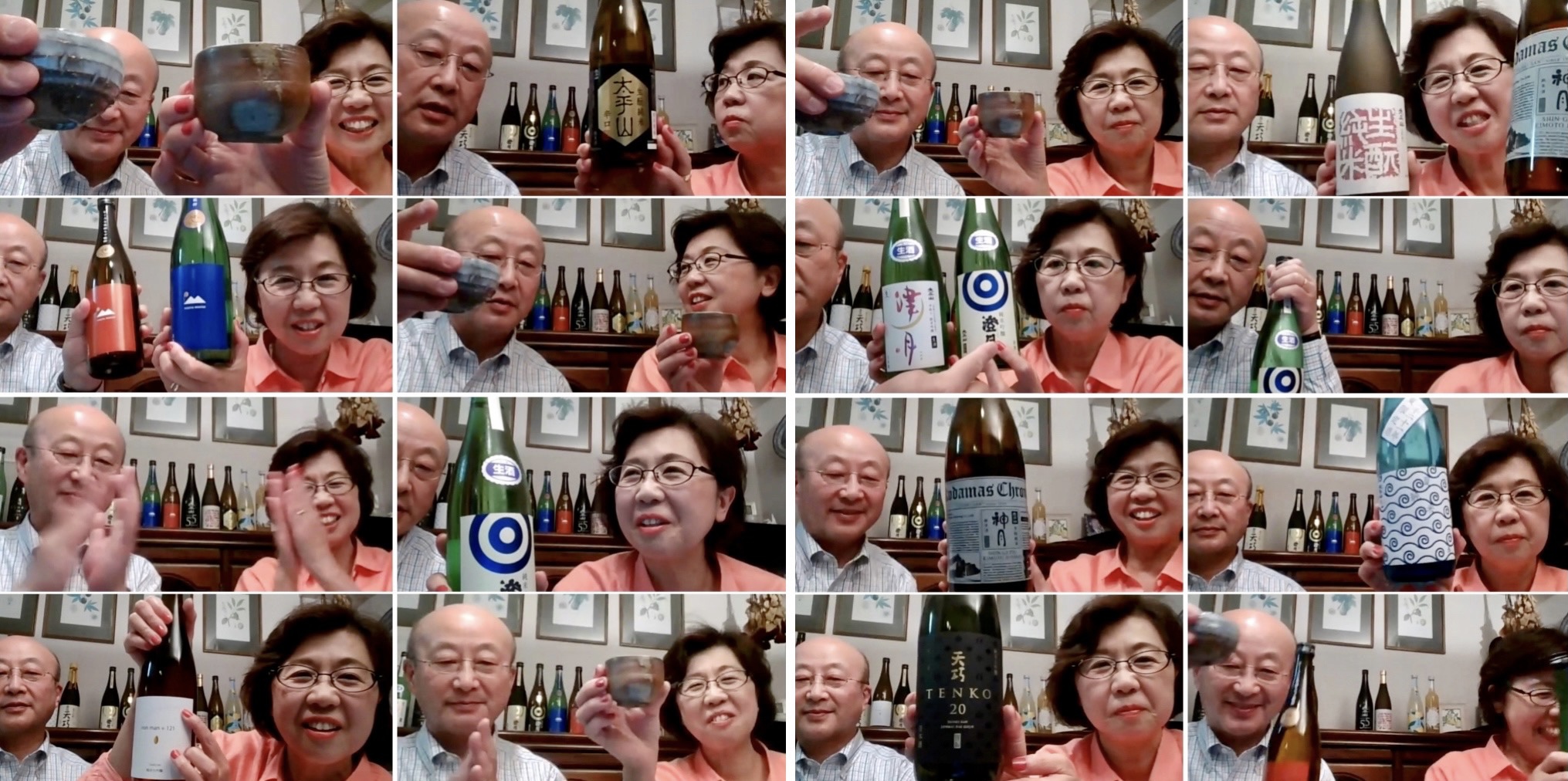
I have to say, it’s always a pleasure catching up with the Kodamas, and this session, held on Monday 11th October, 2021, was certainly no exception.
TWTT first featured Kodama Jozo back in August 2020 (TWTT #12), so it was a joy to revisit some 14 months later for TWTT #61!
Kodama Jozo was founded in 1879 in the picturesque city of Katagami in Akita Prefecture, northwest of Japan. Originally, the Kodama family started their business by making soy sauce and miso for local consumers. In 1913, Tomokichi Kodama, the second generation of the family business began making Sake by the name “TAIHEIZAN” (太平山) (Peaceful Mountain).
Today, Kodama Jozo are still producing soy sauce and miso, along with sake and more recently, fruit based liquor including yuzushu.
It was a pleasure to spend 2 and a half hours chatting with Shin-san and Eiko-san about what’s been happening at the brewery since we last spoke on TWTT. It seems a lot has been going on over the past year and a bit! From brewery renovations, new fermentation tanks, brewing with a new rice and creating some interesting new products.
The main objective of their recent renovation was to downsize their fermentation tanks (from 15kl – 7.5kl), along with an upgrade and instalment of their air conditioning and cooling facilities in order to have greater quality control over their premium sake.
During the Kodama’s visual presentation, we got to take a look at some of these changes within the brewery, along with some wonderful recent drone footage taken by Travis Matsumoto, who is currently in the process of making a feature video for Kodama Jozo. Some beautiful footage, swooping over glorious rice fields, was certainly a joy to watch and we look forward to seeing the finished video ~ which will include everything from the rice fields to the bubbling fermentations going on inside the brand new tanks.
Wonderful to see and hear about some of their latest products too – from collaborations with wine sommeliers to the use of Akita Prefecture’s new sake rice variety, (Hyakuden), to their first time making yuzushu and other fruit based liquor. We even learnt that their Toji was once an amateur wrestler in his high school days, thus earning his current nickname; Testsujin (Iron Man) from Kodama-san ~ which of course was the inspiration for their recent Iron Man + 121 Junmai Daiginjo, (aged for 2 years before being released).
It was also lovely to hear a little bit about their shoyu and miso production this time round, which of course, is how the company began. Such a rich and wonderful history, and, as always, impossible to fit it all into a 2.5 hour session.
A truly enjoyable session, which kind of felt like we had all been invited into the Kodama’s living room to have a drink and catch up with old friends, (perhaps to celebrate Shin-san’s birthday which was the day before…. (it was lovely to kick-off the session with a birthday Kanpai!)
A huge thank you to Eiko Kodama and Shinichiro Kodama for sharing their time, knowledge, stories and joy with us all. Also, a huge thank you must go out to Maki Tanaka for her help, (at very short notice), and interpreting during moments when the conversation reverted to Nihongo.
Thank you also to everyone who attended this session.
Taste with the Tōji ~ Session 60:
Mana Iwasaki
Kanbai Shuzo
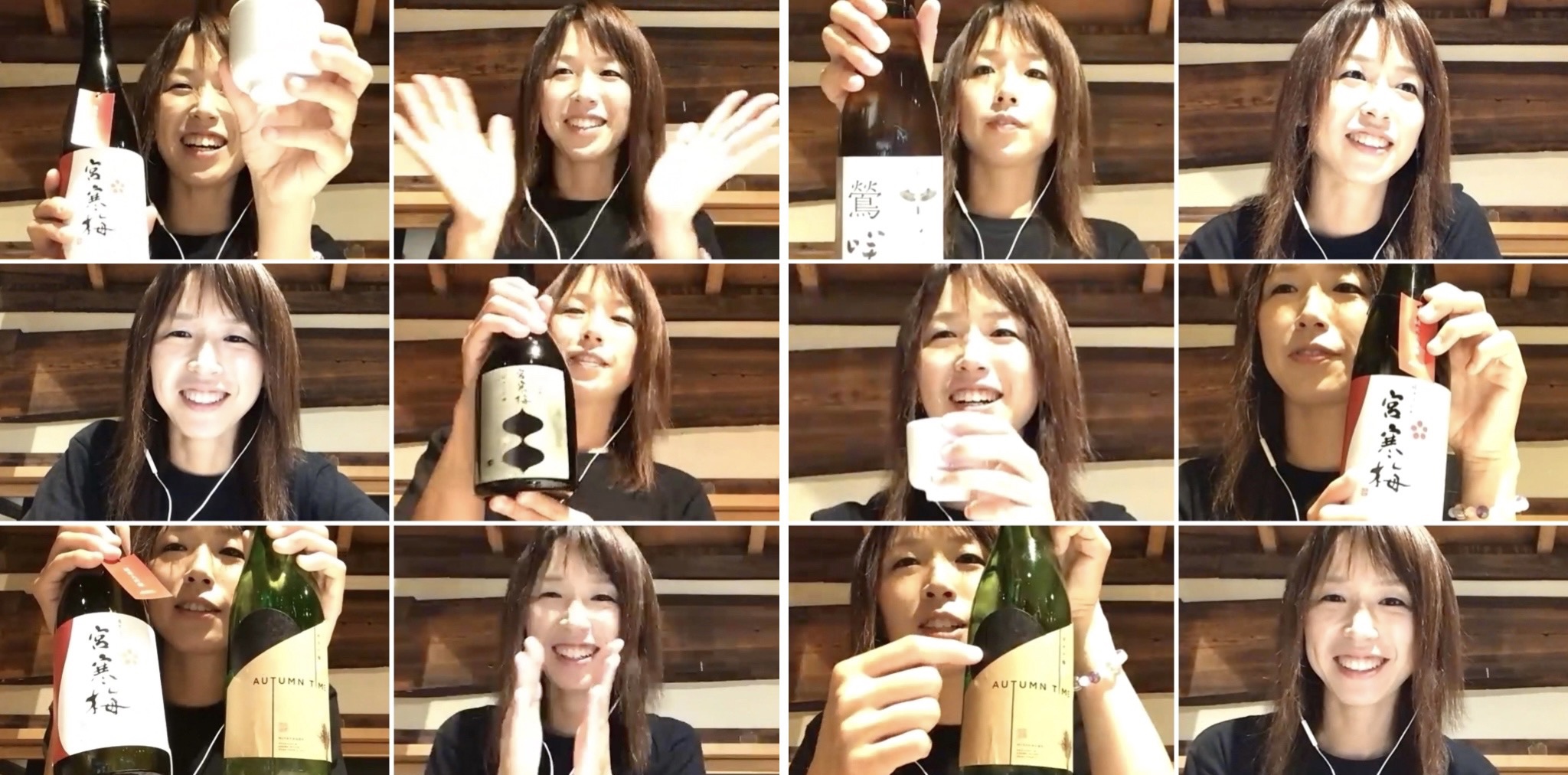
Monday 4th October, 2021, saw another enjoyable and eye-opening TWTT session, which was #60 in the series, when we headed to Miyagi Prefecture to feature Kanbai Shuzo.
Joining us for this session was the delightful Mana Iwasaki.
Initially named Iwasaki Shuzo, the brewery was founded in 1918 by landowner and rice farmer Shinjiro Iwasaki, who then began brewing sake from his locally grown rice and selling it under the brand name of ‘Homare no Takagawa’. The brewery suspended brewing for a period, due to the war, then resumed under the brand name ‘Miyakanbai’ in 1956.
The eldest of four sisters, Mana-san, and her husband – both with no previous experience in the sake business – joined the company together to work alongside Mana-san’s father. That was 14 years ago. Not long after the young couple joined the family business, the brewery fell on hard times once more when it was completely destroyed by the devastating Great East Japan Earthquake in 2011. Fortunately, with the help and hard work of the staff and local community, the Iwasaki family were able to rebuild the building and the business in December that same year.
They currently produce around 700 koku per year.
Prior to joining the brewery, Mana-san was studying psychology/child development and had no intention of working in the family business. An emotional phone call from her mother changed her mindset, when Mana-san was told that the brewery was on the brink of closing down. The young couple decided they should take a leap of faith and do their best to save the Iwasaki family brewery. That they did, and they have not looked back since.
A big feature of last night’s talk and presentation was about rice. The Iwasaki family comes from a strong farming background. They have been growing rice for their sake since the company began. Although not all the rice they use is grown by their company, all rice used is grown in Miyagi Prefecture. It has long been the brewery’s philosophy that ‘delicious local sake depends on delicious rice’. 60% of their production is made using Miyama-Nishiki rice grown in Miyagi. Her grandfather was the first to grow Miyami-Nishiki for sake in Miyagi Prefecture – cultivated from one box of seedlings. Her father continued this rice cultivating tradition, being the first to bring Aikoku and Hiyori rice to Miyagi Prefecture to be used for brewing sake.
Speaking with Mana-san last night, you could certainly see the pride and passion she has for her family’s business, their history and hardships, and of course – her vision for the future. At only 37 years of age, not only is she running a sake brewery with her husband, they also have four children – all boys! Perhaps one is a future brewer in the making!
A truly enjoyable two and a half hours spent with a delightful and determined young woman. We look forward to following the bright future of Kanbai Shuzo.
A huge thank you to Mana Iwasaki for sharing her time, story, passion and wonderful energy with us all. An extension of that huge thank you goes out to Maki Tanaka, co-host & interpreter extraordinaire for this session. お疲れ様でした!
Thank you also to everyone who attended this TWTT session.
Taste with the Tōji ~ Session 59:
Tatsuya Ishikawa
Tsukinoi Shuzo
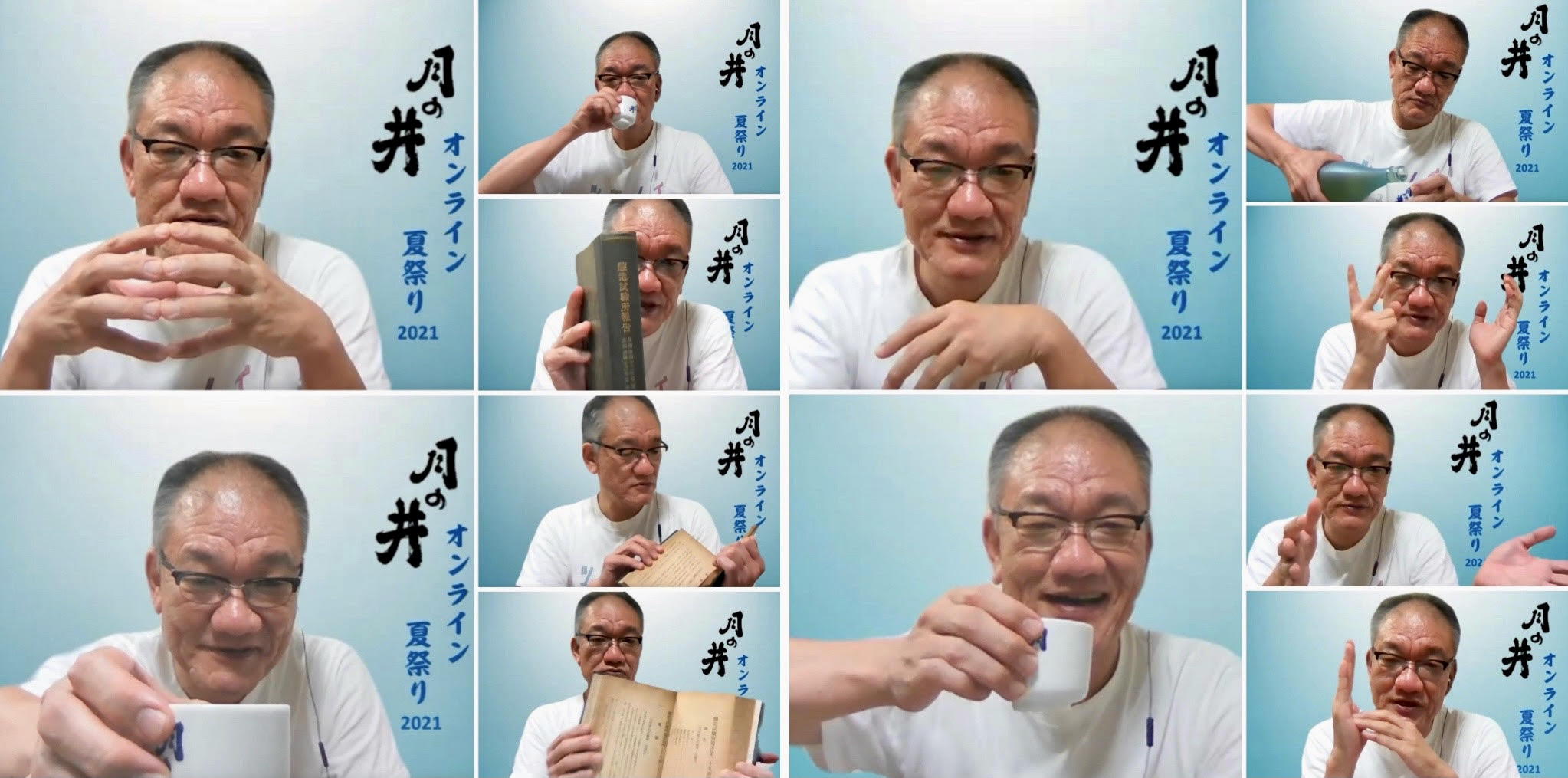
Well… how does one even begin to give an overview of a session like the one TWTT was fortunate enough to experience on Monday 20th September, 2021? I don’t think words can do it justice. I’m sure anyone who attended, or has since viewed this session, will understand what I mean.
I speak, of course, of session #59; an evening with one of the Godfathers of Sake, Mr. Tatsuya Ishikawa.
Ishikawa-san is currently working as Toji at Tsukinoi Shuzo in Ibaraki Prefecture. He was the Toji at Taketsuru Shuzo in Hiroshima for 24 years, and prior to that he also worked at Shinkame Shuzo, (a TWTT favourite and a brewery that inspired Ishikawa-san to follow the path of brewing sake).
Ishikawa-san is also the Vice-president of Japan National Toji Guild and the Chairman of Hiroshima Toji Guild. In 2020, he received an award from the Agency of Cultural Affairs – a first for a Toji.
Born and raised is Saijo, Hiroshima, Ishikawa-san grew up in a most sake-centric environment and has fond memories of playing inside a sake brewery as a child – his father worked at Kamotsuru Shuzo in Hiroshima.
Despite basically growing up in a sake brewery, in a sake town, Ishikawa-san had not really ever envisaged himself working in a brewery. He moved to Tokyo to attend Waseda University, and it was around this time that his interest in sake was piqued. He began spending time with people who had a greater interest in sake and through these connections, he began exploring what was out there in the way of Nihonshu. A chance encounter with a sake from Shinkame Shuzo and Ishikawa’s life was changed forever! Describing that particular experience as something that was beyond the sphere of aroma and flavour – something that resonated with him on a much deeper level…. something words cannot easily describe.
A connection was made and Ishikawa-san decided he wanted to be part of creating something that could have such a profound and permeating effect on him. Not long after, he began working at Shinkame Shuzo, where he spent 4 years working under his mentor from the Echigo Toji guild.
This session was always going to be very different to any other session to date, it was also always going to be a long one… and even after a 4 hour ‘official’ session (and an extra hour beyond that)… we didn’t get through our topic list for the evening. We did dive deep though. Deep into the heart of Kimoto, into microbial activity, into ‘complete’ or ‘perfect’ fermentation, into Junmai vs Aruten and into parts of Ishikawa-san’s philosophy… and also…why sake exists… why it needs to exist.
A deep, yet truly fascinating session, which also included a discussion about truly ‘local’ sake… Sake that represents the local environment; the water, the rice, the eco-system. Those who knew of Ishikawa’s brewing methods prior to this session would have known he is not an advocate for temperature control with his fermentations. Quite a rarity in the brewing world. He feels that when you manipulate the ‘local’ or ‘brewery’ environment or disturb the microbial activity, one cannot truly create ‘local’ sake that represents the area in which it is produced.
Ishikawa-san believes in facilitating a sake’s evolution rather than ‘designing’ a specific sake. Ishikawa-san is not interested in producing a standardised sake, rather, he is excited to see how his sake will taste each year. The focus is on fermentation over flavour profile.
It was such an honour to listen to this remarkable human speak for 5 hours, (of which the time just flew). This was certainly a session that had been highly anticipated and one that had been in the works for close to a year. It was truly an honour to have Tatsuya Ishikawa grace the TWTT stage and basically blow some minds! Personally, I feel like my whole life kind of changed a little after this session ~ in a good way. I definitely have a healthy appetite for a follow-up session…. I’m sure I am not alone there.
A huge, huge thank you to Tatsuya Ishikawa for sharing his time, wisdom, passion, philosophy and magic with us all. An extension of that huge, huge thank you goes out to Justin Potts for allowing the English speaking members of TWTT to experience the magic. An incredible and mammoth effort! Of course, another huge thank you to Andrew Russell, without whom this session would not have happened.
Lastly, thank you to everyone who attended this session.
Taste with the Tōji ~ Session 58:
Takaharu Tanaka & Rintaro Kimura
Toshimaya Shuzo
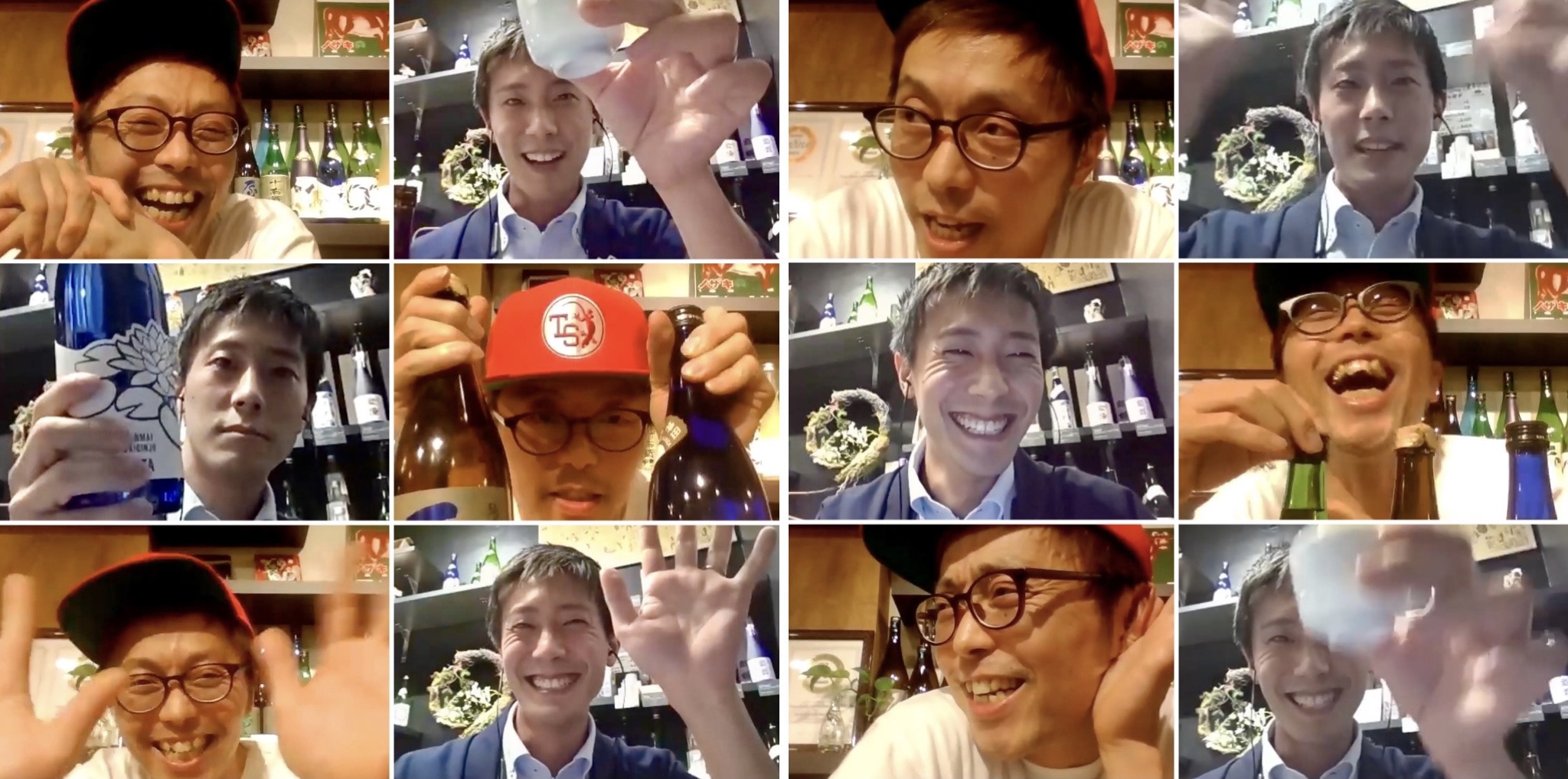
Monday 13th September, 2021, saw another fun and informative TWTT session as we headed to Tokyo Prefecture, for session #58 in this series, to feature Toshimaya Shuzo.
Joining us for this session were Takaharu Tanaka and Rintaro Kimura.
Toshimaya Shuzo have an interesting and intertwined history, (of 3 companies coming together over time), that dates back over 420 years, including Toshimaya’s claim to fame that they opened the first ever Izakaya in Japan. The brewery, in addition to their own brands, also produce sake for a number of Shrines.
The business started in Kanda, in 1596, before moving to the brewery’s current site in Higashimurayama, making Toahimaya Shuzo one of, if not ‘the’, oldest breweries in Tokyo Prefecture, of which there are currently around 9 active breweries.
A live virtual tour of the brewery was not possible last night due to dodgy wi-fi, however, we were guided through an in-depth powerpoint presentation, covering everything from branding concepts to the brewery’s emphasis on rice washing, ‘chū-on’ sokujo starter, Edo yeasts, and talking about the brewery’s use of Hattan-Nishiki rice. Toshimaya Shuzo use Hattan-Nishiki for around 80% of the sake they produce. Tanaka-san tells us that the brewery has been using Hattan-Nishiki rice for over 50 years. Queried by the audience as to why this was the case, Hattan-Nishiki, (from Hiroshima), being a curious choice for a Tokyo-based brewery, Tanaka-san told us that this rice is highly compatible with the brewery’s ‘Tokyo’ water – sourced from 150 metres below ground. Fascinating to hear about the brewery’s history and the evolution of their products, including their ‘ME’, a product created to try and revive the concept of drinking mirin. Kimura-san explained that mirin was actually a beverage before it was used in cooking. Personally, I am a huge fan of ‘drinking mirin’ and am looking forward to trying this product some day.
I was most grateful to be able to sip along with Toshimaya sake last night thanks to
Thomas Ng, who is one of Australia’s newest sake importers with his company
Sakelier. Great to have Thomas join this event.
As always, so much more to discuss, learn and listen to – even after our guests stayed beyond the scheduled 2 hours!
A huge thank you to Takaharu Tanaka and Rintaro Kimura for sharing their time, knowledge, passion and spirit with us all. An extension of that huge thank you must go out to Christopher Hughes, my co-host and interpreter for this session , who did a wonderful job keeping up with the high paced energy of this session!
Thank you also to everyone who attended this session!
Taste with the Tōji ~ Session 57:
Michiko Urasato
Yuki Shuzo
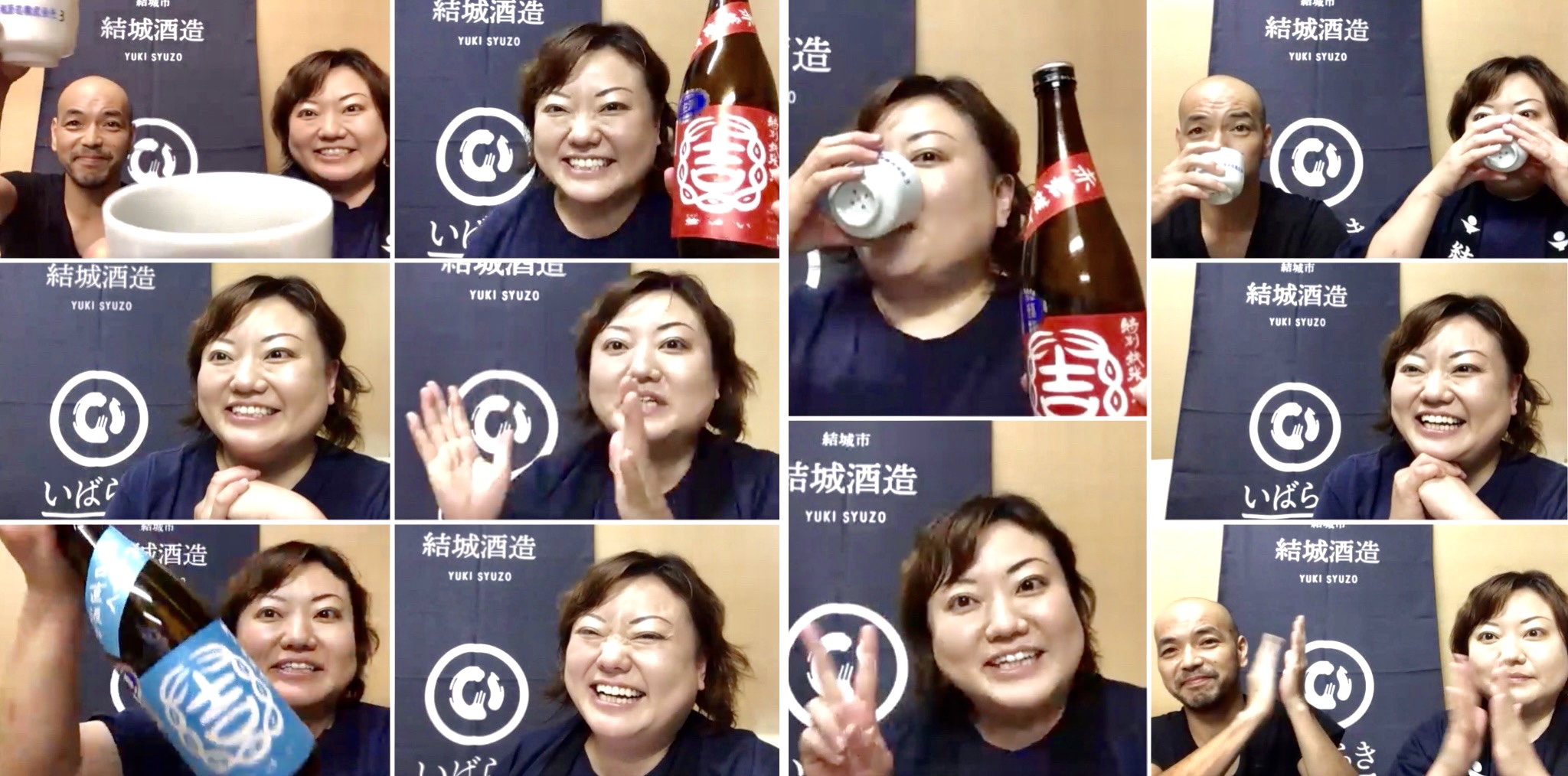
Monday 6th September, 2021, saw another wonderfully enjoyable session of TWTT.
For this session, number 57 in the series, we headed to Ibaraki Prefecture to shine the TWTT spotlight on Yuki Shuzo.
Yuki Shuzo was founded in 1854 in Yuki City, a city steeped with history and tradition, famous for its production of ‘yuki-tsumugi’, a traditional silk fabric production technique, which is actually designated as one of the Important Intangible Cultural Properties of Japan. Yuki City also has a rich religious history, and is home to many old Buddhist temples and Shinto shrines.
The brewery itself is a National Landmark and the brewery’s 100 year old chimney, built around 70 years after the brewery itself, is still in use today.
Joining us for this session was Toji, Michiko Urasato. We got to kick the session off with a Kanpai led by Michiko-san and her Kuramoto husband, Masaaki Urasato.
Prior to marrying into a brewing family, 14 years ago, and going on to become a Toji, Michiko-san had a variety of jobs ~ from administration to hospitality, and even a stint as a golf caddy, however, she had no previous experience in the sake industry. She trained under the Hitachi Toji Guild, the most recent of Toji Guilds, and was actually the very first certified Hitachi Toji. Michiko-san joins the growing number of female Toji, and she is now almost single-handedly responsible for the brewing at Yuki Shuzo.
The brewery currently produces around 270 koku per year, with essentially 3 staff: Michiko-san, her husband, Masaaki-san (Kuramoto), and his younger brother.
Michiko-san presented an informative slideshow followed by a virtual tour of the kura, which has its own well located inside – providing the brewery’s water supply, (sourced from the Kinugawa river).
Whilst Fuku Fuku is the brewery’s original brand, Musubi Yui, the brand they created around 11 years ago, is now the bulk of their small production, with 10 different labels in 10 different colours – the colours coordinating with the different rice varieties. Their Fuku Fuku brand is made using association yeast (#7), while their Musubi Yui brand is made using local/Ibakari yeast – both labels however, are made using Ibaraki koji-kin. They brew using a number of different rice varieties from all over Japan, including table rice, however, their most widely used is Omachi rice from Okayama.
As always, (still) so much to learn, so much more to talk about – even after this session went 30 minutes over the scheduled 2 hours.
A huge thank you to Michiko Urasato for sharing her time, passion, story and radiance with us all. An extension of that huge thank you must go out to my friend Harald deRopp, for a wonderful interpretation ~ always passionate when it comes to sake and always striving to do more for these wonderful brewers. During the kura tour, we saw the brewery’s 54 year old kioke barrel… no longer in use and in need of restoration/repair. That barrel was created in 1967, the same year Harald was born, prompting a little light bulb moment for him… will we see a funded restoration project for that kioke barrel and perhaps a future sake from Yuki Shuzo called deRopp of Sake ???
Stay tuned!
Thank you also to Masaaki Urasato for joining us for a Kanpai and of course, to everyone who attended this session.
Taste with the Tōji ~ Session 56:
Ryutaro Miyoshi
Abu no Tsuru
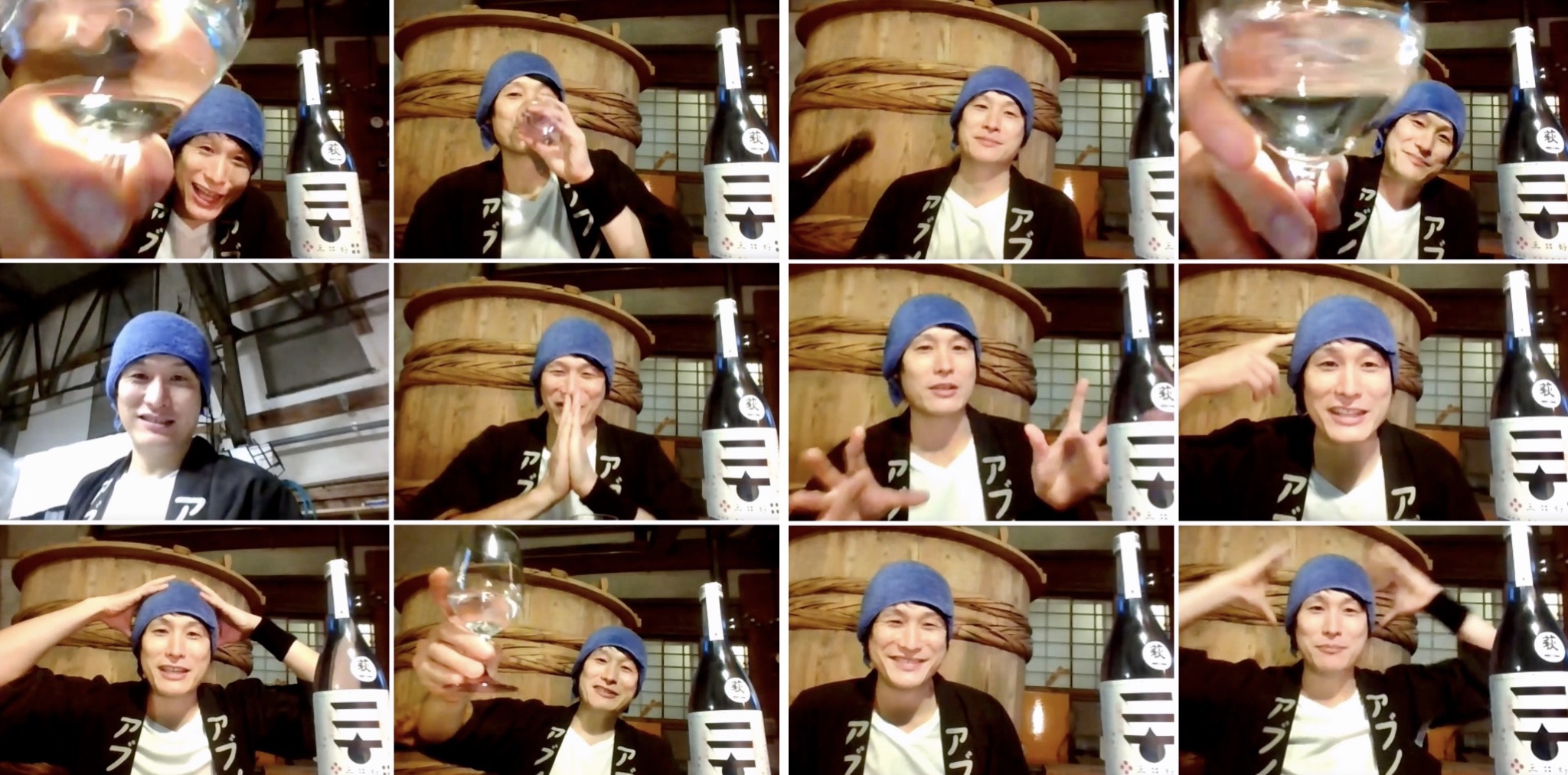
Monday 30 August, 2021, saw session number 56 in the TWTT series take place as we Zoomed in to spotlight Abu no Tsuru in Yamaguchi Prefecture.
Joining us for this session was Kuramoto and Toji, Ryutaro Miyoshi, who, for the most part, works alone at the brewery ~ other than for a short period in the midst of brewing season where he has 2-3 people working alongside him.
The brewery was originally established in 1915 but stopped brewing in 1983 and was basically dormant for over 30 years.
Enter Ryutaro Miyoshi, who, (to cut a long story short), after around 7 years of training and working in other breweries throughout Japan, came back to Yamaguchi and his grandfather’s brewery, (which had stopped brewing before he was even born), and basically created a new brewery inside an old one. The brewery re-opened in 2017 and is now producing around 200-250 koku per year.
Prior to his life as a sake brewer, Miyoshi-san studied Architecture and worked in Interior Design. Upon the realisation that this was not the life for him, Miyoshi-san spent the following several years training at breweries in Chiba, Saitama, Gifu, Aomori and then finally, prior to re-opening Abu no Tsuru, he trained, worked and produced his own sake at Sumikawa Shuzo under the guidance of Yamaguchi sake legend, Sumikawa-san.
On taking a virtual tour through the small brewery, we were shown some of the old equipment that Miyoshi-san still houses at the brewery but does not use. One of the original ‘elements’ that is still functioning and very much in use is the well that provides the brewery’s water source. A look through some photos taken during brewing season showed us their fune press, (their only method of pressing), with it’s heavy components and depth, which explained why Miyoshi-san requires a little extra humanpower during this stage of the process.
Around 90% of the rice they use is Yamada-Nishiki grown in the terraced fields located close to the brewery – around a ten minute drive we are told. The brewery also use small amounts of other rice, including Yamaguchi-grown (and Yamaguchi’s own) Saito no Shizuku.
Miyoshi-san certainly has a creative background and creativity is a driving force for him at Abu no Tsuru. This is evident of course when you look at the development of the Miyoshi brand and the brewery’s very modern, striking and symbolic labels. For example, the three ‘1s’ that decorate the Miyoshi label, (more obvious in character when rotated 90% to the right), represent not only the 3 core ingredients in sake (rice, water, koji), but also the 3 key players in ‘business’, (maker, seller, buyer/consumer), working in harmony. The 3 lines are also symbolic of the first character in the Miyoshi family name, ( ‘Mi’ is written 三 ).
Further driving that creativity into today, it was great to learn about his latest project, Miyoshi Hana ~ a 5 year project. The idea being, that every year, the Miyoshi Hana sake will contain sake from the current year, blended with sake made in 2020. The first release contains sake from 2020 and 2021. Each year, as the blend evolves, so does the label design – starting as a red bud and ending in a red flower. The idea behind Hana was inspired by the difficulties seen by the world in 2020. Miyoshi-san wanted to take something from 2020, (a seed/sake), and encourage it to blossom. Making something beautiful/positive from a not so beautiful time. Along with Hana, wouldn’t it be lovely to see the world evolve in such a beautiful way?
As always, the 2 hours went by very quickly, with still so much more to learn, ask, listen to. After wrapping up the session, Miyoshi-san said he’d stay on with those who were still online for a ‘little bit’ longer…. that turned into another 2 hours!
A huge thank you to Ryutaro Miyoshi for sharing his time, story and vision, with us all… and then even more time with some of us! An extension of that huge thank you goes out to Jim Rion for his superb co-host and interpretation skills – two weeks running too! ありがとう ございました。お疲れ様でした!
A big thank you also to Maki Tanaka and Rumiko Moriki for their help during the nijikai!
Thank you also to everyone who attended this session.
Taste with the Tōji ~ Session 55:
Kumiko Kaba
Yachiyo Shuzo
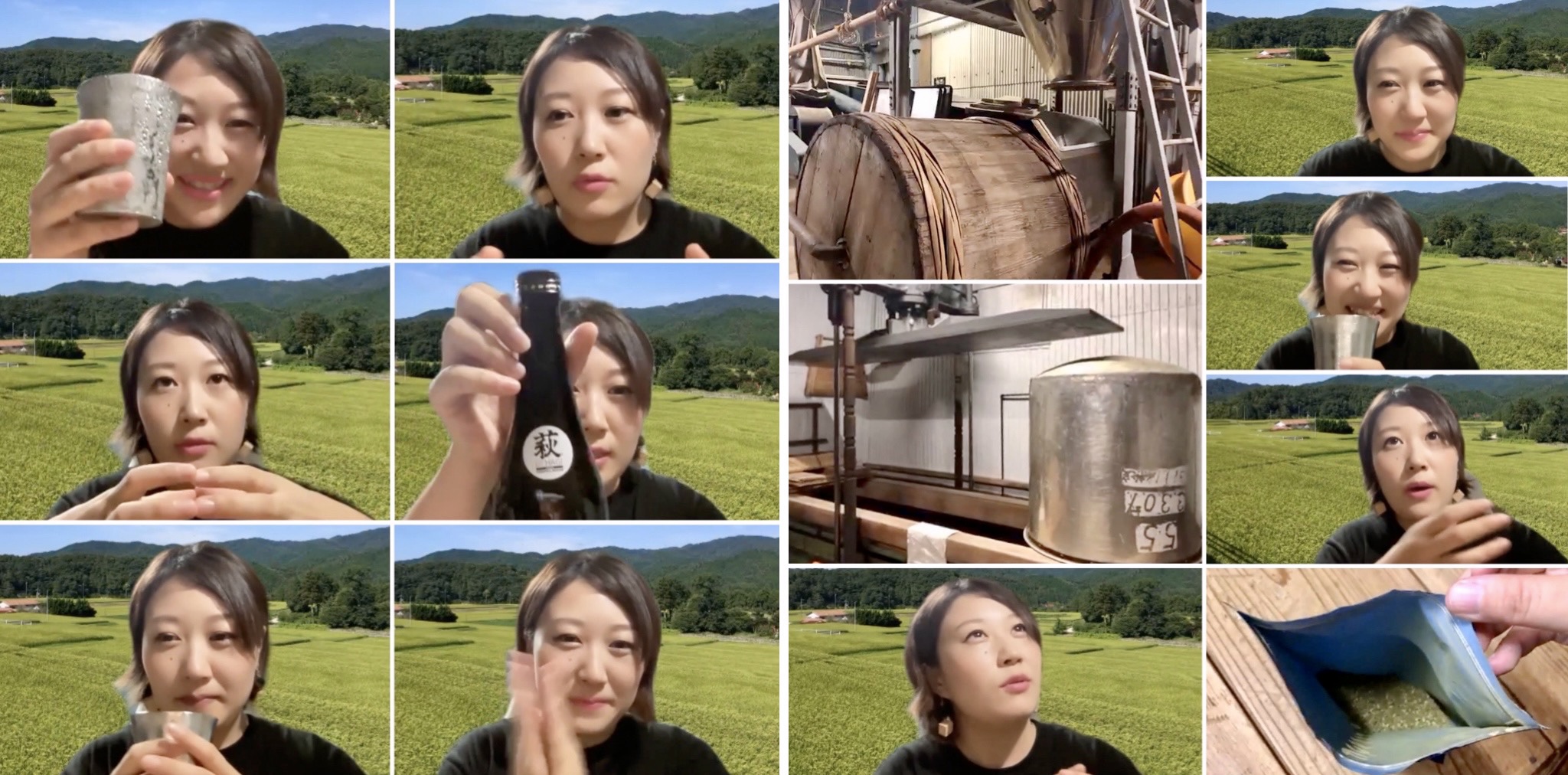
Monday 23rd August, 2021, saw a delightful TWTT session, marking the 55th in the series, as we spent a few hours with a remarkable young woman, Kumiko Kaba, from Yachiyo Shuzo.
Yachiyo Shuzo was founded in 1887 in Hagi, Yamaguchi Prefecture. Last night, we learned that the building itself has an older history beyond Yachiyo, as it had been an active sake brewery prior to the Kaba family purchasing the premises. The brewery currently produces between 100-150 koku – quite a small amount of sake. They once produced around 10 times this amount, but like a number of breweries in recent times, decided to focus on quality over quantity.
Yachiyo Shuzo have their own rice fields and have been growing Yamada Nishiki rice for over 20 years. Though not all the rice they use is grown by them, they only use rice grown in Yamaguchi, including the prefecture’s original sake rice, Saito no Shizuku.
Kumiko-san took us on a virtual tour of the brewery, where we got a good look at their very unique (and somewhat antique) fune press – the only pressing facility they use (and have ever used) at Yachiyo Shuzo…. remembering this brewery was once producing around 1000 koku! Quite extraordinary and a lot of hard work!
Kumiko Kaba is the oldest of 3 sisters and prior to working at the brewery, had a career as a nutritionist. She worked for 17 years at hospitals and nursery school before returning to her hometown in 2017 with a view to taking over the family business and preserving the sake culture that had been passed down from generation to generation. After all, the brewery’s name, YACHIYO, inspired by a line in Japan’s national anthem, hints at an ‘unbroken line of generations – past and future’ ~ Kumiko-san is the 5th generation at the brewery, now paving the way for future generations.
On her return (to her hometown and the brewery), she focused mainly on sake sales and re-design of lables / re-branding. Realising she knew very little about the actual brewing process, she decided she needed to learn the craft and in 2019, she started her training at nearby brewery, Sumikawa Shuzo. It was at Sumikawa Shuzo that she produced a new brand of sake and began her journey towards becoming the next Toji at her family’s brewery, Yachiyo Shuzo. Her gratitude towards Sumikawa-san was certainly evident as she told us her story – and what a wonderful story it was/is! So encouraging to see that kind of support within the industry.
It was great to hear a little about her label ROOM and the concept behind it, and also the innovative MARBLE group that Kumiko-san is part of, which she refers to as a ‘food cycle unit’. Here she has the opportunity to use her history, or knowledge, as a nutritionist, to create new food products using by-products of the sake brewing process.
Kumiko-san is now only in her 2nd year as Toji at Yachiyo Shuzo. Despite only being in her position at the brewery for such a short amount of time, she displays an incredible sensibility, understanding, connection and vision – in every aspect of the business. The future for Yachiyo Shuzo sure looks bright!
As always, there was so much more we could have asked, talked about and listened to ~ but what we did manage to cover in a few hours was truly enjoyable and spending time with Kumiko-san was a delight. A huge thank you to Kumiko Kaba for sharing her time, story, passion, innovation and vision with us all. An extension of that huge thank you must go out to Jim Rion for a being a most wonderful co-host and doing a terrific job with interpretation.
Thank you also to everyone who joined this session!
Taste with the Tōji ~ Session 54:
Takahiko Ohkura
Ohkura Honke
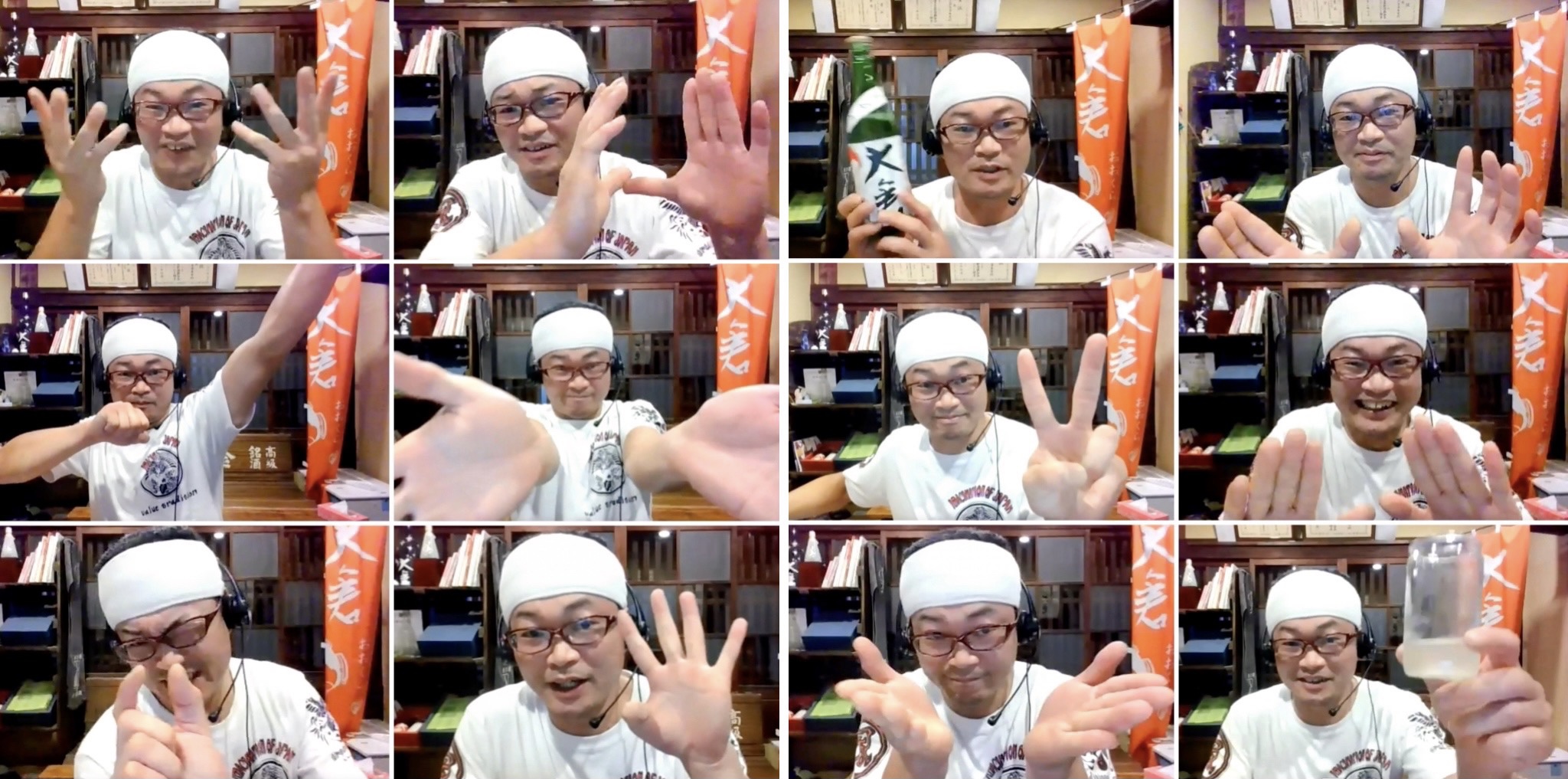
Monday 16 August, 2021, saw a very colourful TWTT session when we headed to Nara Prefecture to hang out with Takahiko Ohkura, from Ohkura Honke, for a few hours.
This was session #54 in the TWTT series and was certainly a most unique one.
Ohkura Honke was established in Nara Prefecture in 1896, near Mount Iwahashi, part of the Karsuragi Mountain range.
Takahiko Ohkura is the 4th generation Kuramoto and last night he told us that 20 years ago, he could not have imagined he would be working in the sake industry, let alone running his family’s brewery. Ohkura-san was working in an office/sales job, completely unrelated to sake, when his father fell ill in 2000. Prior to his father’s health deteriorating, the brewery itself had fallen on hard times and it was becoming a struggle to keep the business afloat. The hard decision to cease brewing and close their doors was then made.
At the time of the brewery’s closure, Ohkura-san (Takahiko) was still not planning to return home and take over from his father ~ however, one day, whilst reflecting on the seriousness of his father’s condition and the loss of the family business, a ‘spark was lit’ inside him and Takahiko returned home and tried to convince his father to allow him to step in and rebuild the business. Apparently, this took some time… with Takahiko’s lack of knowledge and experience, his father, (Katsuhiko Ohkura), was apprehensive about the idea at first, but slowly, slowly, Takahiko convinced him to allow him to at least try.
They reopened in 2003, and the previous Toji, who was in his eighties, returned to work at the brewery. Ohkura-san worked under him for 5 years before taking over the role of head brewer in 2008.
In the time that the brewery was closed, they continued to sell sake from their rather large stockpile. Prior to their closure, and back in their peak, the brewery had been producing around 6000 koku! And what’s more, that entire 6000 koku was consumed within the Prefecture (Nara)… I still cannot even get my head around that!
Granted, the sake they were producing back then was very different to what they make today, with the majority – back then – being futsushu.
Today, they run with a staff of only 2 people, producing a modest 300 koku, and a very different style of sake indeed. Ohkura-san says they are a ‘small and free-spirited brewery’ with an ‘open-minded approach to sake and what it can be’. Around 80% of the sake they produce today is brewed in the Yamahai method. Ohkura-san is determined to keep old brewing styles/techniques alive and well. He also utilises another traditional method in ‘mizumoto’, and Ohkura Honke is one of a handful of breweries that hold a licence for making doburoku, or ‘dakushu’.
A colourful, animated character with a free-spirited approach, using some of the most traditional methods in sake brewing, and definitely a hard worker.
With so many breweries being forced to close their doors when falling on hard times, it was nice to hear the story of how one was revived ~ allowing the family legacy to carry on.
A big thank you to Ohkura-san for sharing his time, animation, energy and humour with us. A big thank you also to my co-host and interpreter, Julian Houseman, for a great job and for keeping up with the wild paced energy and conversation. There’s never a dull moment running this TWTT project and every session is unique, as is every brewery and brewer.
Thank you to everyone who attended this session.
Taste with the Tōji ~ Session 53:
Takanobu Mori
Seto Shuzo
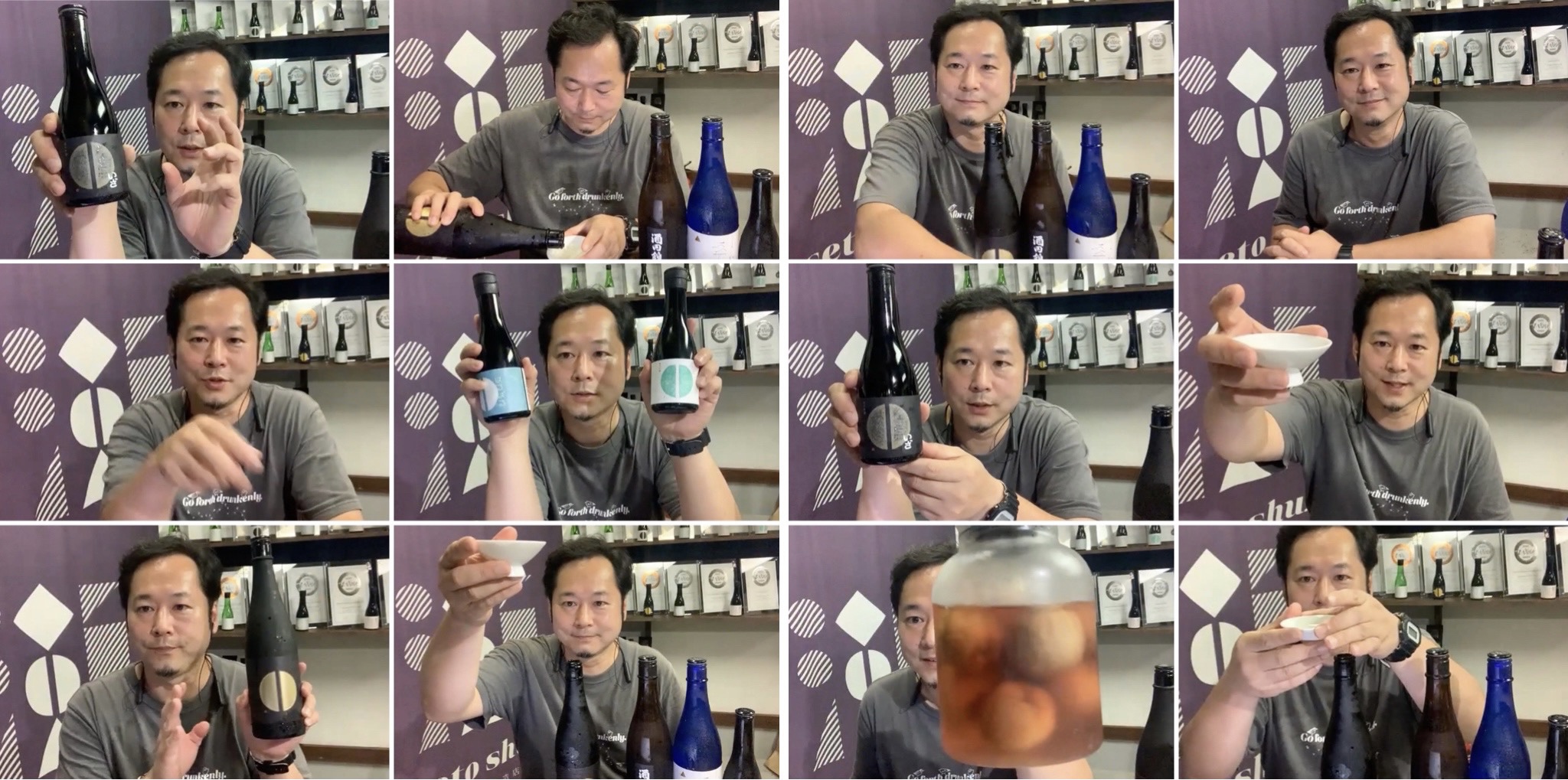
Monday 16 August, 2021, saw TWTT present its 53rd session in this ‘online’ series, which was yet another insightful and enjoyable event. For this session, we headed to Kanagawa Prefecture to visit Seto Shuzo and spend a good couple of hours with Takanobu Mori.
Seto Shuzo was founded in 1865 in Kaisei Town, Kanagawa Prefecture, however, in 1980, they were forced to close, thus, brewing ceased that year.
Fortunately in 2018, the brewery, which, at the time, had recently been taken over by Takanobu Mori and his hand-picked team, were able to resume brewing and contribute, once more, to the town’s local development.
A wonderful story of vision, determination and hope, and the things one can achieve with enough of each of those!
The brewery was pretty much dormant for the best part of 40 years, however, in the short time since Mori-san and team took over operations, not only have they been recognised with numerous awards for their sake, but they have created a very focused and strong branding model that looks set to take the brewery into a successful future.
As always, so much to discuss, so little time ~ the 2 hours flew by, and even with an extra half hour of Q&A, there was still so much more we could’ve asked…
In that time, however, it was a fascinating discussion; listening to Mori-san’s story and, of course, how he found his Toji – which, astonishingly, was through Hello Work! The weather was a little wild last night in Kanagawa, so we forfeited the kura tour and instead viewed a couple of short videos and a powerpoint presentation, learning about their OH steamer, their use of flower yeast (specifically Hydrangea), the rice types they use, and that they are growing some of their own Yamada-Nishiki, their branding, local culture, their forward thinking, and the real meaning of ‘go forth drunkenly’!
We even got to meet the brewery dog, Seto-chan, who also appears on some of the brewery’s merchandise.
A most inspirational and insightful session and I am sure, when travel opens up to more of us, this will be a destination on the itinerary of many.
A huge thank you to Takanobu Mori for sharing his time, passion, story and vision with us all. An extension of that huge thank you goes out to Christopher Hughes for a wonderful interpretation as well as sharing his knowledge of and enthusiasm for Seto Shuzo.
Thank you also to everyone who attended this session.
Taste with the Tōji ~ Session 52:
Chisa Aoki
Aoki Shuzo
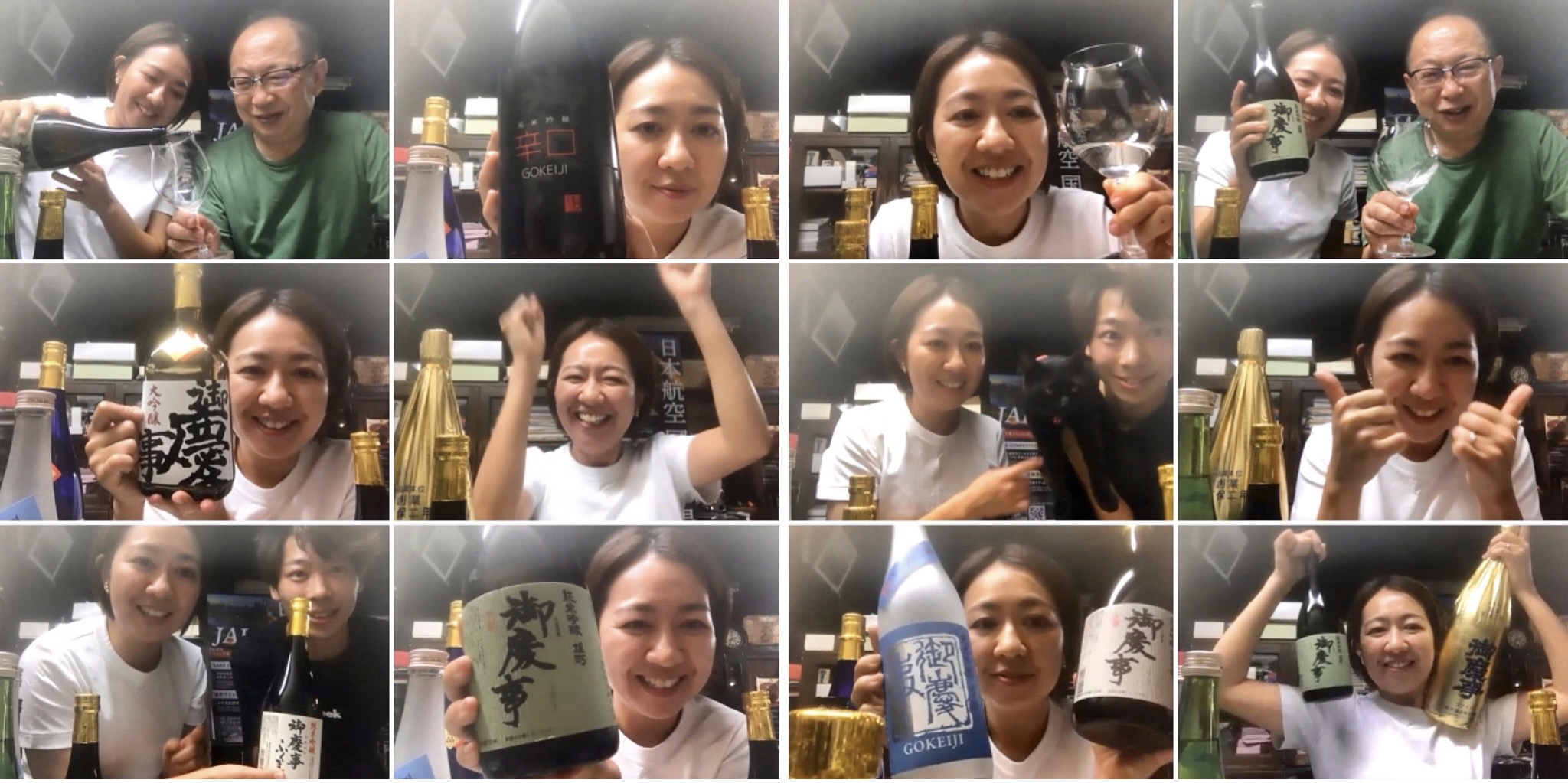
Another delightful TWTT session was held last night. This one was session number 52 in the TWTT series ~ where we headed to Ibaraki Prefecture to chat with the delightful Chisa Aoki from Aoki Shuzo.
Aoki Shuzo was established in Koga City, (NOT the Ninja one!) 1831.
They are currently the only sake brewery in Koga City, Ishikawa.
This small, family run brewery is best known for their Gokeiji label, which is brewed using rice grown locally (in ibaraki) ~ including Hatachi Nishiki and Fukumaru varieties. The name Gokeiji, itself, translates as ‘greatest celebration’, quite fitting as last night felt very much like a joyful celebration and an exciting look at the future of Aoki Shuzo though Chisa-san and her brother, Yoshinobu-san, who will succeed their father, Shigenobu-san, in running the brewery.
It was wonderful to be able to say hello to both her brother, and her father, towards the end of the session… oh yeah, and not forgetting Yamoto-chan, (the Kura cat!). The song ‘Family Affair’ had already started in my head when a few people aptly typed it in the chat. Clearly, this is a family who love sake… and we at TWTT love that!
In terms of size/production, Aoki Shuzo are relatively small, producing around 300 koku per year…. however, despite this, they have a surprisingly large range/line-up of sake.
It was interesting to hear, that prior to working at the brewery, Chisa-san was pursuing a career in nursing, (a story we have heard before in the TWTT series with Shintani-san), however, despite enjoying her work, one day, in a discussion with her boss about the future, her boss had encouraged her to do something that only she can do… For Chisa-san, this resonated with her and a light suddenly went on! In that moment, she realised just how important the family brewery was, and what a unique opportunity she had to follow in her father’s footsteps. The shoes fit her perfectly and she’s never looked back.
Her father, in his brief chat with us, mentioned how excited he was to have his daughter, and his son, as his successors – leading the way forward for their family brewery. He believes that exciting things are to come for Aoki Shuzo!
A huge thank you to Chisa-san for sharing her time, enthusiasm, passion and knowledge with us all. An extension of that huge thank you must go out to Harald deRopp for a wonderfully enthusiastic interpretation – he’s clearly a big fan of this brewery and was delighted to be able to introduce Aoki Shuzo to a new audience last night. Thanks Harald!
Thank you also to Shigenobu-san, Yoshinobu-san, (and Yamoto-chan), and of course, to everyone who attended this session.
Taste with the Tōji ~ Session 51:
Eriko Terada
Asahi Shuzo | Juji Asahi
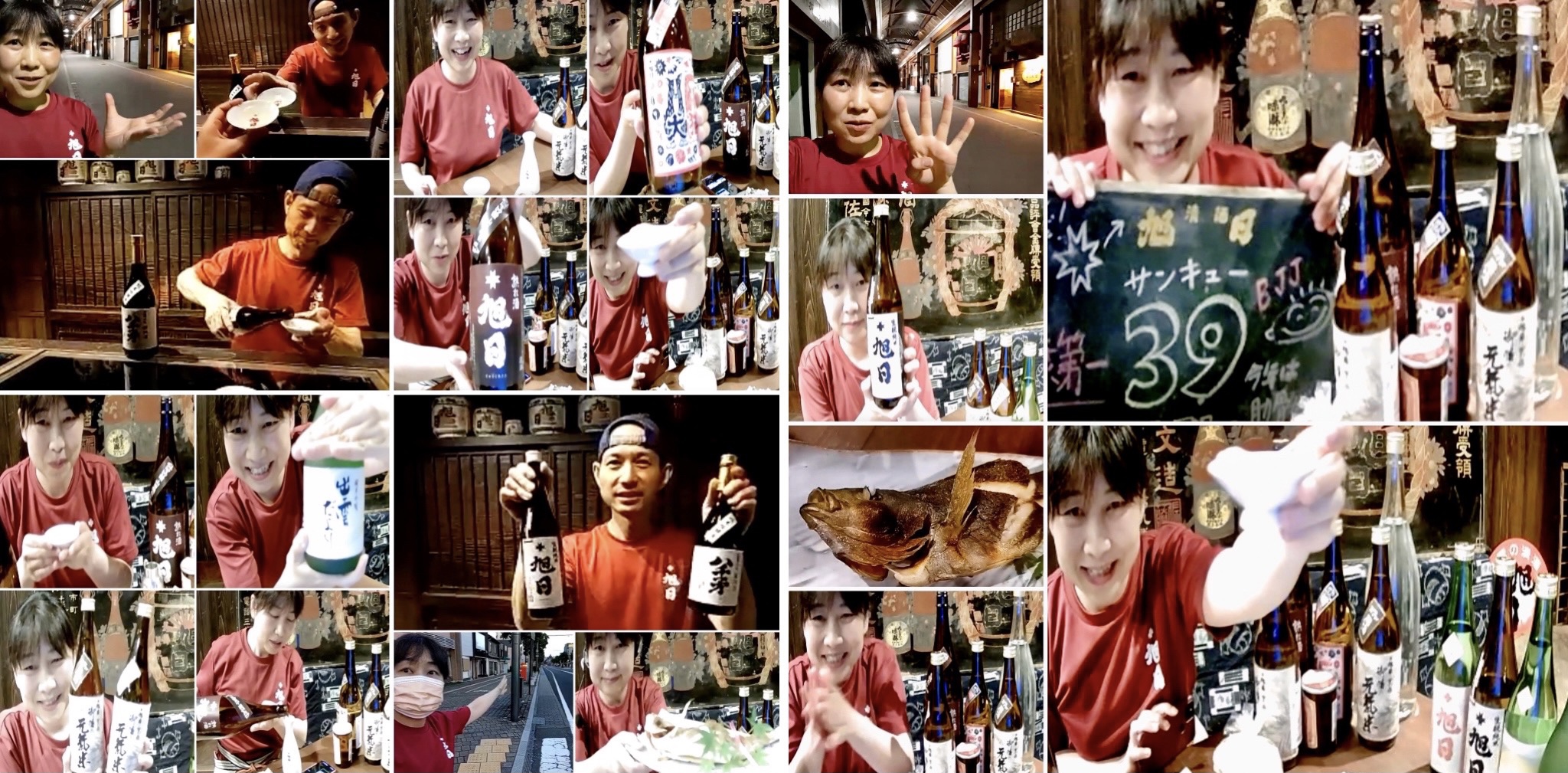
Monday 19 July saw a truly delightful session, the 51st session in the TWTT series.
A long session, and a long nijikai (or ‘after party’), that still left us with so much yet to cover. Pretty sure session No. 2 for this brewery will be happening sometime!
The brewery I speak of is Asahi Shuzo, producers of Juji Asahi, located in Shimane Prefecture, and last night we had the absolute pleasure and honour of chatting to the lovely Eriko Terada.
This was always going to be a fun session and last night saw a few things done a little differently in a most delightful fashion. A few firsts for TWTT and I’m most grateful for some of the wonderful ideas thought up by Eriko-san and Justin for this session. As mentioned during the session, Justin visited the brewery late last week and together, they nutted out some fun ideas for this session for the TWTT audience to enjoy! I just wish I could’ve been there to join them… but these online events continue to be a great way for many of us to stay connected to, and within, the sake community.
It was also great to see a handful of other brewers from previous sessions attend the event last night.
The session started on the streets, a TWTT first, as we got a virtual tour of the area surrounding the brewery…. a said 5 minute walk from Izumo station. Remarkably easy to get to for a brewery of this nature, and one creating exceptional handcrafted sake. I think members of the Japanese audience were ready to jump on a train to Izumo station after enjoying this session ~ and most of us outside of Japan, who are yet to visit Shimane, have certainly added it to their ‘wishlist’ itinerary.
Eriko-san then walked us to the brewery, which is located in a shōtengai (shopping mall) that is dotted with some fine looking eateries and an array of shops, including a local sake store. On entering the brewery’s charming tasting room and shop area, we were given a quick look inside their ‘secret cellar’ which sports a sturdy door made from the wood of an old kioke barrel.
Back in the tasting room, Eriko-san’s husband Kouichi-san was there waiting to say hello and to introduce a couple of bottles from their line-up, including a sake they make for Izumo Taisha (Izumo Shrine). すごい!
After a quick Kanpai! with this dynamic duo we headed on a virtual tour of the brewery itself. Of course, like many breweries at this time of the year, not much was happening inside the kura, but it is always fascinating to see the inside these wonderful buildings that have such an impressive history ~ this particular one being around 100 years old.
Back in the tasting room, the conversation flowed freely as sake flowed amongst a group of keen participants. So many things covered, yet so many things not covered ~ with the official session hitting a little over 3.5 hours…. the nijikai, almost just as long! With Eriko-san outstaying me by a mile! Kudos! So generous with her time and a wonderful storyteller and communicator.
Eriko-san, in another TWTT first, took us on a little trip outside the brewery to check in with a couple of local eating establishments. Unfortunately, (or fortunately considering the current goings on), both places were a little too busy for us to engage with either but it certainly made for an intriguing element and those venues are now on many people’s list as ‘must visits’. A little later, her fish, and some attractive side dishes, from one of the venues arrived and it all looked very delicious.
Asahi Shuzo is a small brewery with a big heart, a big heart shared by Eriko-san, who is essentially the guiding force at the brewery. She wears many hats and it’s important to point out that she is involved in every aspect of the brewery ~ her and her husband basically share the role we know as Tōji, and everything they make is thoughtfully crafted together.
Listening to Eriko-san talk about sake was an absolute delight. She’s a bright light full of beautiful sentiments and statements that certainly resonated with many. Speaking about the element of time and the nature of a place in relation to making kimoto… how the process of making sake, for her, involves engaging in all 5 senses…. relating sake to people and the various encounters you have with one person (or one sake). Various encounters, leaving various impressions…. Eriko-san certainly left a lasting impression on us all and we look forward to Juji Asahi Round 2 sometime in the future.
A huge thank you ( or *39! ) to Eriko Terada for sharing her time (a lot of it!), passion, sentiments, philosophy, experience, knowledge and sense of joy with us all. An extension of that huge thank you goes out to Justin Potts for a whole lot more than just a remarkable interpretation. Always more than a co-host and always going above and beyond and always delivering the goods.
*for anyone who missed the event, 39 is now our new way of saying thank you… or san kyū , thanks to Eriko-san
A big thank you (39!) to everyone who attended this event and kudos to those who stayed on after I left! A marathon effort!
For those in Australia who are yet to try Juji Asahi – you can order their sake online from Sakenet.
Taste with the Tōji ~ Session 50:
Yohei Sato
Hagino Shuzo
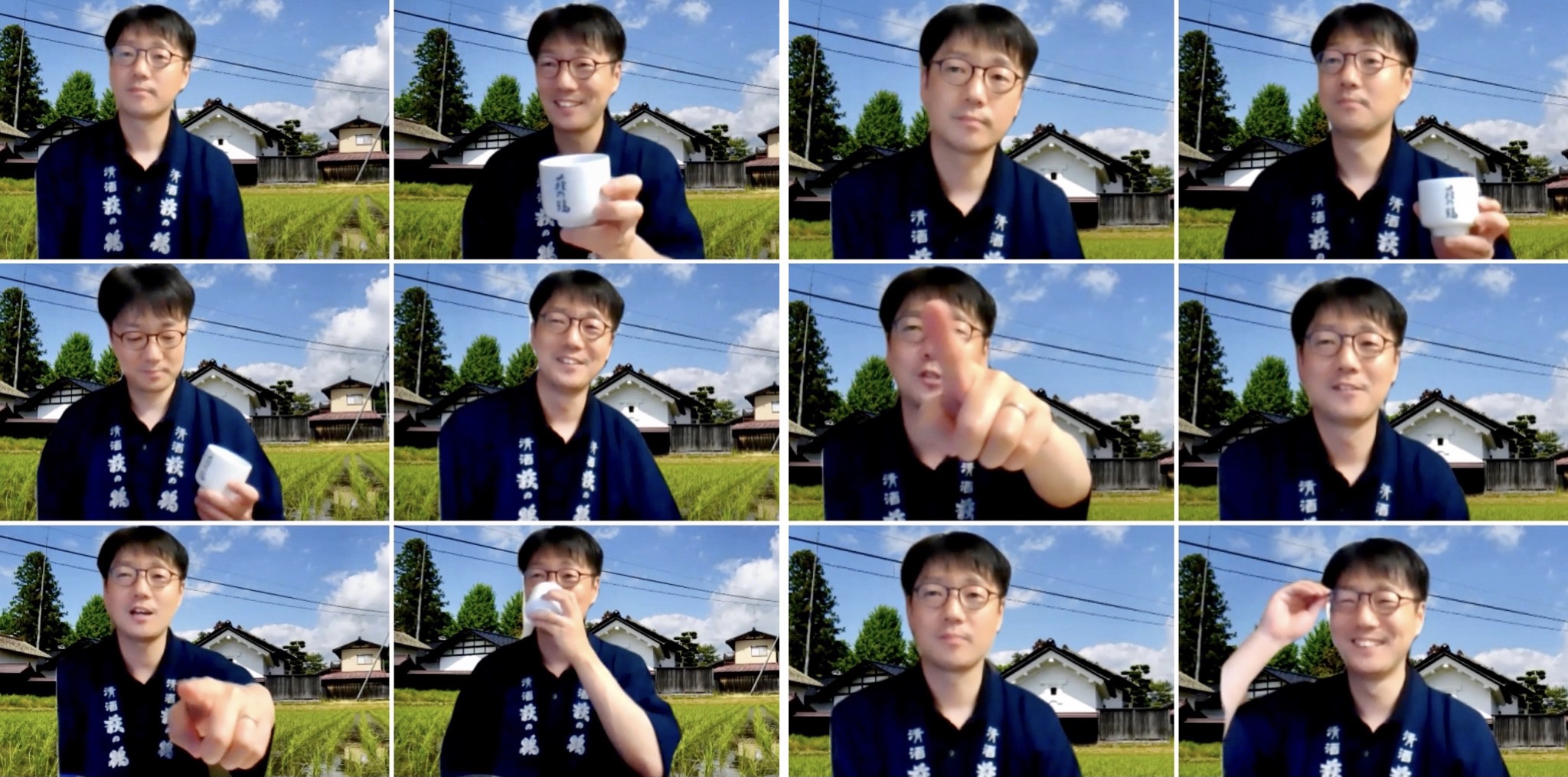
Monday 12 July, 2021, saw TWTT hit its 50th session milestone as we headed to Miyagi Prefecture – for the first time in this series – to spend time with Yohei Sato, (8th generation), from Hagino Shuzo.
In another first ~ it was the first full session interpretation/translation by my sake pal Harald deRopp, who did a wonderful job!
Prior to the session, Harald and I thought it would be kind of fun to encourage everyone attending to wear a pair of glasses, in any shape, form or function. The reason for this being that Hagino Shuzo, under their label Hagi no Tsuru, produce a sake called ‘Megane Senyou’, (for glasses only)… glasses, as in the kind you wear, not drink from.
It’s fairly well known that 1st October is Nihonshu no Hi (or more commonly known outside of Japan as World Sake Day)… however, 1st October is also ‘Glasses Day’ in Japan. Inspired by this date and by the fact that all the brewers at Hagino Shuzo wear glasses, the brewery released ‘Megane Senyou’ in 2015, complete with a paper pair of glasses with every bottle, to be sure to cater for those who didn’t already have their own pair! The label continues to be popular to this day and it was wonderful to not only see some people were able to access that particular sake for last night’s session, but to see so many people, (in addition to those who require them), don a pair of glasses… in the spirit of the session!
Hagino Shuzo was founded in 1840 at the end of the Edo period. Their flagship brand is Hagi no Tsuru – the name is derived from the old name of the area: Hagino Village.
The brewery was newly constructed in 2012, after suffering damage due to the effects of the Great East Japan Earthquake a year earlier.
Sato-san had put together a comprehensive and informative 59 page powerpoint presentation for this session, covering everything from local landscape, local rice (and others), to the construction of the new brewery. As well as their shift from Yamahai to Kimoto… to their process and their product line up… and lots more.
In addition to their ‘Hagi no Tsuru’ label, the ‘Hiwata’ label was introduced after Yohei Sato joined the brewery. We learned too, that 98% of the sake produced at Hagino Shuzo is Junmai.
Another enjoyable and insightful session of TWTT. A huge thank you to Yohei Sato for sharing his time, knowledge, passion and humour with us. An extension of that thank you must go out to Harald for his translation/interpretation for this session – it was clear to me from the get-go how much Harald loves this brewery so it was wonderful to have him on board for this one!
Thank you also to everyone who attended TWTT’s 50th session!
Taste with the Tōji ~ Session 49:
Kazutaka Takashima
Takashima Shuzo | Hakuinmasamune
Monday 5th July saw the 49th session of Taste with the Tōji ~ and the first time featuring a brewery from Shizuoka Prefecture.
Takashima Shuzo was founded in Namazu, Shizuoka Prefecture, in 1804. For last night’s session we were joined by Kazutaka Takashima, the current Kuramoto and Tōji at Takashima Shuzo.
Takashima-san was most generous with his time, chatting with us about philosophy, food and everything in between, for a good 3 (not the ‘set’ 2) hours. It’s becoming harder and harder to tie these sessions down to just a 2 hour period – there is always so much more to learn, to ask, to listen to.
Part of Takashima’s philosophy is focused on the importance of truly local sake being the ultimate ‘communication’ tool. He also touched on the difference between sake that is made to be enjoyed warm and sake that is enjoyable when served warm ~ with his aim being to create the latter – sake that is enjoyable at any, or every, temperature.
Food was a big feature in this session. The relationship between food and sake is something very close to Takashima’s heart. We were even treated to a live demonstration of the best way to grate fresh wasabi! Seems most of us were doing it wrong!
From simple pairings like toasted nori to some more complex dishes and flavours, Takashima’s presentation and discussion around food was not only inspiring, but left most of us incredibly hungry.
Fascinating to listen to, Takashima-san also discussed his method of heating sake: Mushikan ~ which is literally a ‘steaming’ technique. He had us braced for a live demonstration, however, the Wifi took precedence over powering his sake steamer, which then lended itself to an extra hour of conversation that included an explanation in lieu of a demonstration. I foresee a number of DIY sake steamer projects happening amongst the TWTT audience in the near future.
A truly enjoyable session and as mentioned, Takshima-san was incredibly generous in sharing his time, along with his knowledge, values, philosophy and passion, with us all. A huge thank you to Kazutaka Takashima and of course to Justin Potts for a wonderful and thoughtful interpretation of a truly unique session. Respect!
It’s such an honour to be able to feature some truly amazing breweries for TWTT and it is also an honour to be able to work alongside some truly remarkable and inspirational folks along the way!
A shoutout to all the members of the TWTT translation team!
Thank you also to everyone who attended this session.
Taste with the Tōji ~ Session 48:
Junpei Kubo
Kubo Honke | Suiryu
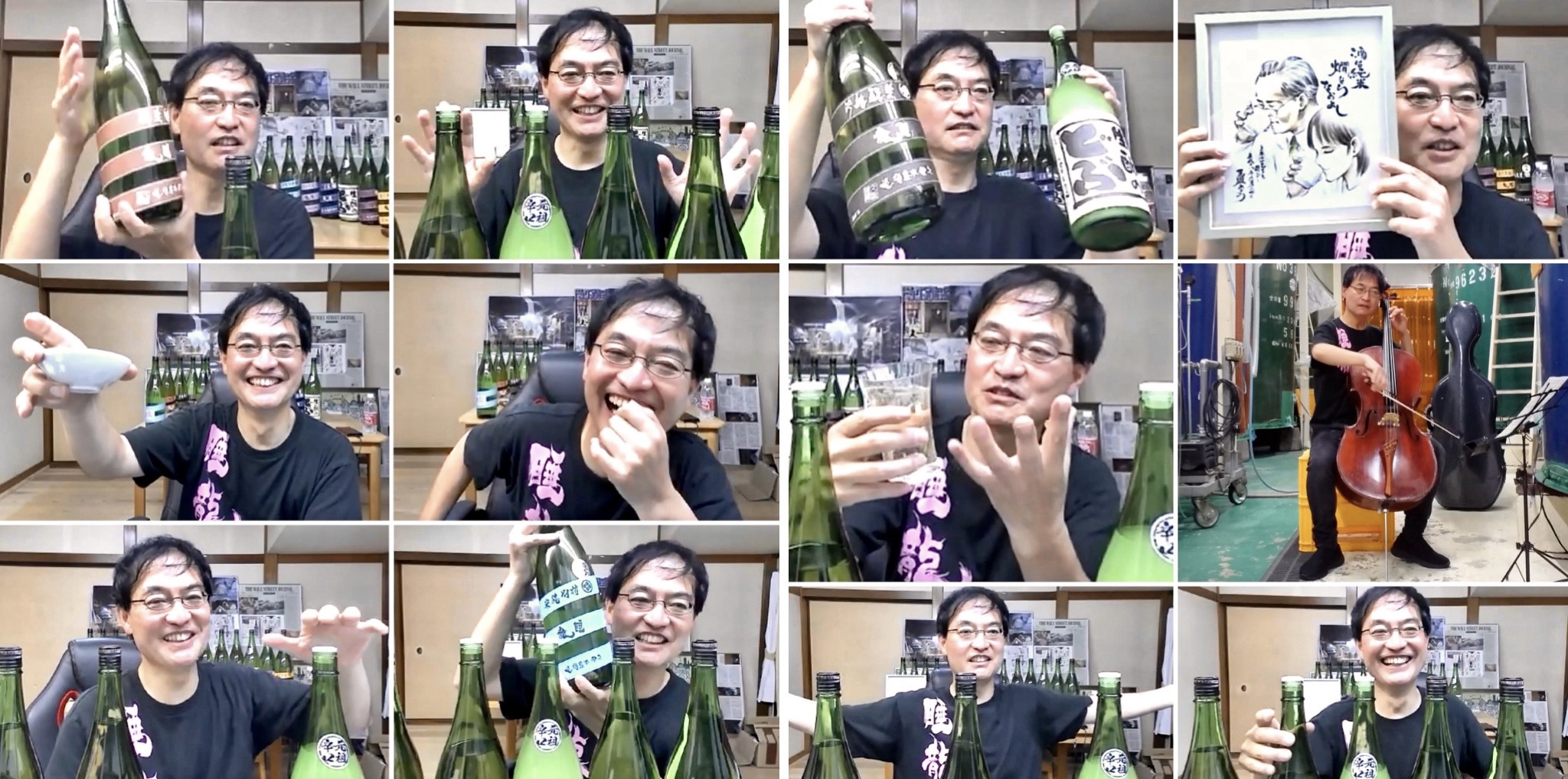
Monday 28 June saw another wonderfully insightful and enjoyable session of TWTT. This was Session #48 in the Taste with the Tōji series and saw us head to Nara Prefecture to spend a delightful 2 hours, (then another 2 for those that stayed on), with Junpei Kubo from Kubo Honke.
The brewery was established in 1702 in Uda City, Nara Prefecture.
Junpei Kubo is the 11th generation Kuramoto, and together with the current Tōji, Kato-san, has been striving to develop the best Kimoto sake they possibly can. Kato-san is considered a master of the kimoto method and his Suiryu and Kimoto no Dobu sake has a respected following throughout Japan.
Kubo Honke’s kimoto is more delicate than most kimoto out there and it is the brewery’s wish to create sake that marries perfectly with, and doesn’t overpower, the food enjoyed alongside it. Kubo-san and Kato-san run a small, tight ship at the brewery, which produces roughly 500 koku per year.
Kubo-san came into this session well prepared and was a delight to listen to. We got to hear about Kubo-san’s life in the banking industry, which included a stint in London, before coming back to his hometown and eventually leaving the banking world and taking over at the brewery.
The key phrase for last night’s session was ‘perfect fermentation’. Referred to as ‘Kanzen Hakkō’ in Japanese, this ‘perfect fermentation’ is both a philosophy and methodology, and the discussion around this was most insightful. The roots of such were traced back to Uehara-san, a name that has been brought up in a number of past TWTT sessions and a name synonymous with this philosophy and has certainly inspired many of today’s brewers.
Last night we opted to show a pre-recorded brewery tour instead of a live tour due to an unstable WiFi connection inside the kura. Kubo-san talked us through the brewing process at Kubo Honke from rice washing and steaming to koji making and the kimoto starter method.
Listening to Kubo-san was really quite fascinating and there was definitely no short answer for anything, with Kubo-san sharing in-depth and thought-out answers and information, interpreted so thoughtfully and beautifully by Justin Potts. This explains why, after the 2.5 hour session, a group of around 30 people continued to hang out with Kubo-san asking questions and engaging in conversation for yet another 2 hours.
We also had the pleasure of listening to Kubo-san perform 3 pieces of music on the cello.
Whilst I have not actually met Kubo-san in person, after a couple of extensive Zoom meetings in the lead up to last night’s event, which included a lot of laughter, as well as a lot of back and forth on the email, I feel like he’s now an old friend! I am incredibly grateful to him for sharing his time, knowledge, energy, experience and humour with us all.
That gratitude extends to Justin Potts for a marathon effort and most wonderful translation/interpretation last night. Justin’s respect for Kubo-san and this brewery was evident from the moment a Kubo Honke TWTT session was discussed and their rapport was delightful to witness both during the session and in the meetings leading up to last night.
Thank you also to everyone who attended this session.
I must also thank the guys at
Sakenet for bringing Kubo Honke’s sake to Australian shores.
Taste with the Tōji ~ Session 47:
Miho Fujita, Rumiko Moriki
and Kuniko Mukai
MIOYA | MORIKI | MUKAI
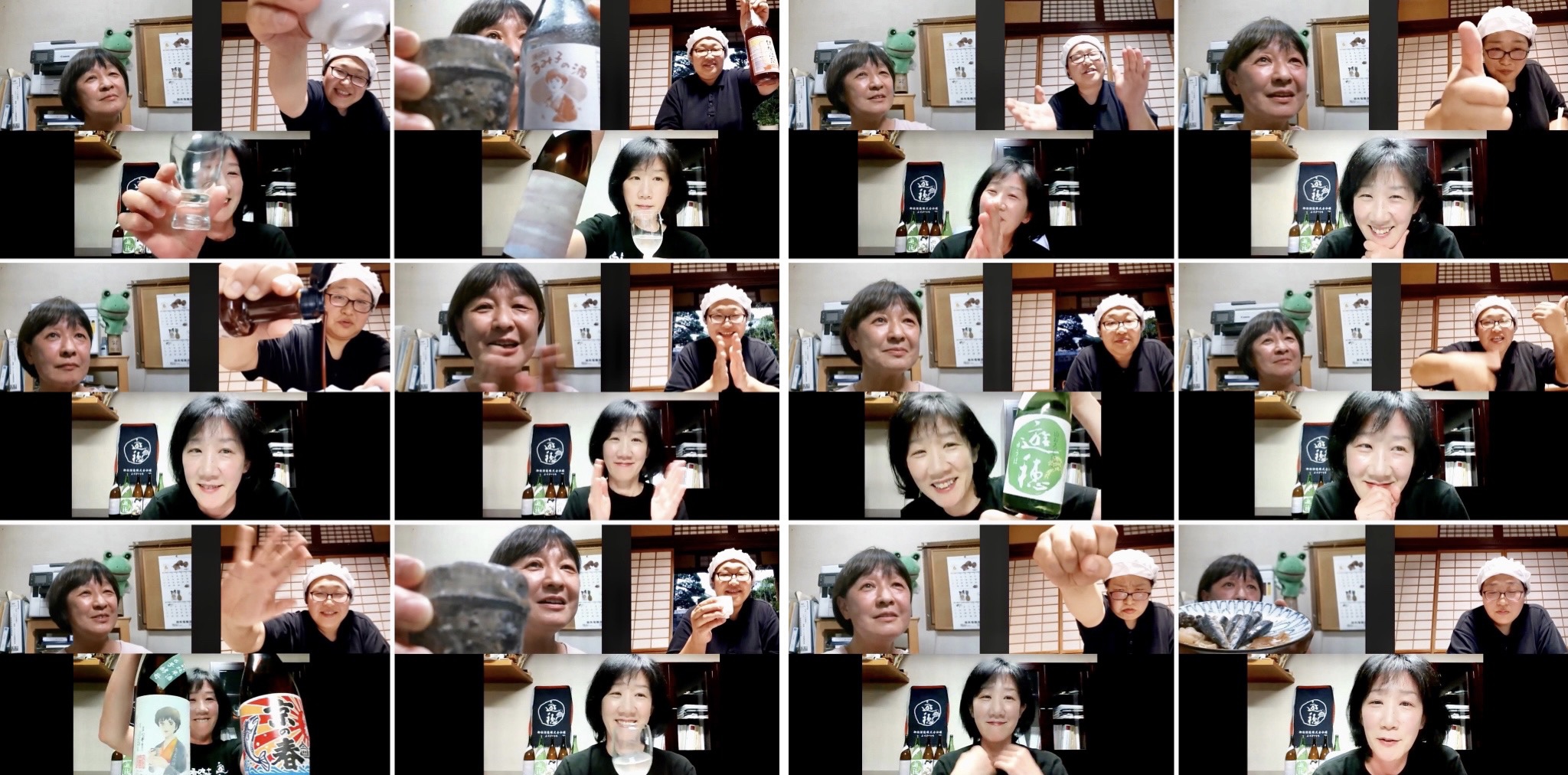
Monday 21 June saw an absolutely fabulous and most enjoyable session of TWTT! I am still kind of at a loss for words as there is really nothing I can say to explain how truly incredible and inspirational I think these women are.
It was an absolute joy to spend over 2 hours hearing from three powerhouse women, Miho Fujita, Rumiko Moriki and Kuniko Mukai, who, along with the delightful Akemi Wegmüller, filled the Zoom room with a most wonderful and infectious energy.
These 3 women featured individually last year, early on in the TWTT series: (Moriki Shuzo, Session #2 | Mukai Shuzo, Session #5 | Mioya Shuzo, Session #8), so it was great to catch up with them and find out what has been happening since we last spoke and to hear their thoughts on the past year and a half and the resulting impacts ~ both good and bad.
This was only the second panel style session in the TWTT series, which now has 47 sessions under its belt, and one never quite knows what to expect with these types of events – but one thing that was a certainty, was that it was going to be a lot of fun – and that, it was!
Despite discussing some more serious issues about the state of the world and the industry, it was such an inspiration to hear how all three women have turned so many negatives into positives – and with that have been humbled by the lessons they have each learnt during this difficult time. These women have embraced change, no matter what form that has come in, and it was encouraging to hear their stories, thoughts, hopes and vision for moving forward.
From new products, to new mindsets, collaborations and cooking companions – that sake kasu shoyu looked incredible! This session may just have planted the seed (or seeds) for a number of future sessions and projects and I think we all agree that Kuniko-san needs her own cooking show! Or perhaps the Rumiko & Kuniko Music Show? Those who stuck around until the end were treated to a joyous impromptu performance! Perhaps, next time, we can hear Miho-san play the piano.
After 47 sessions of TWTT, there is definitely a strong sense of community within this group and it’s so wonderful to see that spirit has also resonated with these three women. I just hope they truly realise how wonderful we think they are!
A HUGE and heartfelt thank you to Miho Fujita, Rumiko Moriki and Kuniko Mukai for lighting up our screens and sharing their time, wisdom, recipes, music, joy and hope with us all. A huge extension of that huge thank you to Akemi Wegmüller for an incredible and dynamic translation/interpretation for this session and for adding to the infectious sense of joy that filled the Zoom room.
Thank you also to everyone who attended this session.
I must also thank
Black Market Sake for bringing sake from all three of these remarkable ladies to the shores of Australia.
Taste with the Tōji ~ Session 46:
Noriyoshi & Matsumi Nagai
Nagai Shuzo | Mizubasho
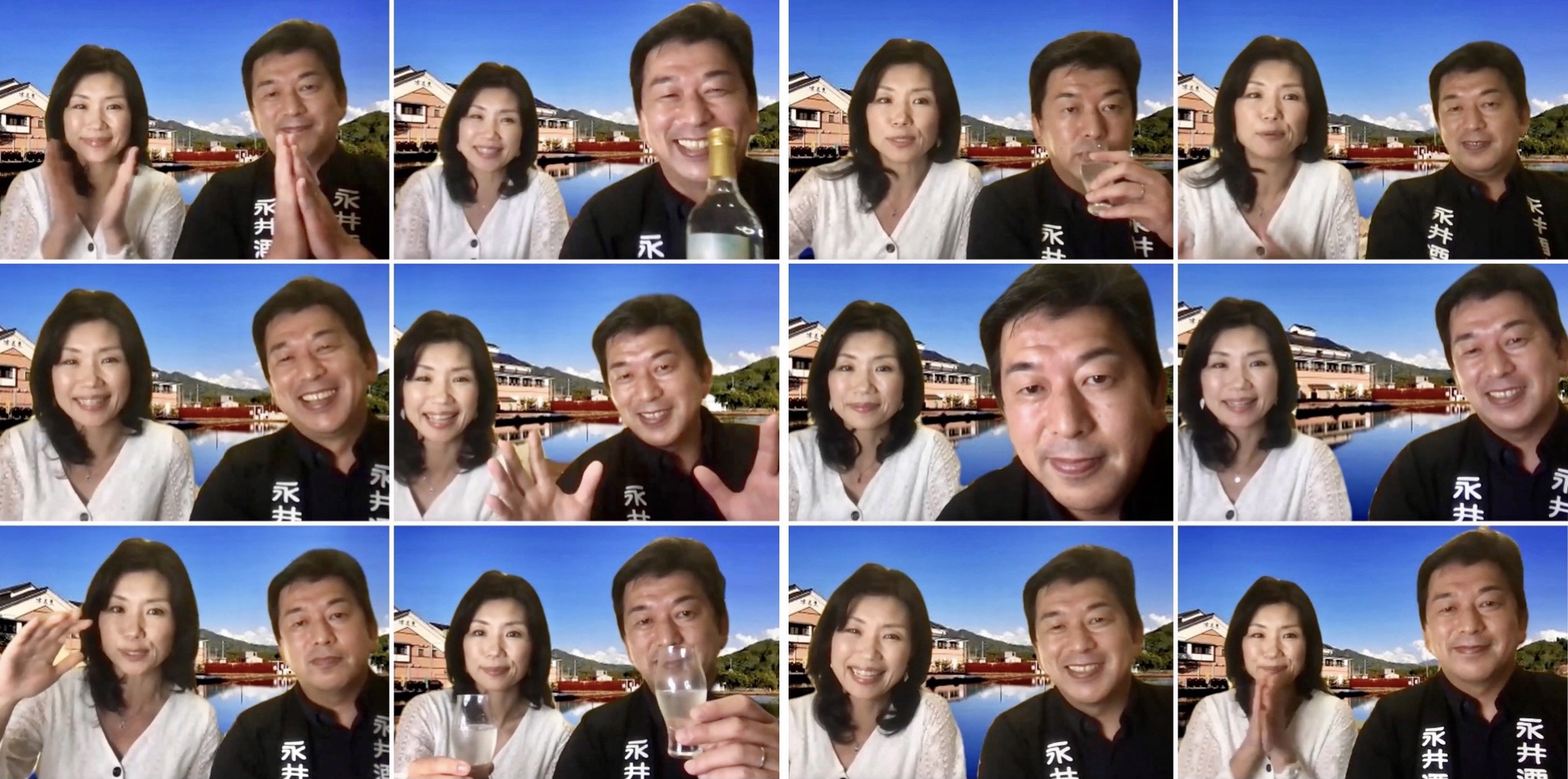
Monday 14 June saw TWTT head to Gunma Prefecture for the very first time and spend a joyous couple of hours (and a bit) with Matsumi and Noriyoshi Nagai from Nagai Shuzo.
Nagai Shuzo was established in 1886 in Kawaba Village, a small, mountainous town in Northern Gunma. An area abundant with nature, which includes Oze National Park, Mt. Hotaka and Mt. Tanigawa, and of course known for its pristine water. The name ‘Kawaba’ basically translates to ‘place where the river is’. The water, of course, was the inspiration of the brewery’s founder, Shoji Nagai, who purchased land at the base of Mt. Hotaka, with access to clean, soft, mineral-rich spring water, which he saw as ideal for brewing sake.
Noriyoshi Nagai is the 6th generation Kuramoto and CEO and a pioneer in the world of naturally sparkling sake. Last night we heard a little of what was a long, determined journey that endured 5 years, a research trip to Champagne, and around 700 failures to perfect a technique: The outcome – Mizubasho PURE Sparkling Sake.
Matsumi told us that many people thought her husband, or rather, his quest, was a little mad, however, it’s amazing what determination, dedication and passion can achieve. In 2008, Noriyoshi Nagai accomplished his mission, producing the first clear sake in Japan to be naturally sparkling. Of course, as many of you know, the 2 TWTT hours go very quickly, so we really only scratched the surface of the topics: secondary bottle fermentation, authentic Champagne method and carbonated pressure…. all topics for another session I’m thinking!
After each session, there is always so much more we could discuss, so many questions still to ask and answer. We did, however, cover a lot of ground in the 2.5 hours, touching on Yukihotaka rice, (which grows in the fields right in front of the brewery), as well as the Mizubasho flower, (also known as Skunk Cabbage, but Mizubasho has a much nicer ring to it!). Mizubasho is of course the name they chose for their most well known range of sake and represents the nature that surrounds the area.
We also got to hear about their Mizubasho Artist Series and some of their collaborations with not only local artists but conservation work with the local community ~ all with a link to the Mizubasho flower, and, ultimately, with nature.
Sadly, the number of Mizubasho flowers in the area has steadily declined over recent years, (since 2007), due to the local deer discovering and devouring them, devastating the once flourishing area in Oze National Park. Working with the local community, the brewery introduced the Mizubasho re-planting project – the project aims to plant 20,000 Mizubasho, (they take 3 years to grow), by 2030.
Nagai Shuzo is certainly a brewery full of passionate projects. It was a joy to learn more about some of these projects/stories last night. A huge thank you to Matsumi Nagai and Noriyoshi Nagai for sharing their time, passion, vision, experience and philosophy with us all. A big thank you to Charles Stewart for the initial introduction and to Maki Tanaka and Harald deRopp for their wonderful help with translation/interpretation of some of the explanations and Q&A after being thrown into the deep end by me at such short notice.
Thank you also to everyone who attended the Zoom room for this event.
Taste with the Tōji ~ Session 45:
Yuichi Tsubosaka
Sanyouhai Shuzo | Banshu Ikkon
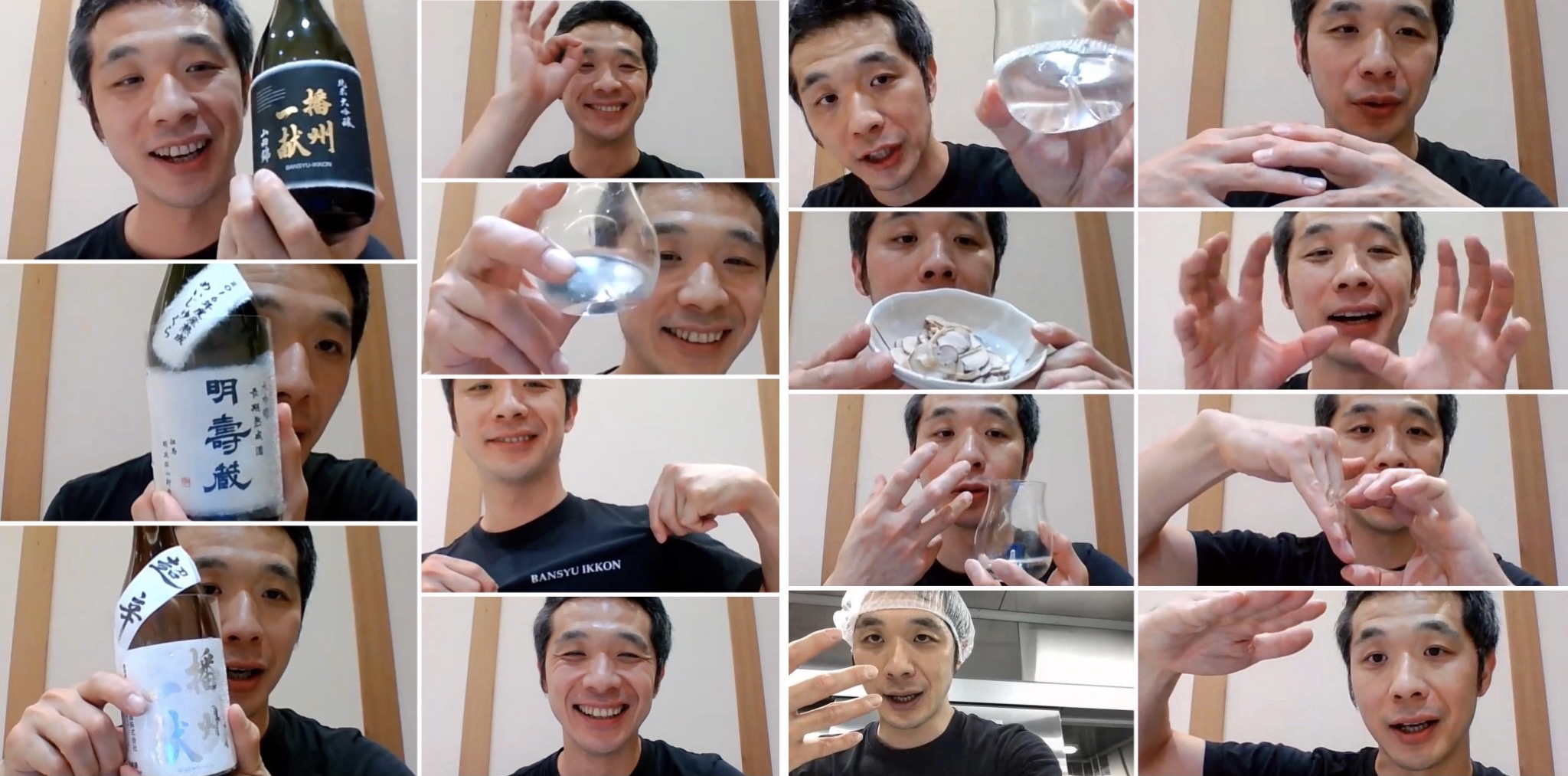
Monday 7th June saw yet another informative and enjoyable session of TWTT when we headed to Hyogo Prefecture, for session #45, to spend time with Yuichi Tsubosaka from Sanyouhai Shuzo, producers of Banshu Ikkon sake.
Yuichi-san is the 7th generation Kuramoto, and also happens to be the Tōji, at Sanyouhai Shuzo. The brewery was founded in 1837 in Shisō city in Hyōgo Prefecture.
Yuichi came to the brewery 12 years ago after working in a different field, followed by a brief stint working for a sake wholesaler. He then worked under the previous Tōji, who was part of the Tajima Tōji Guild, for 6 years before taking over the role at the brewery.
Sadly, in 2018, a fire broke out in the brewery, burning most of the then 182 year old brewery to the ground. Yuichi’s determination was more of a force than any fire, and they managed to resume work at the brewery within a couple of days after the devastating fire. Fortunately the main brewing building, housing the kōji room, a number of brewing tanks, pressing facilities and a storage area, was spared severe damage from the fire. The sake that had been stored inside this building was examined and had fortunately avoided any smoke taint, so bottling was able to be resumed.
Yuichi was certainly well prepared for this online session, presenting a 25 page powerpoint presentation, then switching over to his iPad to take us on a virtual tour of the new brewery building, housing a very new-age style kōji room. Stainless steel galore from the walls to the futa trays ~ you could check your reflection in almost every nook and cranny of that room!
The new building’s facilities have not yet been used for sake making but it was interesting to see they had a small tank of cider bubbling away, (apparently the area is also quite well known for their apples). The cider being a little side project and a way to ‘test’ or ‘try out’ this new environment.
It was also interesting to learn a little more about the mine in which they do all the ageing of their sake. Once a copper mine, around 800 years ago, then later used for mining silver and tin. The mine officially closed for business in 1987. Currently, the old mine site has around 8,000 isshobin of sake stored inside it! The oldest being from 22 years ago.
A huge thank you to Yuichi Tsubosaka for sharing his time, passion, knowledge and stories with us. An extension of that thank you must go out to Christopher Hughes for a great translation/interpretation for this session.
Thank you also to everyone who attended this session of TWTT.
Taste with the Tōji ~ Session 44:
Shigeri Shiraki
Shiraki Shuzo | Daruma Masamune
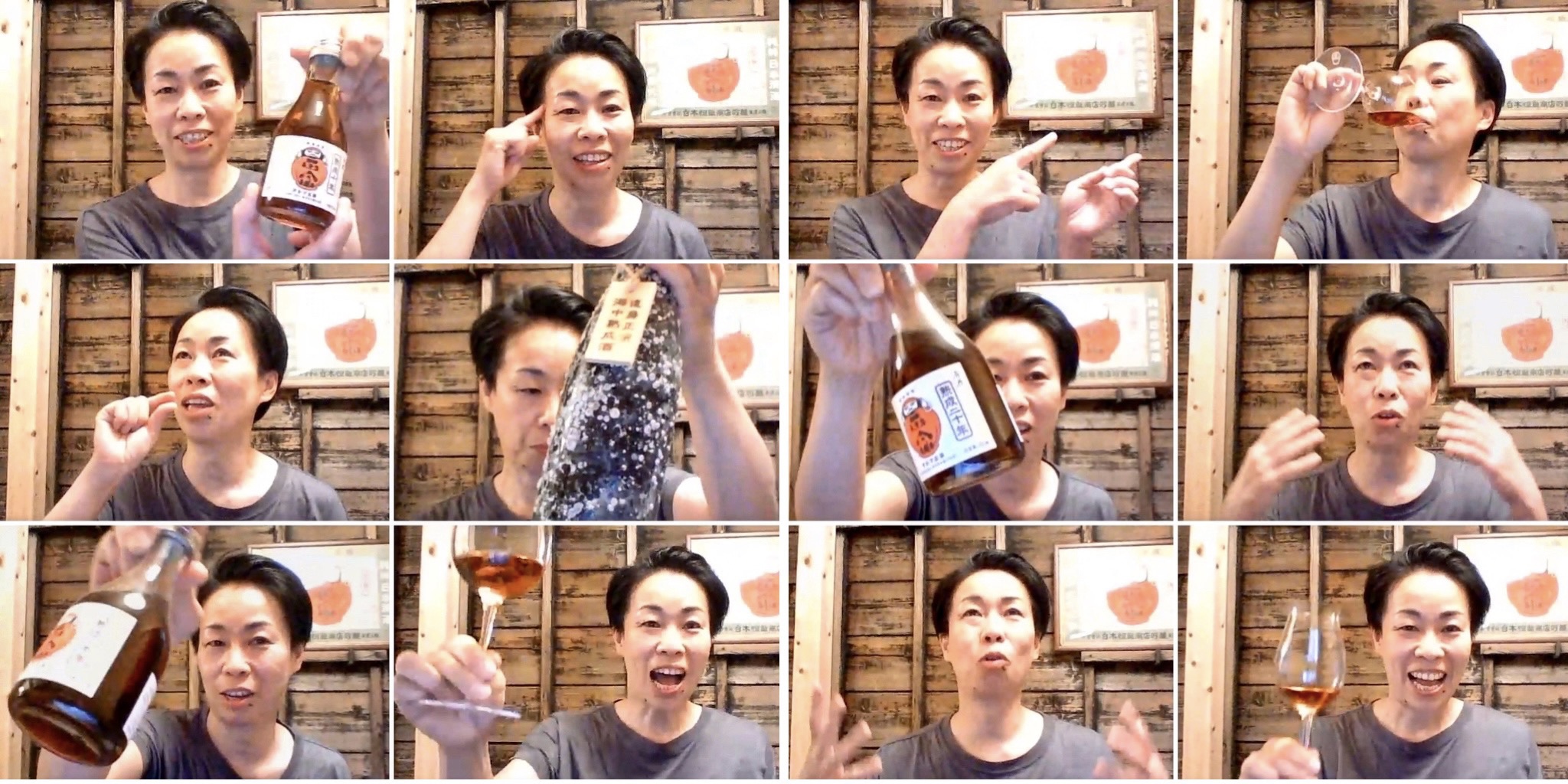
Monday 31 May saw TWTT head to Shiraki Shuzo in Gifu Prefecture for session #44 in this series.
Joining us for this session was the delightful Shigeri Shiraki (7th generation Kuramoto of the brewery).
Shiraki Shuzo are possibly most well known, today, for their Daruma Masamune brand of Koshu, (aged sake), but they also produce another label, (sake other than Koshu), under the name of Uszumi Zakura.
Last night, however, our focus was on their Koshu.
Shiraki Shuzo have been brewing sake since 1835, however, they did not start focusing on Koshu until 1971.
It was, in fact, Shigeri-san’s father, Yoshiji Shiraki, who decided to take the brewery in a new direction and started to focus on Koshu.
His idea was sparked when he discovered 5 ‘forgotten bottles’ of sake in the brewery. When he opened these bottles, he was impressed with not only the golden colour, but the wonderful taste. He then did a little ‘research’ into Koshu, Shigeri-san told us, and discovered that Koshu was once common enough until the end of the Edo period (around 1850), but had not been around much after the war due to the heavy liquor tax that was introduced back then.
Yoshiji-san decided he wanted to see this style of sake revived in the current market, he also wanted his brewery to make a unique product in order to survive in a market that had become more competitive in the wake of the 1964 Tokyo Olympics ~ and thus began his quest for a Koshu revival!
Many thought he was a little ‘out of his mind’ when he announced that this was the direction he wanted to take the brewery. However, Yoshiji-san stuck to his beliefs and thus began a new legacy for the brewery.
The Koshu they produce is made from Nihonbare rice, (a table rice), milled to 70%. Their aim is to maximise the amount of umami from rice.
Shigeri-san, one of three daughters, did not expect she would one day be Kuramoto of the brewery, she thought it would perhaps be her older sister who would follow in their fathers footsteps. What is clear though, is that she is where she was meant to be ~ her passion for what she is doing, and for sake, certainly shines through.
Her sisters are not involved in the brewery, however, the Tōji just happens to be her husband. Hitoshi-san took on the Shiraki name when he married into the family.
It was an absolute joy to spend time with Shigeri-san, who also took us on a virtual tour of the kura last night, which included an introduction to her 1 year old Labrador, Ken-chan, as well as a look inside their storage containers, boasting an impressive collection of aged/ageing sake.
A huge thank you to Shigeri Shiraki for sharing her time, energy, knowledge, history and passion with us all. An extension of that thank you must go out to Maki Tanaka for yet another wonderful translation/interpretation.
Thank you also to everyone who attended this session.
Daruma Masamune, of course, was named after the Daruma doll ~ who, no matter how many times it may fall over, will get back up and ‘rise again’.
May Shiraki Shuzo, and all sake breweries, rise above the hardships of this current situation and flourish in the future.
Taste with the Tōji ~ Session 43:
Yoshifumi Fujii
Fujii Shuzo
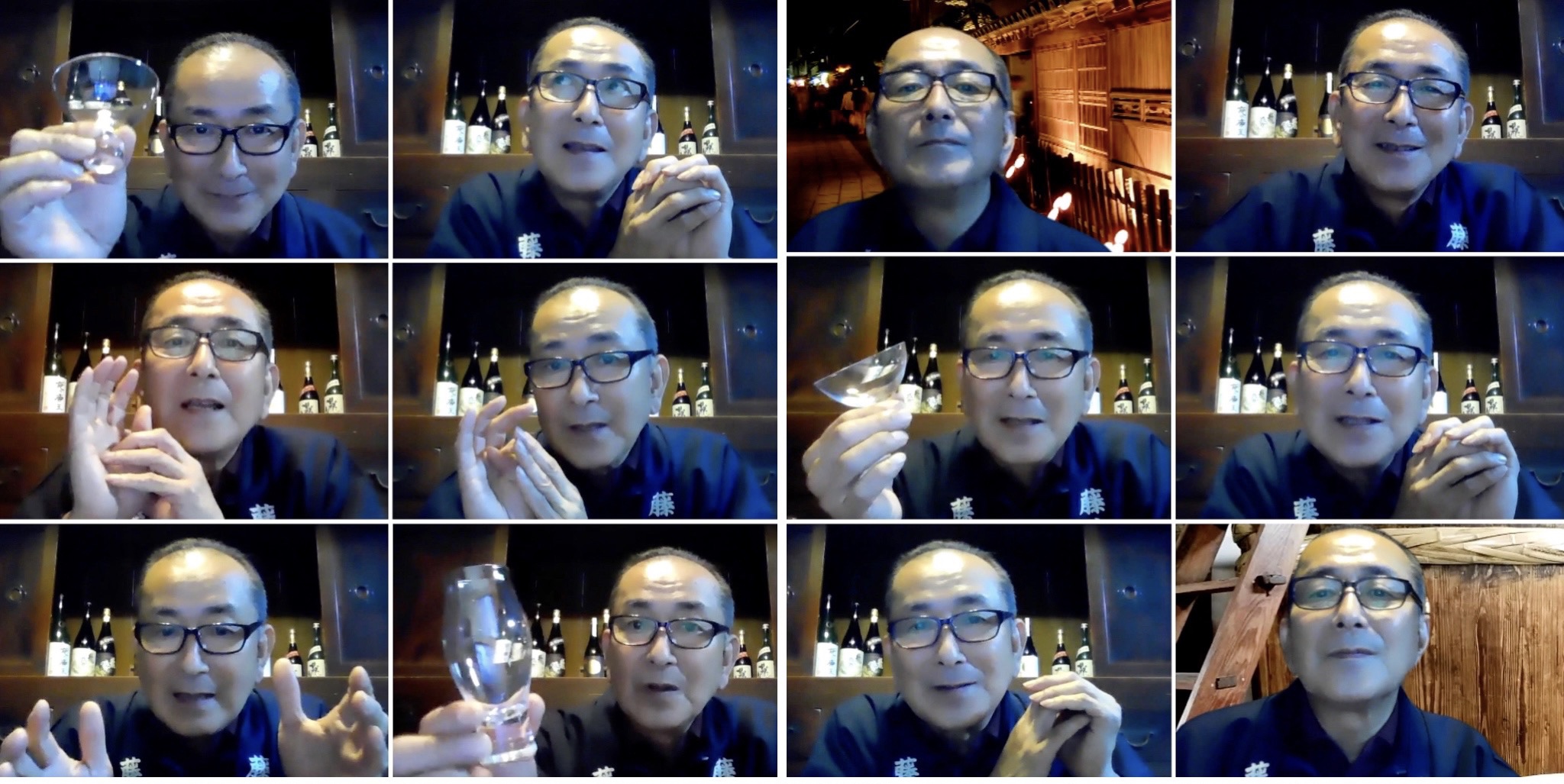
Monday 24 May saw yet another wonderful session of TWTT when we headed to Takehara in Hiroshima Prefecture, for session #43, to chat with 5th generation owner of Fujii Shuzo, Yoshifumi Fujii.
Fujii Shuzo was established in 1863, in the picturesque town of Takehara, situated along the Seto Inland Sea ~ which was around the same time that Senzaburo Miura developed the ginjo style of sake in the neighboring town of Akitsu, where Imada Shuzo (TWTT Sessions 1&11 is located). Fujii-san commented that walking through the streets of Takehara feels a little like you are stepping back in time.
In 1907, Fujii Shuzo put Hiroshima Prefecture’s new style ginjo sake on the map when they won Japan’s first national sake competition with their “Ryusei Zenshichi” sake.
Takehara is also blessed with high-quality water, optimal for brewing sake.
Fujī Shuzo is an all junmai brewery ~ using only rice, koji, water and yeast to brew their finely crafted sake. Fujii Shuzo have a strong focus on producing sake to be enjoyed alongside meals: Shoku-zen-shu. We learnt last night that they also focus on brewing sake using the kimoto method.
Fujii-san believes in maintaining a good balance between keeping true to traditions, as well as progressing with the times. The brewery is currently run by both Yoshifumi Fujii and his son, Norihiro Fujii ~ who will continue the Fujii family and brewery legacy moving forward.
It was truly delightful to spend a little over two hours with Fujii-san last night ~ a huge thank you to him for sharing his time, passion, knowledge and stories with us. An extension of that thank you must go out to Maki Tanaka for a truly wonderful job at translating/interpreting for this session!
Thank you to everyone who attended this session.
Taste with the Tōji ~ Session 42:
Maiko & Soichiro Tsuji
revisiting Tsuji Honten | Gozenshu
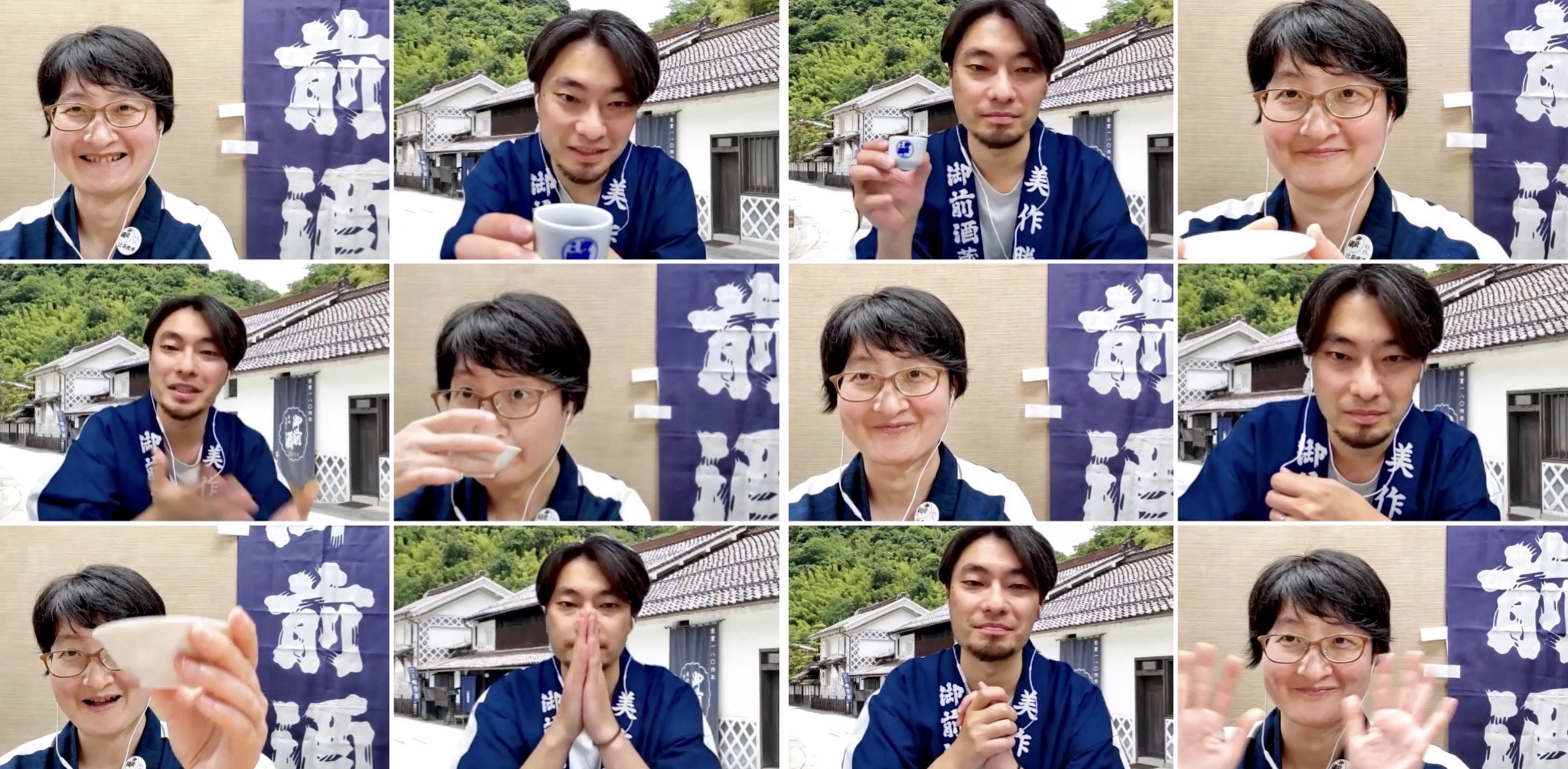
Monday 17 May saw another insightful and enjoyable session of TWTT. It was great to re-visit the Tsuji siblings, Maiko & Soichiro Tsuji, at Tsuji Honten – Gozenshu in Okayama Prefecture and see what has been happening since they last featured on TWTT 12 months ago.
Pioneers of brewing with Omachi rice and the Bodaimoto method, it was great to get a little more insight into both topics and to see how they have progressed in their quest to become an all Omachi, all Bodaimoto brewery ~ it seems they are well on their way to achieving that goal in the not too distant future.
Last night we delved a little deeper into the Gozenshu Bodaimoto method, which was ‘revived’ by the brewery in 1984, and how it differs from the original Bodaimoto from around 600 years ago. The key factor being the use of Koji, (and secondly the timing involved), to create their Soyashi water.
The ‘all Omachi’ aspect was thought, by many, a bold move when first discussed during the session last year ~ but the in-depth discussion, last night, around Omachi rice and the grading system, their Tokujo Omachi Project and their innovative Trilogy series certainly shone a light as to why this move is perhaps not as limiting as some first thought and allowed for a better understanding about the path they’ve chosen. Their path, indeed, sounds like an exciting one ~ especially for the many Omachi fans among the TWTT community (and beyond)!
We look forward to seeing where Gozenshu are at with their progress come May 2022 and hope that the next brewing season is a bigger and better one for all breweries.
A huge thank you to Maiko and Soichiro Tsuji for once again giving us their time, and sharing their passion, knowledge, progress and vision with us all. An extension of that thank you going out to Justin Potts for his translation/interpretation and for his ongoing support for this project and for all he does for the sake industry.
Thank you, as always, to everyone who attended this session. Let’s keep supporting these wonderful breweries!
Taste with the Tōji ~ Session 41:
Kunihiro Yamauchi
Miyako-Bijin
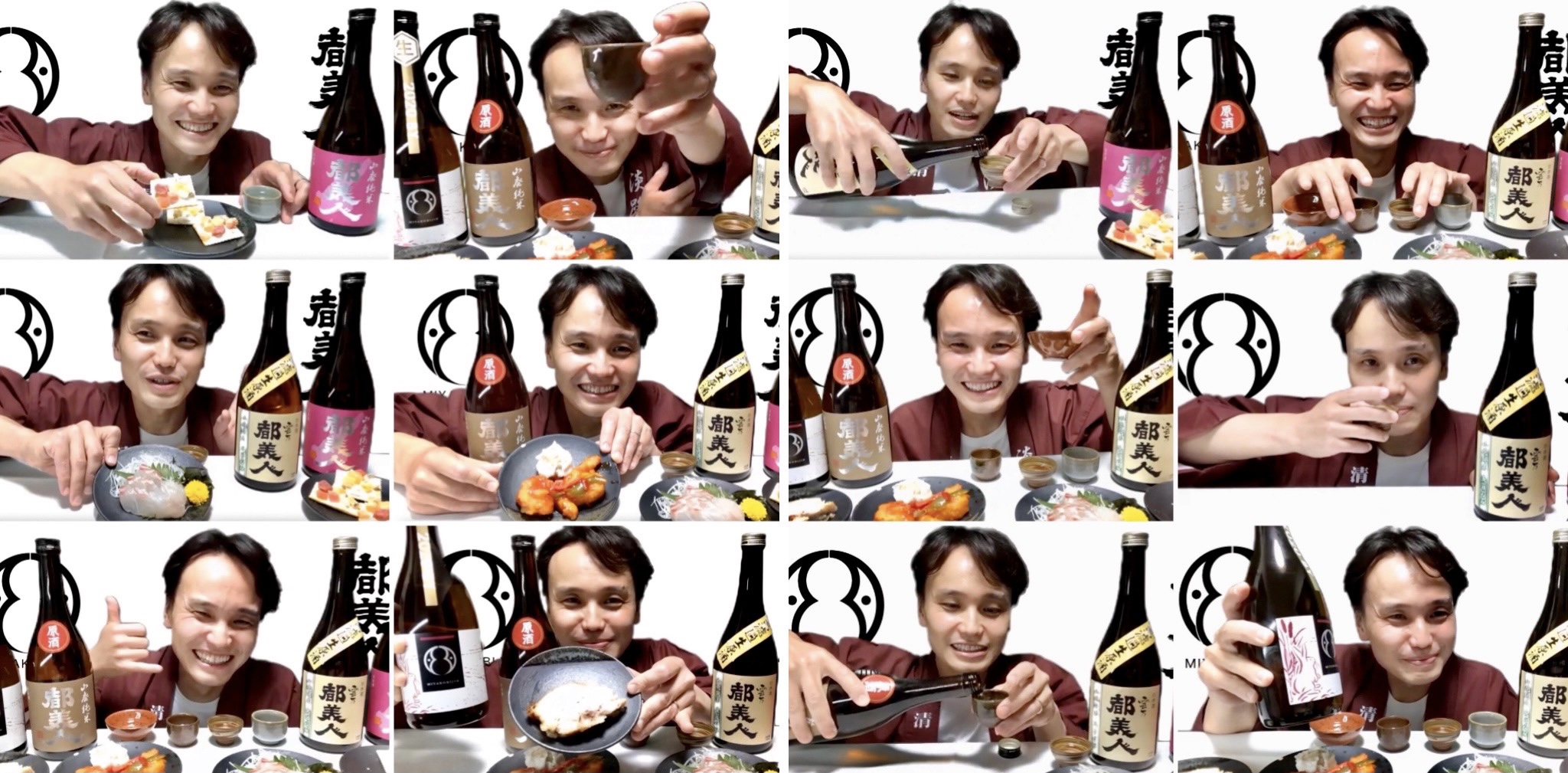
Monday 10 May saw TWTT head to Awaji Shima, in Hyogo Prefecture, to spend a couple of hours chatting with Kunihiro Yamauchi from Miyako-Bijin. Two hours was a treat, but of course, it’s never long enough! There is always so much more to ask, hear, learn.
Miyako-Bijin was established as a company in 1945, when 10 smaller breweries merged together to consolidate their brewing skills. Originally called Awaji Shuzo after the island’s name, it changed to Miyako-Bijin in 1959/1960. After the Sake boom of the 70’s and early 80’s Miyako Bijin struggled with sales and over the following years cut back on volume-based production and focused solely on small batch quality-driven products. Much of the brewery machinery was sold off and they moved back to handmade, small-tank production.
During Yamauchi-san’s presentation, we got a glimpse at the brewery’s Koji room, made up of five chambers! A Koji room like no other ~ giving us an insight into Yamauchi-san’s incredible dedication to the craft of making Koji. When talking about the process, Yamauchi-san explained that the timing of these stages, (in his koji making), is not something that is set by the clock. They work koji according to how the koji feels, not what the clock says. A more labour intensive method, but indeed a labour of love. Under his Happi coat, Yamauchi-san was proudly sporting a T-shirt that read ‘NO KOJI, NO LIFE’.
Miyako-Bijin’s unique methods of producing koji ~ the heart and soul of their brews ~ certainly result in some deliciously unique sake. Rich, layered and full-flavoured.
Koji was certainly the focus of the slide presentation but it was also great to see images of their Tenbin Shibori (Haneki Shibori) press. Still in use, but only used for a small percentage of their overall production. This prompted a curious discussion in the chat as to just how many breweries still have one of these in use ~ it’s thought somewhere between 3 and 7….
After the presentation, Yamauchi-san impressed us all with his thoughtful set up and wonderful spread as he talked about 4 of the sake in the Miyako-Bijin range and teased us with some delicious looking pairings.
Miyako-Bijin are certainly one of the many breweries that have felt the impact from COVID, seeing production decrease due to associated challenges. I’d like to think, in some way, we can all try to support these breweries who work so hard to produce incredible sake. Yamauchi-san’s passion is a force and his skill, knowledge and dedication is undeniable. It’s also clear to see how well respected he is within the brewing world and it was great to have several brewers from other breweries join the session last night. It was such a joy and an honour to listen to Yamauchi-san speak and to see his infectious smile light up our screens. I hope you will all continue to seek out and enjoy his wonderful sake.
A huge thank you to Yamauchi-san for sharing his time, passion, knowledge and pairing suggestions! An extension of that huge thank you going out to Yoram Ofer for another wonderful translation / interpretation.
As always, thank you to everyone who attended this session.
Taste with the Tōji ~ Session 40:
– TWTT 1 Year Anniversary –
with Rumiko Moriki, Andrew Russell, Cody Brailsford & Jorge Navarrete
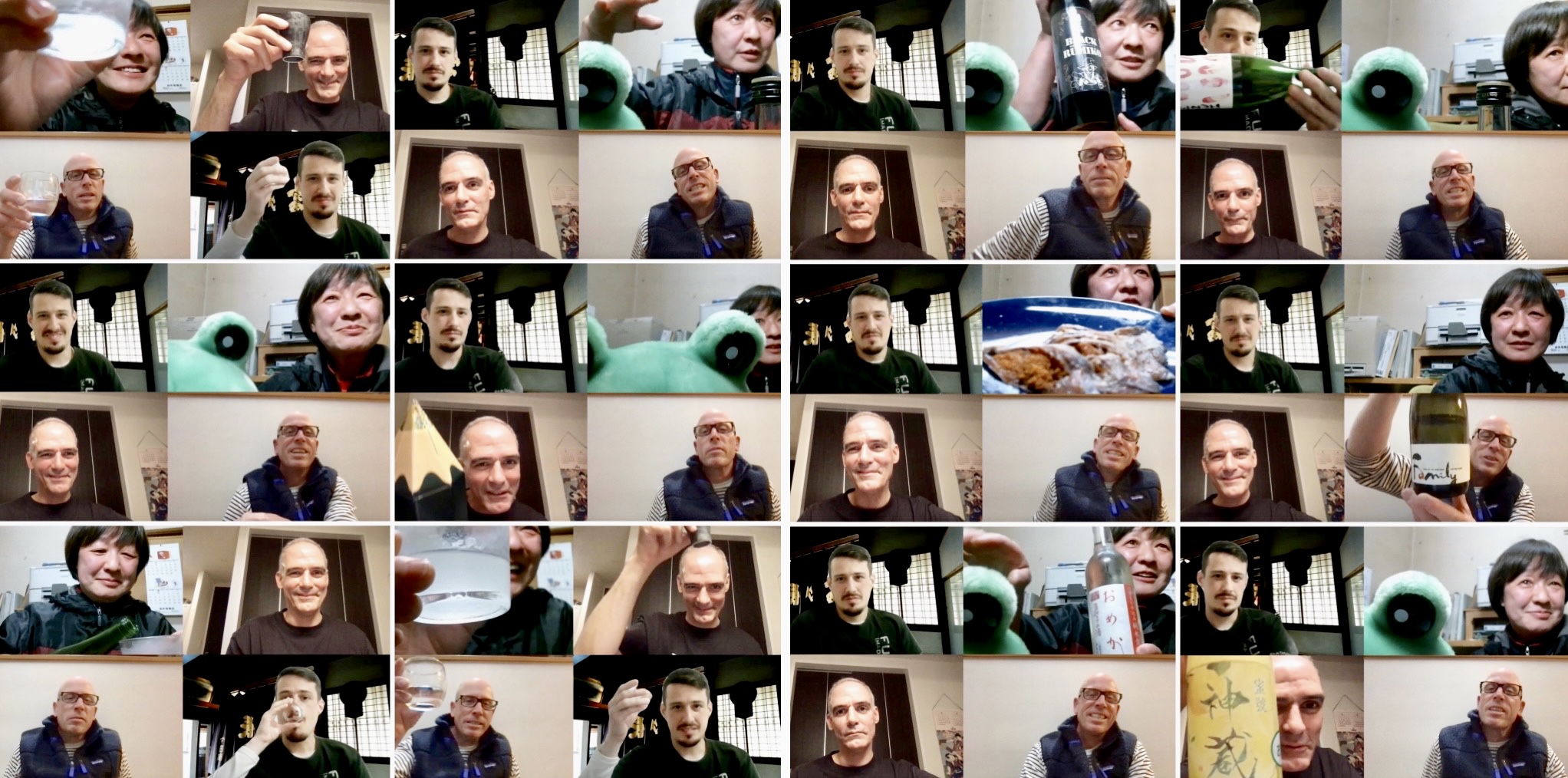
Tuesday 27 April saw Session #40 of TWTT, which was also the 1 Year Anniversary of the TWTT Project.
It was an honour to have a wonderful panel of four fabulous humans, (who also happen to be sake brewers), join us for this very special session. An insightful and inspirational discussion with Rumiko Moriki (Moriki Shuzo: Session 2), Andrew Russell (Imada Shuzo: Sessions 1 & 12), Darryl Cody Brailsford (Watanabe Shuzo – Hourai: Session 7), and Jorge Navarrete (Matsui Shuzo: Session 24).
As per usual… we went a little overtime. Two hours initially sounds like a long time but they fly by way too fast. Still so much more we could’ve talked about but great to hear some positive stories coming out of the past year and to hear about new and future plans, projects and products.
These four, along with all the brewers and guests that have been involved thus far, have allowed this project to happen and encouraged an incredible community that has come together through a love for/interest in sake! A huge thank you to Rumiko, Andy, Cody and Jorge for sharing their time, thoughts, ventures and knowledge with us.
This was a fabulous celebration of a fabulous beverage and a night of sake and surprises.
Kanpai to all the people working tirelessly to produce the brew that binds the TWTT community together.
Kanpai to everyone who has been a part of TWTT thus far ~ ALL of you… and a heartfelt thank you to the Australian crew responsible for the surprise! I was certainly surprised to see Kirsten and Shaun, (two TWTT regular Zoom room attendees), appear behind me instead of in the Zoom room! Albeit with an incredible cake and some even more incredible sake.
Needless to say I was most overwhelmed and very humbled by the gesture, generosity and kindness. It has been such a privilege to be on this wonderful sake journey with an incredible group of sake lovers from all over the globe.
Taste with the Tōji ~ Session 39:
Fumiko Shintani
Shintani Shuzo
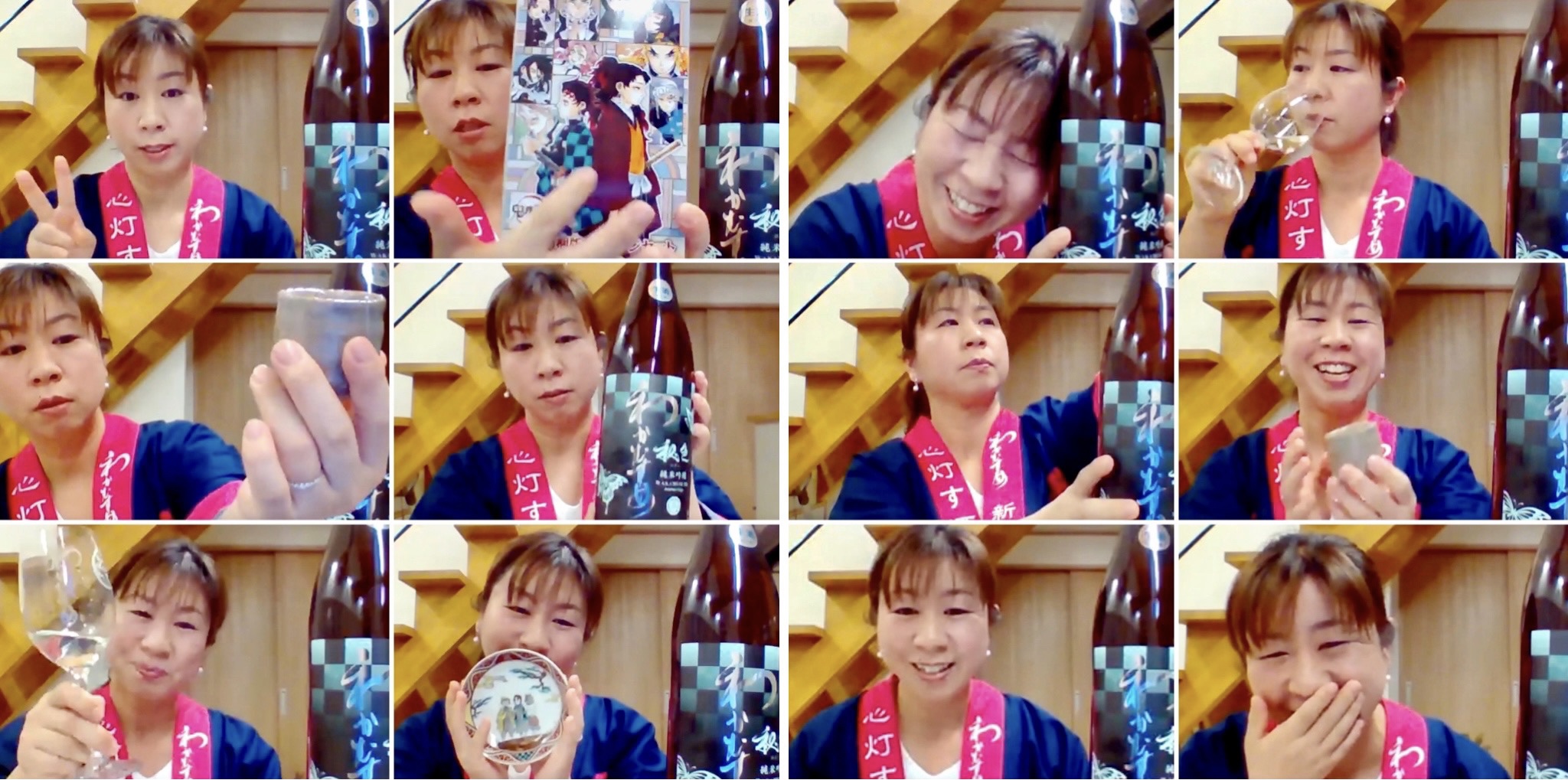
Monday 26 April saw TWTT visit Yamaguchi Prefecture to chat with Fumiko Shintani from Shintani Shuzo ~ a small brewery that is not too well known outside of Japan, producing sake with very limited availability outside of Yamaguchi Prefecture.
Shintani Shuzo is located in the Tokuji area of Yamaguchi city, where they have been brewing sake for around 100 years.
The brewery is currently run by husband and wife team, Yoshinao and Fumiko Shintani. Prior to her life as a brewer, Fumiko was working as a nurse ~ little did she know, she’d end up being Toji of the brewery some day. In fact, around the time she was welcomed into the Shintani family, she was told she wouldn’t need to be involved in the brewery at all, so ‘not to worry’. Her husband, Yoshinao, determined to continue his family’s legacy and keep the brewery alive, went to Tokyo to study brewing science.
However, not long after her husband, Yoshinao, took over from his grandfather, the Tōji and all other brewery staff, (who were getting on in years), announced their retirement. Neither Yoshinao or Fumiko had any experience in brewing or even working in a brewery.
After losing the Tōji and brewery staff, and with the brewery on the brink of closure, Fumiko, who was left with no other choice, ended up leaving her career as a nurse to help the family brewery survive.
Now, the two of them, (JUST the two of them), are working all year round at the brewery, making sake for the Yamaguchi locals, (and others in Japan if they can snap up a bottle fast enough!).
The brewery produces around only 80 koku per year ~ with each batch selling out super quickly after release!
Last night, we got to spend a wonderful 3 hours hearing Fumiko’s story ~ which included hardships, determination, family, dedication and recent successes.
Fumiko’s spirit, strength and passion resonated with the audience and she no doubt has a whole group of new supporters after sharing her story so candidly with us all last night. These kinds of stories are the heart and soul of this project and the true essence of sake.
In fact, we hardly even had a chance to touch much about the sake itself as there was so much else to talk about – proving there is far more to sake, and sake making, than what is in the actual bottle. However, this perhaps means there is definitely an opportunity for a follow up session with Shintani-san.
A huge thank you to Fumiko Shintani for sharing her time, passion, life lessons, strength, knowledge and hope with us all. An extension of that thank you goes out to Jim Rion for a remarkable job interpreting not only the words, but the raw emotion, for this session. A great job indeed!
As always, thank you to everyone who attended this session.
Taste with the Tōji ~ Session 38:
Keinosuke Hirose & Kyoko Hasegawa
Hirose Shoten (Shiragiku)
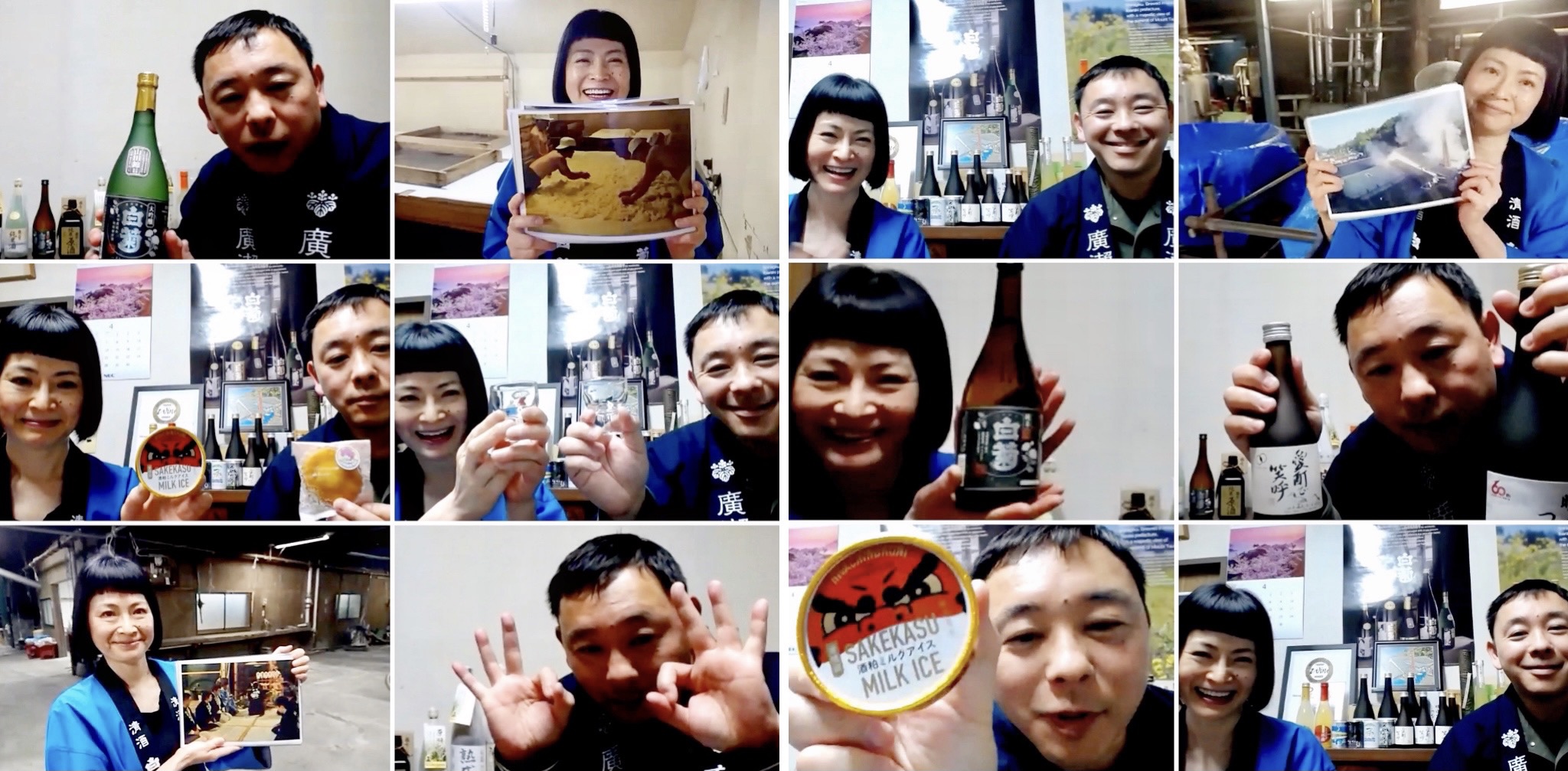
Tuesday 20th April saw another truly delightful session of TWTT as we headed to Ibaraki Prefecture to be joined by two team members from Hirose Shoten, makers of Shiragiku sake. Joining us for session #38 of TWTT was 8th generation Kuramoto; Keinosuke Hirose and one incredibly vibrant Kurabito; Kyoko Hasegawa.
Hirose Shoten was founded in 1805 in Takahama, which overlooks Mt. Tsukuba to the west, on the banks of the Koise River. Takahama is blessed with a colder climate suitable for sake brewing and high-quality water. Hirose Shoten’s sake has been loved by the local people for over 200 years. In fact, 95% of the sake they produce is for the local market within Ibaraki Prefecture ~ leaving only 5% for elsewhere in Japan. As of yet, nothing they produce is exported overseas.
A few Japan based TWTT attendees were fortunate enough to get their hands on some Shiragiku sake for the session ~ and big thank you to Kyoko-san for helping to get the sake to some of the attendees so quickly and efficiently.
Many watching, including myself, knew very little about this brewery but by the end of the session, had not only added Hirose Shoten to a future travel itinerary, but felt like they’d acquired two new friends in Hirose-san and Kyoko-san.
Attendees were treated to a brewery tour, with Hirose-san behind the camera, and Kyoko-san leading us through the kura and cleverly using full colour A4 photographs to show us what each section of the kura looks like during brewing season, (as brewing has already completed for this season).
Kyoko-san spoke to our sake-loving hearts when describing the joy that working in the brewery brings her, and Hirose-san’s parting words and ‘philosophy’ reiterated the warmth, energy and sense of ‘family’ amongst the team at the brewery. He believes that a happy team will produce another happy ‘living’ thing (in sake). Kyoko-san’s smile radiated throughout the session and her joyous energy was certainly infectious, and I am sure leaving many of us with not only a smile on our own faces, but a strong desire to try the sake she plays a role in making!
A huge thank you to Hirose-san and Kyoko-san for sharing their time, warmth, energy, passion and knowledge with us all. An extension of that thanks going to Maki Tanaka for doing a wonderful job interpreting for this session.
As always, thank you to everyone who attended this session.
Taste with the Tōji ~ Session 37:
Fumihiko Nakama
Sakai Shuzo (Gokyo)
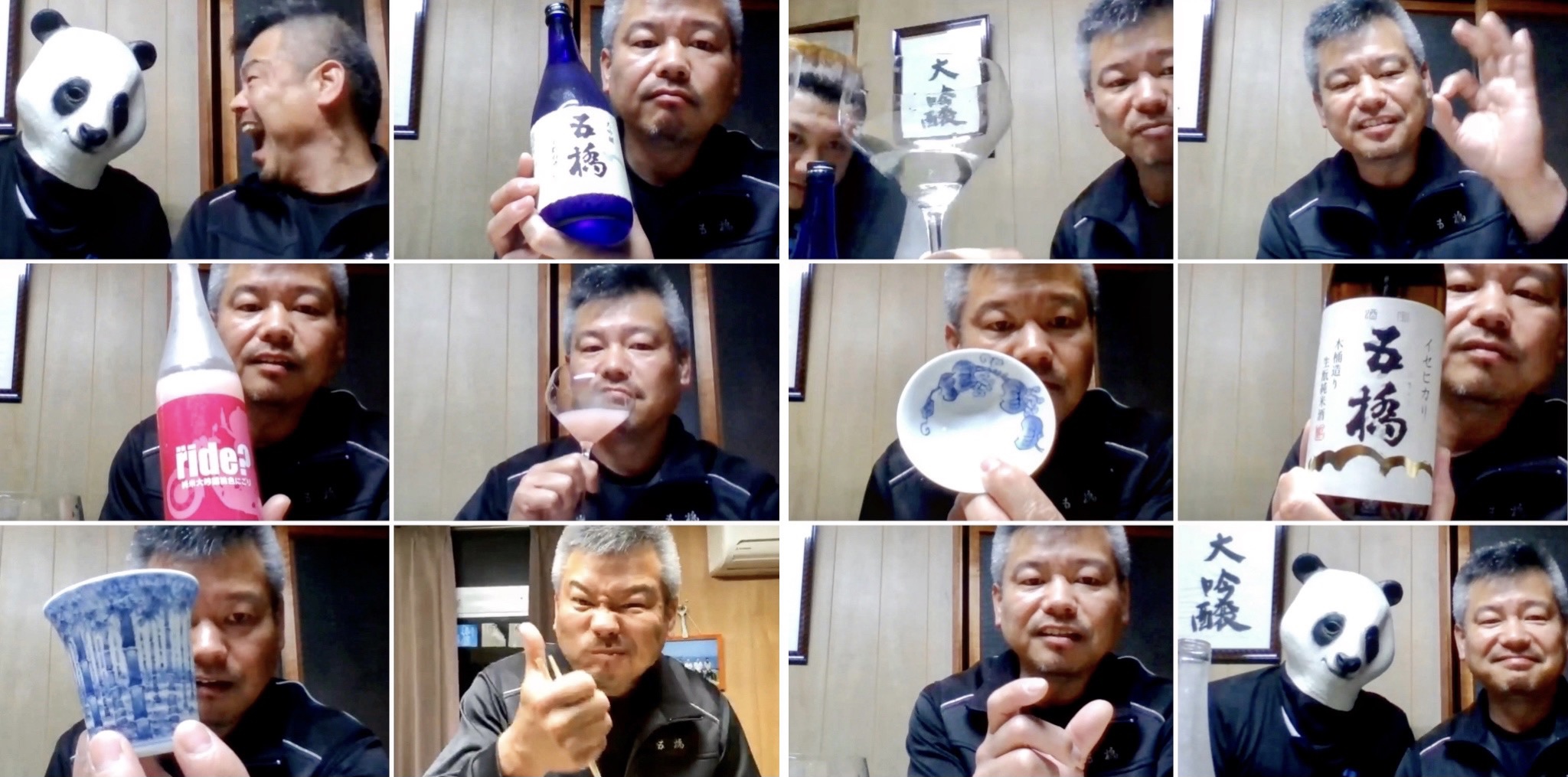
It was a joy to head back to Yamaguchi Prefecture, (for the first time in season 2021), this time to visit Sakai Shuzo, (producers of Gokyo). So great to be joined at the helm once again by
Jim Rion; the Yamaguchi Sake Guy – that’s the title I have given him anyway! Anyone that knows Jim, knows that he is a huge fan of this brewery, so there was no better person to help guide us through this session!
Established in 1871, Sakai Shuzo is located in Iwakuni, Yamaguchi Prefecture. It is one of 24 sake breweries currently brewing in Yamaguchi Prefecture. The town of Iwakuni is most well known for the Kintai Bridge which was built 1673. This historic wooden bridge consists of five wooden arches crossing the Nishiki River and is an incredibly popular spot for tourists, especially around Spring and Autumn.
The relatively young team at Sakai Shuzo are committed to producing quality sake; working closely with local farmers and brewing using local ingredients.
Joining us for this session was Tōji; Fumihiko Nakama, who has spent his whole brewing career, (30 years) at Sakai Shuzo, and it was wonderful to hear about the trust and respect between Tōji and Kuramoto, and that Nakama-san pretty much has free rein when it comes to brewing, which has seen some wonderful experimental brews, a plethora of awards, and the brewery continue to gain an incredibly loyal following in Japan. Joining us alongside Nakama-san was Charlie-san, aka: Tanuki-san (well, more like a panda due to the absence of Tanuki masks), certainly adding a fun element to the session.
Nakama-san prepared an in-depth and extensive slide presentation, giving us an insight into the brewery and the brewing, followed by a discussion about a selection of their range. A candid Q&A session saw the clock move into overtime, and even after ‘officially’ ending the session, Nakama-san stuck around with the stayers, which included a cooking demonstration of a favourite local dish! Lots of fun. I called it a night after just under 4 hours, however, Nakama-san stayed on with those who were still logged in – a testament to his character and generosity.
A huge thank you to Nakama-san for sharing his time, knowledge, spirit, humour and passion with us. An extension of that thank you going out to Charlie-san/Tanuki-san for not only going the distance, but for adding an extra fun element to the session! And of course, a further extension of that huge thank you going out to Jim Rion, without whom, this session would not have been possible, (and even if it was, it would not have been as much fun!).
Thank you, as always, to everyone who attended the session.
Taste with the Tōji ~ Session 36:
Kanako Takagi & Natsuki Kakizawa
Heiwa Shuzo
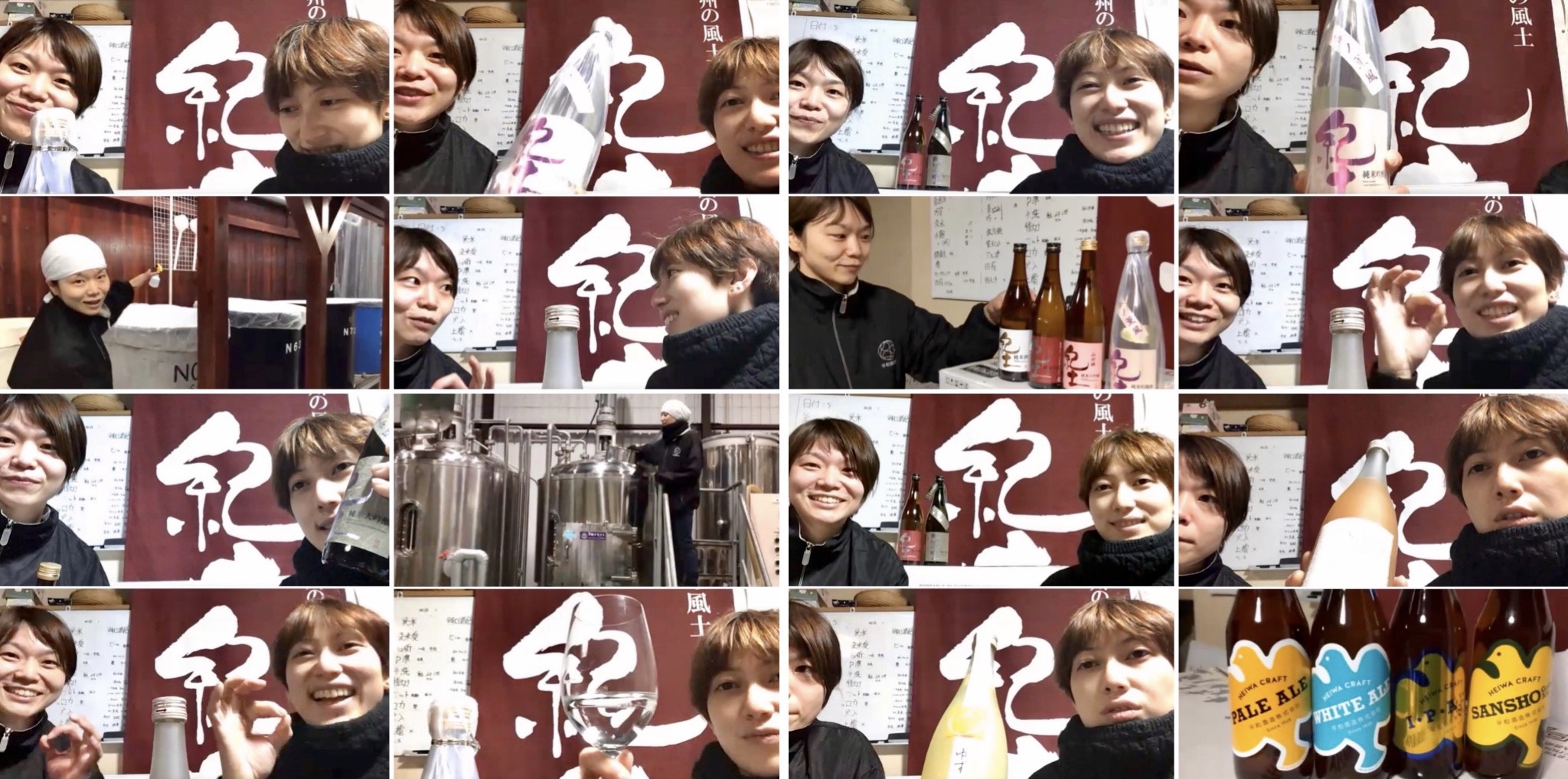
Monday 5 April saw another wonderful session of TWTT. This was session number 36 in the Taste with the Toji project and it was a pleasure to get to spend 2 and a half hours with two wonderful and inspiring women – Kanako Takagi and Natsuki Kakizawa from Heiwa Shuzo.
Heiwa Shuzo was founded in 1928 and is located just outside Kainan City in Wakayama. The site where the brewery is located was a temple for over 500 years before the brewery was established. It wasn’t until 1957 when Sake production commenced full-time. The brewery is located in a valley surrounded by mountains, blessed with high precipitation, resulting in a boundless supply of good quality soft spring water, perfect for brewing Sake.
It was a treat to get not only a virtual tour of the sake brewery, but also of their beer operation. Heiwa Shuzo are one of the growing number of breweries producing a range of craft beverages in addition to producing sake. I so want to try their Sansho Golden Ale!
The most well known of their range is of course their KID label sake. The name KID comes from “Kishu climate” (former name of Wakayama Prefecture) and also represents youthful innocence and freedom. Kind of fitting in the fact that Kakizawa-san and Takagi-san are part of a young, enthusiastic and passionate team at Heiwa Shuzo where the average age is 31!
Some of that youthful exuberance and energy shone through these two amazing women last night and was a delight to experience.
One of the brewery’s mottos is: ‘Sake is a living thing, and people are a bridge’.
I think the bridge’s foundations got even stronger last night! A huge thank you to Kanako Takagi and Natsuki Kakizawa for sharing their time, stories, knowledge, passion and energy with us all last night. An extension of that thank you goes out to the lovely Maki Tanaka for a fabulous job at translating/interpreting for this session.
As always, thank you to everyone who attended this session.
Taste with the Tōji ~ Session 35:
Muneki Matsumoto
Tosa Shuzo (Keigetsu)
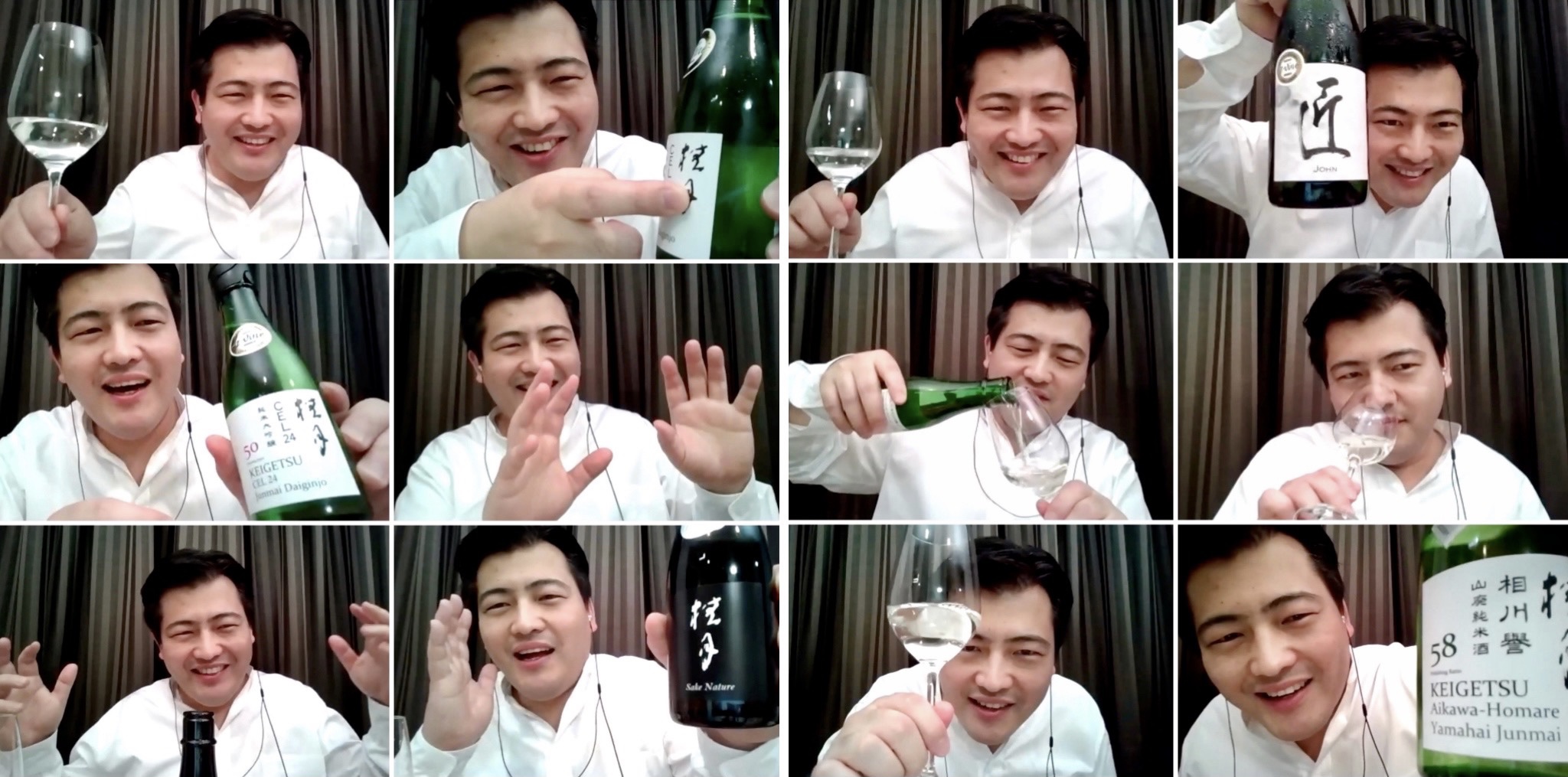
Session #35 was held on Monday 29 March and saw us head to Kochi Prefecture for the first time in this series. This is a part of Japan I have long wanted to visit, but even after many trips to Japan, am still yet to do so. This session certainly fuelled my desire to visit this great sake loving region of Japan.
Joining us for not only the 2 hour session, but another 1.5 hours after the ‘official’ session ended, was the wonderfully vibrant and charismatic Muneki Matsumoto.
Established in 1877, Tosa Shuzo, who are the producers of Keigetsu Sake, are located in the Tosa District of Kochi Prefecture, where they are surrounded by nature and the picturesque shores of Lake Sameura. The name Keigetsu was inspired by the famous poet, Omachi Keigetsu, who was apparently very fond of sake.
During this lively session, Matsumoto-san was full of fun facts and stories, including the story of their JOHN Sparkling Sake. The sake was named after one of Matsumoto-san’s friends… kind of one of those promises made during some drunken banter with a mate ~ but this one ended up being kept!
Matsumoto-san Zoomed in from his house for this session but treated us all to some great videos not only of the brewery and the process of making sake but some stunning, and most impressive, aerial shots of Kochi’s rice paddies.
Warm, welcoming and witty, Matsumoto-san impressively presented this entire session in English and certainly made himself many new fans and friends amongst the TWTT audience. Looks like I’m not the only one that has Kochi pinned near the top of my list of places to visit!
A huge thank you to Matusmoto-san for sharing his time, stories, humour, hopes, passion and knowledge ~ and also a big thank you to him for making some wonderful tasting packs accessible for the Japanese members of the TWTT audience.
An extension of that thank you goes out to Charles Thomas Stewart for helping to make this session happen and getting Kochi on the TWTT map.
As always, thank you to all who attended this session.
Taste with the Tōji ~ Session 34:
Tomofumi Yamamoto
Yamamoto Gomei
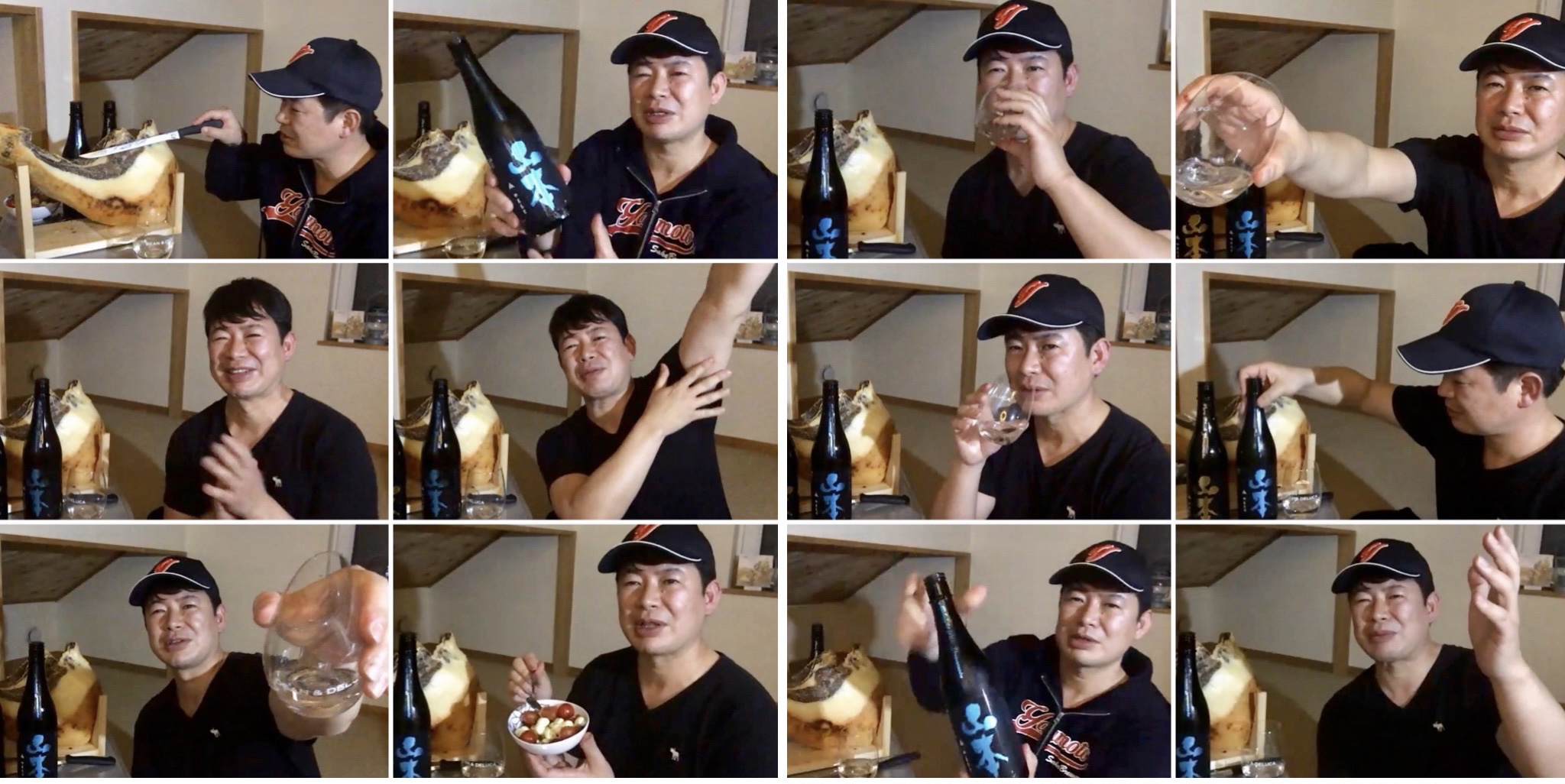
Monday 22 February saw yet another most enjoyable session of TWTT as we headed to Akita Prefecture to be joined by Tomofumi Yamamoto.
This session was incredibly chilled and relaxed, just like Yamamoto-san himself. Other than an 8 minute video presentation, the rest of the 2.5 hour session was spent simply chatting with Yamamoto-san from his house. Wearing his baseball inspired Yamamoto hoodie and cap, sipping sake from his unbreakable Dean and Deluca glass (that wasn’t actually glass), and every so often cutting off a thin piece of his home cured leg of ham, Yamamoto-san made us feel as though we were catching up with an old friend.
With a background in music management, Yamamoto-san had never imagined he’d one day take over the family sake brewery, which he did so after the sad passing of his cousin. Perhaps growing up without the pressures and expectations that other ‘future brewers’ often have bestowed upon them, allowed Yamamoto-san to approach this role in a far more relaxed and what many would say, modern, or contemporary, way. Either way, he marches to the beat of his own drum, whilst very much embracing ‘local’ ~ this, and his progressive thinking certainly seems to be working well for him and his brewery. He leads a young team of brewers, constantly rotating his core staff around different roles, to not only give them the opportunity to learn each stage/role well, but to keep them interested and enthusiastic about their job and brewing sake.
Yamamoto-san certainly has a loyal following and through his Yamamoto range, he is creating a style of sake that he enjoys to drink, with low aroma, minimal sweetness and good acidity, or as he says: “sake you don’t tire of easily and can keep drinking”.
In addition, he is also part of the Akita Next 5 group of brewers; a now 10 year long collaboration with 4 other Akita brewers. Yamamoto-san has certainly created a bit of a buzz in the sake world and shone a sake spotlight on Akita Prefecture.
A huge thank you to Yamamoto-san, who did the entire session in English, for sharing his time, humour, knowledge and stories with us.
As always, thank you to everyone who attended the Zoom room or viewed the session a FB live. I love how different each of these sessions are and it’s so great having such a wonderful sake community along for this TWTT journey!
Taste with the Tōji ~ Session 33:
Fumiaki Matsuura & Hannah Kirshner
Matsuura Shuzo
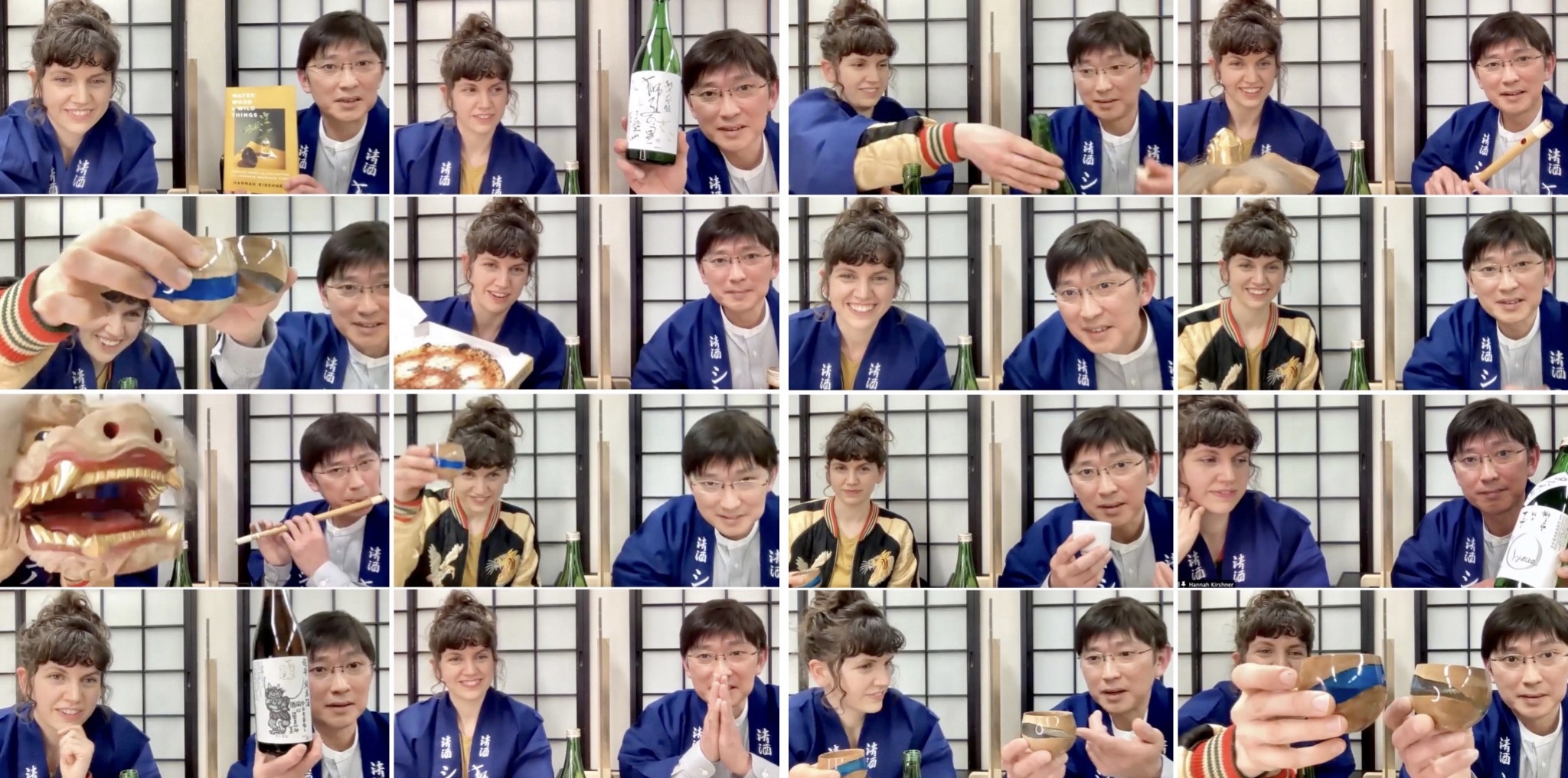
On Monday 15 February, TWTT had the absolute honour of heading to Ishikawa Prefecture and hearing from two delightful humans, Fumiaki Matsuura and Hannah Kirshner, who joined us from Matsuura Shuzo.
This session shone a spotlight not only on this wonderful little brewery tucked away in the mountain-side, Onsen town of Yamanaka, but also on a beautiful new book by Hannah called Water, Wood & Wild Things.
It was such a joy to hear from these two craftspeople doing incredible things that entwine so beautifully with each other through something that has connected us all: Sake.
Matsuura-san represents the 14th generation at this small, well respected brewery that was established in 1772. As one of the attendees pointed out last night, next year will mark their 250 year anniversary.
Hannah, currently working her second season as Kurabito at Matsuura Shuzo, is the first foreigner and, I believe, the first woman, to work/be employed as a Kurabito in this almost 250 year old brewery.
Matsuura Shuzo produce sake under the label ‘Shishi no Sato’ ~ the name meaning ‘village of the lions’. The brewery are producing around 50 kilolitres of sake per year, which is really not a lot. Hence, their sake is currently not exported. What is produced is sought after and snapped up by the locals, with some also heading to a few Tokyo venues/retailers.
It was a joy to witness the wonderful dynamic and mutual respect between Matsuura-san and Hannah. Both parties coming across as incredibly humble and full of praise for each others dedication and achievements ~ as were we, the audience, as we learnt a little more about the brewery and the book.
It’s evident that the town of Yamanaka has had a tremendous impact on Hannah. What was also evident through discussion last night, was that there is a strong sense of community in the town and a fine array of incredible artisans, farmers, craftspeople and producers who all support and encourage each other in some way. Hannah’s book spotlights a handful of these remarkable people and after last night’s session, I think Yamanaka had best prepare for an influx of TWTT sake lovers heading their way once travel opens up again. It was great to see the stunning work of Takehito Nakajima in the form of two exquisitely crafted wooden guinomi that Hannah and Matsuura-san were drinking from.
Takehito Nakajima will feature in an upcoming session of Meet the Artisan, a sister project of Taste with the Tōji, next month, (April 15).
A huge thank you to Matsuura-san and Hannah for sharing their stories, time, knowledge, passion and sense of joy with us. An extension of that big thank you going out to Justin Potts for his help, support and time last night. And, as always, thank you so very much to everyone who attended this session of Taste with the Tōji.
If I may just share this beautiful quote from Matsuura-san, that features in Water Wood & Wild Things:
“Sake is like a flower. You can enjoy it as a bud, in full bloom, and even as it begins to drop its petals. Each phase has its own beauty: each one blooms at a different time.”
Taste with the Tōji ~ Session 32:
Atsushi Nakano & Keith Norum Masumi | Miyasaka
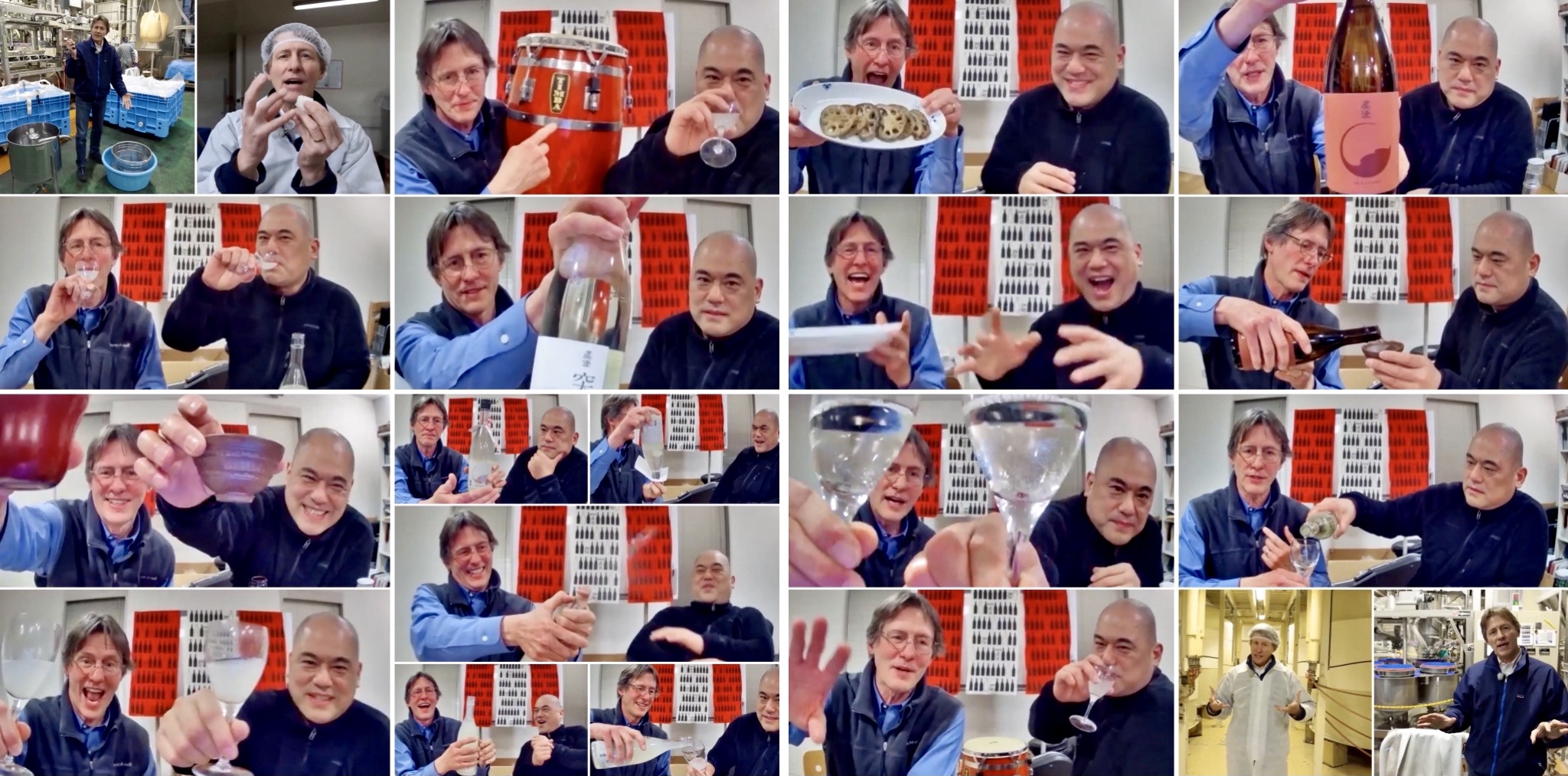
Last night saw the 32nd session of Taste with the Tōji take place when we headed to Nagano Prefecture to chat with Keith Norum and Nakano Atsushi from Masumi (Miyasaka Brewing Co.)
Last night’s attendees were amongst the first people to get to view Masumi’s new, and incredibly in depth, brewery tour video, which certainly generated many “wows” from the audience. The presentation also sparked curiosity and many questions which Keith answered with such insight and eloquence.
Then it was time to sit back and join Keith and Nakano-san, who were Zooming in from Keith’s living room, for a few virtual drinks, hear their stories, some more Q&A, and a whole lot of fun!
Lots of discussion about yeast, in particular; yeast #7, which of course was discovered at Masumi in 1946. Conversations touching on their 2 labels, (Masumi and Miyasaka), their 2 breweries, (Fujimi and Suwa), and their 3 Tōji, along with touching on the production volume as well as blending, (not to mention the size of their blending tanks), certainly gave us a good idea of the scale of Miyasaka Brewing Co.
Great to hear about some of their newer seasonal and flagship products, which we unfortunately don’t get here in Australia yet. I am super keen to try their Spring Snow. In contrast to their name; Masumi, which means transparency or truth ~this is a cloudy, usu-nigori which is also a junmai ginjo nama genshu. With a fair bit of fermentation still going on inside the bottle, this product is currently not exported at all ~ and in Japan, bottles of this product come with a warning in the form of a neck label telling you to take great caution when opening. We got a live demonstration of why when Keith and Nakano-san ‘popped’ the cap on one of these!
Of course, my favourite part about doing this project is getting to hear people’s stories ~ both related to, and outside of, their sake life. Always fascinating to hear where the interest in sake began, especially if that path wasn’t clearly laid out at an early age. So great to have Keith and Nakano-san share some of their stories with us last night ~ including Nakano-san’s love for Cuba, (he has visited the country 6 times), his passion for playing the Cuban Conga drum, and his love for Cuban salsa! The Taste with the Tōji band is growing stronger! I think a group performance should be on the cards soon!
Great to also hear a little about Nakano-san’s sake journey. Interesting to hear about how his interest shifted from wine to sake whilst he was at Agricultural University. His first job in a brewery was with Miyasaka Brewing Co. when he was 27, and 25 years later, he is still with them today.
Keith was truly the perfect host and Nakano-san’s laughter was infectious. A huge thank you to them both for sharing their time, passion, knowledge, humour, spirit and even more time after the, not 2… but 3 hour ‘official’ session ended. In fact, Keith and Nakano-san even outstayed me! Like I said; a wonderful host!
Thank you also to everyone who attended via the Zoom room or watched on FB Live. I’m incredibly grateful for your continued support for this project, these breweries and for SAKE!
Taste with the Tōji ~ Session 31:
A return to Miyoshikiku with Ryoichiro Mamiya and family
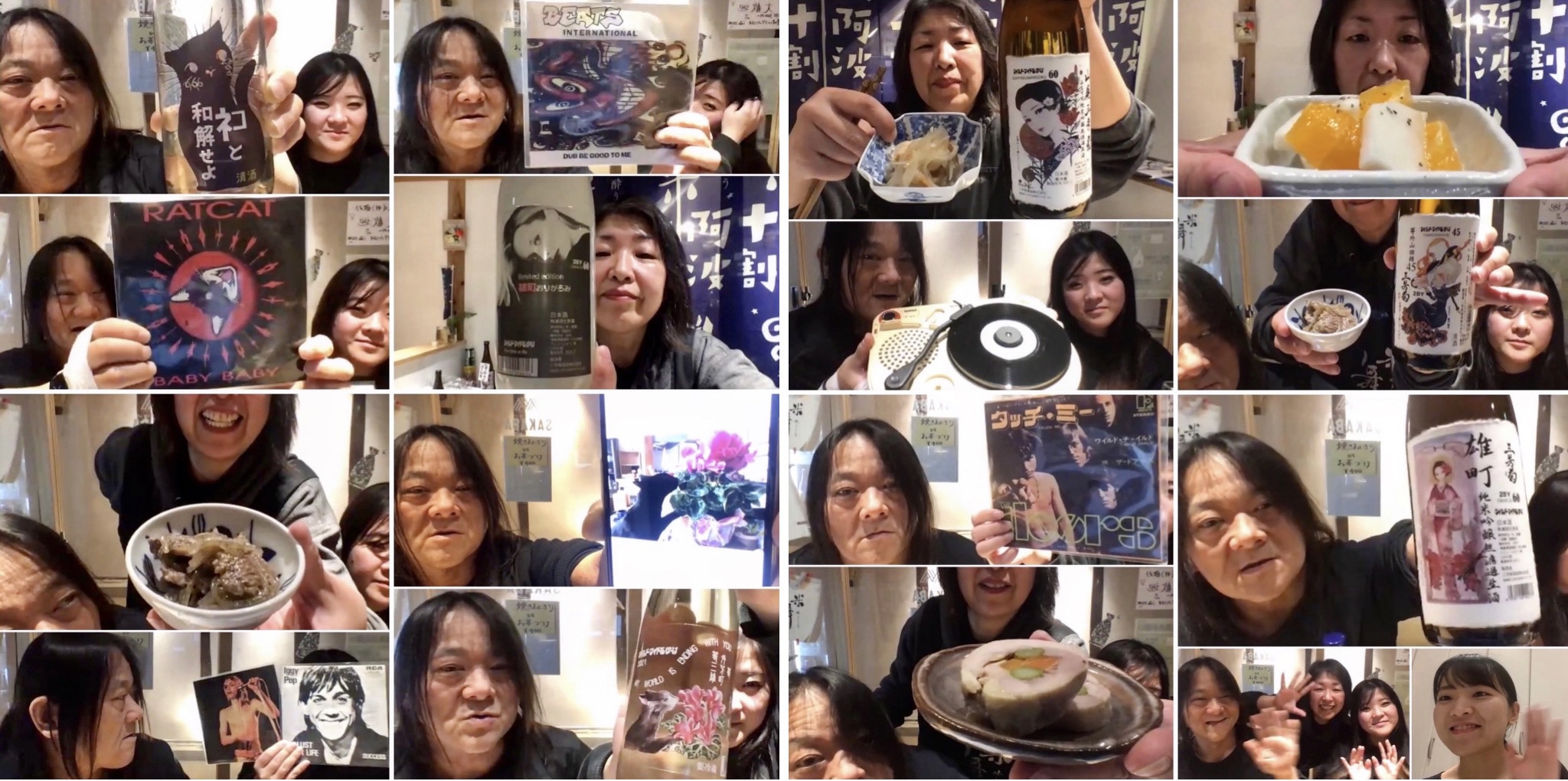
Monday 22 February saw TWTT return to Tokushima to visit Ryoichiro Mamiya-san and family for Session #33, which adopted the name: ‘Miyoshikiku‘s Second Coming’ (a little labelling pun).
This wonderful family graced us with a super fun session back in June 2020, (TWTT Session #6), and it was a delight to revisit them ~ this time, from his wife, Kuzuko’s bar, Ajidokoro Mai Mai. The bar is set in a very new and modern looking complex, a little over a stone’s throw away from the brewery. They are open Tues-Sat.
It came as no surprise, (at least to those who attended Session 6 last year), when Mamiya-san pulled out a selection of vinyl records throughout the session, talking about some of his (and his sake’s) musical influences ~ even spinning a few tracks on his adorable portable 7” player. From Lou Reed to Van Halen… even good old Rat Cat got a second outing.
Miyoshikiku’s unique and very cool labels were once again a talking point – not only for their imagery but also for the (sake) names. Mamiya-san certainly goes against the grain and we love that. Last night we got a little insight to some of his 55 recent sake creations. From black rice sake to green rice sake and a 3 year old kijoshu ~ Mamiya-san’s sake portfolio is as diverse and funky as his record collection and surely has something for everyone.
Mamiya-san also continues to produce a more old school Honjozo sake, (with a far more traditional label), that was/is popular with the Tokushima locals, that the brewery were making before he took over. Again, I’ll say, Miyoshikiku surely has something for everyone!
We also got to see some super tasty looking dishes prepared by Kazuko, and discuss some suggested sake (and music) pairings.
This session even saw a giveaway, (as Mamiya-san showed us some of his very cool Miyoshikiku T-Shirt designs), with a competition for attendees and two lucky winners of some funky Miyoshikiku threads.
You just never know what you’re going to get with a Miyoshikiku session, but fun is always guaranteed!
When it comes to making sake, Mamiya-san is fearless, creative and damn good at what he does ~ and we thank him for that.
A big thank you to Ryoichiro Mamiya, Kazuko Mamiya, Koharu Mamiya and Ayane Mamiya for sharing their time, knowledge, passion and fun. An extension of that big thank you to Julian Houseman for a wonderful job at interpreting for this session.
As always, thank you to everyone who attended. Let’s keep supporting these wonderful brewers throughout these difficult times and beyond!
~ Kanpai!
Taste with the Tōji ~ Session 30:
Hirotaka Tajime with Keiji Takahashi
~ Tajime Shuzo – CHIKUSEN ~
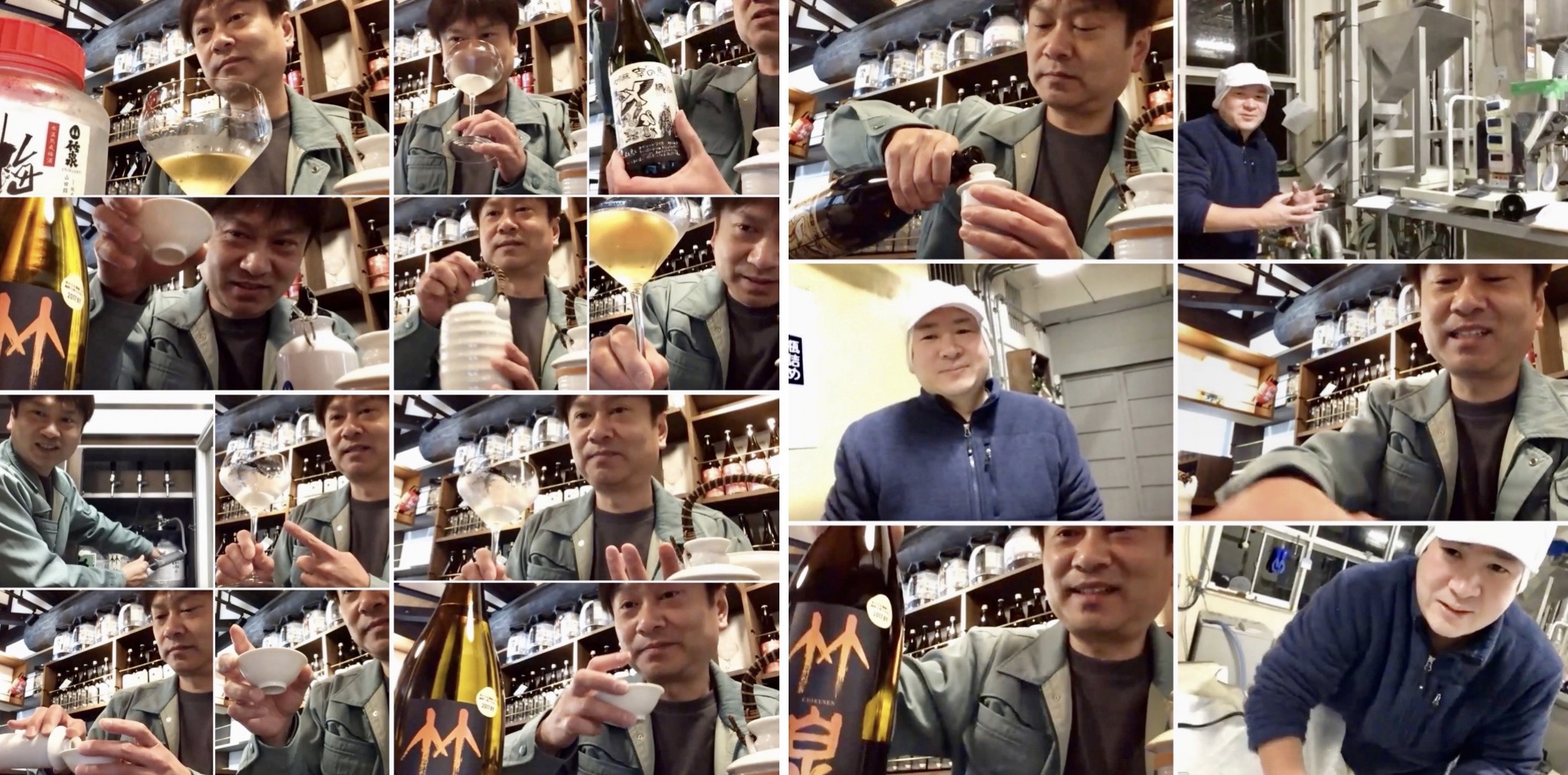
Monday 15 February saw yet another wonderful session of TWTT as we headed to Hyogo Prefecture for Session #30 in this series.
What an absolute joy it was to be joined by Hirotaka Tajime for not just 2, but 3 hours! A truly inspiring and enjoyable session, learning about not only the brewery’s philosophy but Tajime-san’s own personal philosophy – which I think resonated so well with the attendees, especially with everything that is going on in the world right now. A humbling reminder to enjoy and embrace the simple joys in life.
A wonderful slide presentation with some really gorgeous images and a strong thread/focus told us the story of the Storks who, not only grace the label of Chikusen’s Kounotori label, but also, (after they become extinct for a time and were then re-introduced from Russia), the rice fields and surrounding area of Asago, in the Northern part of Hyogo Prefecture, where Tajime Shuzo is located.
We were also fortunate enough to have a virtual tour of the brewery, and honoured to have the Tōji, Takahashi-san join us for the tour and answer some questions.
Tajime’s respect for nature and his environment, with a focus on, and commitment to, local regeneration and conservation is both admirable and inspiring. In recent times the brewery shifted to only using local rice for their Sake production. They also produce an incredible Umeshu using two types of local Ume. Chikusen are quite the masters of ageing Sake, (and Umeshu), or more precisely, knowing how long to age each Sake ~ they age some of their Sake in tanks and others in bottles, and it was interesting to see their labour intensive method of making their Junmai Umeshu: ageing it in 4ltr jars for 10 years. A virtual visit to their tasting room saw a variety of tap Sake, including a Nama version of their Umeshu… yes please!
A delightful session and insight, and my heartfelt thanks to Tajime-san for sharing his time, knowledge and passion (and beautiful philosophy) with us all. Thank you also to Takahashi-san for giving us his time during the virtual tour. Of course, an extension of that heartfelt thank you must go out to the lovely
Maki Tanaka. After attending many sessions during this series, this was Maki’s first time on board the TWTT Translation Team and I’d like to thank her for a wonderful job.
As always, thank you to all those who attended. Your continued interest and support for this project, and of course for SAKE!, is greatly appreciated.
Taste with the Tōji ~ Session 29:
Yasutaka Daimon & Marcus Consolini
with Kohei Daimon
~ Daimon Shuzo ~
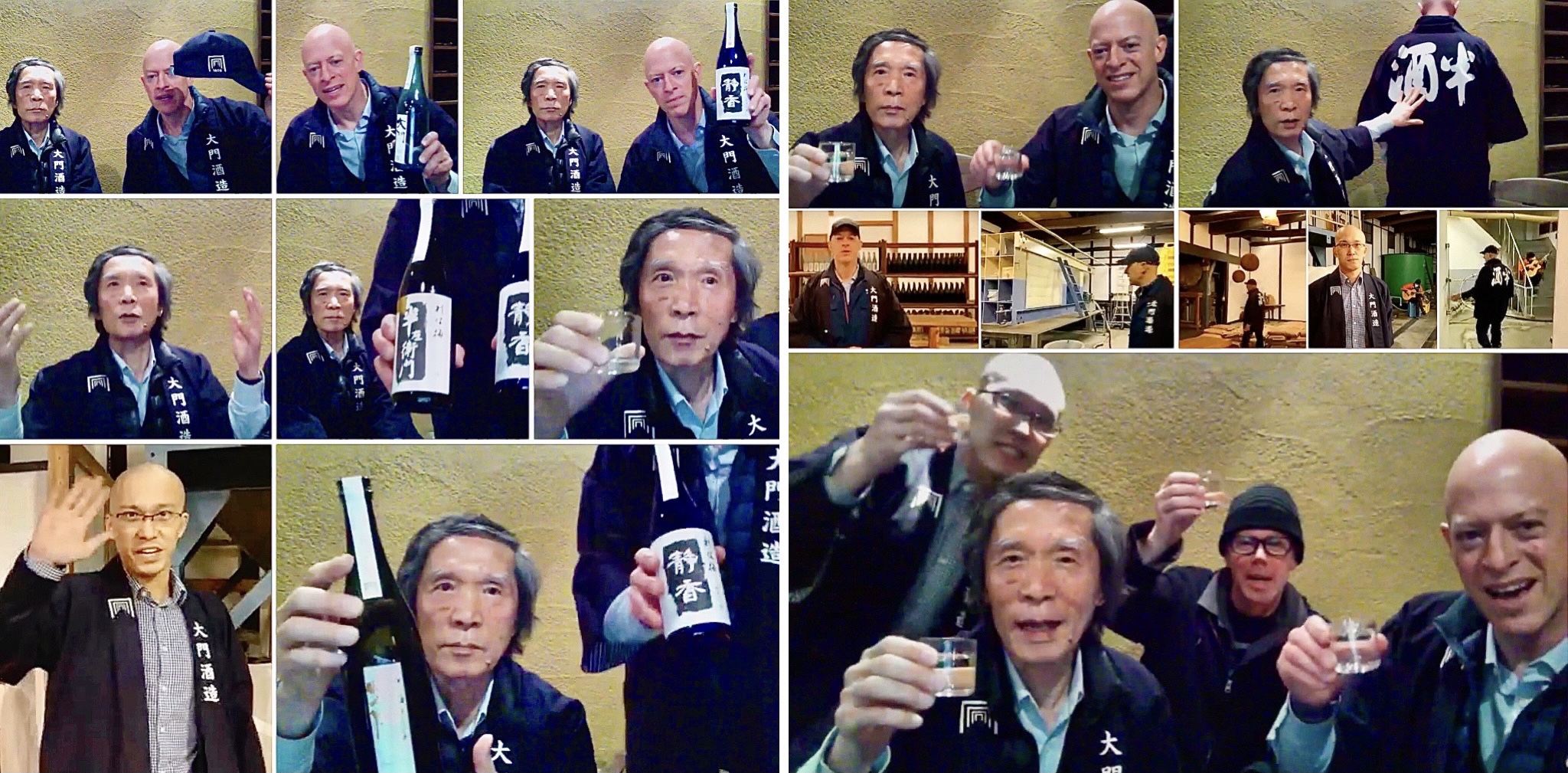
Monday 1 February saw the second session of TWTT for Season 2021 ~ This was the 29th session in the Taste with the Toji series and it was a joy to pay a visit to the folks at
Daimon Brewery in Osaka, (founded in 1826).
The session began with Marcus Consolini, CEO, greeting us in the garden courtyard of the brewery ~ even with the poor light of a Winter’s evening you could still get an idea of just how beautiful this space is; full of character and charm, which also oozes from the brewery building. We were fortunate enough to see the inside of the brewery via a virtual tour led by Marcus, with Kohei Daimon on camera. An impressive koshu wall certainly sparked curiosity amongst attendees and we will now wait eagerly to hear when some of these bottled beauties of Daimon brewing history will be released.
It’s always lovely to see inside a brewery during the brewing period, and despite many of us not being able to travel to Japan to do this in person, these virtual tours are the next best thing and it was a delight to see inside a couple of smaller tanks and see the moto bubbling away happily. All we need now is technology to create a sensory option in terms of aromatics for these Zoom sessions! Nothing quite like the smell inside a brewery during brewing season!
A really enjoyable virtual tour and a most unique one in this TWTT series thanks to the live acoustic guitar soundtrack being played at the brewery by TWTT friend and translation team member, Julian Houseman ~ who was a regular performer at Daimon Brewery’s ‘Jazz Nights’ with his band ‘Hot Sauce’! In addition to housing an onsite restaurant, the brewery boasts a beautiful gallery space for people to enjoy live music sessions and festivals, however, these events are currently on hold, and the restaurant temporarily closed, due to the current situation.
Joining the session after the tour was the one and only Yasutaka Daimon, oozing just as much character and charm as the brewery itself. It was certainly a real privilege to have Daimon-san join us for this session and impart some of his Sake wisdom, delivered with such a genuine warmth, to a most appreciative audience.
A brewery for the people. Daimon Brewery’s sense of fun and love of people, blends beautifully with their dedication, passion and tradition: all which create a wonderful energy which certainly resonated last night!
A huge thank you to Daimon-san, Marcus, Kohei, (and Julian for the tunes), for a very enjoyable session of TWTT. As always, thank you to everyone who attended, I am incredibly grateful for the continued interest and support for this project and of course, the wonderful and passionate sake community that is forever growing and evolving with it.
Taste with the Tōji ~ Session 28:
Kazunari Matsushita & Nigel Hay
with Shunya Sakaguchi
~ Yonezawa Shuzo ~
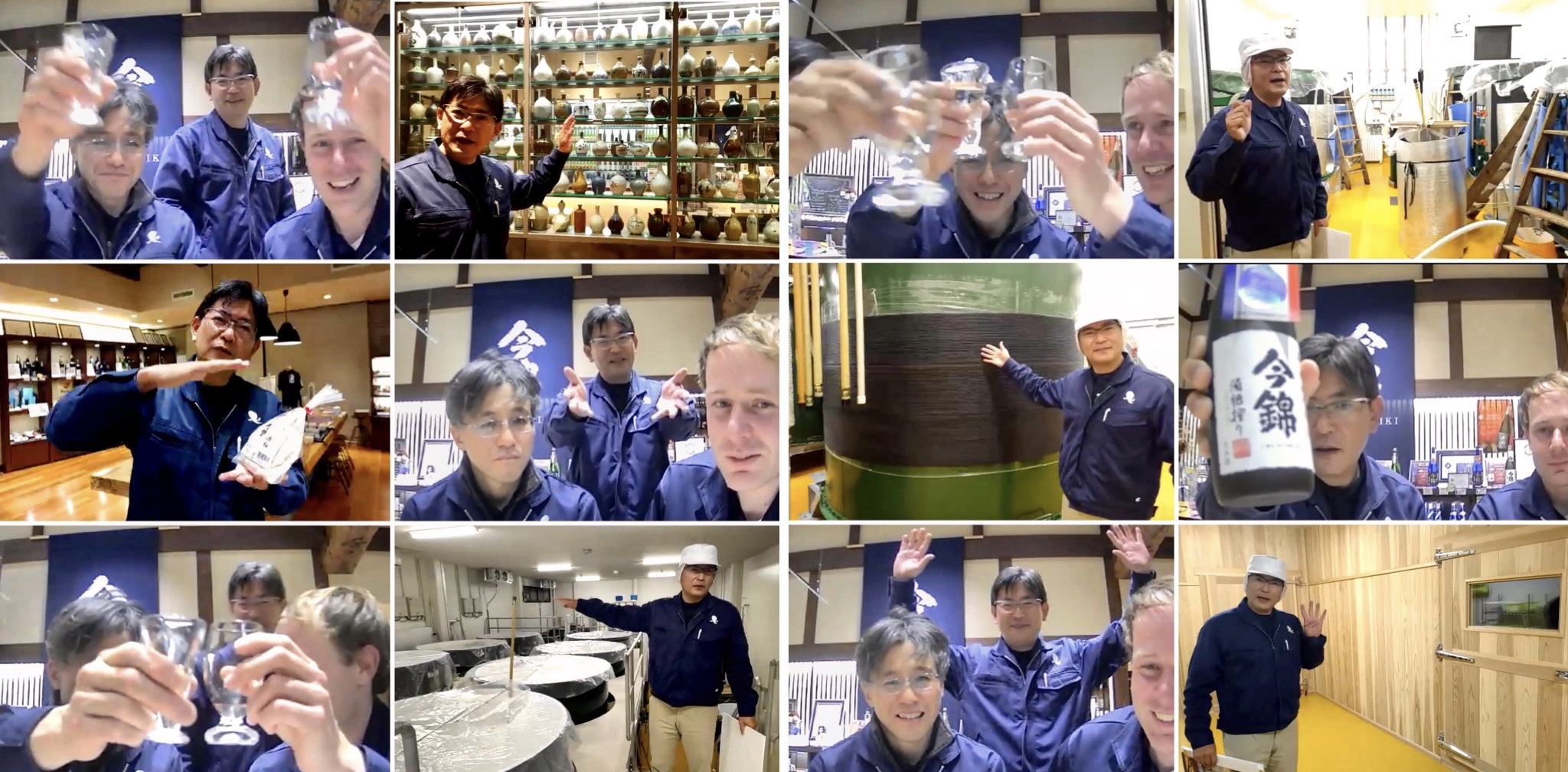
TWTT returned last on Monday 18 January after a short break over the Christmas and New Year period ~ and it was such a joy to see everyone’s faces light up my screen again, and a joy to feature Yonezawa Shuzo to kick off season 2021.
This was the first time TWTT has featured a brewery from Nagano… a Prefecture that boasts around 80 sake breweries!
Yonezawa Brewery is located in Nakagawa Village in Nagano Prefecture, where they have been brewing sake with only locally-sourced rice and water from the Southern Alps of Japan since 1907. The picturesque Nakagawa Village is skirted by the Tenryu River, with clear views of the Central and Southern Alps of Japan. It is also home to the ”Iinuma Rice Terrace”, which now occupies ground that was once abandoned farmland. Yonezawa revived the fortunes of these fertile terraces through dedicated cultivation of Miyama-nishiki sake rice for their brewing. The majority of the rice used to produce their sake is harvested in Nakagawa Village.
It was too dark outside during the session to be able to get a glimpse of the picturesque views that surround the kura but we were lucky enough to get a virtual tour inside the brewery thanks to Matsushita-san and Nigel Hay, who joined us for this 28th session of TWTT.
Attendees managed a quick glimpse of the fune press before Wifi started playing up and we headed back to the tasting room to learn that Yonezawa Shuzo is the only brewery in Nagano Prefecture that presses ALL their sake using a fune press. Impressive (pun not intended). They actually possess both an old wooden fune and a slightly more modern metal fune.
We were also fortunate enough to be joined, for a short while, by the Tōji, Sakaguchi-san, who answered several questions before heading back inside the brewery to tend the koji.
A thoroughly enjoyable session and a great way to kick off Season 2021 of TWTT.
Huge heartfelt thank you to Matsushita-san, Sakaguchi-san and Nigel for sharing their time, knowledge, passion and joy with us all! Thank you also to
Thomas Ng at Sakelier for bringing Yonezawa sake to Australia and getting it out to some of the Australian attendees in time for this session.
And, as always, thank you to everyone from the TWTT community who attended.
Taste with the Tōji ~ Season 2020
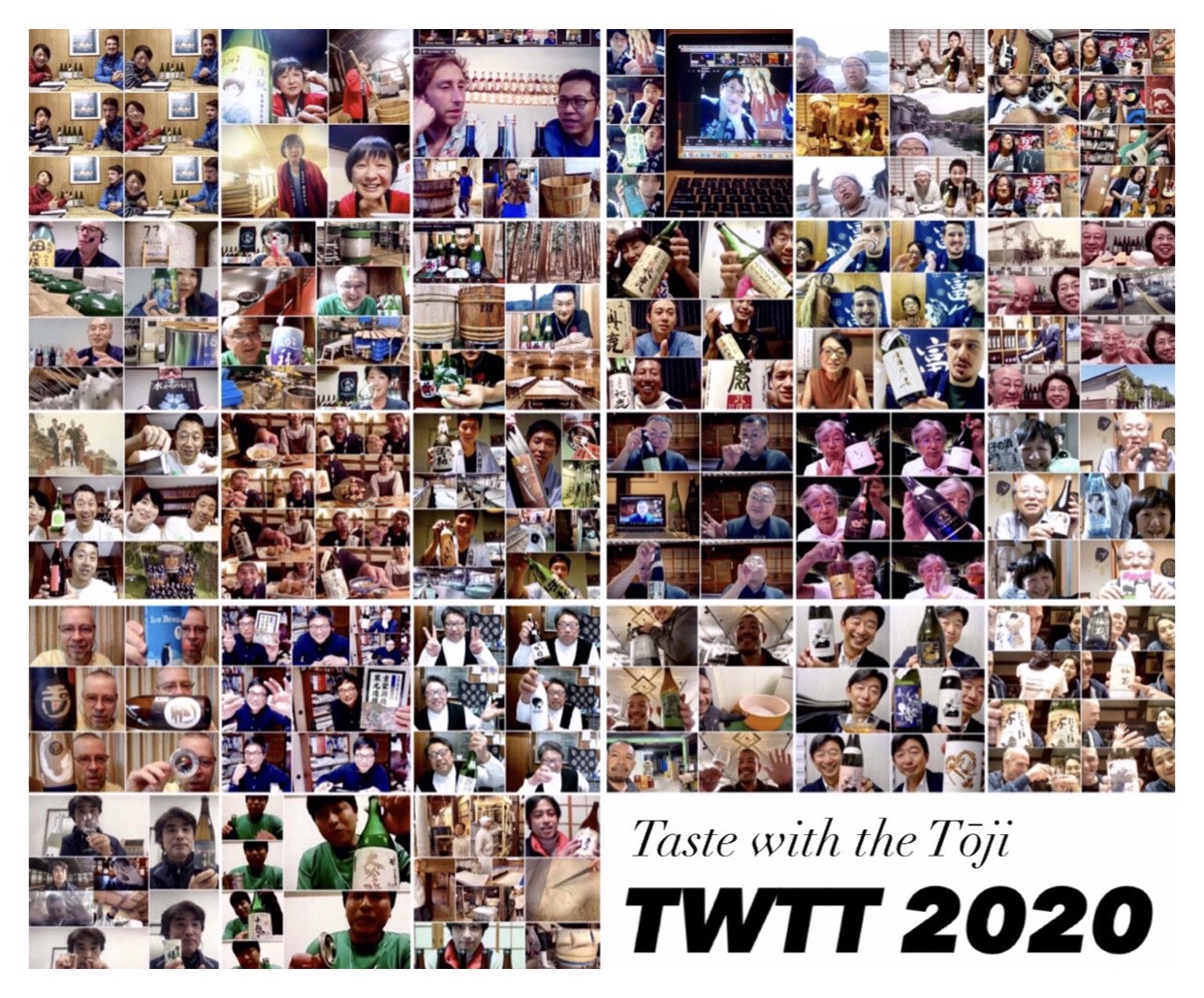
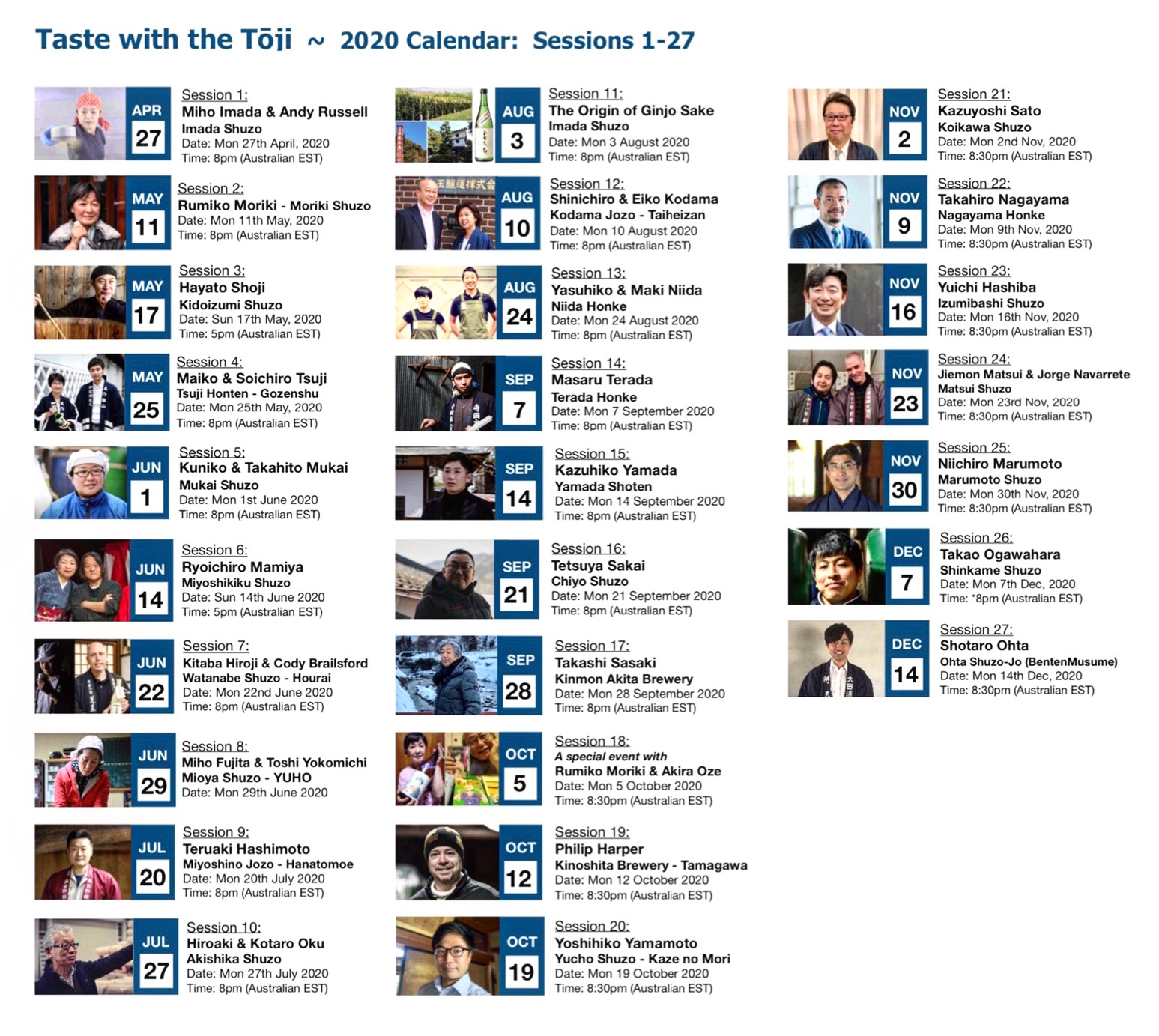
Taste with the Tōji ~ Session 27:
Shotaro Ohta – Ohta Shuzo
(Bentenmusume)
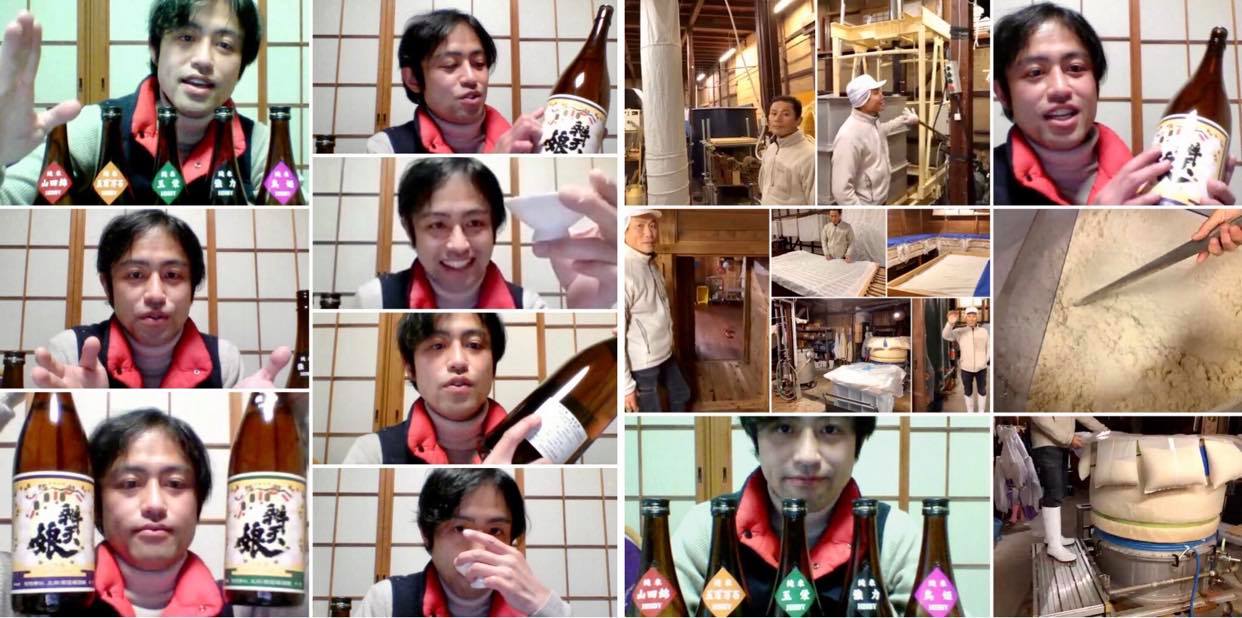
Monday 14 December saw the final TWTT session for 2020 as we spent 3 hours, (the scheduled 2 just wasn’t enough), with Shotaro Ohta from Ohta Shuzo in Tottori Prefecture.
This was a perfect way to end what has been a delightful and insightful series of online sessions that started way back in April this year when I decided that a lockdown during a global pandemic should not stop my desire or ability to promote sake, share it with new and old friends, and keep learning about this wonderful beverage. 8 months on and I couldn’t be more grateful for everything this project has been and has given me, and many others.
Ohta Shuzo, producers of Bentenmusume, is tucked away in the small town of Wakasa, the town in which all the rice used by this brewery is grown, (by the brewery and other local farmers) ~ this tiny, family operated brewery has a massive heart, a modest philosophy and a humble story. During brewing season, members of the community, residing in Wakasa town, pitch in to help brew ~ and at Ohta Shuzo everything is done, meticulously, by hand.
Rice was the hot topic of the evening and it’s evident that it is also the absolute star of Bentenmusume Sake. Using low aroma yeasts and kōji-kin that won’t produce a lot of sweetness, these guys are all about letting the rice shine. Ohta Shuzo use 5 different varieties of rice for brewing; with no blending of rice types, or even origin (i.e. farms), for any part of the brew (per single batch).
You’ll even find the name of the farmer who grew the rice on the back label alongside the rice type and ingredients. Respect.
Attendees were treated to a live virtual tour of the Kura, with a fabulously fleeting, yet extremely excitable appearance by his gorgeous little son, followed by a delightful ‘surprise’ appearance by Tōji, Nakajima-san, who offered some delightful demonstrations throughout the tour and suggested the secret to his youthful appearance was drinking good Sake! No arguments there.
Like every TWTT session, this was yet another wonderful insight into another brewery who are dedicated, determined and delivering some incredible Sake ~ and, as always, the time flew; with so much covered, yet still so much we could’ve talked about and learned. I guess there’s always 2021 for some follow-up sessions to some of these amazing breweries to delve even deeper into a number of fascinating topics.
I’m so incredibly grateful to the very humble Ohta-san for agreeing to do this session on short notice and also for sharing his time, passion and knowledge with us all for this very special session. A massive thank you also to Justin Potts for yet another wonderful translation and for going above and beyond as co-host for this session. I’m so delighted that Justin got to spend some time with Ohta-san and family at the brewery last week.
Thank you also to Taka and Rey from
Sakenet Australia, who not only put on a fun dinner event for some of the Sydney TWTT members who Zoomed in for this session, but also for bringing Bentenmusume Sake to Australia and for instigating a wonderful initiative to help this brewery. You can read more about that here:
https://sakenet.square.site/support-sake-maker… ~ and I do encourage fellow Australian Sake enthusiasts to get behind this project.
Last but not least, and as always, a HUGE heartfelt thank you to everyone who attended this session and/or any other session of TWTT this year. Let’s all keep supporting these incredible people behind this incredible brew that is Nihonshu!
Taste with the Tōji ~ Session 26:
Takao Ogawahara
– Shinkame Shuzo
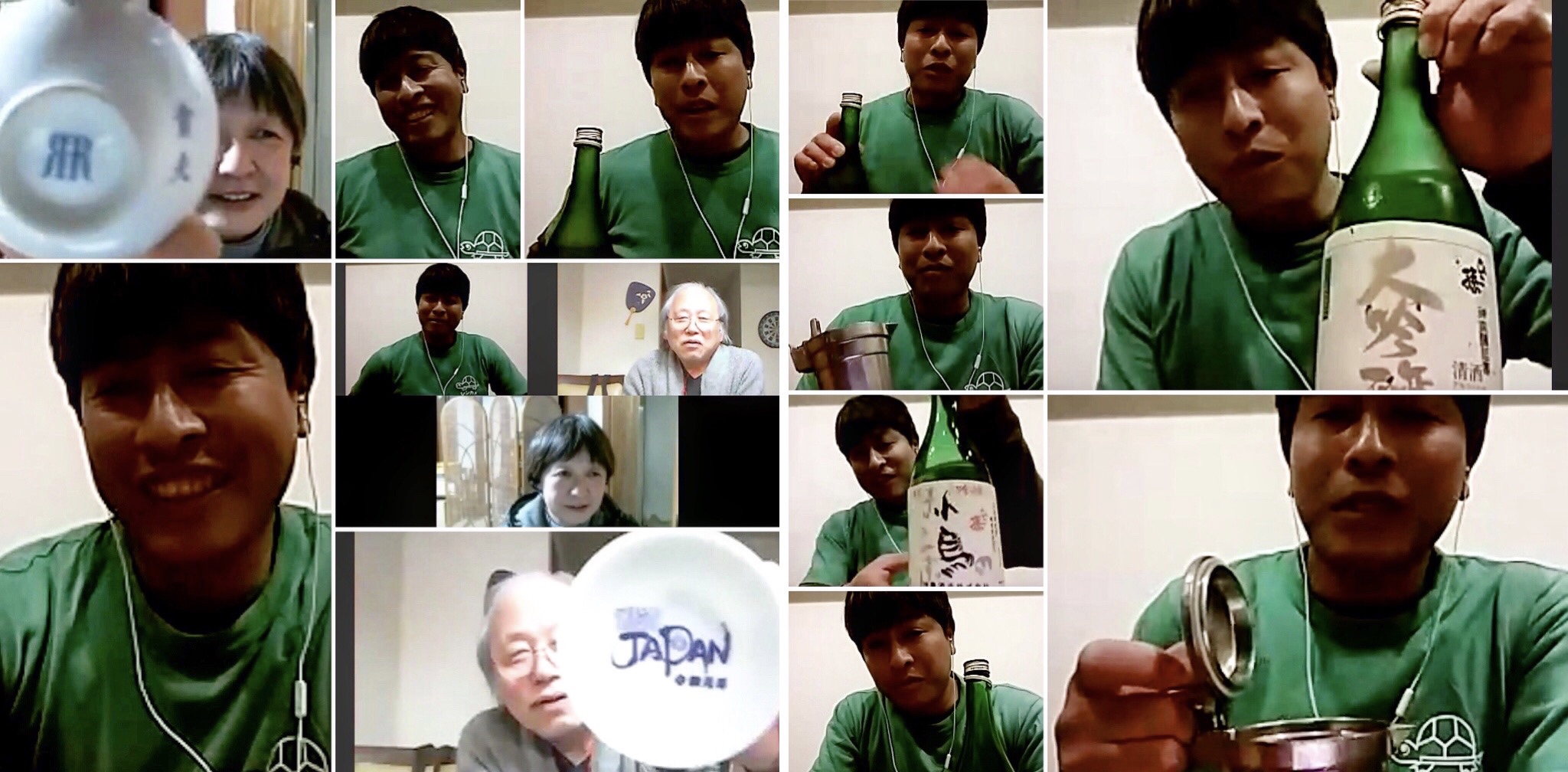
What a very special session of Taste with the Tōji on Monday 7 December, when we got to spend a couple of hours with Takao Ogawahara of Shinkame Shuzo in Saitama Prefecture.
Shinkame Shuzo is known to many who are lovers of junmai Sake and despite their popularity amongst these folk, as well as being a brewery that has had a large and significant impact on the Sake industry as a whole, these types of events are a rarity for this incredible brewery and it was an absolute honour to be able to host this TWTT online event with Shinkame Shuzo.
This was Session number 26 in the TWTT series and the name Shinkame has often come up in previous sessions, most memorably, Session #2 Moriki Shuzo with Rumiko & Hideki Moriki, and of course, Session #18 with Rumiko-san and Akira Oze, where the impact and influence of this pioneering brewery was strongly conveyed. That said, it was a wonderful additional honour to have both Rumiko Moriki and Akira Oze in attendance ~ as well as being involved in discussions during this session.
Again, a session full of deep discussion, touching on topics that certainly need a lot more than 2 hours to cover properly…. and we did go a little over time, for which I apologise as Takao Ogawahara-san and crew, currently in the midst of brewing season, are not only dedicated to the process and craft of their brewing, but also to 3am rises!
It is clear that the late Yoshimasa Ogawahara-San’s legacy is being carried on with great respect, passion and dedication through Takao-san and his team at Shinkame Shuzo.
If you’ve not already tried Sake from this amazing brewery, I implore you to do so. A favourite of mine for quite some time, and after last night, even more so!
A HUGE thank you going out to Takao Ogawahara for his time and sharing all things Shinkame with us all last night. A huge extension of that huge thank you going out to the one and only Mr. Justin Potts.. not only for an incredible translation and being a truly wonderful co-host, but for going above and beyond in the lead up to this event (and the next), and for everything he does for this industry and beverage that we all love so very much… not to mention for his ongoing and much appreciated support and friendship.
Thanks again to Rumiko-san and Oze-san for their contribution to this session, to
Masahiro Takahashi and
Rey Takahashi from Sakenet for their assistance, attendance and for bringing Shinkame Sake to Australia, and of course a big thank you to everyone who attended.
~ Kanpai!
Taste with the Tōji ~ Session 25:
Niichiro Marumoto
– Marumoto Shuzo
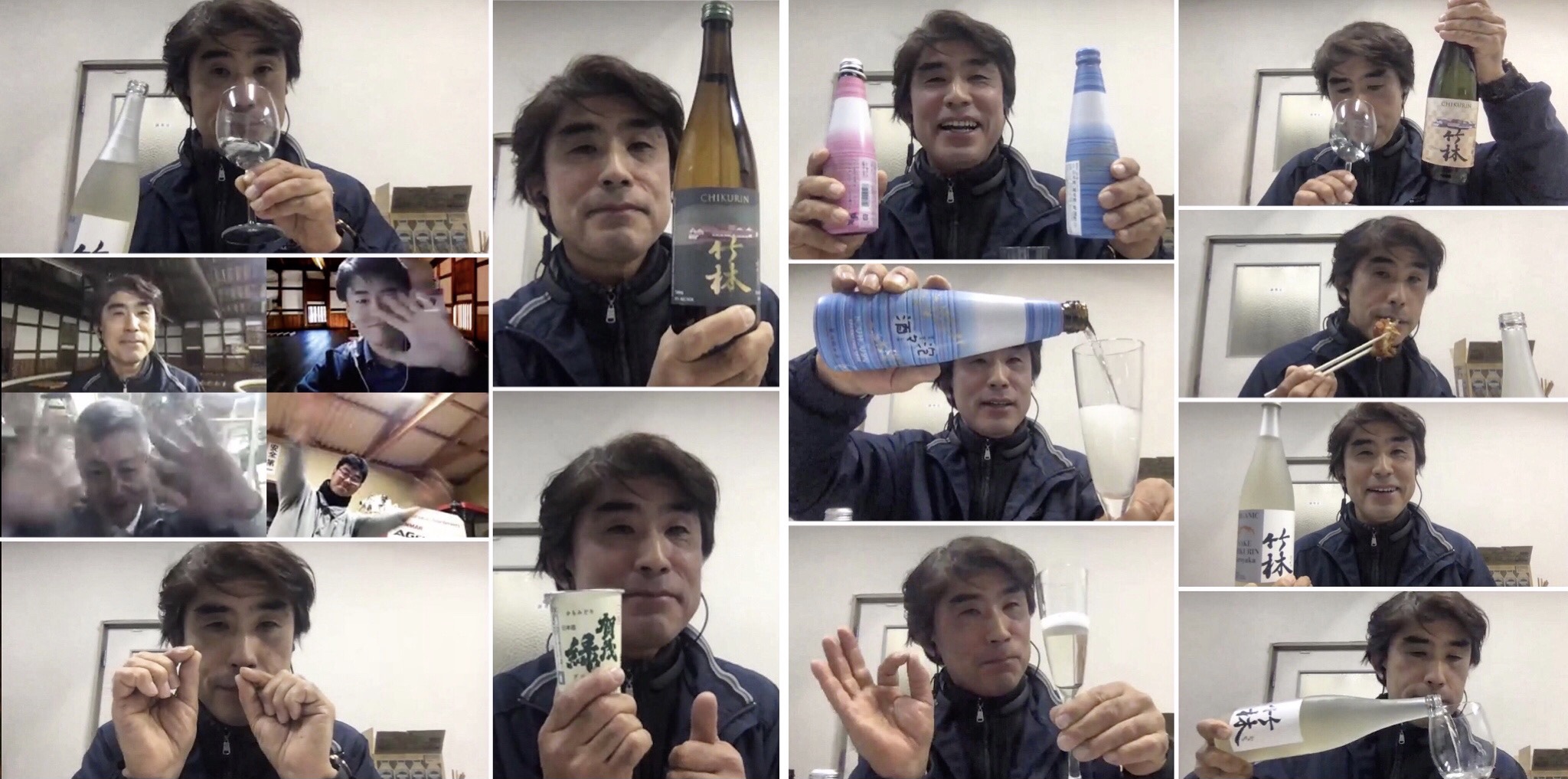
Session 25 of TWTT took place on Monday 30 November and was an absolute joy and yet another wonderfully enjoyable and educational session of Taste with the Tōji.
For this session, we headed to Okayama Prefecture and it was an honour to be joined by President and Brewing Manager, Niichiro Marumoto, along with 3 other members of Marumoto Shuzo; Toda-san, Endo-san and Arai-san, as we delved deep, VERY deep, into the topic of rice… (in a passionate, technical and super nerdy way, about rice!) From growing it to brewing with it ~ and everything in between! In fact, so deep did we delve, that we almost ran out of time for anything else, including the tasting/Sake line-up and general Q&A. Fortunately, Marumoto-san was incredibly generous with his time and gave participants an extra hour – turning the scheduled 2 hour session into a little over 3 hours.
This man and this brewery are truly fascinating and already, by popular demand, there is a second session with Marumoto-san in the pipeworks for TWTT in season 2021!
Thanks to Marumoto-san’s generous extra hour in the Zoom room, we were lucky enough to also hear a little about some of his creations ~ from his ぱふぱふ (PAFU PAFU) kōji dispersing machine to his self-composed techno beats!
Marumoto-san is definitely a man, and mind, of many talents. I’m still thinking of hitting him up to create a TWTT intro theme! So much covered in this session, yet still so much more to learn… as is always the case with SAKE! Hence why we love it so!
A huge thank you to Marumoto-san and his brewery staff, (Toda-san, Endo-san and Arai-san), for sharing their time, passion and knowledge! An extension of that huge thank you going out to
Christopher Hughes for a great job as translator and co-host for the evening. I also must thank Thomas Ng, who is soon to be Australia’s first importer of Marumoto’s Sake, for joining us last night. Those who participated from Australia are certainly keen for it to hit our shores in 2021. Also a big thank you to Andrew Russell for planting the seed for this session.
Last but not least, and as always, a heartfelt thank you to all who attended this very special and unique session of TWTT either via the Zoom room or Facebook Live. I’m so incredibly grateful for your support for this project and your continued interest and ever-growing love for SAKE!
ありがとうございました
~ Kanpai!
Taste with the Tōji ~ Session 24:
Jiemon Matsui & Jorge Navarrete
– Matsui Shuzo
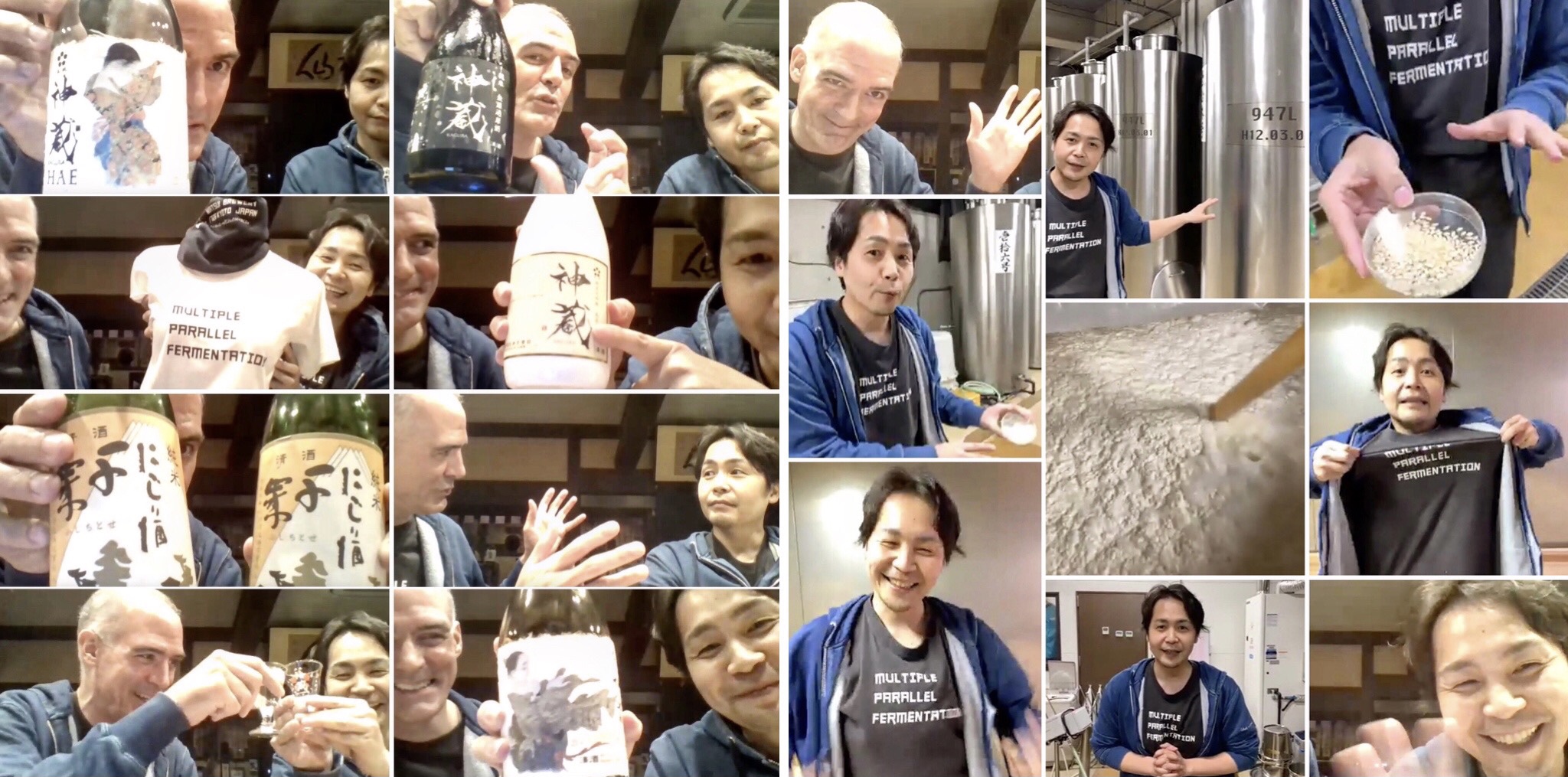
Session 24 of TWTT took place on Monday 23 November as we headed to Kyoto Prefecture to visit a brewery in the heart of Kyoto City. What a joy to spend over 2 hours with Jiemon Matsui and Jorge Navarrete from Matsui Shuzo for this wonderfully enjoyable session.
Matsui Shuzo is a small brewery with a big personality and an even bigger heart… not to mention a fabulous history of almost 300 years! Jiemon Matsui is the 15th generation owner of his family’s brewery!
Founded during the Edo period in 1726, this small craft brewery, which has moved around a little over the years, produces around 300 koku per year. Matsui Shuzo is now the oldest of the only 3 remaining Sake Breweries in Kyōto City.
It’s current incarnation is in a most unsuspecting location, situated on the ground floor of a residential building, which also neighbours a school; so unsuspecting that myself and possibly many others who have visited Kyōto have walked right past it without realising it’s a Sake Brewery. The brewery’s facility is state of the art; with stainless steel tanks, solar power and computerised cooling systems, all which allow for year-round brewing ~ yet their Sake is still very much ‘handcrafted’ and traditional.
Oh… and their merchandise/shop ‘uniforms’ are very cool indeed. I think a shipment of their ‘Multiple Parallel Fermentation’ t-shirts to Australia is in order, ASAP! At least until we can get their Sake here!
Again, I’m so thankful for another wonderfully informative and enjoyable session of TWTT. Each session is so different to every other session and we learn new things from new people each time. A huge thank you to Matsui-san and Jorge for their time, passion and knowledge, for lots of good humour and laughter, and for telling us their stories.
As always, thank you to everyone who attended via the Zoom room and/or FB Live.
Keep drinking Sake!
Kanpai!
Taste with the Tōji ~ Session 23:
Yuichi Hashiba – Izumibashi Shuzo
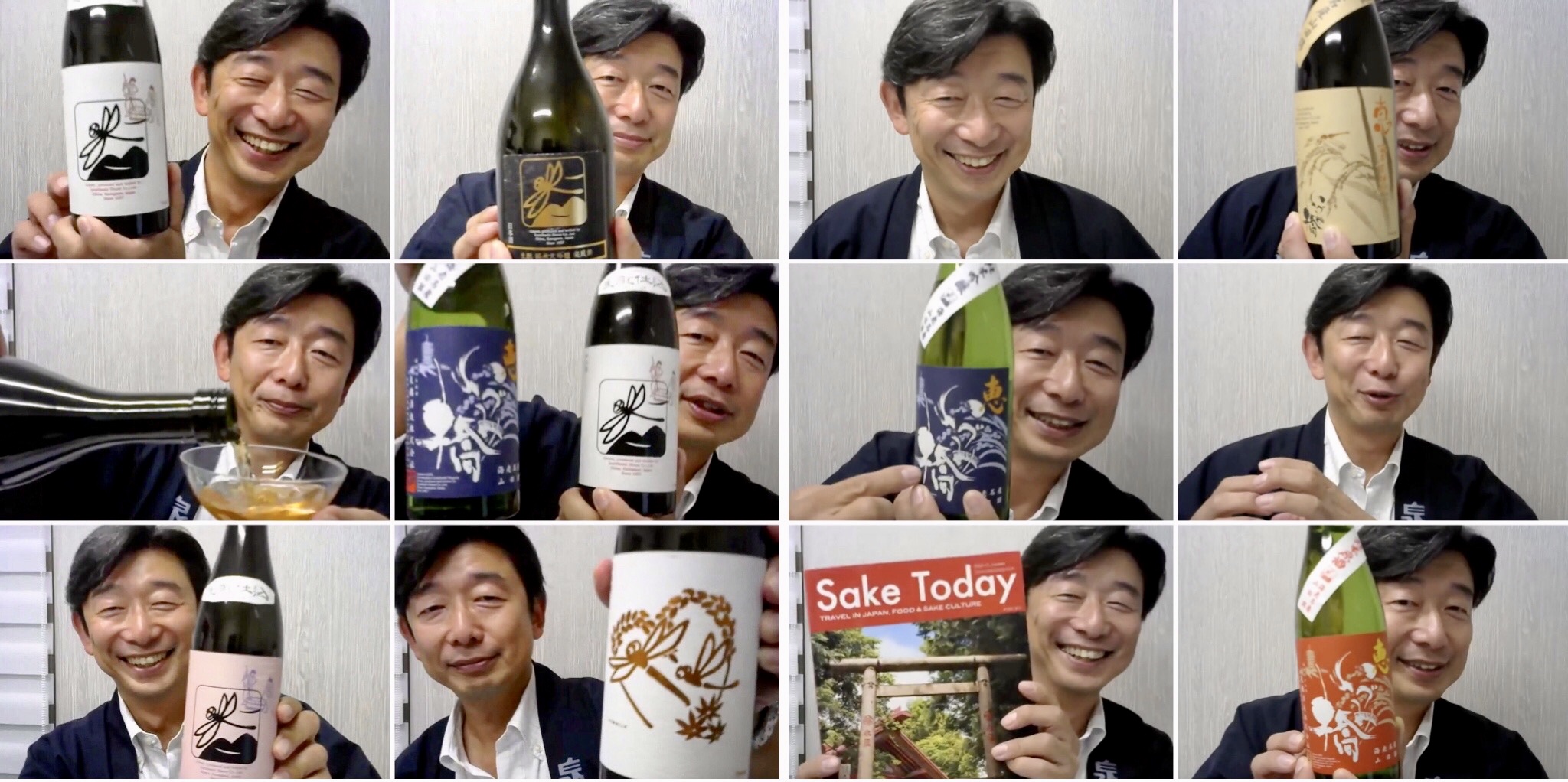
Session 23 took place on Monday 16 November and saw yet another wonderfully entertaining, educational and thoroughly enjoyable session of the Taste with the Tōji series as we headed to Kanagawa Prefecture, joined by Yuichi Hashiba of Izumibashi Shuzo.
Hashiba-san’s infectious sense of humour and passion burst through our screens as he told us about the philosophy of Izumibashi, their dedication to growing eco-friendly rice & strive for quality and respect for nature; all mixed in with stories of dragonflies, drones and some unique and memorable Sake analogies.
Hashiba-san is no stranger to these online sessions and came fully prepared with an array of interesting slides and videos to share with an engaging audience. Wonderfully generous with his time, he even stayed back a little for the Nijikai to answer a few more questions and Kanpai with the stayers.
A big heartfelt thank you to Hashiba-san for sharing his time, passion, knowledge and humour with all who attended, and of course that gratitude is extended to Rey Takahashi from Sakenet Australia, (Australian importers of Izumibashi), for his time and translation.
Thank you, as always, to all who attended, for your support for TWTT and passion for Sake!
Keep drinking Sake and keep supporting these great breweries.
Taste with the Tōji ~ Session 22:
Takahiro Nagayama –
Nagayama Honke
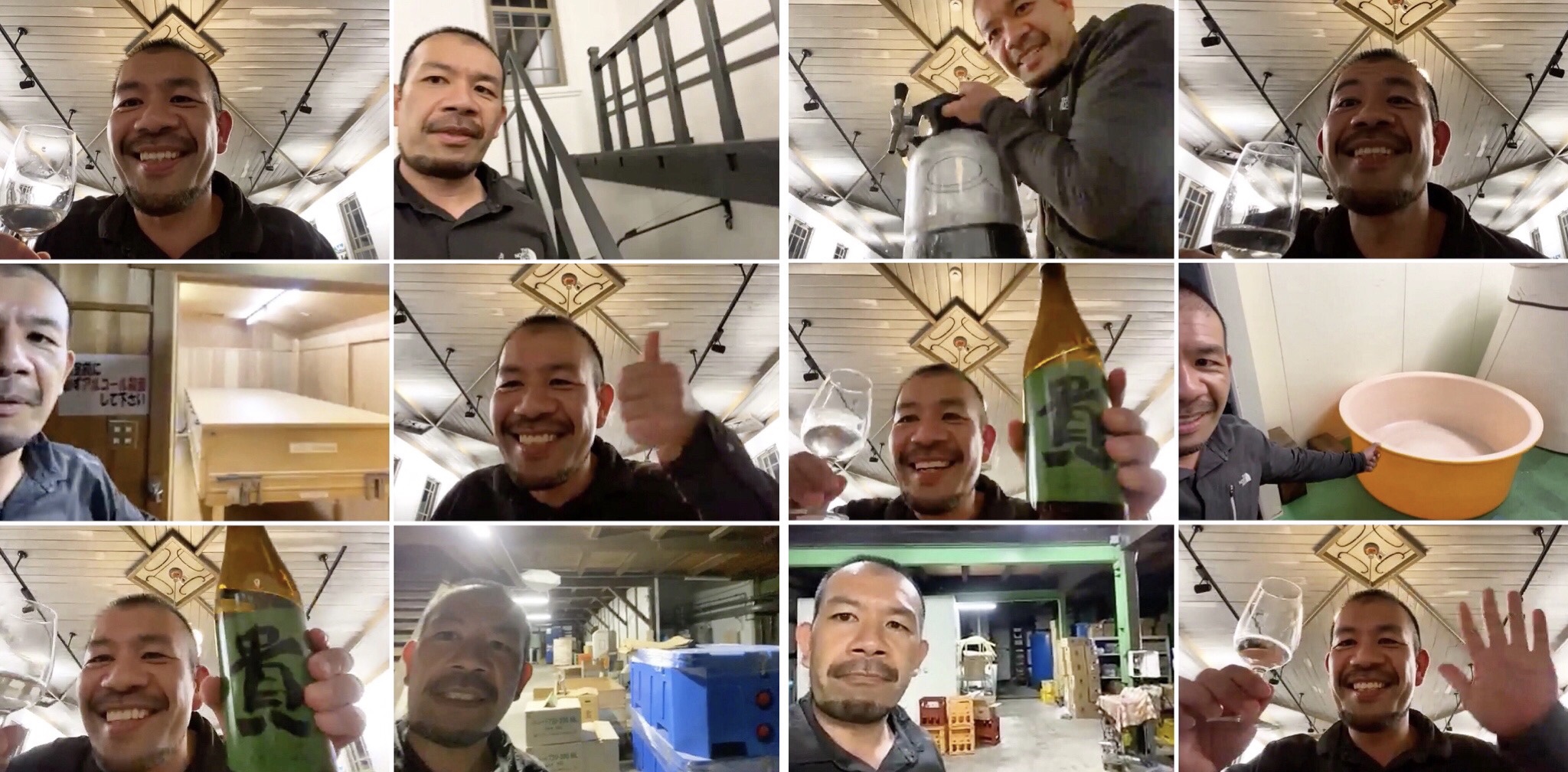
Session 22 of TWTT took place on Monday 9 of November as we headed to Yamaguchi Prefecture to gain some fabulous insight into the philosophy of Nagayama Honke, told to us by Takahiro Nagayama, current Kuramoto and Toji, as he joined us from the brewery cafe.
.
‘Think globally, act locally’, as printed on the back label of many a Taka Sake. On the topic of labels.. we also found out that the kanji calligraphy/Taka logo on the front was created by Taka-san himself, with his left hand (non-preferred hand) some time ago.
From a virtual tour of the kura, and a look inside their beautiful cafe space, (which was once served as the old Town Office building), where they now serve Sake on tap, to thoughts on terroir and his inspiration acquired from visits to vineyards in France ~ there’s always a lot to try and cover in a two hour session but what does get covered is always interesting and educational.
We also touched on their rice growing, (Yamada-Nishiki), and their hopes to grow Omachi in the future.
A huge thank you to Taka-san for spending his time with us and for sharing his knowledge, thoughts and hopes as well as his large and luminous smile which lit up our screens as we got to sit back, sip Sake and learn a little more about another wonderful brewery. That thank you is extended, of course, to Jim Rion
for his wonderful translation for this session, and again, as always, thank you to all who attended!
Kanpai!
Taste with the Tōji ~ Session 21:
Kazuyoshi Sato – Koikawa Shuzo
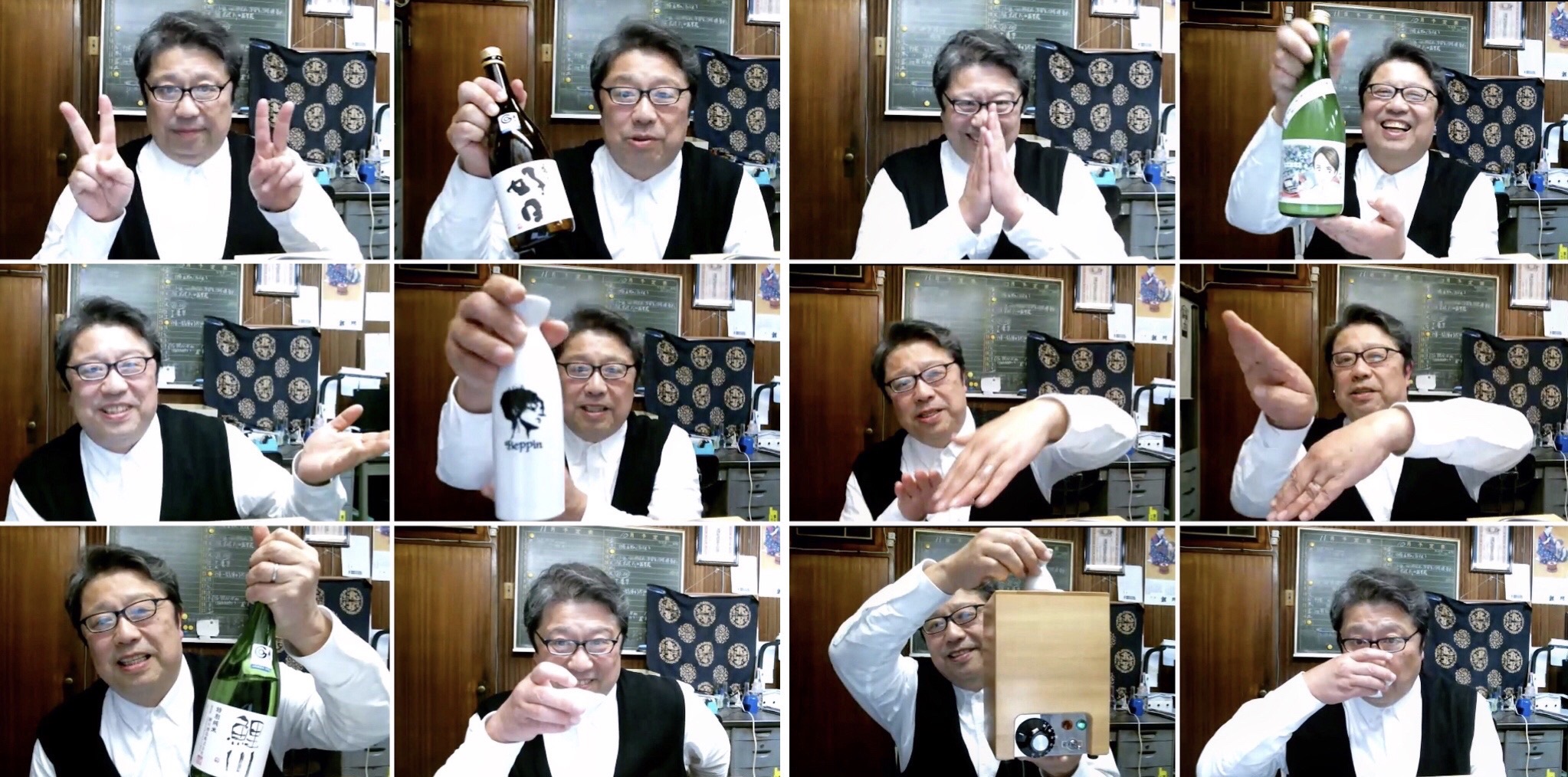
Session 21of TWTT took place on Monday 2 November and took us to Koikawa Shuzo in
Yamagata Prefecture. It was an honour to spend a couple of hours talking with brewery president, Kazuyoshi Sato.
A great discussion and lots of Q&A dedicated to the fascinating world of
Kameno o rice.
This brewery has a wonderful connection to this rice variety which was the inspiration for the ‘phantom’ rice in Akira Oze’s ‘Natsuko no Sake’. Kameno o, it seems, is a little ‘phantom-like’ itself.
This session educated and entertained as we not only heard stories from the brewery and their philosophy and aspirations, but also gained some insight into Sato-san’s life outside of Sake brewing through his musical inspirations and achievements. We were even treated to a somewhat exclusive listen to a little Sake jingle he had recently recorded. A joyous way to finish a fun and educational session.
Big thanks to Sato-san for his time, knowledge, passion and joy. An extended thank you to Rey Takahashi from
Sakenet for translating for this session… and, as always, thank you to everyone who attended.I am absolutely delighted and honoured that this little project, that I started back in April, is still going strong in November ~ with more sessions to come.
In the words of Sato-san: “Let’s enjoy Sake, hot or cold-o!”
Koikawa Sake is available in Australia through
Sakenet.
Taste with the Tōji ~ Session 20:
Yoshi (Chobei) Yamamoto –
Yucho Shuzo: Kaze no Mori
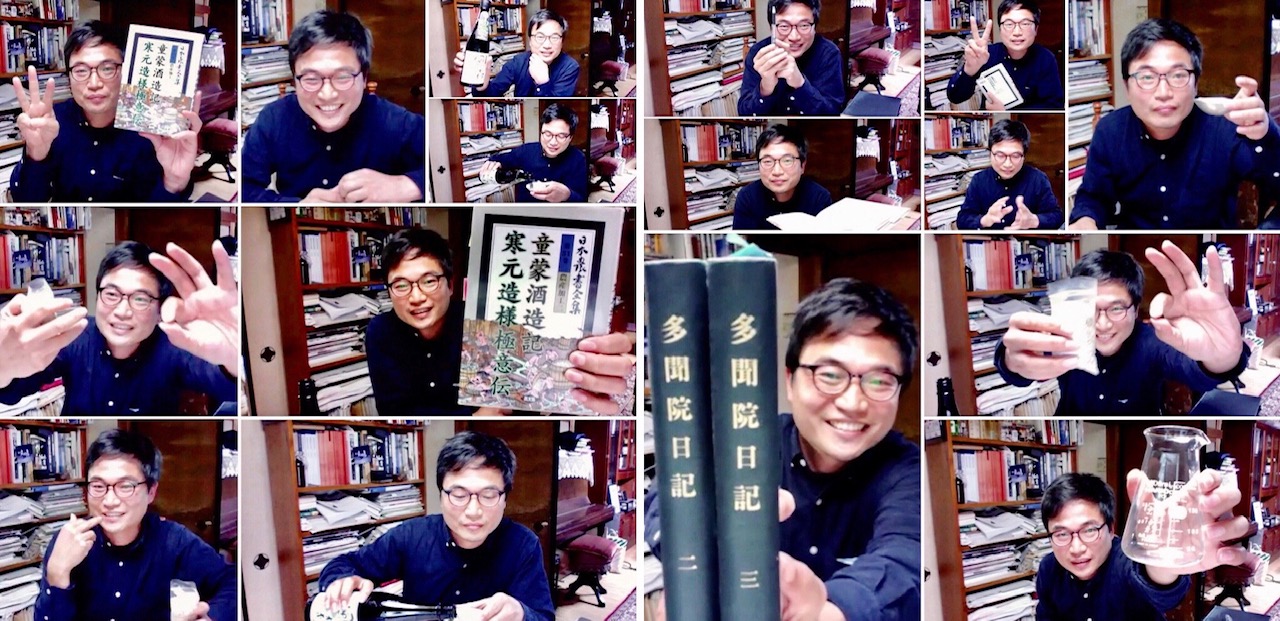
Session 20 of TWTT took place on Monday 19 October ~ for this session, we headed to Nara and we were joined by the incredible Yoshi ‘Chobei’ Yamamoto from Yucho Shuzo.
What an incredibly deep delve into some fascinating history and rich cultural elements relating to ‘Nara Sake’ and Bodaimoto ~ and the evolution of the brewing process, fermentation and rice polishing process. As well as a great discussion about table rice and sake rice.
From the birth of Bodaimoto over 500 years ago to the birth
of Kaze no Mori Sake in 1998, Chobei-san certainly covered some ground over a wonderfully insightful 3 and a bit hours!
‘Nara Sake’, produced since the Muromachi period (1336-1573), reached its height during the Sengoku period (1467-1615). This happened with the birth/creation of the technique called Bodaimoto at Bodaisan Shoryakuji Temple. Hence, Nara then became the birthplace of ‘refined’ Sake in Japan.
We have a lot to thank those Monks for!
Chobei-san did a remarkable job of preparing a huge amount of information in the form of slides and an even more remarkable job at presenting this session in English!
It was great to get an insight not only into the history of sake in Nara but also into this fascinating brewery and their philosophy.
The philosophy behind ‘Takacho’ at Yucho Shuzo is about honouring tradition and passing down culture to future generations. Together with a respect for tradition, they are embracing their own evolution through modern technology and progressive thinking (and drinking).
With their Kaze no Mori line, they are renewing conventions and creating new traditions, not to mention some incredibly delightful Sake!
Sake made by a set of rules, which include:
Unpasteurised
Undiluted
Unfiltered (after pressing)
A truly great, educational and fun session with so much covered, so much learnt ~ yet still so much to learn!
A HUGE thanks to Chobei-san for his time, energy, knowledge and passion! Thank you also to all who attended the Zoom Room and to those who joined via FB Live.
Yucho Shuzo’s sake is available in Australia through
Sake Shop.
Taste with the Tōji ~ Session 19:
Philip Harper – Kinoshita Brewery: Tamagawa
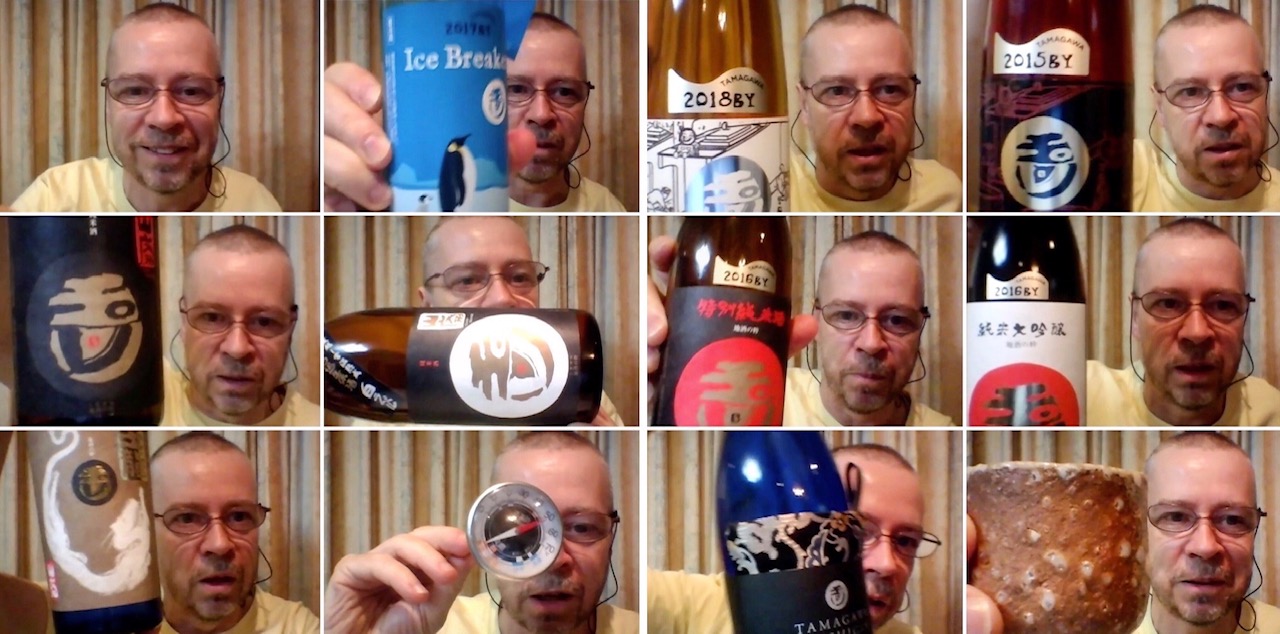
Session 19 of took place on Monday 12 October and saw a most epic session, (some might say ‘Sake Marathon’), of Taste with the Tōji ~ every bit an absolute joy ~ with Philip Harper of Kinoshita Brewery, (Kyoto Prefecture).
This session provided a wonderful opportunity to gain further insight into this fascinating brewery and its Tōji, who of course needed no introduction to the TWTT audience.
Philip was so incredibly generous with his time and knowledge/information ~ speaking in a candid manner on many topics, including brewing methods, spontaneous fermentation, temperatures, ageing and of course, serving it (sake) hot… (we’re taking beyond atsukan). Philip encouraged the audience to step outside the square ~ to play around with different serving temperatures and to NOT be afraid to crank up the heat when it comes to Tamagawa ~ i.e Ice Breaker at (a minimum) 70 degrees Celsius. I can’t say I’ve ever tried a Namazake at such a high temperature, but I will vouch for it being delicious at one after trying it last night ~ (as were the others I tried at the same or similar temp).
The two hours allocated for the session flew by and, with so much more for Philip to say and the audience to hear, ask and learn, somehow morphed into a massive 5.5 hours (for the stayers anyway ~ of which Philip graciously was one). A MAMMOTH effort and a most insightful session for all who attended (be for the 2 or 5+ hours).
A huge and heartfelt thank you to Philip Harper for an incredible TWTT session.
Thank you to all who attended the Zoom Room and to those who tuned in to the session via FB Live.
Tamagawa sake is available in Australia through
Sakenet.
Taste with the Tōji ~ Session 18:
A Special Event with
Rumiko Moriki & Akira Oze
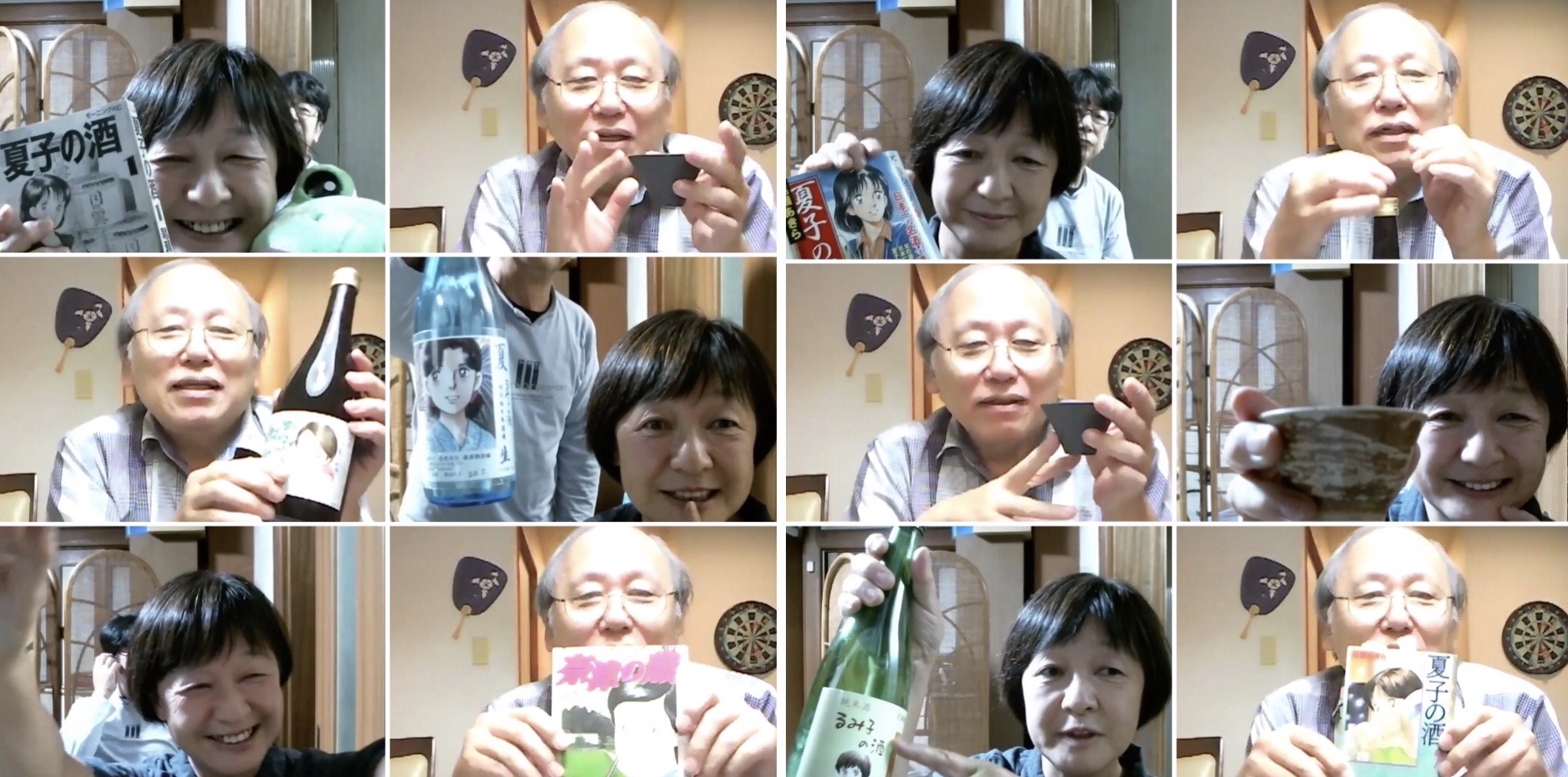
What a joy and an absolute honour! Session 18 of TWTT took place on Monday 5 October and was a most unique one. We were joined by two living legends, from two different fields, brought together by a Manga comic and their shared passion, inspiring a 30 year friendship that has continued to this day.
The dynamic friendship and mutual respect between Rumiko Moriki and Mr. Akira Oze filled the Zoom room with a beautiful energy and it was a pleasure to listen to their individual stories and the story of their friendship ~ which began when Rumiko’s family brewery fell upon hard times some 30 years ago. It was during this time she obtained a copy of the Manga, Natsuko no Sake: The story of Natsuko Saeki, the daughter of a sake brewing family who is working for an advertising company in Tokyo. She returns to her family’s home in the countryside and finds her brother, Yasuo, searching for a “phantom” rice seed called Tatsu Nishiki, rumored to create a new form of sake. Shortly after he finds the seeds, he passes away suddenly. Natsuko quits her job and begins working at the sake brewery to honour and achieve Yasuo’s dream of making the best sake in Japan with Tatsu Nishiki rice.
It was late one evening that Rumiko began reading Natsuko’s story. She was so enthralled in the story that she read the complete volume that night. She had been so touched and inspired by the story that as soon as she finished reading the book, she penned a letter to Mr. Akira Oze that same evening. Her letter was one of gratitude but also to tell Mr. Akira Oze of her own story, which included many parallels to Natsuko’s story, including sharing the same birthday! When Rumiko read that Natsuko’s birthday was the same as her own, she thought it must be some kind of fate; that she came upon this story, which resonated so deeply and gave her a strong sense of encouragement and inspiration. She posted her letter to Mr. Oze the following morning.
Rumiko had not expected a reply from Mr. Oze, so when one came, she felt extremely humbled and delighted. After reading Rumiko’s letter, Mr. Oze himself was touched by her story – he exclaimed “Natsuko is a real living character!” He too was astonished and intrigued by the parallels of these two stories and wanted to meet Rumiko and help her in her own quest to make delicious sake, get her family’s brewery back on its feet and learn as much as she could from other brewers. Mr. Oze’s introductions to Rumiko proved invaluable and through these introductions, mentors came into Rumiko’s life who helped her not only achieve her goals but surpass them.
Such a beautiful story, a delightful friendship, and an honour to spend over three hours with Rumiko and Mr. Oze last night. ( An unexpected treat that they both stayed on for some time after the 2 hour session finished ).
Thank you so much to the ever amazing Rumiko Moriki and Akira Oze for such a wonderful opportunity and a most enjoyable event.
Thank you also to my good friend Harald deRopp for a wonderful job with translation, and of course an extended thank you to all who attended.
Taste with the Tōji ~ Session 17:
Takashi Sasaki – Kinmon Akita Brewery
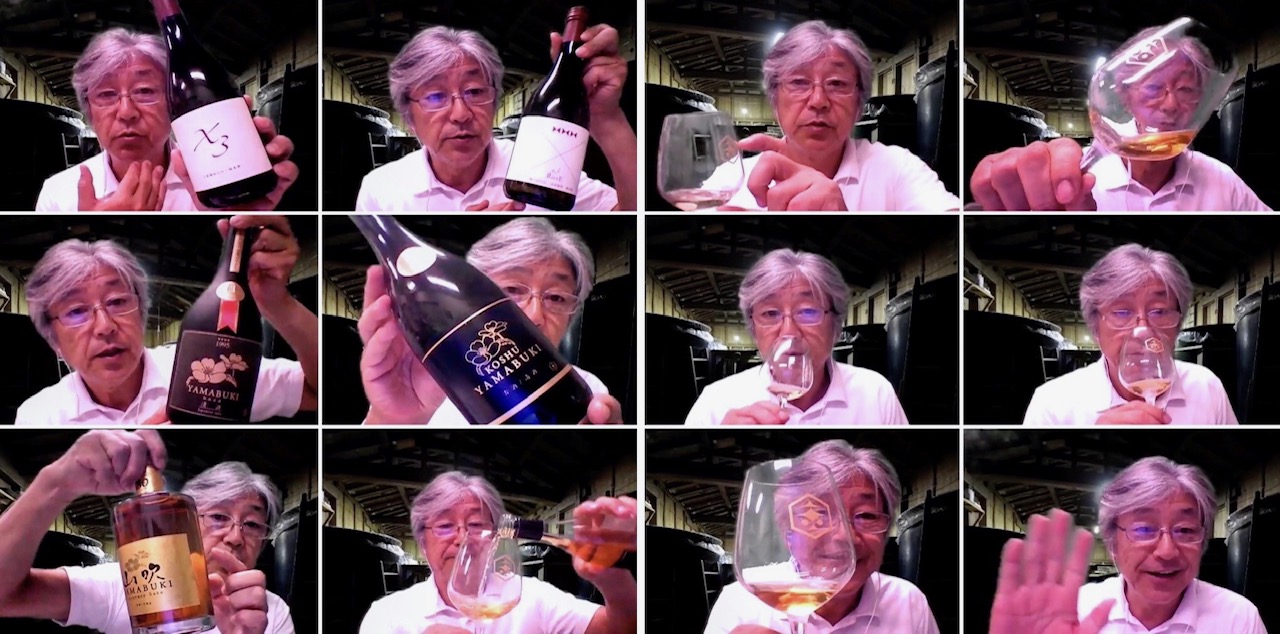
Monday 28 September saw Session 17 of TWTT take place, as we headed to Akita Prefecture to visit Kinmon Akita Brewery. We were joined by the brewery’s President, Takashi Sasaki.
Kinmon, in its current incarnation, was formed in 1973, however, the brewery dates back to 1936 when the original company, Akita Fuji Sake Brewery, was established.
After an introduction from Sasaki-san, who also showed us some great footage of the brewery’s old ‘Fune’ press and some other brewery visuals, we learnt ab
out the brewery’s strong focus on aged sake.
The brewery lists their 3 principles as: UMAMI (of rice), maturing and blending ~ with a mission to expand the possibility of sake based on these three principles.
They, of course, produce other styles of Sake too such as their X3 range, which, as was discussed, uses around three times the amount of Kōji (than ‘average’), with a couple from that range using Shiro Kōji (White Kōji) instead of the more common, (for Sake), Yellow Kōji.
Kinmon also produce a range of Umeshu, all
made using a base of Junmai Sake, some with a base of blended aged Sake.
An interesting and informative session and another brewery for many to add to their itinerary once travel opens up again.
A huge thank you to Takashi Sasaki for his time, which went well over the scheduled 2 hours, and also to my Sake buddy in Sendai, Justin Velgus who translated for the event.
Finally, thank you to all those who attended Session 17. It’s always great to see Sake lovers coming together from all over the world – united by our love/interest/curiosity for Sake.
Kinmon sake is available in Australia through
Supersake.
Taste with the Tōji ~ Session 16:
Tetsuya Sakai, Chiyo Shuzo
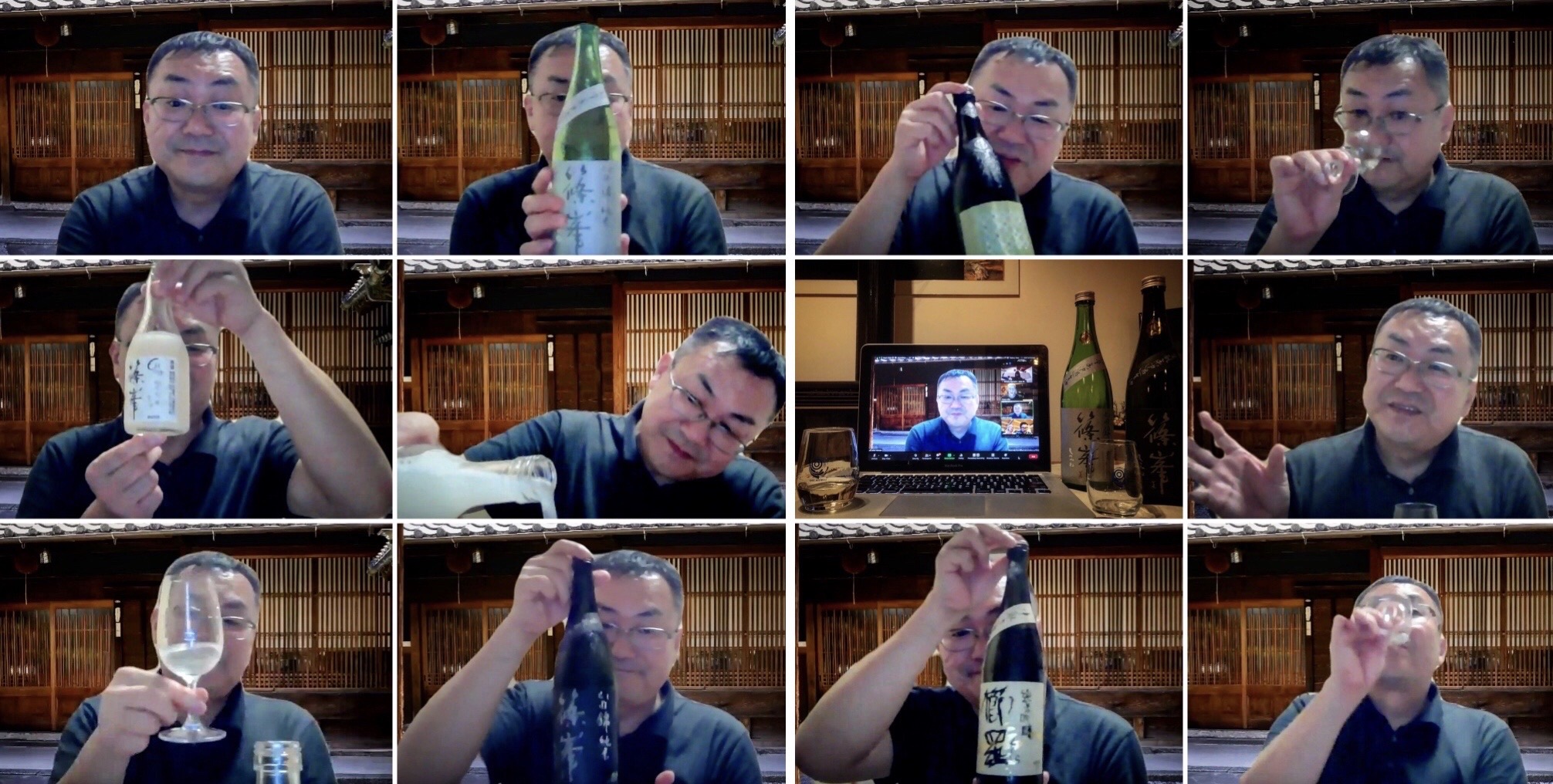
Monday 21 September saw Session 16 of TWTT ‘travel’ to Nara to spend time with Tetsuya Sakai, Tōji and Kuramoto @ Chiyo Shuzo.
What an honour to listen to this fascinating man speak to us about his life, his journey into Sake, his brewing methods, his philosophies, his hopes and so much more during this insightful and most enjoyable 2 hour session.
Still so much we could’ve asked and so much more to learn about this Nara-based brewery producing incredible Sake. No doubt Sakai-san will have many new visitors to his brewery once TWTT attendees are allowed to travel again.
I’ve said before that one of the things I love most about this project is that every session is so different ~ each brewery has their own unique story. It is such an honour to get to hear these stories from the wonderful storytellers, be it the Tōji and/or the Kuramoto (in some cases the same person is both), who in addition to their brewery’s story, have their own unique story. It was an honour to get an insight into Sakai-san’s story last night and it’s always an honour to drink Chiyo Shuzo Sake.
A heartfelt thank you to Sakai-san, to Yoram Ofer for yet another wonderful translation, and of course to all who attended for their support not only for this project and the breweries involved but for Sake in general.
Taste with the Tōji ~ Session 15:
Kazuhiko Yamada,
Yamada Shoten
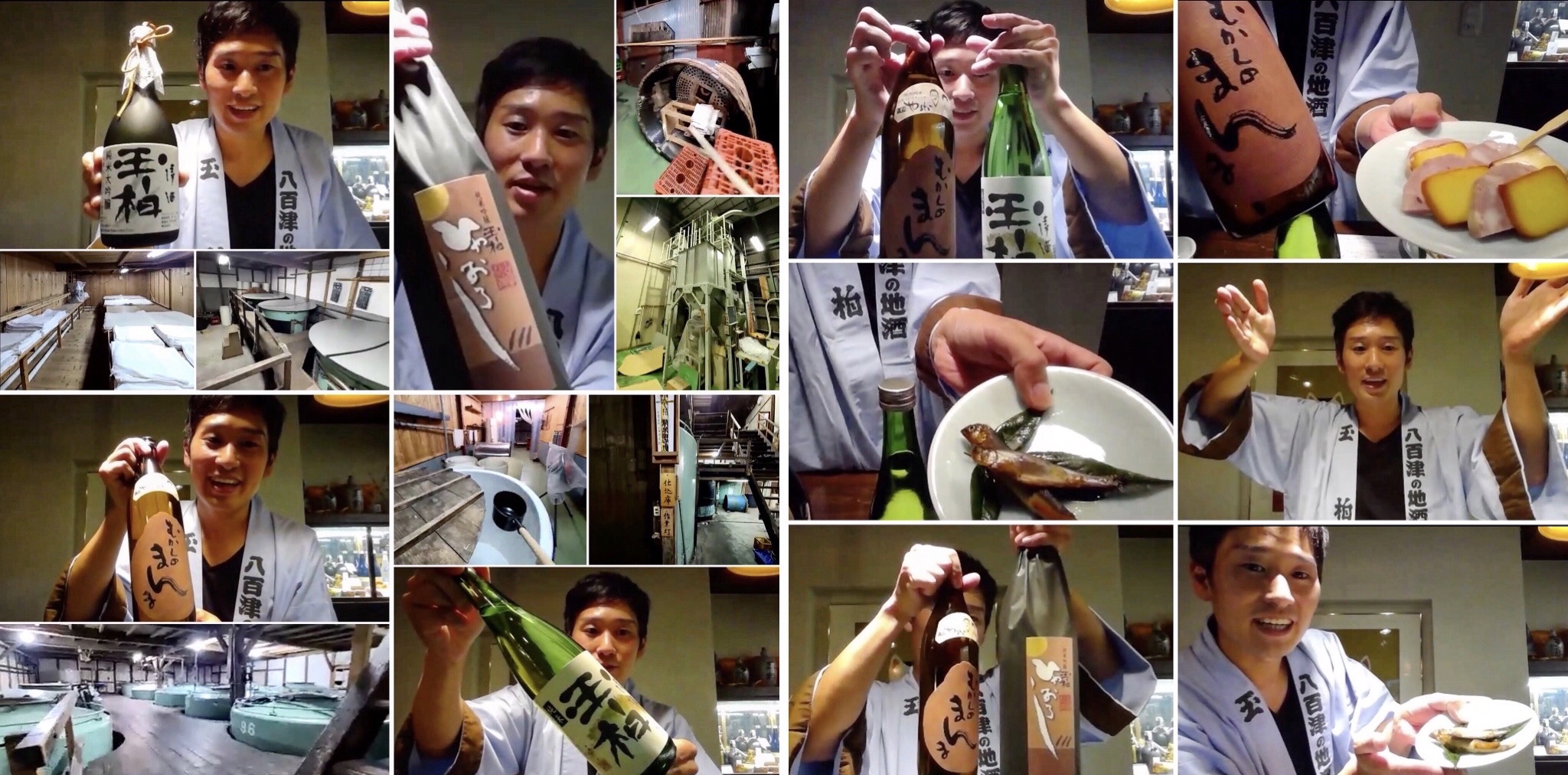
Session 15 of Taste with the Tōji took place on Monday 14 September and featured Yamada Shoten, who are located in the beautiful, mountainous Gifu Prefecture.
We were joined by the brewery’s president (Kuramoto),
Kazuhiko Yamada.
Yamada Shoten was founded in 1868, and is located in Yaotsu, (in southern Gifu), a basin plain with an elevation of 120 meters, with low hills extending to the distant Kiso mountain range.
After Yamada-san’s introduction, he gave us a wonderful virtual tour of inside the kura.
With the knowledge that this brewery’s volume of production was quite small, at only 250 koku (45 kiloliters) a year, it was rather surprising (for many) to see how big in size this brewery is, structurally ~ one attendee even commented it’s like a ‘kura mansion’.
The scale of the brewery made more sense once Yamada-san explained that at one time they were producing around 3000 koku (roughly 540 kiloliters), but decided to scale back production in order to focus on quality rather than quantity.
It was also surprising to see that this, now small production, brewery has their own rice milling machine, which ultimately gives them more quality control from start to finish in producing their sake. Yamada-san explained that being able to monitor the rice during milling, allows them to plan their brewing based on the condition of the grains and bran.
The kura tour was followed by a presentation and discussion based around a selection of their sake, including the Mukashi no Manma – which is currently the only sake from Yamada Shoten available in Australia. This is also the only bottle they produce in the rather rare size of 900ml ~ which I personally think is a great size. This bottle has a rather striking label with lovely sentiments as well as a cute little shoulder label depicting Yamada-san’s great grandparents.
It’s no secret that COVID has had an impact on sake breweries and the industry in general, but on top of that, this year saw some devastating weather: heavy rain, high winds and floods causing havoc throughout various parts of Japan. On July 8th, the area of Yaotsu and surrounds were hit by heavy rain and high winds. Yamada Shoten was damaged as a result. The old kura lost part of its roof, and tiles were lost in around twenty spots, making the building unusable for a time.
They are currently still working to restore the brewery to its former glory, despite the added difficulties of the COVID-19 pandemic.
Fortunately, they are still able to begin brewing on schedule this coming season and we wish them all the best in their efforts of restoration and may they overcome the pitfalls and setbacks of 2020 and have a successful 2021!
A huge thank you to Yamada-san for an enjoyable and insightful session – and another huge thank you to Jimmy Rion for being a most excellent translator for this session.
Taste with the Tōji ~ Session 14:
Masaru Terada,
Terada Honke
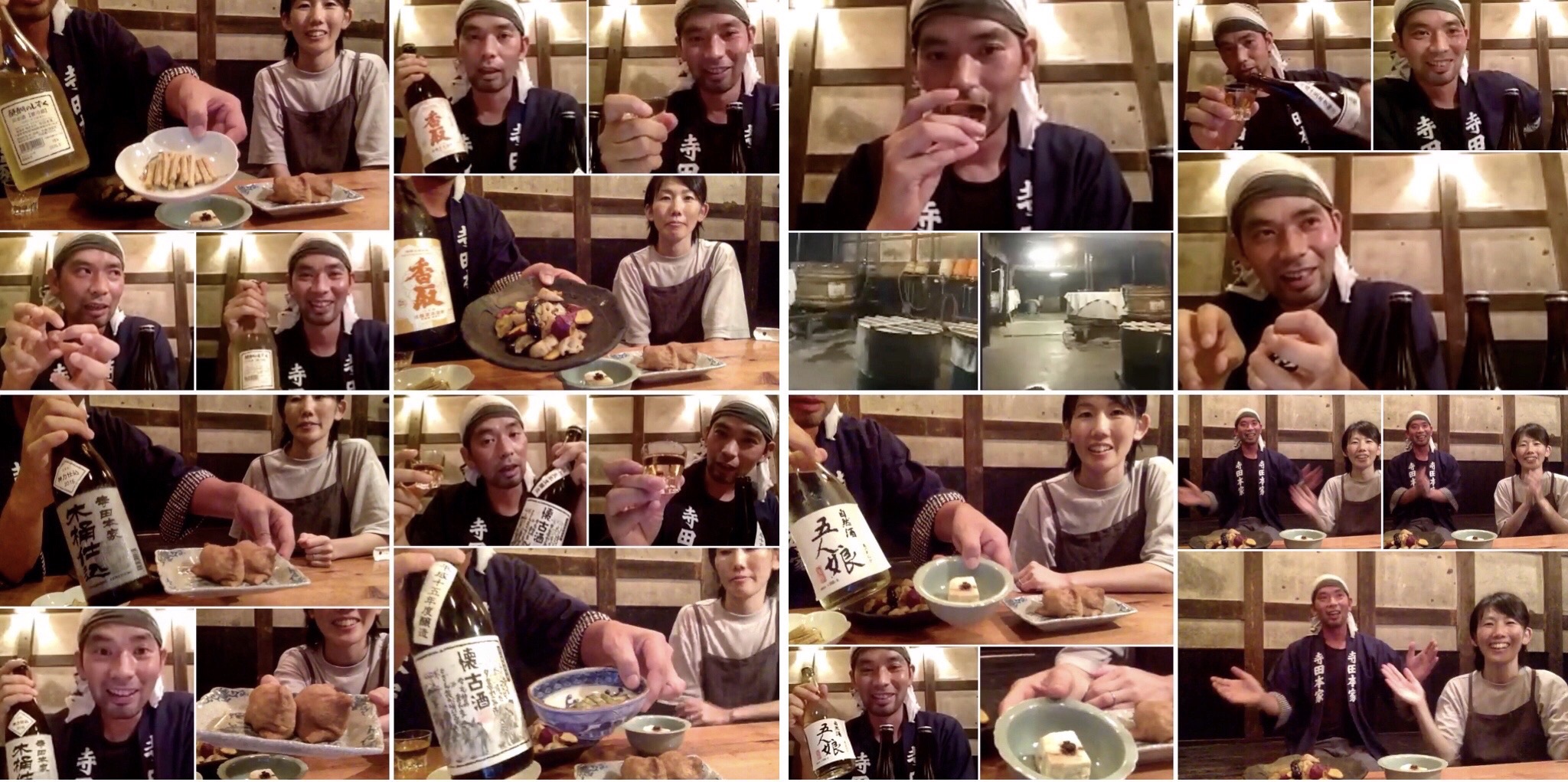
On Monday 7 September, Session 14 of Taste with the Tōji took us to Chiba Prefecture for a delightful 2 hours with Masaru Terada, the 24th generation owner of Terada Honke.
A few technical issues allowed us only a fleeting glimpse of inside the kura before the brewery’s wifi chose to not cooperate, however, in some ways this was a blessing in disguise as it gave us more quality & question time with Terada-san and his undivided dedication
and attention. Something for which I’m sure many were grateful for as there is so much to learn from this brewery, with such a rich history, who have been brewing Sake for almost 350 years!
Terada-san’s wife, Satomi-san, also joined us after cooking up a storm, to present an array of dishes designed to pair with Terada Honke Sake ~ leaving us salivating and wishing we could teleport to Chiba to join them and savour the delicious looking food.
Despite wifi issues preventing us from touring around the brewery, Terada-san was a man of his word, keeping his promise and treating attendees to a beautiful performance; singing a brewing song, with Satomi-san joining in and attendees clapping along ~ such a treat and such an honour! And a most delightful way to close a fabulous 2 hour session.
I’m so grateful to Masaru Terada and Satomi-san for sharing their time and their joy with all who attended, and of course most grateful, as always, to Yoram Ofer for another wonderful translation.
Big love and thanks to all who attended, forming what was the biggest ‘Zoom Room’ crowd yet for TWTT.
Terada Honke Sake is available in Australia via
Black Market Sake.
Taste with the Tōji ~ Session 13:
Yasuhiko and Maki Niida,
Niida Honke
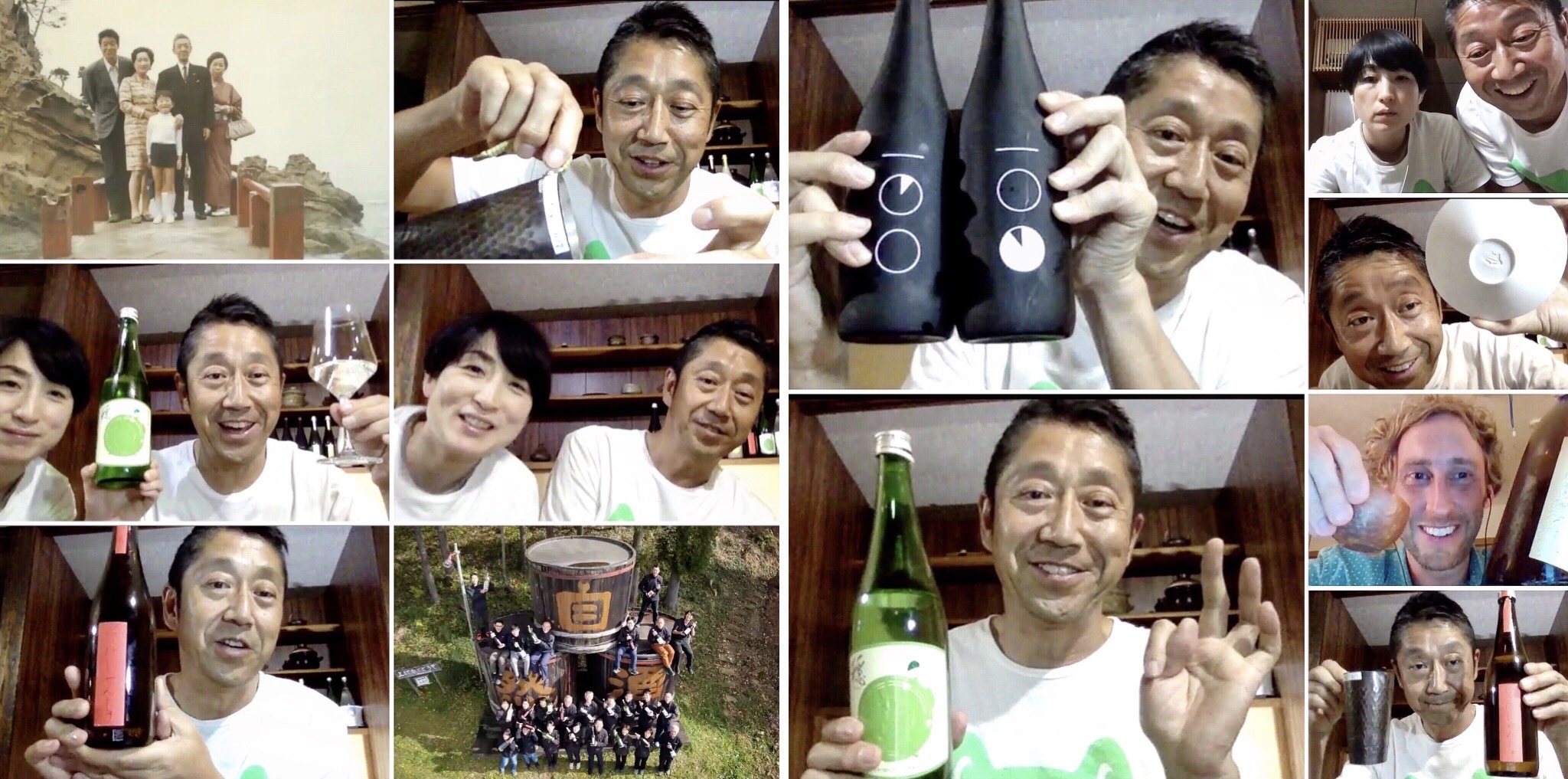
Session 13 of Taste with the Tōji was held on Monday 24th August. This session took us to Niida Honke, located in Fukushima Prefecture. We were joined by current Kuramoto/Tōji, Yasuhiko Niida and his wife Maki Niida. Translating for this session was the fabulous Justin Potts.
Attendees were treated to a wonderful and very thorough presentation from Niida-san on the brewery’s history, philosophies, aspirations and progress.
Established in 1711, Niida-Honke are located in Tamuramachi, a countryside town in central-west Fukushima prefecture. Following on from the seventeen generations of brewers who dedicated their lives to brewing sake, current Tōji, Yasuhiko Niida, now the 18th successor at the brewery, is dedicated to producing the purest sake he can and is forever looking to improve the brewery’s sustainability.
Niida Honke are pioneers in the production and use of naturally grown rice, which they call Shizenmai – a term that translates as ‘natural rice’. They have been brewing with Shizenmai for over 50 years and in 2009 their rice was accredited with an organic farm products certification by Organic JAS. All rice utilised by the brewery is cultivated without the use of pesticides or chemical fertilises, instead they use methods such as hand weeding and employ the use of tadpole shrimp in the rice paddies. Pest control is policed by introducing frogs to the rice fields.
The water used by the brewery is provided by two sources on the company’s 600 plus acres of land. One is hard well water, Takenouchi no Idomizu, (used for the Shizenshu brand), from a well situated near the brewery’s own rice fields, the other is soft spring water, Mizunuki no Wakimizu, (used for the Odayaka brand), sourced from a mountain on the brewery’s land and collected from an underground spring.
Niida Honke is a brewery with so much history, carrying on the family’s rich traditions, adapting and progressing along the way, working towards a future where they are fully self-sustainable.
Beautiful people, with a beautiful philosophy, making beautiful Sake (and some other fabulous products) ~ whilst bringing people together and creating a wonderful community in their part of the world.
A big thank you to Yasuhiko and Maki Niida, and also to Justin Potts for a most inspiring session.
Niida Honke Sake can be purchased in Australia online via
Supersake.
Taste with the Tōji ~ Session 12:
Shin and Eiko Kodama,
Kodama Jozo (Taiheizan)
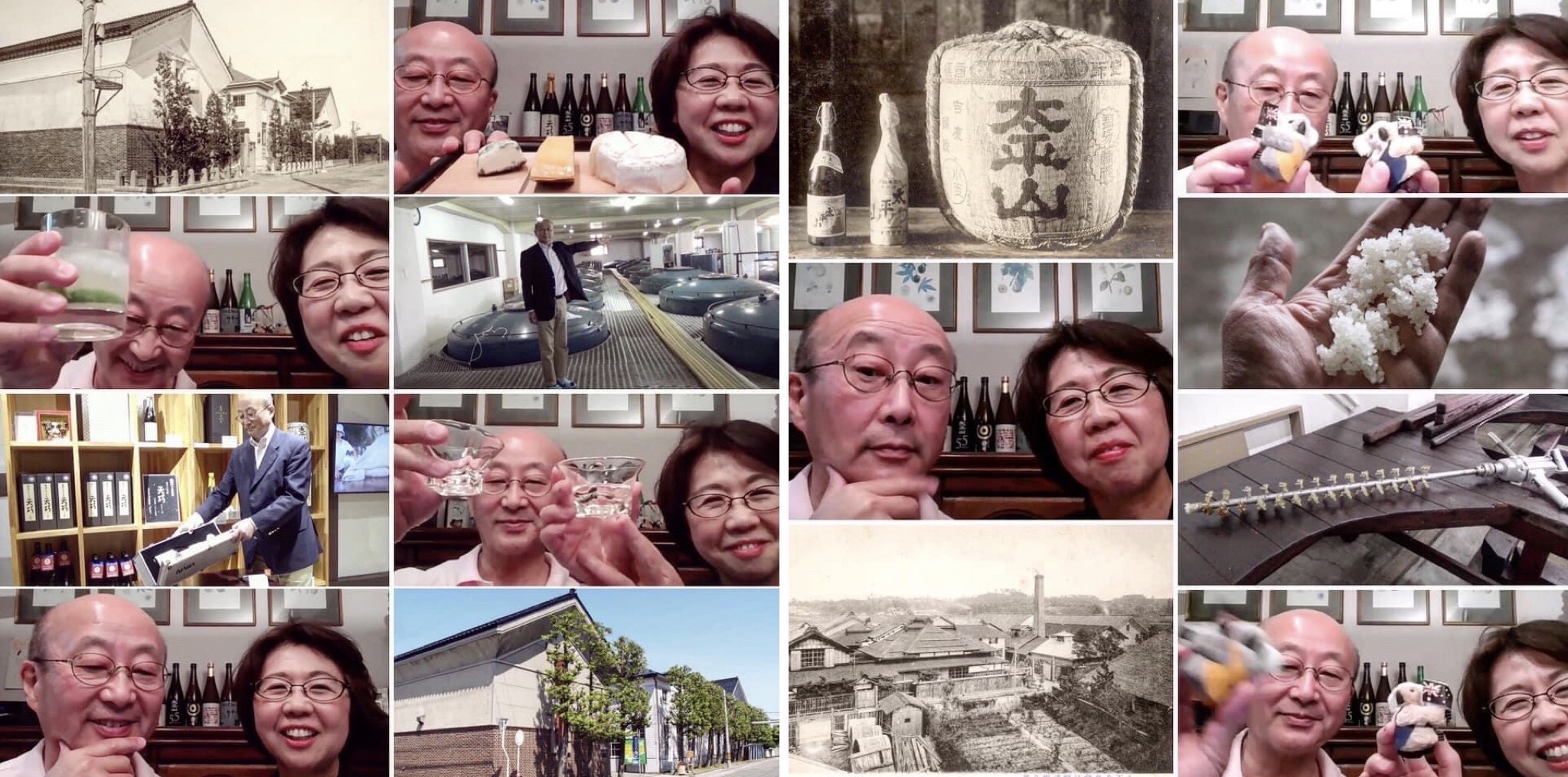
Session 12 of Taste with the Tōji was held on Monday 10th August. This session took us to Kodama Jozo, producers of Taiheizan Sake, located in Akita Prefecture. We were joined by the brewery’s 5th generation owner, Shinichiro Kodama and his wife Eiko Kodama.
A fun and educational session learning about the history and progression of Kodama Jozo ~ from soy sauce and miso to the production of Sake ~ as well as their Akita Kimoto method.
The Kodama Brewery was founded in 1879 in picturesque Katagami City, Akita Prefecture, northwest of Japan. Originally, the Kodama family started their business by making soy sauce and miso for local consumers. In 1913, Tomokichi Kodama, the second generation of the family business began making Sake by the name “TAIHEIZAN” (太平山). This brand name comes from the towering mountain in Akita City, Mt. Taihei (“Great Peaceful Mountain”), which for centuries has been the area’s spiritual symbol.
The Kodama Brewery developed a modern, modified version of the traditional Kimoto starter method, known as the “Akita Kimoto Method” to create a strong moto (starter ferment). For the Akita Kimoto method, a hand-operated electric propelled pole is used to stir and pulverise steamed rice and koji in a vat. This creates a sticky, paste-like anaerobic environment, enabling acceleration of anaerobic bacteria, namely lactic-acid bacteria, to grow naturally without being infected by wild/other bacteria in the air. The resulting moto is clean and resistant to the cold Akita climate for long fermentations.
History, humour, some great food pairing suggestions, a NASA collaboration, Brazilian inspired cocktails, a lantern festival, a very impressive pulverising power-tool-super-mixer ~ and even an Australian element via toy koalas!
Again, thank you to Eiko-san and Shin-san for sharing their time, warmth and knowledge with us all.
Taiheizan Sake can be purchased in Australia via
Supersake.
Taste with the Tōji ~ Session 11:
‘The Origin of Ginjo Sake’
with Miho Imada & Andrew Russell,
Imada Shuzo
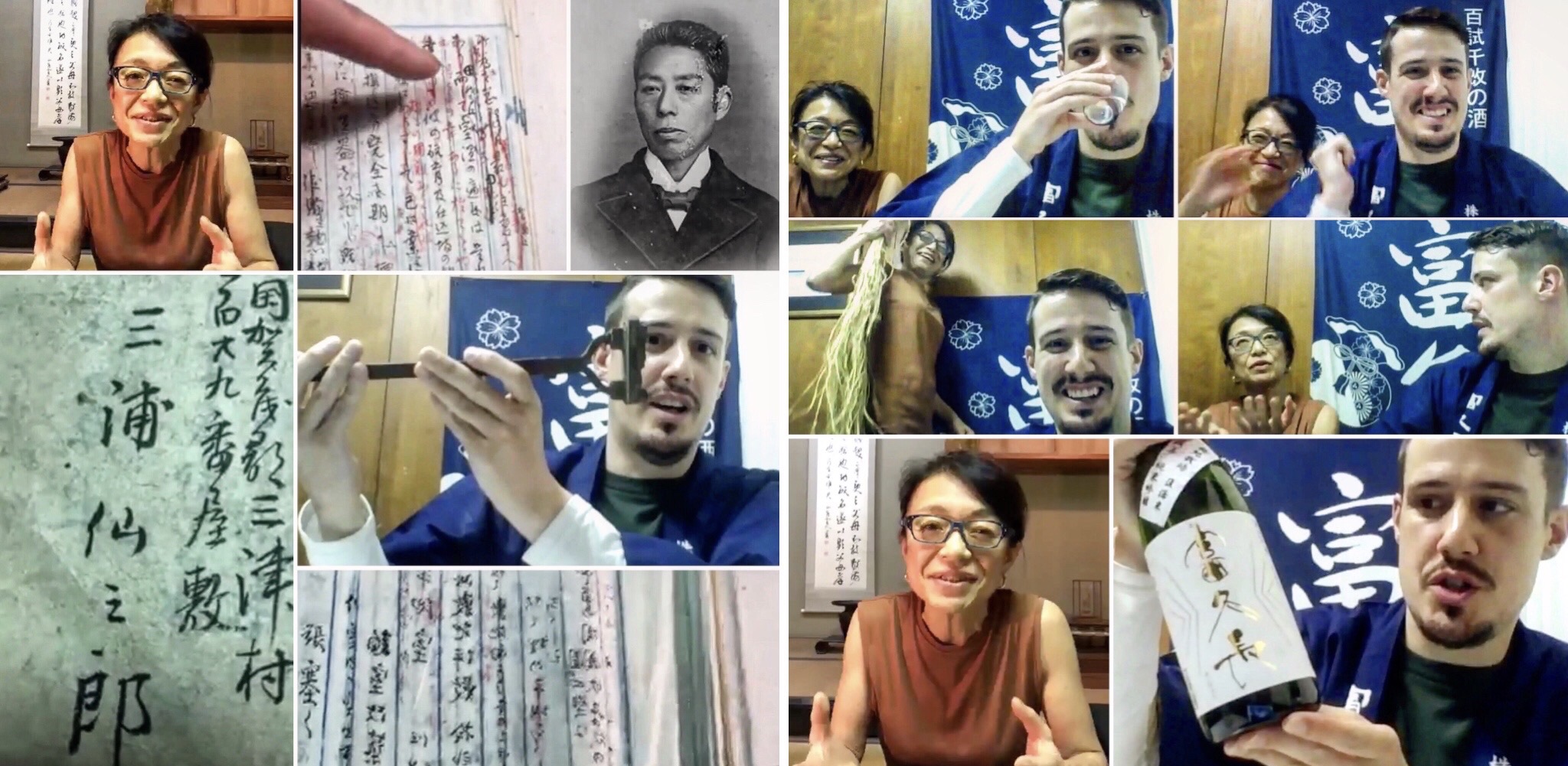
Session 11 of Taste with the Tōji was held on Monday 3 August. This session took us to back to Imada Shuzo, ~ where the Taste with the Tōji began with session 1 back in April ~ producers of Fukucho Sake, located in lovely Akitsu, in Hiroshima Prefecture.
It was an honur to be able to re-visit this amazing brewery and catch up again with the awesome duo – Miho Imada and Andrew Russell. In April, the session focused on the two limited releases from Imada Shuzo ~ Henpei & Genkei. This time, the focus was on ‘The Origin of Ginjo Sake’.
Attendees got to ‘geek out about Ginjo’ thanks to Andy’s wonderful presentation & history lesson, delving into ‘The Origin of Ginjo Sake’, the story of Miura Senzaburo and looking a little at the history of the Akitsu region and of course, Hattanso rice, before tasting some delicious Fukucho Sake. In addition to Andy’s presentation, Imada-san presented us with a truly special virtual and visual treat as we got to view some cherished and incredibly important documents, hand written by Senzaburo himself. A magnificent piece of Sake history preserved by the Imada family.
I’m certain everyone who attended understood just how special this was and were most grateful to Imada-san for sharing this precious part of Sake history with us.
This was such a unique and informative session. In fact, each session is so wonderfully different from every other session, which makes this project even more exciting and enjoyable. I must thank Miho Imada and Andrew Russell and all of the other brewers and kurabito, and translators, who have so generously given their time, knowledge and support for this project.
I must also extend a heartfelt thank you to everyone who attended this session and/or previous sessions, for their continued support for this project. It means a lot, not only to me but to all the brewers and brewery staff involved. It’s a tough time for many and the love for and interest in Sake and support for the industry from all attendees means more to them now than ever before.
Taste with the Tōji ~ Session 10:
Hiroaki Oku & Kotaro Oku,
Akishika Shuzo
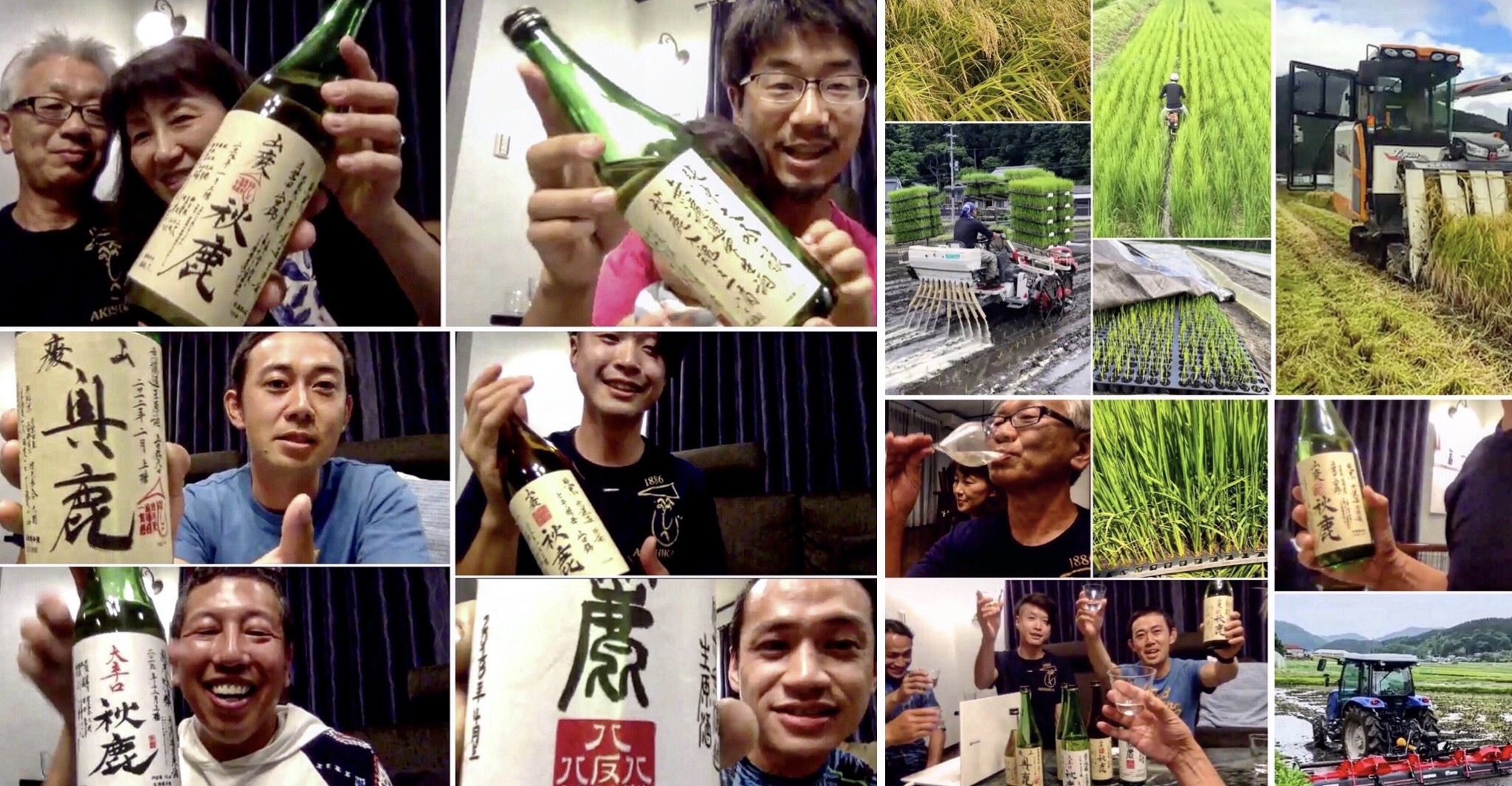
Session 10 of Taste with the Tōji was held on Monday 27th July. This session saw us catch up with the crew from Akishika Shuzo who are located in Osaka Prefecture. The Zoom location this time was a little different to previous events… as we were invited into the home of Hiroaki and Mariko Oku.
It was a privilege for all involved to be welcomed (albeit virtually) into Oku-san’s living room and get an insight into the heart and soul of this brewery via a wonderful presentation from their second son Kotaro-san (who is in charge of rice cultivation at Akishika) and through the wonderful kurabito who all got a chance to introduce themselves, hold up a favourite Sake and tell us why they love working at Akishika…. and we can see why they do…
Not only are they getting the opportunity to produce incredible Sake alongside Owner/Tōji Hiroaki Oku, but Oku-san’s passion and dedication, along with his heartfelt philosophy and dedicated methods of organic rice farming/cultivation are so awe inspiring and worthy of all the praise and all the respect, not only from his team, but also from his consumers.
This session was so incredibly informative as well as being a whole lot of fun ~ a most enjoyable event, particularly for those of us in Melbourne who are currently in lockdown and can’t go out for a drink/sake with friends… but for a couple of hours I felt like I was drinking in a room full of 50 (+) people.
And a huge and heartfelt thank you to the Oku family, Akishika team and to Yoram Ofer, once again, for his support and translation.
Akishika Sake can be ordered online in Australia via Black Market Sake.
You can also watch a beautiful short video, featuring Oku-san, that Black Market Sake recently produced, (in addition to the one on the Akishika page of their website), here. This gorgeous video will give you a small window of insight into Oku-san’s philosophy on all-natural / organic rice cultivation.
Taste with the Tōji ~ Session 9:
Teruaki Hashimoto, Miyoshino Jozo
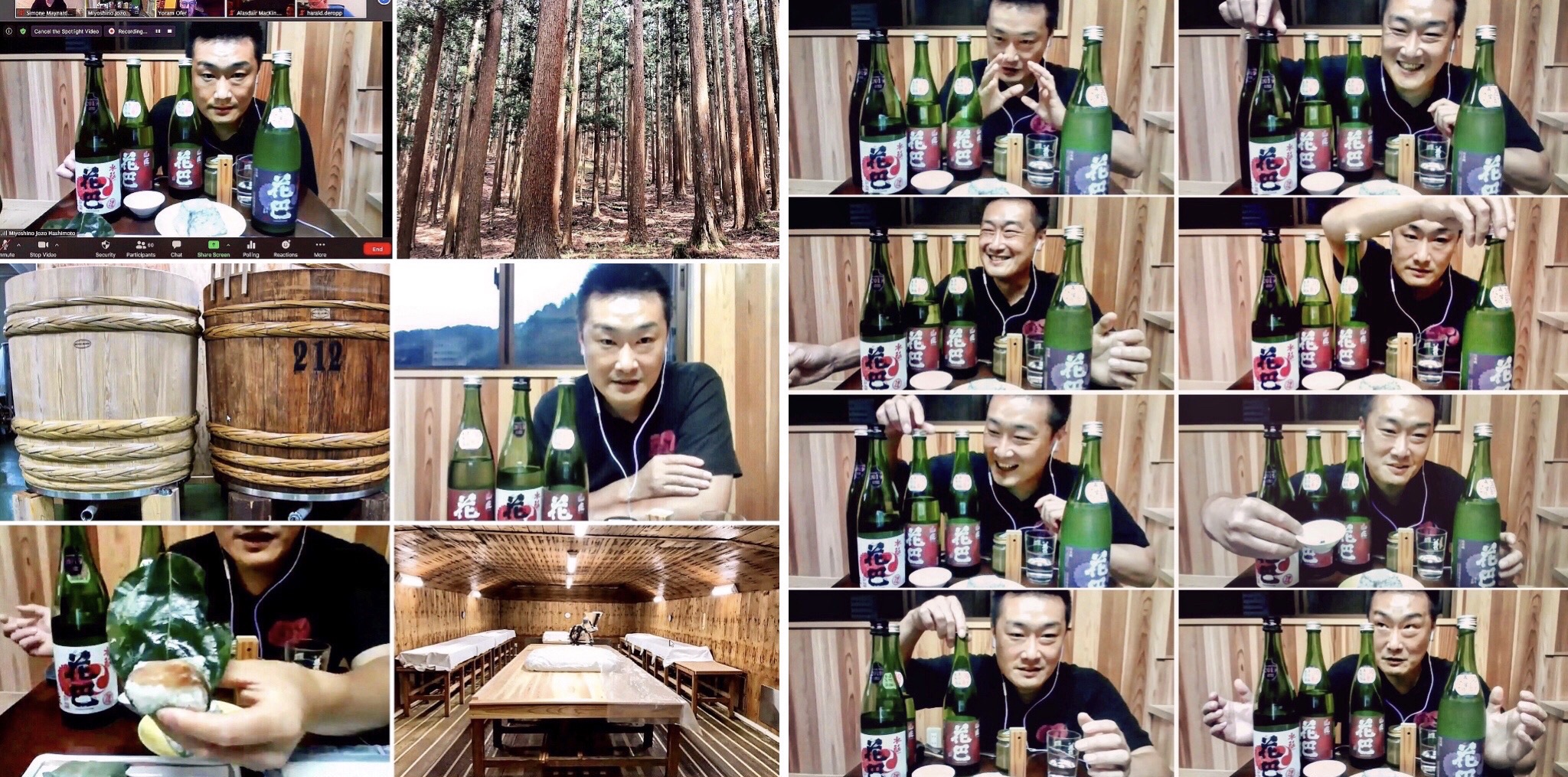
Session 9 of Taste with the Tōji was held on Monday 20th July. This session took us to Miyoshino Jozo, producers of Hanatomoe Sake, located in beautiful Nara Prefecture. We were joined by the brewery’s Owner/Tōji, Teruaki Hashimoto, who Zoomed in from the brewery office and gave us a wonderful presentation and an insight into his brewing philosophy at Miyoshino Jozo. We were again most fortunate to have Yoram Ofer join us as translator for this event.
Hashimoto-san focuses on yeast which he believes is the best representation of the local environment. He uses only naturally occurring yeast in the Yamahai and Bodaimoto versions of Hanatomoe Sake. He explained his reason being that he does not want to dilute the character of these Sake by adding cultivated yeast ~ thus creating Sake that is truly interesting and unique. I must add, also incredibly delicious. I was already a big fan of Hanatomoe Sake but after listening to Hashimoto-san talk about his methods, philosophies and vision, there is now so much more to love and respect about this Sake.
Hashimoto-san was incredibly generous with his time and knowledge and after the ‘little over 2 hour session’ he gave the ‘stayers’ another 90 minutes of his time as he made his way through the array of small dishes he had prepared to show us some food pairing suggestions during the session.
Miyoshino Jozo’s Hanatomoe Sake can be ordered online in Australia via Black Market Sake.
Taste with the Tōji ~ Session 8:
Miho Fujita & Toshi Yokomichi, Miyoshikiku Shuzo
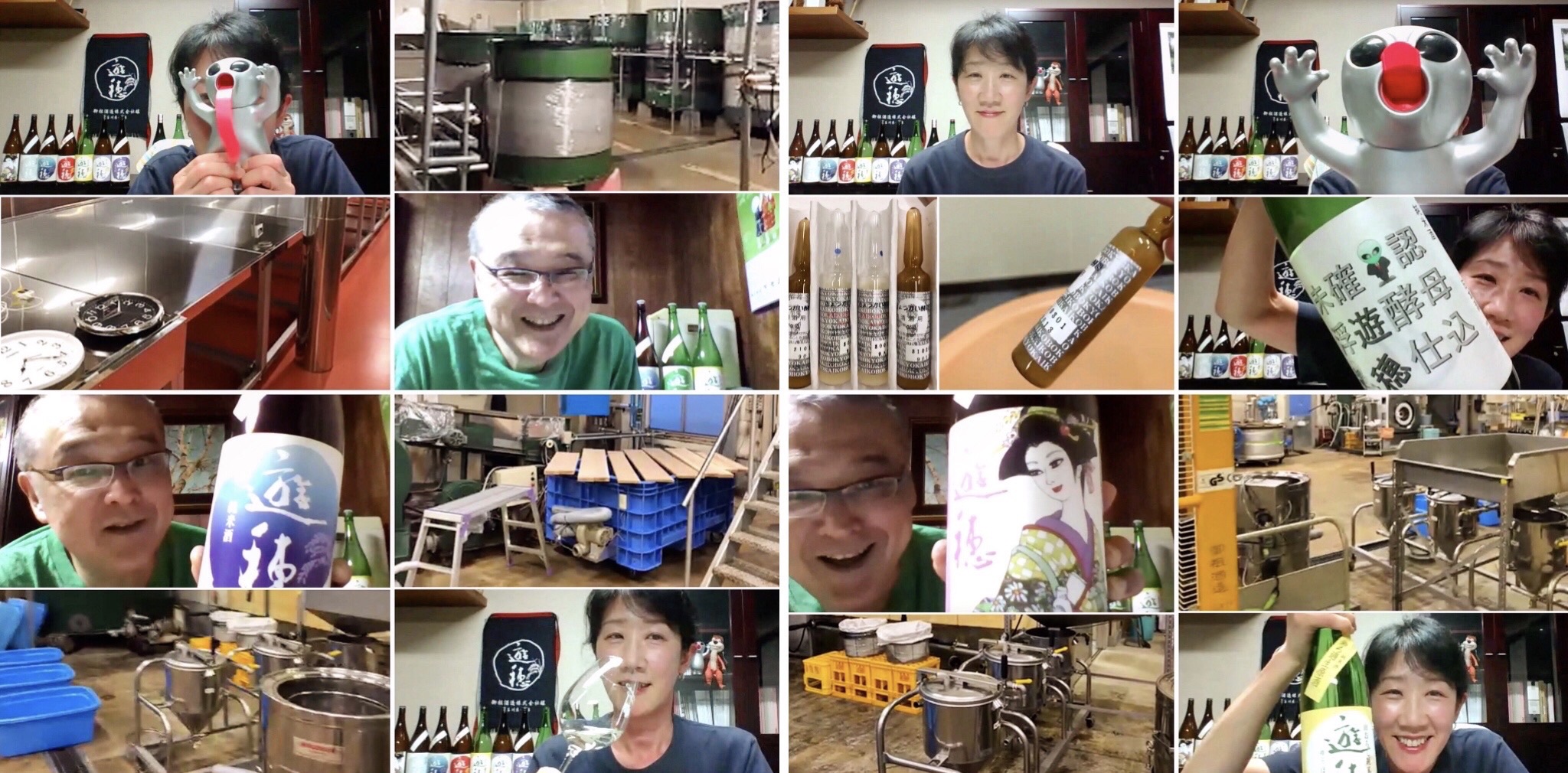
Session 8 of Taste with the Tōji was held on Monday 29th June. This session took us to Mioya Shuzo, producers of YUHO Sake, located in Ishikawa Prefecture. We were joined by the brewery’s President: Miho Fujita, who Zoomed in from the brewery and Tōji: Toshi Yokomichi, who Zoomed in from Osaka.
We started the virtual brewery tour a little earlier than initially planned, this, I was told, was to try and beat the bears that roam the area after dark.
After the brewery tour Fujita-san gave a wonderful presentation filled with history, fun facts, insightful stories, (including her own remarkable story), and some great food pairing suggestions. Fujita-san confessed she knew nothing about Sake when she quit her successful and secure position in marketing at Mattel, (makers of Hot Wheels), to head home and help run the family brewery after her uncle passed away in 2003.
Prior to Fujita-san joining the brewery, Mioya Shuzo were only producing Futsushu (table Sake). Fujita-san not only became Company President, she also became a Sake Brewer with a vision of creating a new line of full-bodied, high quality Sake. Thus the YUHO range of Sake was born. She works alongside their Tōji, Toshi Yokomichi, who joined the kura in 2006. Such an inspiring story and some incredible Sake!
The YUHO range of Sake takes its name from the Japanese phonetics for ‘UFO’. Apparently, the area in which the brewery is located, has had the most number of UFO sightings in Japan!
The translator for this session was the one and only Yoram Ofer, to whom I am incredibly grateful to for his help and support for this session and this project.
Mioya Shuzo’s YUHO Sake can be ordered online in Australia via Black Market Sake.
Taste with the Tōji ~ Session 7:
Kitaba Hiroji & Darryl Cody Brailsford, Watanabe Shuzo
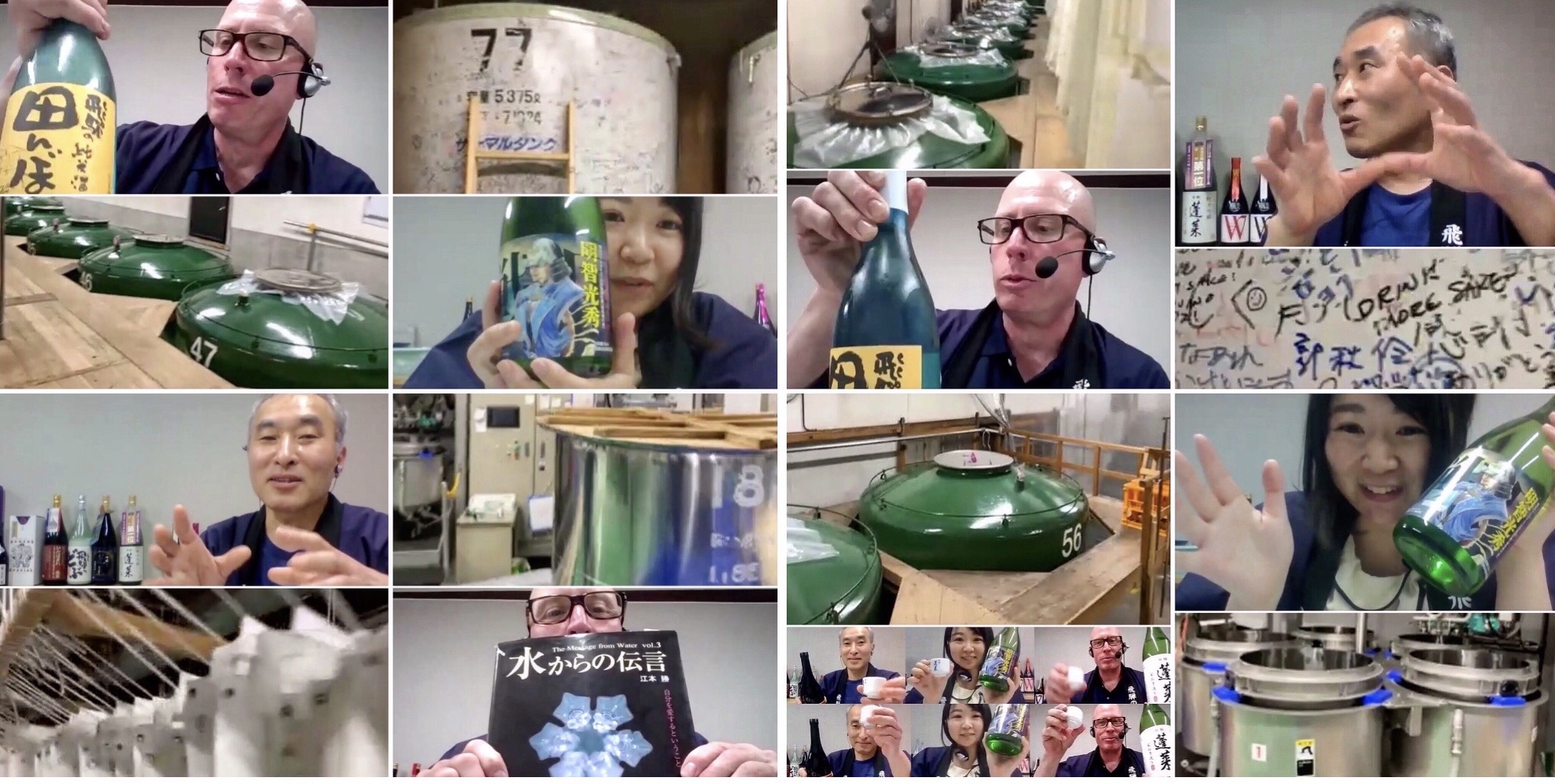
Session 7 of Taste with the Tōji was held on Monday 22nd June. This session took us to Watanabe Shuzo, producers of HOURAI Sake, located in
Gifu Prefecture, Japan. We were joined by the brewery’s Tōji: Kitaba Hiroji, brewer: Darryl Cody Brailsford and sales/marketing and all-rounder: Akane Kimoto. A beautifully humble team.
Attendees enjoyed a brewery tour and a session filled with great discussion, including an insight into their, now somewhat famous in Japan, ‘laughing fermentation’.
Watanabe-san, Kitaba-san and the brewery team actually ‘entertain’ their Sake while it ferments with the joyful laughter of Japanese comedians and their audience. They believe that if they can keep their Moromi (mash) happy while it ferments, then this will ultimately have the same ‘happy’ effect on consumers when they drink Sake from Watanabe Shuzo.
The fermentation area is basically filled with the sound of this recorded laughter playing 365 days a year (and I assume 366 on a leap year). Happy tanks making happy Sake!
Very grateful to Cody-san, Kitaba-san and Kimoto-san for their generous time spent with everyone who attended and for sharing their stories, knowledge, laughter an d passion for Sake!
HOURAI Sake can be purchased in Australia online via
Supersake.
Taste with the Tōji ~ Session 6:
Ryoichiro Mamiya, Miyoshikiku Shuzo
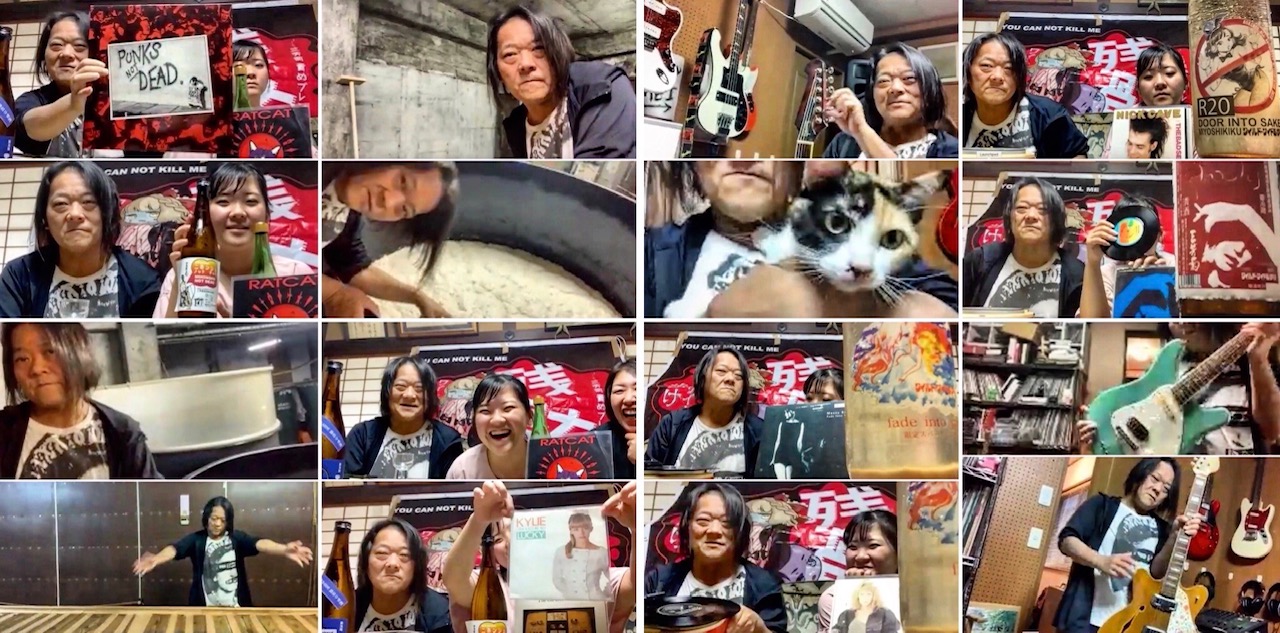
Session 6 of Taste with the Tōji was held on Sunday 14th June. This session took us to Miyoshikiku Shuzo, located in Tokushima, Japan. We were joined by the brewery’s Tōji, the punk rocker of Sake brewing, Ryoichiro Mamiya and his youngest daughter, Koharu. It was a real family affair with Mamiya-san’s wife, Kazuko, joining us briefly and their other two daughters, Ayane and Orie also logged in to say hello ~ we also got to meet the family cat.
Attendees were treated to a most entertaining session full of music (a most eclectic selection at that), lots of laughter, a virtual brewery tour, (they were actually still brewing), and of course, SAKE! We even got a look inside Mamiya-san’s most impressive ‘Music Room’, (in addition to his incredible sound room inside the brewery!).
Miyoshikiku are producing some super fun and funky Sake and Mamiya-san certainly does things his own way and we love him and his Sake all the more for that. Big love and thanks to the Mamiya family and everyone who attended this unique, fun and educational session. A special thank you also to the awesome ‘Sake Advocate’, Julian Houseman, for translating for this session. You can check out Julian’s post on Miyoshikiku from a few years ago here.
This session was living proof that Punks Not Dead and Nihonshu is (most definitely) Not Dead! ~ Kanpai to that!
Miyoshikiku Sake is available in Australia through
Supersake.
Taste with the Tōji ~ Session 5:
Kuniko & Takahito Mukai, Mukai Shuzo
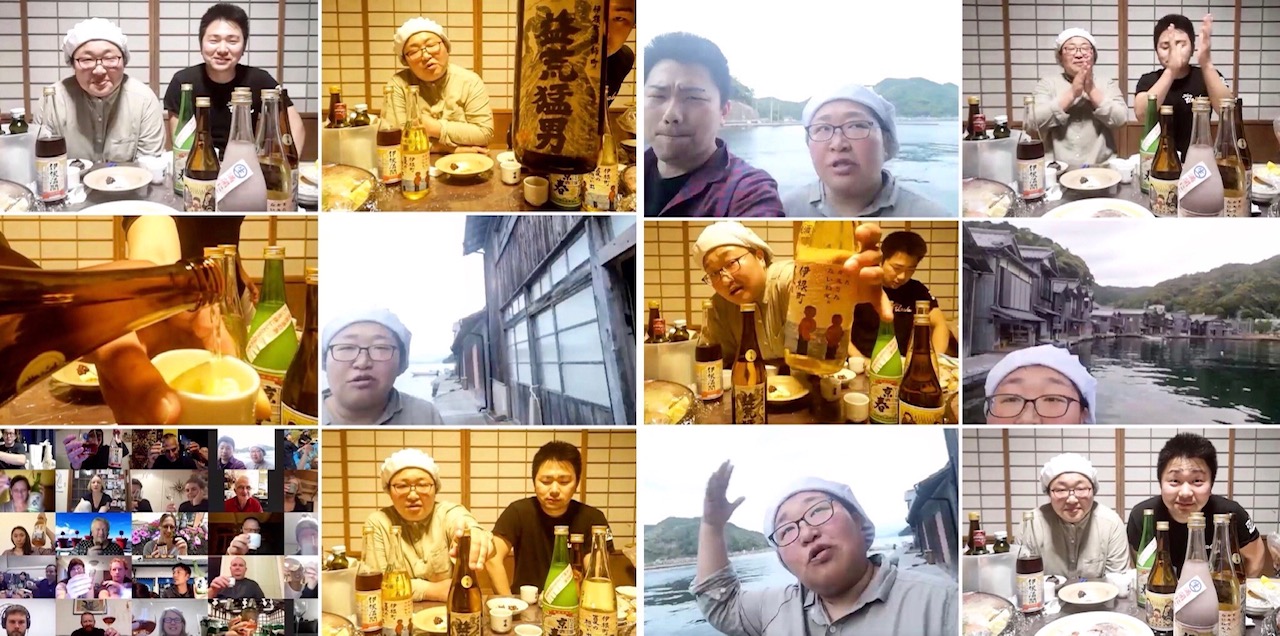
Session 5 of Taste with the Tōji was held on Monday 1st June. This session took us to Mukai Shuzo, located in the picturesque fishing town of Ine, on the Northern tip of Kyoto, Japan. (The area is also home to the beautiful Ine no Funaya Houses). We were joined by the brewery’s Tōji, Kuniko Mukai and her brother Takahito Mukai, who is the brewery’s President. I had the pleasure of meeting Kuniko Mukai last year, during her visit to Australia, at an event hosted by Black Market Sake at Tamura Sake Bar. I had also planned a visit to this brewery in April (this year), however, the visit (and trip to Japan) were put on hold due to COVID-19 and travel restrictions. After hearing Kuniko’s story and seeing the inside (and outside) of this unique brewery, I am sure I am not alone in wanting to visit Kuniko-san and her brother and share a Sake on the raft! I think she may have a convoy on her hands when restrictions are lifted!
Mukai Shuzo are the producers of some of the most unique Sake in Japan, including the Ine Mankai, a Sake made with an ancient strain of red rice, (the grain itself is actually a dark purple – hence its name ‘Murasaki’). The Sake itself is a vibrant reddish colour. Attendees of this Zoom event were treated to a wonderful intro-presentation, informative Q&A session, and a virtual brewery tour from Kuniko-san, whilst we sipped on some delicious Mukai Sake. We heard some wonderful stories from Kuniko-san, her character is as vibrant as the Ine Mankai and her laughter is infectious. The dynamic sister-brother duo also gave us in-depth information about each of their Sake, along with serving temperature suggestions and food pairing recommendations ~ the most unexpected and intriguing being the Masurao Junmai Yamahai Genshu poured over a cup of vanilla ice cream. If anyone else had suggested this pairing, I would have dismissed it – but when the brewer herself recommends it, I’m definitely curious. As I am sure many others now are.
Mukai Shuzo’s Sake can be ordered online in Australia via
Black Market Sake.
I’m off to buy some vanilla ice cream!
Taste with the Tōji ~ Session 4:
Maiko & Soichiro Tsuji, Tsuji Honten (Gozenshu)
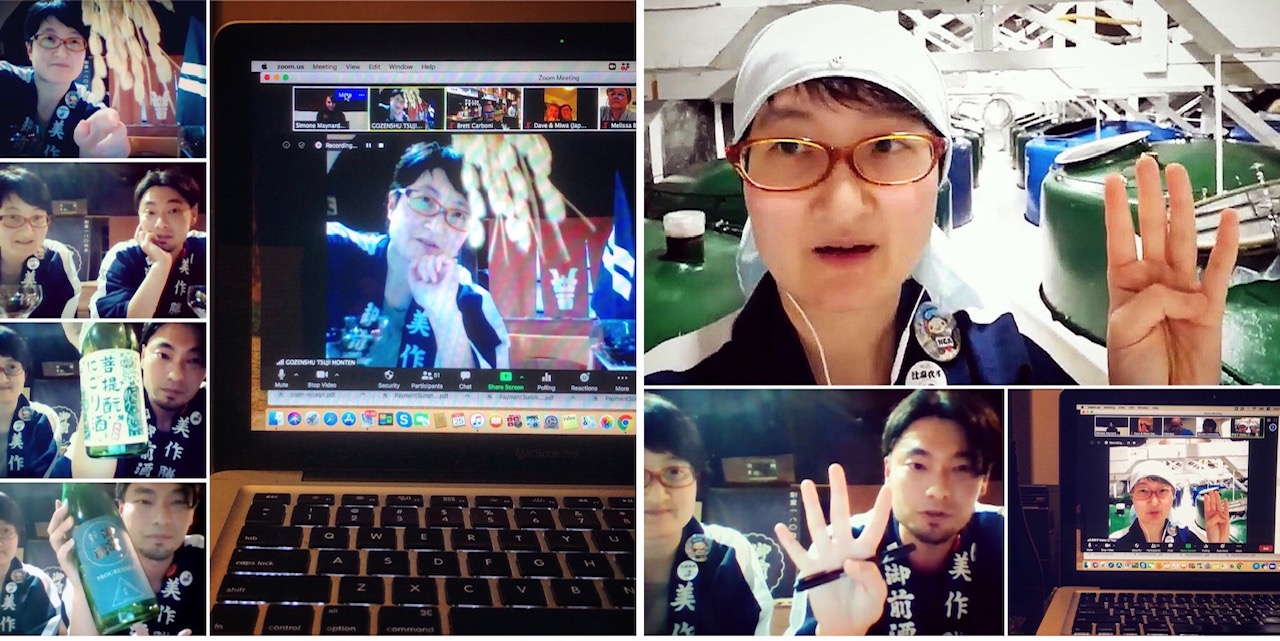
Session 4 of Taste with the Tōji was held on Monday 25th May. This session took us to Tsuji Honten (producers of Gozenshu Sake) in beautiful Okayama, Japan. We were joined by the brewery’s Tōji: Maiko Tsuji and her brother Soichiro Tsuji, who is the brewery’s President. I had the pleasure of meeting Maiko Tsuji last year during her visit to Australia, working along side her at Sake Matsuri in Melbourne. I had also planned a visit to this brewery in April (this year), however, the visit (and trip to Japan) were put on hold due to COVID-19 and travel restrictions. After this event, I have an even stronger desire to visit this fascinating brewery.
Tsuji Honten are pioneers of the ‘Gozenshu’ Bodaimoto starter method. They are also well known for their use of Omachi rice, which was founded in 1859 in Okayama. During this session, we delved into these two topics ~ the ancient starter method and the oldest existing pure strain of Sake rice. Soichiro informed us that the plan for Gozenshu, moving forward, is to only brew with Omachi rice. A bold move, but it makes sense – and there were no complaints from the many Omachi fans in attendance, myself included!
Attendees of this Zoom event were treated to a wonderful intro-presentation, informative Q&A session, and a virtual brewery tour from Maiko-san, whilst we sipped on some delicious Gozenshu Sake. I, along with a number of Australian attendees, enjoyed the 1859 Prototype Nama (a relatively new product) and the Akihikari Nama (one they will not be releasing again). Both were delicious and I look forward to more new releases under the Gozenshu label.
You can read more about Tsuji Honten/Gozenshu on their website
here.
Taste with the Tōji ~ Session 3:
Hayato Shoji, Kidoizumi Shuzo
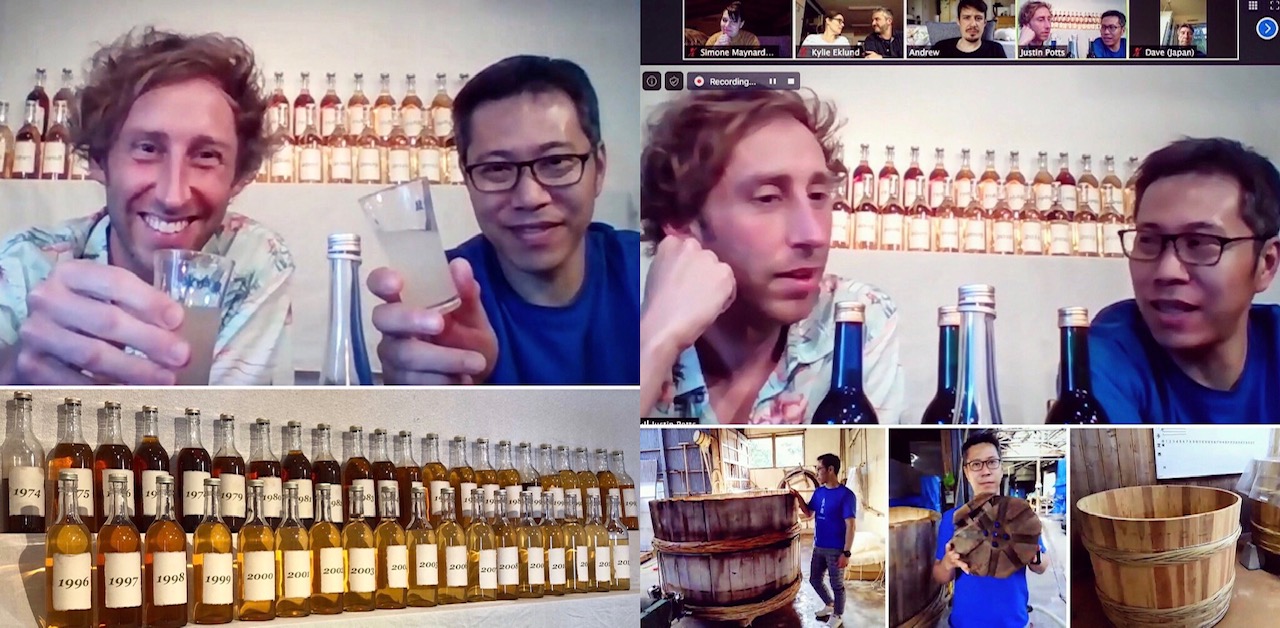
Session 3 of Taste with the Tōji was held on Sunday 17th May. This session took us to Kidoizumi Shuzo in Chiba, Japan, where we were joined by the brewery’s Tōji/Owner: Hayato Shoji and the exceptional Mr. Justin Potts. I had the pleasure of visiting this picturesque brewery in person in early 2019. You can read a little more about that visit and the brewery here. Kidoizumi Shuzo have been brewing Sake since 1879 and were one of the first breweries in Japan to offer Koshu (aged Sake) commercially in the 1960’s. They have a collection of aged products at Kidoizumi ~ with the oldest being from 1967. Kidoizumi are renowned for their Hot-Yamahai method which is used for every Sake they make. This method involves creating the Yamahai starter in very warm conditions. They have been using and mastering this method since 1956 and are the only brewery in Japan doing so.
Attendees of this Zoom event were treated to a wonderful intro-presentation as well as a virtual brewery tour from Justin and Shoji-san, whilst we sipped on some delicious Kidoizumi Sake. A wonderful way for those in Australia and Japan to spend part of their Sunday afternoon. It was also wonderful to see viewers joining in from other parts of the world including Switzerland, Hong Kong and the USA.
You can read a little more about Kidoizumi Shuzo
here, as well as get a little further insight into the Hayato Shoji’s story in this little Q&A piece by my Sake pal Signor Sake
here.
For those in Australia, you can purchase Kidoizumi Sake
here through
Black Market Sake.
Taste with the Tōji ~ Session 2:
Rumiko Moriki, Moriki Shuzo
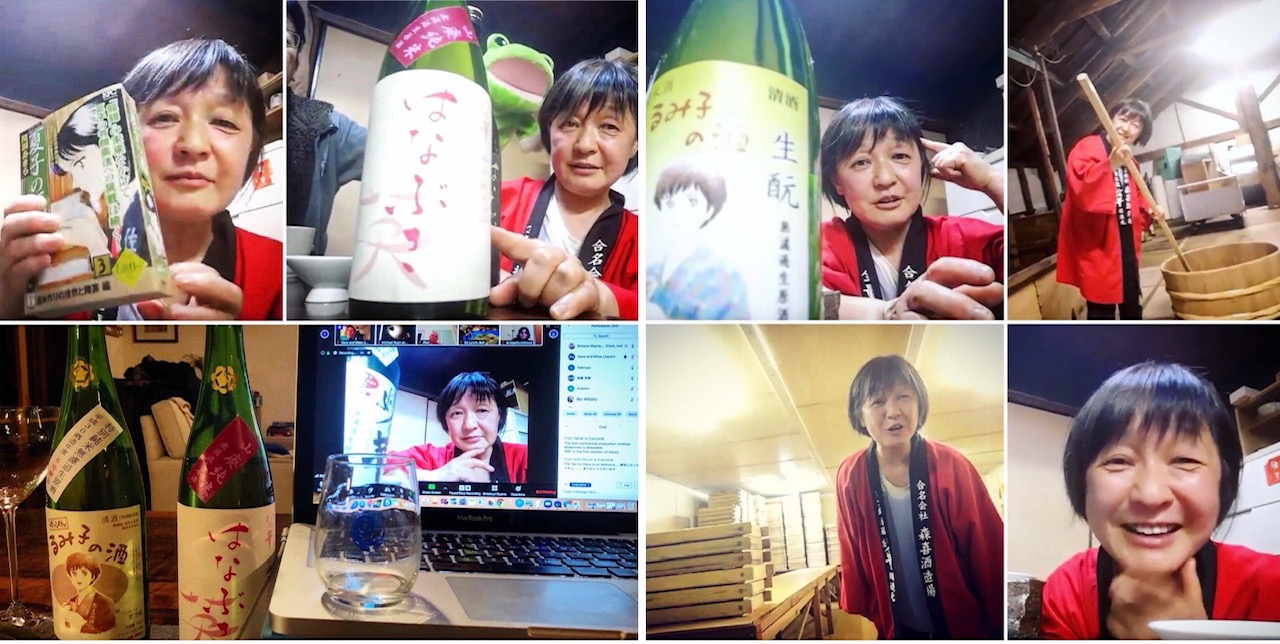
The second session in this series was held on Monday 11th May and featured Moriki Shuzo from Mie prefecture. We were fortunate to have Rumiko Moriki and her husband Hideki Moriki join us and give us an insight into their lives, their brewery and the Sake they produce. Rumiko shared some really beautiful and inspirational stories, including a heartwarming story about how the manga, Natsuko no Sake, offered her inspiration and encouragement as she took the reins when her when her father became ill and the brewery fell on very hard times. You can read a little more about this beautiful story here ~ a lovely post by Christian at Signor Sake.
Rumiko’s dedication and hard work are truly admirable and her passion is infectious. Her wonderful story touched so many of us. We were also fortunate enough to be treated to a virtual tour of the brewery and get a little further insight as to how much work goes into making their fine hand-crafted Sake.
For those in Australia, you can purchase
Moriki Sake through
Black Market Sake.
Taste with the Tōji ~ Session 1:
Miho Imada, Imada Shuzo
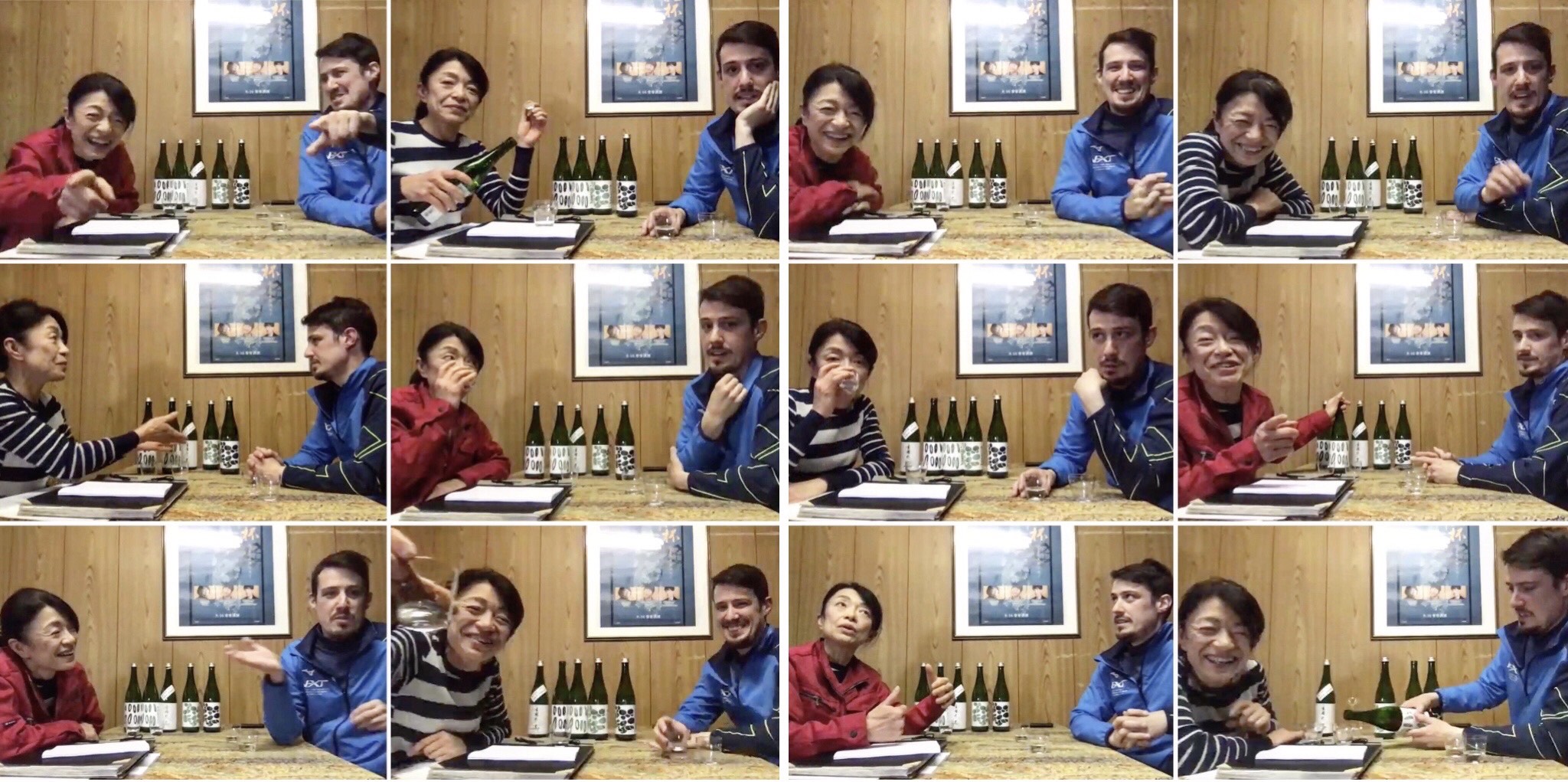
The first session in this series was held on Monday 27th April and featured Imada Shuzo from Hiroshima. We were fortunate to have Imada Shuzo’s Tōji and President, Miho Imada, and Kurabito, Andrew Russell, join us for an insightful virtual event and tasting – which featured Imada-san’s Henpei and Genkei sake. A big thanks to Miho and Andrew, who were incredibly generous with their time and knowledge – and also a big thank you to all those who purchased the Sake and attended this event. We had around 33 participants and most were able to get their hands on some Imada Sake for the event, which came together very quickly and the response was overwhelming, proving that the Sake momentum is still well and truly alive during this uncertain time!
For those curious about the Sake we tasted on the evening, you can read more about them here. Also, anyone in Australia wishing to purchase the Henpei and/or Genkei can enquire through Supersake in Perth, who are Australia’s only importer of Imada Fukucho Sake.
Thank you to
Blossom Kitty for her blog post about the event which you can read
here.
You can read more about Miho Imada via many sources, here is just one article ~ and be sure to check out Andrew Russell’s Sake blog Origin Sake.
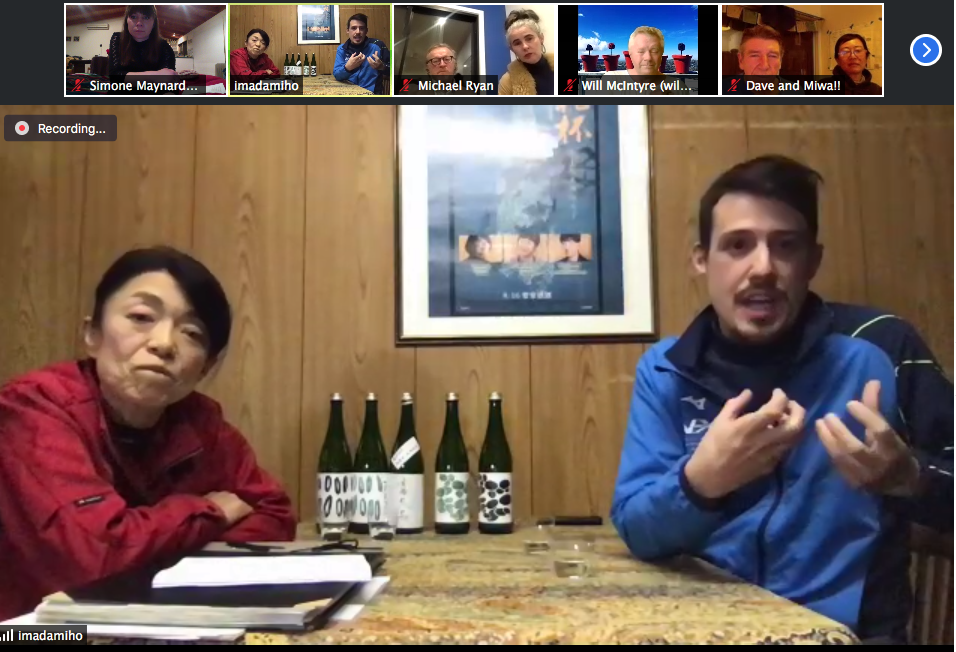
Turning Virtual in the Age of COVID-19
April 2020:
The current world events of late have been devastating to so many, both on a personal and professional level.
With the current social distancing measures in place, the options for those in the hospitality industry are certainly few and limiting. Obviously, at this point in time, it is not possible to hold public tastings, masterclasses and pairing dinners at any of Melbourne’s delightful venues ~ however, the industry has in some way become more inter-connected and with the use of current technology, despite certain limitations, we are still able to collaborate, connect and share our passion for Sake with others.
I’m thrilled to be able to host an upcoming series of online events titled ‘Taste with the Tōji’ via Zoom ~ giving Sake enthusiasts an opportunity to connect with like minded people and raise a glass alongside, (virtually), the brewers behind the brew.
Each session will feature a different Sake brewery and Tōji (and/or
Kurabito) and give participants the chance to partake in a group tasting and have their questions answered by the brewers themselves.
My hope in doing these online events is to unite Sake drinkers and enthusiasts of all levels, whilst at the same time, connecting the brewers with their wider audience/consumers. One positive to this virtual platform is the ability to be able to connect with a broader audience, not limited by distance/location ~ perhaps a little by time zones, but where there’s a will there’s a way perhaps.
The first in this series will feature the fabulous
Miho Imada the Tōji from Imada Shuzo in Hiroshima and Kurabito,
Andrew Russell. The Sake tasting component for this event will feature the recent Henpei and Genkei ~ more can be read about these Sake
here. ~ KANPAI!






























 Monday 28th November, 2022, saw TWTT celebrate its 100th session – and to help us do that, we were lucky enough to be joined by the fabulous Tsuji siblings and feature a brewery that holds a special place in many hearts, (including mine): Tsuji Honten, producers of the much loved Gozenshu sake.
We got to welcome back 7th generation President: Soichiro Tsuji and talented Toji: Maiko Tsuji as our special guests for the 3rd time on TWTT.
In recent times, Gozenshu have produced a couple of limited release ‘trilogy’ sets, with more planned ~ so this seemed very fitting to complete a ‘TWTT trilogy’ with Gozenshu for the project’s 100th session.
Tsuji Honten first joined us as the feature brewery back in May 2020 for session #4. They joined us again in May 2021 for session #42, and this year, it was an honour to have them back to celebrate a century of TWTT sessions.
When we last caught up with Soichiro-san and Maiko-san they were not only in the process of rebranding, but also transitioning to an all Omachi brewery… in other words, they had planned to move to using ONLY Omachi rice to brew their sake. Some thought this was a brave move that may present limitations, however, the folks at Gozenshu, determined to not let this move be seen as a limitation, continue to be impressively innovative and are forever coming up with different ways to showcase their exclusive use of Omachi. One of these ways, of course, is through their progressive series of ‘trilogy’ releases.
They are now exactly that – a brewery that uses ONLY Omachi rice, 95% of which is harvested in Okayama. They are currently using rice farmed from 7 different locations.
Further to the shift to only brewing with Omachi rice, Gozenshu are planning to move towards becoming a brewery that uses the Bodaimoto starter method for all their sake in the future. In the process, they are currently working on a new trilogy which will be centred around the Bodaimoto method ~ seeing a slightly different Bodaimoto method used for each of the 3 brews. One method is perhaps one that has not been attempted before – and that is to not only use soyashi mizu in the starter but also in the main fermentation.
In addition to an informative presentation and discussion revolving mostly around Omachi, Bodaimoto and soyashi mizu, we were lucky enough to get a peek inside the brewery, more specifically – inside the soyashi mizu tank.
I love that Gozenshu honour both tradition and time ~ whilst they are passionate about tradition, they are also progressive in their thinking and their sake brewing. I also love that each time we do a session with Gozenshu, not only do we learn so much, but we are left wanting to learn more and delve even deeper into the world/s of Omachi, Boadimoto and soyashi mizu… which continues to keep the TWTT door wide open for another Gozenshu session.
A huge thank you to both Soichiro Tsuji and Maiko Tsuji for once again sharing their time, knowledge, passion, projection and philosophy with us all. It’s always a joy to speak with these remarkable sake siblings and we look forward to having more opportunities to do so in the future.
An extension of that huge thank you must go out to my co-host and interpreter for this session: Maki Tanaka. It’s always a pleasure to work alongside Maki and the other co-hosts/interpreters for these TWTT sessions ~ not only does it put the brewery guests at ease, it also helps to make this project accessible to a wider audience. I am forever grateful to everyone who has helped, and continues to help, in making TWTT sessions possible.
Thank you also to everyone who attended this session – and, of course, to anyone and everyone who has attended, or been a guest for, one or more TWTT sessions since its iteration. Without all of whom, we would not have made it to 100!
Deepest Kansha and 100 Kanpais to all involved!
Monday 28th November, 2022, saw TWTT celebrate its 100th session – and to help us do that, we were lucky enough to be joined by the fabulous Tsuji siblings and feature a brewery that holds a special place in many hearts, (including mine): Tsuji Honten, producers of the much loved Gozenshu sake.
We got to welcome back 7th generation President: Soichiro Tsuji and talented Toji: Maiko Tsuji as our special guests for the 3rd time on TWTT.
In recent times, Gozenshu have produced a couple of limited release ‘trilogy’ sets, with more planned ~ so this seemed very fitting to complete a ‘TWTT trilogy’ with Gozenshu for the project’s 100th session.
Tsuji Honten first joined us as the feature brewery back in May 2020 for session #4. They joined us again in May 2021 for session #42, and this year, it was an honour to have them back to celebrate a century of TWTT sessions.
When we last caught up with Soichiro-san and Maiko-san they were not only in the process of rebranding, but also transitioning to an all Omachi brewery… in other words, they had planned to move to using ONLY Omachi rice to brew their sake. Some thought this was a brave move that may present limitations, however, the folks at Gozenshu, determined to not let this move be seen as a limitation, continue to be impressively innovative and are forever coming up with different ways to showcase their exclusive use of Omachi. One of these ways, of course, is through their progressive series of ‘trilogy’ releases.
They are now exactly that – a brewery that uses ONLY Omachi rice, 95% of which is harvested in Okayama. They are currently using rice farmed from 7 different locations.
Further to the shift to only brewing with Omachi rice, Gozenshu are planning to move towards becoming a brewery that uses the Bodaimoto starter method for all their sake in the future. In the process, they are currently working on a new trilogy which will be centred around the Bodaimoto method ~ seeing a slightly different Bodaimoto method used for each of the 3 brews. One method is perhaps one that has not been attempted before – and that is to not only use soyashi mizu in the starter but also in the main fermentation.
In addition to an informative presentation and discussion revolving mostly around Omachi, Bodaimoto and soyashi mizu, we were lucky enough to get a peek inside the brewery, more specifically – inside the soyashi mizu tank.
I love that Gozenshu honour both tradition and time ~ whilst they are passionate about tradition, they are also progressive in their thinking and their sake brewing. I also love that each time we do a session with Gozenshu, not only do we learn so much, but we are left wanting to learn more and delve even deeper into the world/s of Omachi, Boadimoto and soyashi mizu… which continues to keep the TWTT door wide open for another Gozenshu session.
A huge thank you to both Soichiro Tsuji and Maiko Tsuji for once again sharing their time, knowledge, passion, projection and philosophy with us all. It’s always a joy to speak with these remarkable sake siblings and we look forward to having more opportunities to do so in the future.
An extension of that huge thank you must go out to my co-host and interpreter for this session: Maki Tanaka. It’s always a pleasure to work alongside Maki and the other co-hosts/interpreters for these TWTT sessions ~ not only does it put the brewery guests at ease, it also helps to make this project accessible to a wider audience. I am forever grateful to everyone who has helped, and continues to help, in making TWTT sessions possible.
Thank you also to everyone who attended this session – and, of course, to anyone and everyone who has attended, or been a guest for, one or more TWTT sessions since its iteration. Without all of whom, we would not have made it to 100!
Deepest Kansha and 100 Kanpais to all involved!






































 Monday 18th October, 2021, saw another enjoyable and informative session of TWTT as we headed to Fukui Prefecture for the first time in this series and spent some quality time with Kinnya Mikawa from Mikawa Shuzo.
Monday 18th October, 2021, saw another enjoyable and informative session of TWTT as we headed to Fukui Prefecture for the first time in this series and spent some quality time with Kinnya Mikawa from Mikawa Shuzo.





 Monday 30 August, 2021, saw session number 56 in the TWTT series take place as we Zoomed in to spotlight Abu no Tsuru in Yamaguchi Prefecture.
Monday 30 August, 2021, saw session number 56 in the TWTT series take place as we Zoomed in to spotlight Abu no Tsuru in Yamaguchi Prefecture.






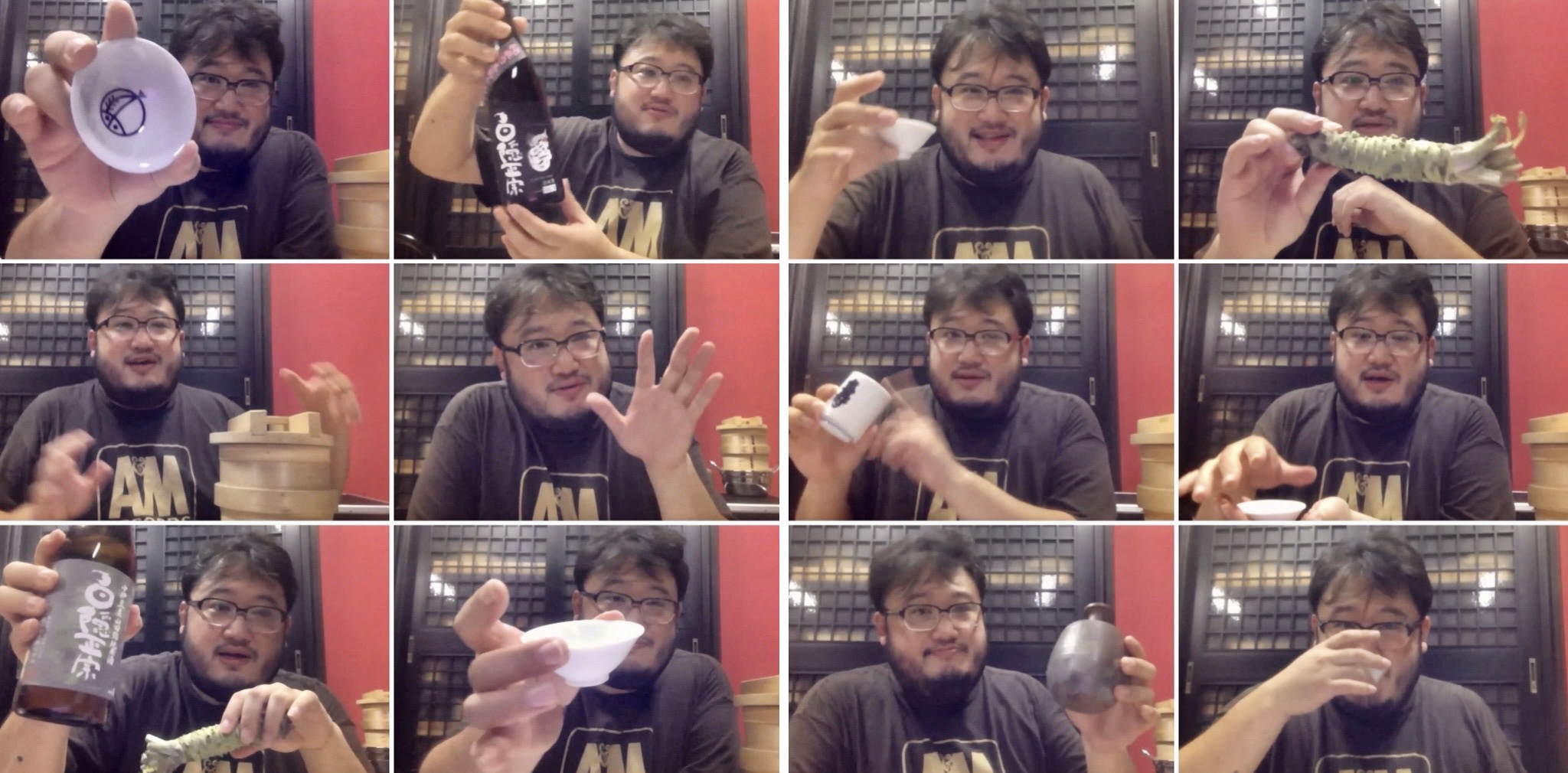








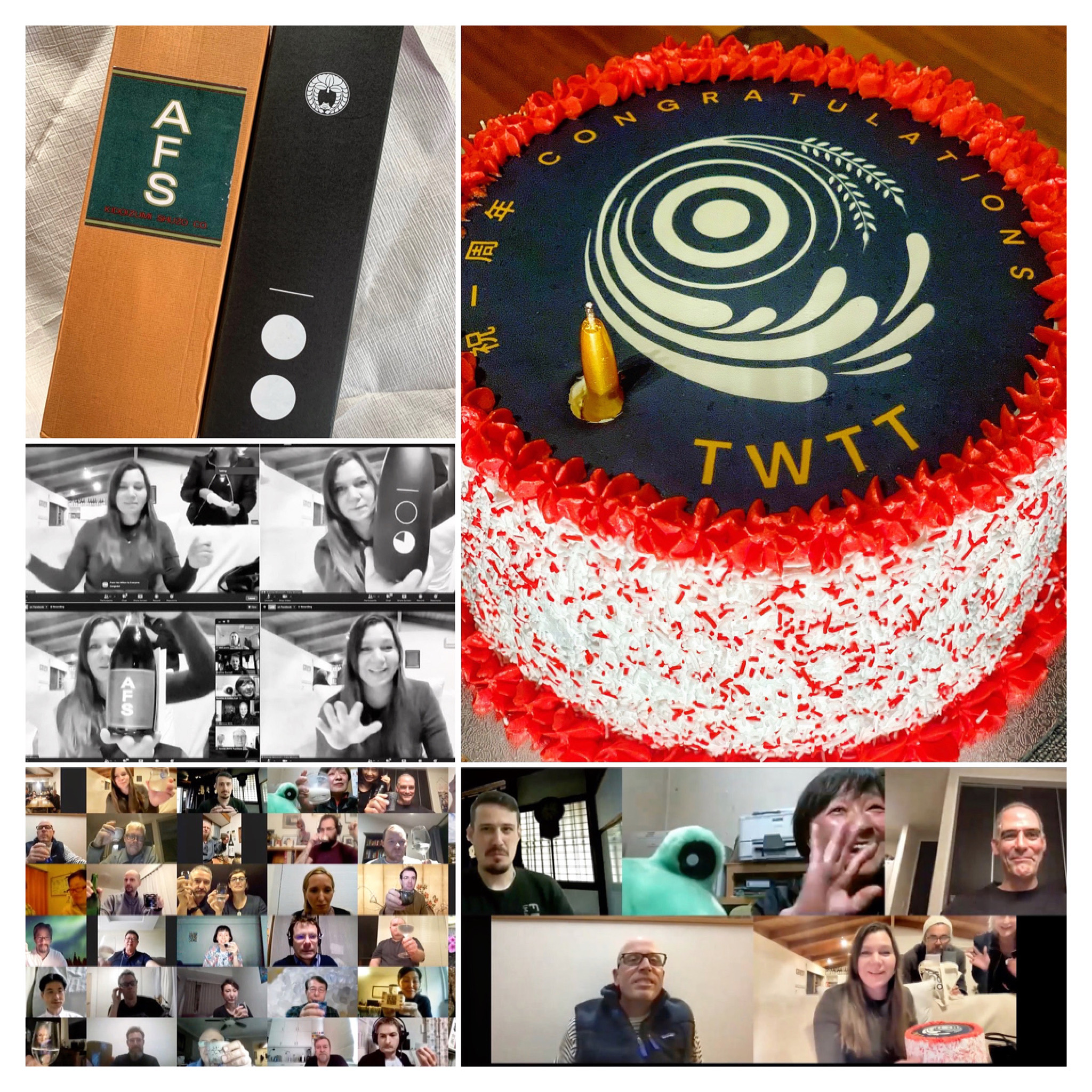


















 Session 21of TWTT took place on Monday 2 November and took us to Koikawa Shuzo in Yamagata Prefecture. It was an honour to spend a couple of hours talking with brewery president, Kazuyoshi Sato.
A great discussion and lots of Q&A dedicated to the fascinating world of Kameno o rice.
This brewery has a wonderful connection to this rice variety which was the inspiration for the ‘phantom’ rice in Akira Oze’s ‘Natsuko no Sake’. Kameno o, it seems, is a little ‘phantom-like’ itself.
Session 21of TWTT took place on Monday 2 November and took us to Koikawa Shuzo in Yamagata Prefecture. It was an honour to spend a couple of hours talking with brewery president, Kazuyoshi Sato.
A great discussion and lots of Q&A dedicated to the fascinating world of Kameno o rice.
This brewery has a wonderful connection to this rice variety which was the inspiration for the ‘phantom’ rice in Akira Oze’s ‘Natsuko no Sake’. Kameno o, it seems, is a little ‘phantom-like’ itself.
 Session 20 of TWTT took place on Monday 19 October ~ for this session, we headed to Nara and we were joined by the incredible Yoshi ‘Chobei’ Yamamoto from Yucho Shuzo.
What an incredibly deep delve into some fascinating history and rich cultural elements relating to ‘Nara Sake’ and Bodaimoto ~ and the evolution of the brewing process, fermentation and rice polishing process. As well as a great discussion about table rice and sake rice.
From the birth of Bodaimoto over 500 years ago to the birth of Kaze no Mori Sake in 1998, Chobei-san certainly covered some ground over a wonderfully insightful 3 and a bit hours!
‘Nara Sake’, produced since the Muromachi period (1336-1573), reached its height during the Sengoku period (1467-1615). This happened with the birth/creation of the technique called Bodaimoto at Bodaisan Shoryakuji Temple. Hence, Nara then became the birthplace of ‘refined’ Sake in Japan.
Session 20 of TWTT took place on Monday 19 October ~ for this session, we headed to Nara and we were joined by the incredible Yoshi ‘Chobei’ Yamamoto from Yucho Shuzo.
What an incredibly deep delve into some fascinating history and rich cultural elements relating to ‘Nara Sake’ and Bodaimoto ~ and the evolution of the brewing process, fermentation and rice polishing process. As well as a great discussion about table rice and sake rice.
From the birth of Bodaimoto over 500 years ago to the birth of Kaze no Mori Sake in 1998, Chobei-san certainly covered some ground over a wonderfully insightful 3 and a bit hours!
‘Nara Sake’, produced since the Muromachi period (1336-1573), reached its height during the Sengoku period (1467-1615). This happened with the birth/creation of the technique called Bodaimoto at Bodaisan Shoryakuji Temple. Hence, Nara then became the birthplace of ‘refined’ Sake in Japan.

 What a joy and an absolute honour! Session 18 of TWTT took place on Monday 5 October and was a most unique one. We were joined by two living legends, from two different fields, brought together by a Manga comic and their shared passion, inspiring a 30 year friendship that has continued to this day.
The dynamic friendship and mutual respect between Rumiko Moriki and Mr. Akira Oze filled the Zoom room with a beautiful energy and it was a pleasure to listen to their individual stories and the story of their friendship ~ which began when Rumiko’s family brewery fell upon hard times some 30 years ago. It was during this time she obtained a copy of the Manga, Natsuko no Sake: The story of Natsuko Saeki, the daughter of a sake brewing family who is working for an advertising company in Tokyo. She returns to her family’s home in the countryside and finds her brother, Yasuo, searching for a “phantom” rice seed called Tatsu Nishiki, rumored to create a new form of sake. Shortly after he finds the seeds, he passes away suddenly. Natsuko quits her job and begins working at the sake brewery to honour and achieve Yasuo’s dream of making the best sake in Japan with Tatsu Nishiki rice.
It was late one evening that Rumiko began reading Natsuko’s story. She was so enthralled in the story that she read the complete volume that night. She had been so touched and inspired by the story that as soon as she finished reading the book, she penned a letter to Mr. Akira Oze that same evening. Her letter was one of gratitude but also to tell Mr. Akira Oze of her own story, which included many parallels to Natsuko’s story, including sharing the same birthday! When Rumiko read that Natsuko’s birthday was the same as her own, she thought it must be some kind of fate; that she came upon this story, which resonated so deeply and gave her a strong sense of encouragement and inspiration. She posted her letter to Mr. Oze the following morning.
Rumiko had not expected a reply from Mr. Oze, so when one came, she felt extremely humbled and delighted. After reading Rumiko’s letter, Mr. Oze himself was touched by her story – he exclaimed “Natsuko is a real living character!” He too was astonished and intrigued by the parallels of these two stories and wanted to meet Rumiko and help her in her own quest to make delicious sake, get her family’s brewery back on its feet and learn as much as she could from other brewers. Mr. Oze’s introductions to Rumiko proved invaluable and through these introductions, mentors came into Rumiko’s life who helped her not only achieve her goals but surpass them.
Such a beautiful story, a delightful friendship, and an honour to spend over three hours with Rumiko and Mr. Oze last night. ( An unexpected treat that they both stayed on for some time after the 2 hour session finished ).
Thank you so much to the ever amazing Rumiko Moriki and Akira Oze for such a wonderful opportunity and a most enjoyable event.
Thank you also to my good friend Harald deRopp for a wonderful job with translation, and of course an extended thank you to all who attended.
What a joy and an absolute honour! Session 18 of TWTT took place on Monday 5 October and was a most unique one. We were joined by two living legends, from two different fields, brought together by a Manga comic and their shared passion, inspiring a 30 year friendship that has continued to this day.
The dynamic friendship and mutual respect between Rumiko Moriki and Mr. Akira Oze filled the Zoom room with a beautiful energy and it was a pleasure to listen to their individual stories and the story of their friendship ~ which began when Rumiko’s family brewery fell upon hard times some 30 years ago. It was during this time she obtained a copy of the Manga, Natsuko no Sake: The story of Natsuko Saeki, the daughter of a sake brewing family who is working for an advertising company in Tokyo. She returns to her family’s home in the countryside and finds her brother, Yasuo, searching for a “phantom” rice seed called Tatsu Nishiki, rumored to create a new form of sake. Shortly after he finds the seeds, he passes away suddenly. Natsuko quits her job and begins working at the sake brewery to honour and achieve Yasuo’s dream of making the best sake in Japan with Tatsu Nishiki rice.
It was late one evening that Rumiko began reading Natsuko’s story. She was so enthralled in the story that she read the complete volume that night. She had been so touched and inspired by the story that as soon as she finished reading the book, she penned a letter to Mr. Akira Oze that same evening. Her letter was one of gratitude but also to tell Mr. Akira Oze of her own story, which included many parallels to Natsuko’s story, including sharing the same birthday! When Rumiko read that Natsuko’s birthday was the same as her own, she thought it must be some kind of fate; that she came upon this story, which resonated so deeply and gave her a strong sense of encouragement and inspiration. She posted her letter to Mr. Oze the following morning.
Rumiko had not expected a reply from Mr. Oze, so when one came, she felt extremely humbled and delighted. After reading Rumiko’s letter, Mr. Oze himself was touched by her story – he exclaimed “Natsuko is a real living character!” He too was astonished and intrigued by the parallels of these two stories and wanted to meet Rumiko and help her in her own quest to make delicious sake, get her family’s brewery back on its feet and learn as much as she could from other brewers. Mr. Oze’s introductions to Rumiko proved invaluable and through these introductions, mentors came into Rumiko’s life who helped her not only achieve her goals but surpass them.
Such a beautiful story, a delightful friendship, and an honour to spend over three hours with Rumiko and Mr. Oze last night. ( An unexpected treat that they both stayed on for some time after the 2 hour session finished ).
Thank you so much to the ever amazing Rumiko Moriki and Akira Oze for such a wonderful opportunity and a most enjoyable event.
Thank you also to my good friend Harald deRopp for a wonderful job with translation, and of course an extended thank you to all who attended.
 Monday 28 September saw Session 17 of TWTT take place, as we headed to Akita Prefecture to visit Kinmon Akita Brewery. We were joined by the brewery’s President, Takashi Sasaki.
Kinmon, in its current incarnation, was formed in 1973, however, the brewery dates back to 1936 when the original company, Akita Fuji Sake Brewery, was established.
After an introduction from Sasaki-san, who also showed us some great footage of the brewery’s old ‘Fune’ press and some other brewery visuals, we learnt about the brewery’s strong focus on aged sake.
The brewery lists their 3 principles as: UMAMI (of rice), maturing and blending ~ with a mission to expand the possibility of sake based on these three principles.
They, of course, produce other styles of Sake too such as their X3 range, which, as was discussed, uses around three times the amount of Kōji (than ‘average’), with a couple from that range using Shiro Kōji (White Kōji) instead of the more common, (for Sake), Yellow Kōji.
Kinmon also produce a range of Umeshu, all
made using a base of Junmai Sake, some with a base of blended aged Sake.
Monday 28 September saw Session 17 of TWTT take place, as we headed to Akita Prefecture to visit Kinmon Akita Brewery. We were joined by the brewery’s President, Takashi Sasaki.
Kinmon, in its current incarnation, was formed in 1973, however, the brewery dates back to 1936 when the original company, Akita Fuji Sake Brewery, was established.
After an introduction from Sasaki-san, who also showed us some great footage of the brewery’s old ‘Fune’ press and some other brewery visuals, we learnt about the brewery’s strong focus on aged sake.
The brewery lists their 3 principles as: UMAMI (of rice), maturing and blending ~ with a mission to expand the possibility of sake based on these three principles.
They, of course, produce other styles of Sake too such as their X3 range, which, as was discussed, uses around three times the amount of Kōji (than ‘average’), with a couple from that range using Shiro Kōji (White Kōji) instead of the more common, (for Sake), Yellow Kōji.
Kinmon also produce a range of Umeshu, all
made using a base of Junmai Sake, some with a base of blended aged Sake.
 Monday 21 September saw Session 16 of TWTT ‘travel’ to Nara to spend time with Tetsuya Sakai, Tōji and Kuramoto @ Chiyo Shuzo.
What an honour to listen to this fascinating man speak to us about his life, his journey into Sake, his brewing methods, his philosophies, his hopes and so much more during this insightful and most enjoyable 2 hour session.
Monday 21 September saw Session 16 of TWTT ‘travel’ to Nara to spend time with Tetsuya Sakai, Tōji and Kuramoto @ Chiyo Shuzo.
What an honour to listen to this fascinating man speak to us about his life, his journey into Sake, his brewing methods, his philosophies, his hopes and so much more during this insightful and most enjoyable 2 hour session.
 Session 15 of Taste with the Tōji took place on Monday 14 September and featured Yamada Shoten, who are located in the beautiful, mountainous Gifu Prefecture.
We were joined by the brewery’s president (Kuramoto), Kazuhiko Yamada.
Yamada Shoten was founded in 1868, and is located in Yaotsu, (in southern Gifu), a basin plain with an elevation of 120 meters, with low hills extending to the distant Kiso mountain range.
After Yamada-san’s introduction, he gave us a wonderful virtual tour of inside the kura.
With the knowledge that this brewery’s volume of production was quite small, at only 250 koku (45 kiloliters) a year, it was rather surprising (for many) to see how big in size this brewery is, structurally ~ one attendee even commented it’s like a ‘kura mansion’.
The scale of the brewery made more sense once Yamada-san explained that at one time they were producing around 3000 koku (roughly 540 kiloliters), but decided to scale back production in order to focus on quality rather than quantity.
It was also surprising to see that this, now small production, brewery has their own rice milling machine, which ultimately gives them more quality control from start to finish in producing their sake. Yamada-san explained that being able to monitor the rice during milling, allows them to plan their brewing based on the condition of the grains and bran.
The kura tour was followed by a presentation and discussion based around a selection of their sake, including the Mukashi no Manma – which is currently the only sake from Yamada Shoten available in Australia. This is also the only bottle they produce in the rather rare size of 900ml ~ which I personally think is a great size. This bottle has a rather striking label with lovely sentiments as well as a cute little shoulder label depicting Yamada-san’s great grandparents.
It’s no secret that COVID has had an impact on sake breweries and the industry in general, but on top of that, this year saw some devastating weather: heavy rain, high winds and floods causing havoc throughout various parts of Japan. On July 8th, the area of Yaotsu and surrounds were hit by heavy rain and high winds. Yamada Shoten was damaged as a result. The old kura lost part of its roof, and tiles were lost in around twenty spots, making the building unusable for a time.
They are currently still working to restore the brewery to its former glory, despite the added difficulties of the COVID-19 pandemic.
Fortunately, they are still able to begin brewing on schedule this coming season and we wish them all the best in their efforts of restoration and may they overcome the pitfalls and setbacks of 2020 and have a successful 2021!
A huge thank you to Yamada-san for an enjoyable and insightful session – and another huge thank you to Jimmy Rion for being a most excellent translator for this session.
Session 15 of Taste with the Tōji took place on Monday 14 September and featured Yamada Shoten, who are located in the beautiful, mountainous Gifu Prefecture.
We were joined by the brewery’s president (Kuramoto), Kazuhiko Yamada.
Yamada Shoten was founded in 1868, and is located in Yaotsu, (in southern Gifu), a basin plain with an elevation of 120 meters, with low hills extending to the distant Kiso mountain range.
After Yamada-san’s introduction, he gave us a wonderful virtual tour of inside the kura.
With the knowledge that this brewery’s volume of production was quite small, at only 250 koku (45 kiloliters) a year, it was rather surprising (for many) to see how big in size this brewery is, structurally ~ one attendee even commented it’s like a ‘kura mansion’.
The scale of the brewery made more sense once Yamada-san explained that at one time they were producing around 3000 koku (roughly 540 kiloliters), but decided to scale back production in order to focus on quality rather than quantity.
It was also surprising to see that this, now small production, brewery has their own rice milling machine, which ultimately gives them more quality control from start to finish in producing their sake. Yamada-san explained that being able to monitor the rice during milling, allows them to plan their brewing based on the condition of the grains and bran.
The kura tour was followed by a presentation and discussion based around a selection of their sake, including the Mukashi no Manma – which is currently the only sake from Yamada Shoten available in Australia. This is also the only bottle they produce in the rather rare size of 900ml ~ which I personally think is a great size. This bottle has a rather striking label with lovely sentiments as well as a cute little shoulder label depicting Yamada-san’s great grandparents.
It’s no secret that COVID has had an impact on sake breweries and the industry in general, but on top of that, this year saw some devastating weather: heavy rain, high winds and floods causing havoc throughout various parts of Japan. On July 8th, the area of Yaotsu and surrounds were hit by heavy rain and high winds. Yamada Shoten was damaged as a result. The old kura lost part of its roof, and tiles were lost in around twenty spots, making the building unusable for a time.
They are currently still working to restore the brewery to its former glory, despite the added difficulties of the COVID-19 pandemic.
Fortunately, they are still able to begin brewing on schedule this coming season and we wish them all the best in their efforts of restoration and may they overcome the pitfalls and setbacks of 2020 and have a successful 2021!
A huge thank you to Yamada-san for an enjoyable and insightful session – and another huge thank you to Jimmy Rion for being a most excellent translator for this session.
 On Monday 7 September, Session 14 of Taste with the Tōji took us to Chiba Prefecture for a delightful 2 hours with Masaru Terada, the 24th generation owner of Terada Honke.
A few technical issues allowed us only a fleeting glimpse of inside the kura before the brewery’s wifi chose to not cooperate, however, in some ways this was a blessing in disguise as it gave us more quality & question time with Terada-san and his undivided dedication and attention. Something for which I’m sure many were grateful for as there is so much to learn from this brewery, with such a rich history, who have been brewing Sake for almost 350 years!
On Monday 7 September, Session 14 of Taste with the Tōji took us to Chiba Prefecture for a delightful 2 hours with Masaru Terada, the 24th generation owner of Terada Honke.
A few technical issues allowed us only a fleeting glimpse of inside the kura before the brewery’s wifi chose to not cooperate, however, in some ways this was a blessing in disguise as it gave us more quality & question time with Terada-san and his undivided dedication and attention. Something for which I’m sure many were grateful for as there is so much to learn from this brewery, with such a rich history, who have been brewing Sake for almost 350 years!






 Session 7 of Taste with the Tōji was held on Monday 22nd June. This session took us to Watanabe Shuzo, producers of HOURAI Sake, located in Gifu Prefecture, Japan. We were joined by the brewery’s Tōji: Kitaba Hiroji, brewer: Darryl Cody Brailsford and sales/marketing and all-rounder: Akane Kimoto. A beautifully humble team.
Attendees enjoyed a brewery tour and a session filled with great discussion, including an insight into their, now somewhat famous in Japan, ‘laughing fermentation’.
Watanabe-san, Kitaba-san and the brewery team actually ‘entertain’ their Sake while it ferments with the joyful laughter of Japanese comedians and their audience. They believe that if they can keep their Moromi (mash) happy while it ferments, then this will ultimately have the same ‘happy’ effect on consumers when they drink Sake from Watanabe Shuzo.
The fermentation area is basically filled with the sound of this recorded laughter playing 365 days a year (and I assume 366 on a leap year). Happy tanks making happy Sake!
Very grateful to Cody-san, Kitaba-san and Kimoto-san for their generous time spent with everyone who attended and for sharing their stories, knowledge, laughter an d passion for Sake!
HOURAI Sake can be purchased in Australia online via Supersake.
Session 7 of Taste with the Tōji was held on Monday 22nd June. This session took us to Watanabe Shuzo, producers of HOURAI Sake, located in Gifu Prefecture, Japan. We were joined by the brewery’s Tōji: Kitaba Hiroji, brewer: Darryl Cody Brailsford and sales/marketing and all-rounder: Akane Kimoto. A beautifully humble team.
Attendees enjoyed a brewery tour and a session filled with great discussion, including an insight into their, now somewhat famous in Japan, ‘laughing fermentation’.
Watanabe-san, Kitaba-san and the brewery team actually ‘entertain’ their Sake while it ferments with the joyful laughter of Japanese comedians and their audience. They believe that if they can keep their Moromi (mash) happy while it ferments, then this will ultimately have the same ‘happy’ effect on consumers when they drink Sake from Watanabe Shuzo.
The fermentation area is basically filled with the sound of this recorded laughter playing 365 days a year (and I assume 366 on a leap year). Happy tanks making happy Sake!
Very grateful to Cody-san, Kitaba-san and Kimoto-san for their generous time spent with everyone who attended and for sharing their stories, knowledge, laughter an d passion for Sake!
HOURAI Sake can be purchased in Australia online via Supersake.








